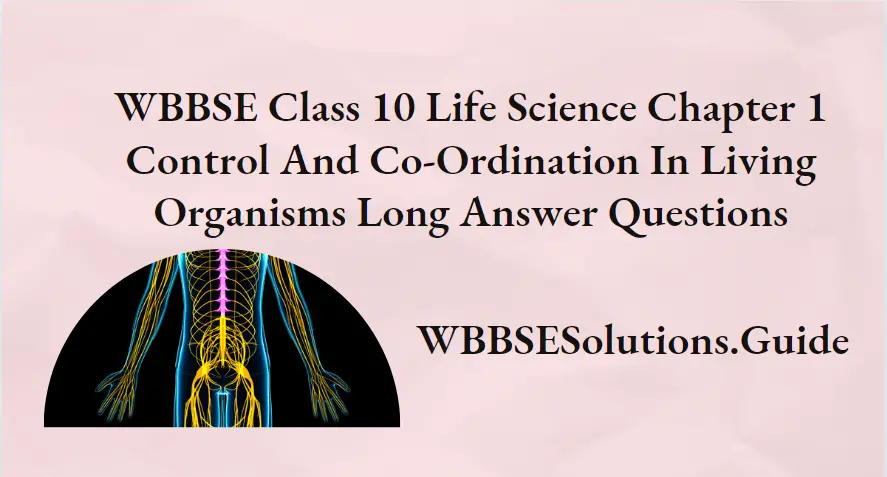Class 10 Life Science And Environment
WBBSE Class 10 Life Science Short Answer Questions
- Chapter 1 Control And Co-Ordination In Living Organisms Very Short Answer
- Chapter 2 Levels Of Organization Of Life Short Answer Questions
- Chapter 3 Heredity And Common Genetic Diseases Short Answer Questions
- Chapter 4 Biology And Human Welfare Short Answer Questions
- Chapter 5 Environment And Its Resources Short Answer Questions
WBBSE Solutions Class 10 Life Science Chapter 3 Heredity And Common Genetic Diseases Long Answer Questions
Chapter 3 Heredity And Common Genetic Diseases Long Answer Questions
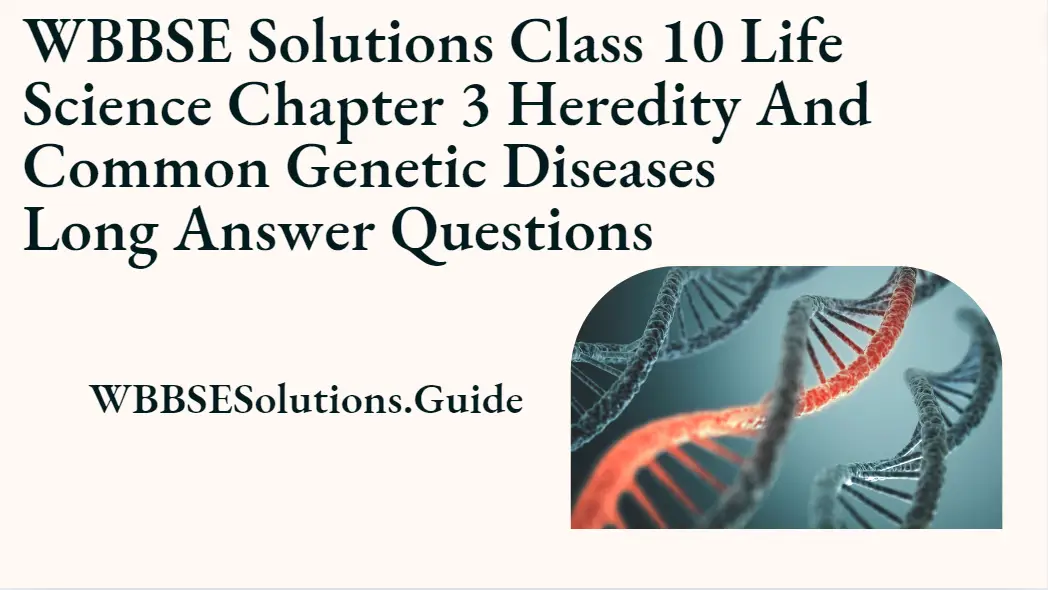
Question 1. What do you understand by the term heredity? Who is the father of genetics? On which living material did he do his experiment? State two
conclusions derived from his monohybrid cross experiment.
Answer:
(1) Heredity:- The transmission of parental characters from one generation . to the successive generation of organisms is called heredity.
(2) Gregor Johann Mendel is the father of genetics.
(3) He conducted his experiment on a garden pea plant (Pisum sativum).
(4) Conclusions derived from his monohybrid experiment:・
(1) Characters are controlled by genes. Genes are found in pairs. One gene controls only one character. There are two factors for a single character. Such as tall and dwarf are two factors for length which is a single character. In these two factors, one is dominant while the other one is recessive. The factor which expresses itself in a generation is called the dominant factor and the next which is unable to express itself in a generation is called the recessive factor.
(2) Both factors of a character are present in a hybrid. But these factors are never mixed up with each other. They are separated during gamete formation. Hence a gamete contains only one factor for a character. Thus we can say that a gamete is pure.
Question 2. Explain what would be the ratio of the pure red and pure white flower-bearing pea plants in the F, generation when a cross is made between two pea plants: one pure red flower (dominant) and the other bearing pure white flower (recessive).
Answer:
(1) Monohybrid cross between pure red and pure white pea plant flower:-
Two pea plants, one bearing pure red flower and another bearing pure white flower, are selected. Flowers appear on both plants at the same time. These plants are considered as peas plants is bisexual plants. So, to check the self-pollination the anther of the flower of one plant is cut and the stigma of the other plant is covered with a paper. Now artificial cross-pollination is done. As a result of this, the seeds for F, are obtained. When these seeds are sown all the plants bear red flowers. These are the plants of the F, generation. When the plants of F, bear flower, self-pollination is allowed. As a result of this action seeds for F, are obtained when these seeds germinate. Now plants are produced. These plants are called the F, generation plants. The colour of flowers in all the plants of the F, generation is not red. The genotypic ratio of F, generation is 1: 2: 1. So, the ratio of pure red and pure white flowers in F, generation is 1: 1.
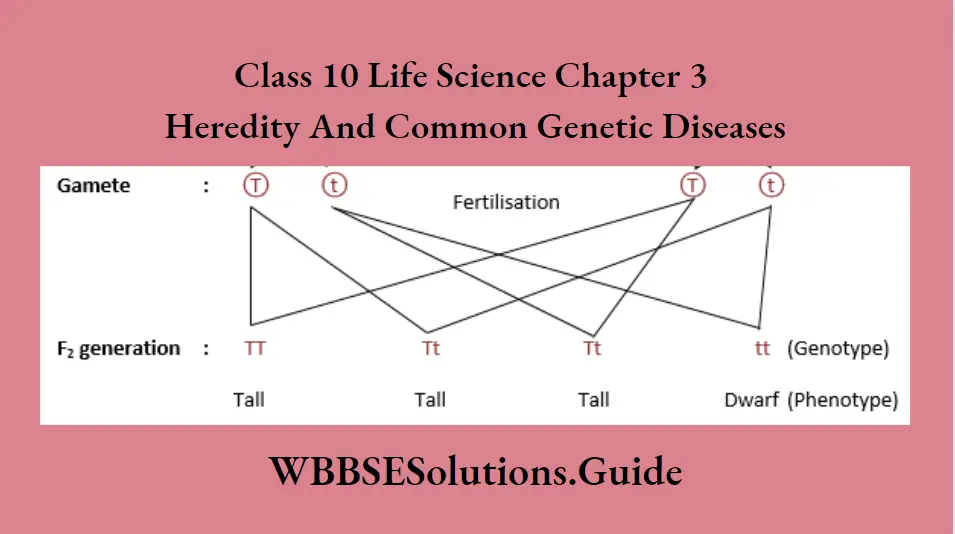
Question 3. How did Mendel explain the occurrence of tallness of all pea plants in the F, generation in his experiment on monohybrid cross? Discuss in brief how he also explained the occurrence of growing tall and dwarf pea plants in the ratio of 3: 1 in the F, generation in the same experiment.
Answer:
(1) Explanation of occurrence of all tall plants in F, generation of Mendel’s monohybrid experiment:- Mendel selected two sets of pea plants. One set consisted of tall plants (50cm – 200 cm in height) and the other of short plants (up to 50 cm in height). He first made it certain that seeds from tall plants invariably produced tall plants and the dwarfs produced only the dwarfs in successive generations, that is, they are true breeding. He then artificially cross-fertilized tall plants with dwarf plants of the parental generation. To achieve this, he removed the anther of tall plant and covered the stigma of the dwarf plant Then he dusted the pollen grains of a dwarf plant to the stigma of the tall plant. He also made reciprocal crosses. So that each one had a chance to set as male and female parent. He collected all seeds upon ripening and raised the hybrid from these seeds. He referred to this generation as F, All plants of this generation were tall.
Mendel explained the reasons behind the occurrence of all tall plants in F, He suggested that each parent contributed a factor to the offspring. This factor was later termed a gene. The factor contributed by the tall parent was dominant over the factor of dwarfness. He suggested that though both factors were present in the F, the dwarf factor remained unexpressed as it was masked by the factor for tallness.
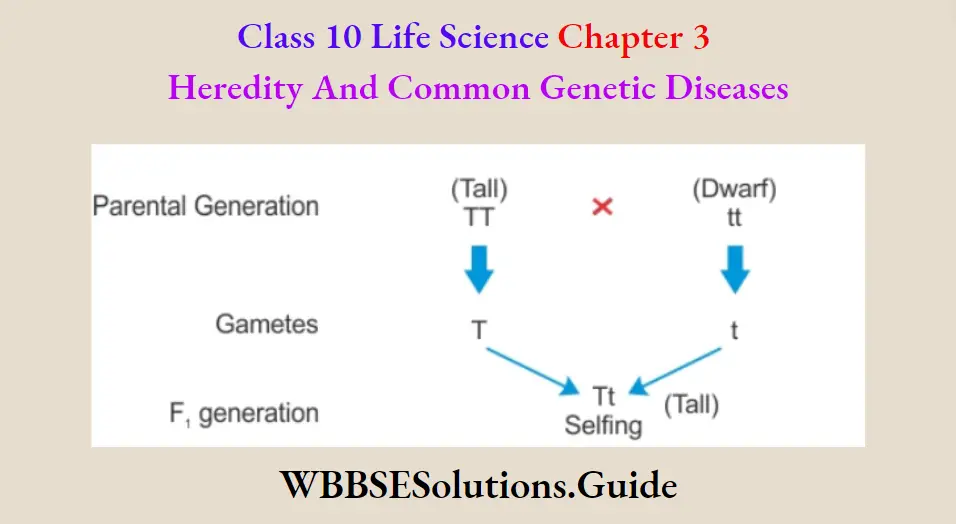
(2) Explanation of the occurrence of tall and dwarf plants in the ratio of 3: 1 in F, generation in the same experiment:・He allowed individuals of F, for self-pollination and subsequently self-fertilization occurred. These self-fertilized seeds are sown in the field for germination. He observed that all the plants were not tall, rather some of the plants became dwarf. So, the tall and dwarf plants were designated as F, generation. Mendel observed that 75% of plants became tall and 25% of plants became dwarf in the F, generation. The ratio of tall and dwarf plants is 3: 1. It was found that the dwarf of F, the generation when self-pollinated was true-breeding, while of the tall plants, only 25% were true breeding. The remaining 50% of the tall plants in the
next generation, produce tall and dwarf plants in the ratio of 3: 1.
In the F, generation, however, the characters segregated and produced tall and dwarf plants. Based on these observations, Mendel postulated the law of segregation, which stated that pairs of contrasting characters of a hybrid separate from each other in subsequent generations.
Question 4. Write the first and second laws of Mendel related to heredity in the form of a definition.
Answer:
First Law of Mendel (Law of Segregation):・Whatever factor may come together in the zygote, they never lose their identity and the factors or genes making up the pair are separated at meiosis during the formation of gametes to produce the next generation. Thus, each gamete contains one factor or gene for a character but the paired form is restored after fertilization.
Second Law of Independent Assortment:- Two or more pairs of factors coming together in the F, separate at meiosis and combine in various ways forming the plants in F and succeeding generations and each pair of factors is inherited independently of the other.
Question 5. Explain the terms dominant and recessive characters, phenotype and genotype with the help of Mendel’s monohybrid cross experiment.
Answer:
Mendel’s monohybrid cross experiment:- Mendel selected two sets of garden pea plants. One set consisted of pure tall plants and the other of pure dwarf plants. He then cross-pollinated tall plants with dwarf plants artificially. He also made reciprocal crosses. He collected all the seeds. He sowed them in the field for germination. He observed that all the plants were tall. He called them the F, generation.
The tall plants of F, generation were allowed for self-pollination and subsequently for self-fertilization. Again, seeds are collected and sown in the garden field for germination. He observed that all the plants were not tall. Some of the plants became dwarfs. He called them as F, generation. Mendel observed that in the F, generation 75% of plants became tall and 25% became dwarf. The ratio of tall and dwarf plants is 3: 1. It was found that the dwarf of F, the generation when self-pollinated was true-breeding, while of the tall plants, only 25% were true breeding.
The remaining 50% of the tall plants in the next generation produce tall and dwarf plants in the ratio of 3: 1.
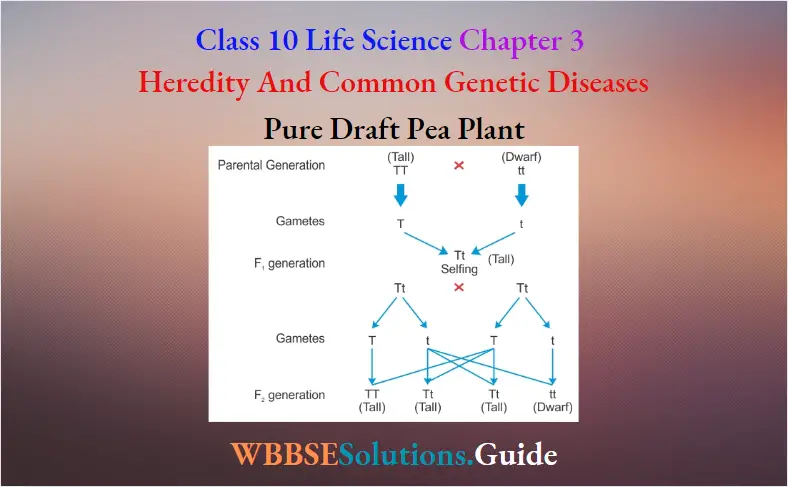
Based on the observations of the monohybrid cross, we can clarify some points:-
(1) F, generation obtains one factor from the pure tall plant and another factor from the pure dwarf plant. It has both factors for a single character’s tallness. Hence it is a hybrid. Here only the pure tall factor expresses itself. So, this plant is a hybrid tall. The pure dwarf factor is unable to express itself.
(2) The factors of a hybrid are segregated during the formation of gametes to produce the next generation. A gamete contains only one factor for a character. Thus, it is clear that a gamete is always pure.
Keeping the above facts in view, we can define the following terms in this way:-
(1) Dominant:・The factor present in a hybrid expresses itself in a generation is called dominant. Such as tall (TT) factor is a dominant factor of tallness character.
(2) Recessive:・The factor present in a hybrid unable to express itself in a generation is called recessive. Such as dwarf (tt) factor is a recessive factor of tallness character.
(3) Phenotype:- The characteristic of an organism which is externally visible is called phenotype. Example – In F, generation the phenotype of three plants is tall and one plant is dwarf.
(4) Genotype:- The characteristic of an organism which is given based on its entire genetic constitution is called genotype. Example ・In F, generation one plant is pure tall (TT), two plants are hybrid tall (Tt) and the last plant is pure dwarf (tt).
Question 6. Mention Mendel’s dihybrid cross experiment with the help of a checkerboard and also mention the phenotypic ratio of the F, generation based on the experimental results.
Answer:
A cross between two sets of plants involving two pairs of contrasting characters is called a dihybrid cross.
Experiment:- For this cross, Mendel selected two plants. One plant possesses round and yellow seeds while another plant possesses wrinkled and green seeds. He arranged artificial cross-pollination. Seeds obtained from this cross were round and yellow. So these factors are dominant, while the wrinkled and green factors are recessive. He called them seeds of the first filial generation (F,).
Plants obtained from these seeds were allowed for self-pollination. They yielded four types of seeds : (1) Round and yellow, (2) Wrinkled and yellow, (3) Round and green, and (4) Wrinkled and green. }
These results are explained by a factor pair Y-y for yellow-green and another factor pair R-r for round-wrinkled. The round and yellow parent can be written as RRYY and the wrinkled and green parent as rryy, the first parent produces gametes which are Ry and the gametes of the second parent are ry. When these gametes unite, the resulting F is RrYy. As round (R) and yellow (Y) factors are dominant over wrinkled (r) and green (y) factors, the F is a hybrid round and yellow.
When the F, in turn, produces gametes, all combinations occur at the time of meiosis. Therefore, both among male and female gametes, four types of gametes RY, ry, Ry and ry are produced. The male and female gametes unite truly and produce a second filial generation (F,). The phenotypic ratio of this generation is 9:3:3: 1.
(Dihybrid cross between pea plants having round yellow seeds and wrinkled green seeds.)
Question 7. State the modern concept of heredity.
Answer:
(1) Characters of parents are transmitted to the progeny through sperms and ova.
(2) Chromosome numbers in each species are constant.
(3) Sperms and ova carry half the number of chromosomes of that species.
(4) Genes are present on chromosomes in a single linear order.
(5) Each gene is present in a particular position of a chromosome.
(6) Gene is composed of DNA.
(7) Gene has the capacity of self-duplication and also mutation.
(8) The fundamental material of heredity is the gene.
(1) Genes are the bearer of hereditary characters.
Question 8. Describe the monohybrid cross experiment in animals (Guineapig).
Answer:
To perform a monohybrid cross a black hair guineapig and a white hair guinea-pig are. selected. Now a cross is allowed. In the F, generation all the offspring are black. From this, it is concluded that the black colour is dominant over the white colour.
Now a cross is made between an adult male and a female of the F, generation. In the F, generation, black and white coloured guineapigs are produced in the ratio of 3: 1.
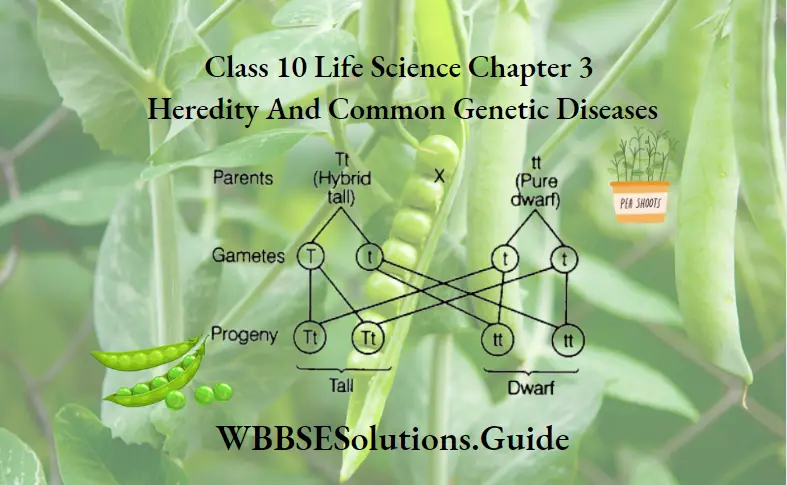
Question 9. Describe dihybrid cross in animals.
Answer:
Dihybrid cross in animals:
Two different-sex guinea pigs are selected. One has pure black and rough hair while another has white and smooth hair. Now, a cross is allowed. All the F, offspring are black and rough-haired.
Now, F, hybrids are interbred. They will produce 16 offspring in F, generation in the ratio 9:3:3:1
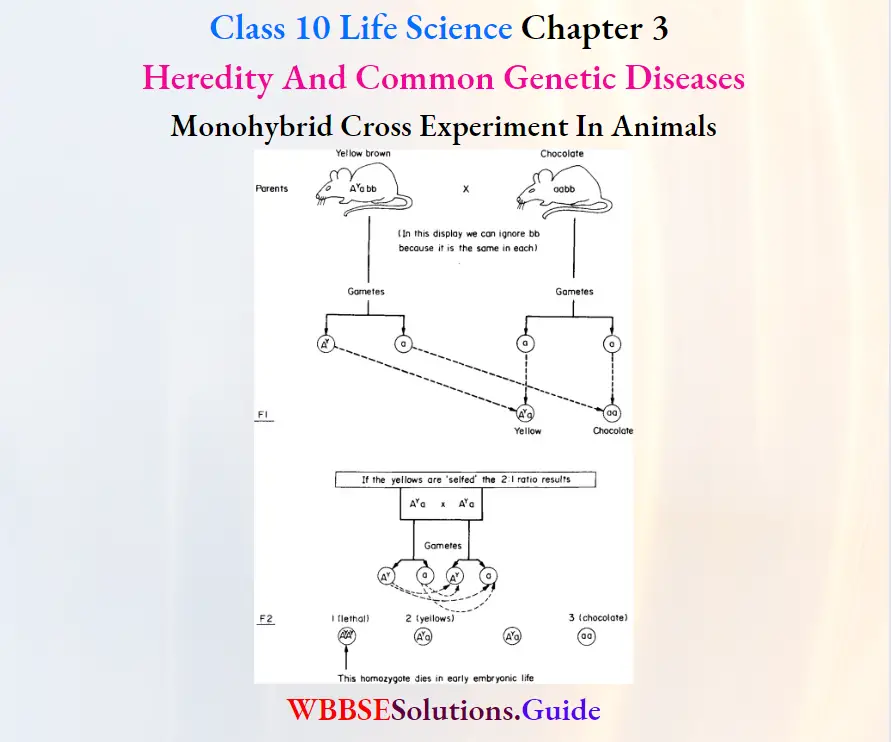
Dihybrid experiment on guineapig
Black and Rough = 9
Black and Smooth = 3
White and Rough = 3
White and Smooth = 1
Phenotypic ratio =9:3:3:1
Question 10. Explain how the sex of a child is established.
Answer:
Sex of a child is established as follows:
Sex is a characteristic which is transmitted from parents to offspring. Genes are grouped to form chromosomes. The human species has twenty-three pairs of chromosomes. With one exception, the twenty-two members of each pair of chromosomes are alike. The exception is the pair which determines sex always referred to as the sex chromosomes. The somatic cells of the female have a pair xx but the somatic cells of the male have a pair of sex chromosomes which are not alike, xy, y being much smaller than x. Each gamete gets only one sex chromosome; all the ova have x but half the sperms have x and the other half y.
Allowing for every possibility, in the fusion of the gametes the chances are equal that an ovum will be fertilized by x x-bearing sperm or a y-bearing sperm. But the resulting zygote has its sex determined at the moment of fertilization. If xx chromosomes are present the child will be a girl, if xy are Present the child will be a boy.
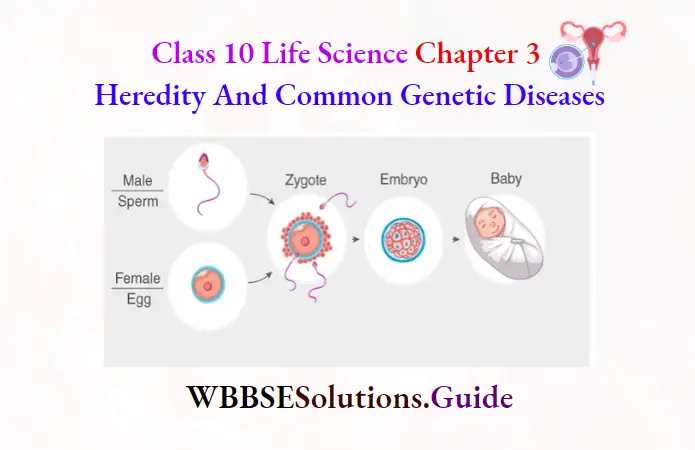
Question 11. Write four reasons for selecting pea plants by Mendel for his experiments on heredity. Explain with reasons which one between sperm and ovum
is responsible for the determination of sex in human beings.
Answer:
Reasons for selecting pea plants by Mendel for his experiments on heredity
(1) Mendel selected garden peas as his experimental material because
(1) Sweet pea plant is an annual plant. :
(2) It has a large number of pairs of contrasting characters.
(3) Its flowers are complete and bisexual. So it avoids the problems of pollination.
(4) Reproduction ability is excess. :
(2) Explanation to show between sperm and ovum which one is responsible for the determination of sex in human beings:- Sex is a character which is transmitted from parents to offspring. Genes are grouped to form chromosomes. The human species has twenty-three pairs of chromosomes. With one exception, the twenty-two members of each pair of chromosomes are alike. The exception is the pair which determines sex, always referred to as the sex chromosomes. The somatic cells of the female have a true pair xx but the somatic cells of the male have a pair of sex chromosomes which are not alike, xy, y being much smaller than x. Each gamete gets only one sex chromosome; all the ova have x but half the sperms have x and the other half y.
Allowing for every possibility, in the fusion of the gametes the chances are equal that an ovum will be fertilized by x x-bearing sperm or a y-bearing sperm. But the resulting zygote has its sex determined at the moment of fertilization. If xx chromosomes are present the child will be a girl, if xy are present the child will be a boy. So, sperm is responsible for the determination of sex.
Question 12. Write the full name of the Father of Genetics. What are phenotype and genotype? If a YYRR (pure dominant yellow and round seeded) pea plant is hybridised with a year (pure recessive green and wrinkle seeded) pea plant, what will be the genotype of the plants obtained in F, generation? Write the phenotypic ratio obtained in the F, generation in the said dihybrid cross.
Answer:
Father of Genetics
(1) Gregor Johann Mendel.
(2) Phenotype:- An organism’s externally visible characteristics are called phenotype. Example = In F, generation of monohybrid cross the phenotype of three plants is tall and one plant is dwarf.
(3) Genotype:- The characteristics of an organism which are given based on its entire genetic constitution are called genotype. Example ・In F, generation of a monohybrid cross one plant is pure tall (TT), two plants are hybrid tall (Tt) and the last plant is a pure dwarf (tt)
(4) The genotype of F, plants will be RrYy
(5) The phenotypic ratio of F, generation is 9:3:3: 1,
Question 13. What is a hybrid? If a hybrid black-haired Guineapig is crossed with a white-haired Guineapig, what will be the phenotypes of the Guineapigs of the First filial (F,) generation and why? Explain with reasons.
Answer:
Hybrid – An organism having two different genes (contrasting genes) affecting the same trait is called a hybrid.
50% Hybrid black-haired guinea pig and 50% white-haired guinea pig will be produced because Black hair is dominant over White hair.
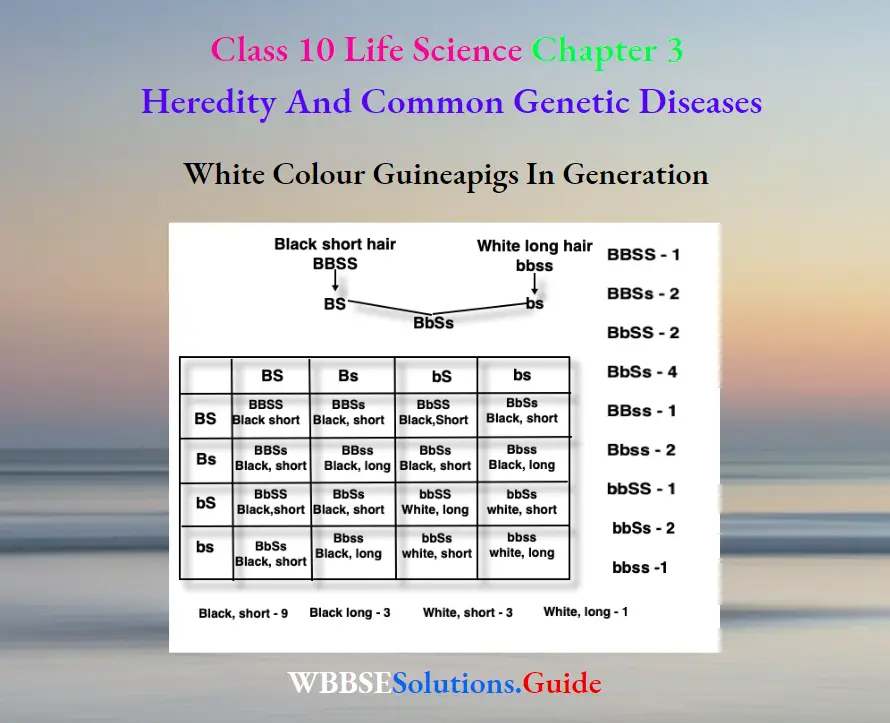
Question 14. Write seven pairs of contrasting characters in pea plants selected for Mendel’s experiments.
Answer:
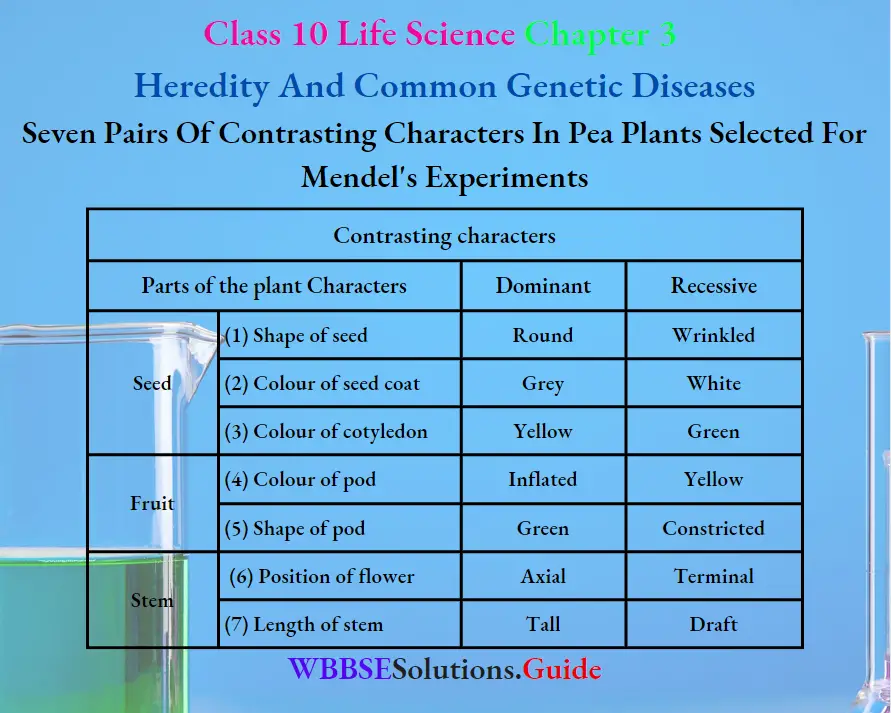
Question 15. In which name is the first law known Explain with a checkerboard the experiment Mendel performed to reach that conclusion.
Answer:
(1) The first law is known as the law of segregation.
(2) Explanation:- Mendel selected two sets of pea plants. One set consisted of tall plants (50cm – 200 cm in height) and the other of short plants (up to cm in height). He first made it certain that seeds from tall plants invariably produced tall plants and the dwarfs produced only the dwarfs in successive generations, that is, they are true breeding. He then artificially crisscross-fertilized plants with dwarf plants of the parental generation. To retrieve this, he removed the anther of tall the plant and covered the stigma of the dwarf plant. Then he dusted the pollen grains of a dwarf plant to the stigma of the tall plant. He also made reciprocal crosses, so that each one had a chance to set as male and female parent. He collected all seeds upon ripening and raised the hybrids・from these seeds. He referred to this generation as F, A, plants of this generation were tall.
Mendel explained the reasons behind the occurrence of all tall plants in F, He suggested that each parent contributed a factor to the offspring. This factor was later termed a gene. The factor contributed by the tall parent was dominant over the factor of awareness. He suggested that though both factors were present in the F, the dwarf factor remained unexpressed as the factor for tallness masked it.

He allowed individuals of F, for self-pollination and subsequently self-fertilization occurred. These selfself-fertilizedds are sown in the field for germination. He observed that all the plants were not tall, rather some of the plants became dwarf. So, the tall and dwarf plants were designated as F, generation. Mendel observed that 75% of lants became tall and 25% of plants became dwarf in the generation. The ratio of tall and dwarf plants is 3: 1. It was found that the dwarf of F, generation when self-pollinated were true breeding, while the tall plants only 25% were true breeding. The remaining 50% of the tall plants in the next generation, produce tall and dwarf plants in a ratio of 3: 1.
In the F, generation, however, the characters segregated and produced tall and dwarf plants. Based on these observations, Mendel postulated the law of segregation, which stated that pairs of contrasting characters of a hybrid separate from each other in subsequent generations.
Question 16. Explain Mendel’s second law of heredity with the help of the dihybrid cross experiment by Mendel. If a sperm containing the X-chromosome of a man fertilizes an ovum of a woman, what will be the sex of the child developing from the resulting zygote?
Answer:
(1) Experiment:- For this cross, Mendel selected two plants. One plant possesses round and yellow seeds while another plant possesses wrinkled and green seeds. He arranged artificial cross-pollination. Seeds obtained from this cross were round and yellow. So these factors are dominant, while the wrinkled and green factors are recessive. He called them seeds of the first filial generation (F,).
These results are explained by a factor pair Y-y, for yellow-green and another factor pair, R-r for round-wrinkled. The round and yellow parent can be written as RRYY and the wrinkled and green parent as rryy, the first parent produces gametes which are Ry and the gametes of the second parent are ry. When these gametes unite, the resulting F is RrYy. As round (R) and yellow (Y) factors are dominant over wrinkled (r) and green (y) factors, the F is a hybrid round and yellow.
When the F, in turn, produces gametes, all combinations occur at the time of meiosis. Therefore, both among male and female gametes, four types of gametes RY, ry, Ry and ry are produced. The male and female gametes unite truly and produce a second filial generation (F,). They yielded four types of seeds :
(1) Round and yellow,
(2) Wrinkled and yellow,
(3) Round and green,
(4) Wrinkled and green.
The phenotypic ratio of this generation is 9: 3:3: 1.
(2) Second Law or Law of Independent Assortment Two or more pairs of factors coming together in the F, separate to meiosis and combine in various ways forming the plants in F, and succeeding generations and each pair of factors inherited independently of the other.
(3) The child will be female.
Question 17. What do you understand by the terms homozygous・and Heterozygous・conditions? Explain the law of Independent Assortment.
Answer:
(1) Homozygous – The individual having a genotype, with two of the same alleles for a trait is called Homozygous.
Example – TT or tt
(2) Heterozygous – The individual having a genotype, with distinct alleles for the same trait is called Heterozygous.
Example – Tt.
(3) Law of Independent Assortment – When two or more pairs of factors come together in the F, separate at meiosis and combine in various ways forming the plants in the F, and succeeding generations and each pair of factors is inherited independently of the other.
Question 18. Black hair is dominant and white hair is a recessive character of guineapig. Explain the result of a cross between two hybrid black guineapigs with the help of a checkerboard. What types of gametes unite to form a female child in man?
Answer:
(1) When hybrid black Guineapigs are interbred they will produce 75% black colour and 25% white colour Guineapigs in F, generation. The phenotypic ratio of this generation is 3: 1, while the phenotypic ratio is 1: 2: 1.
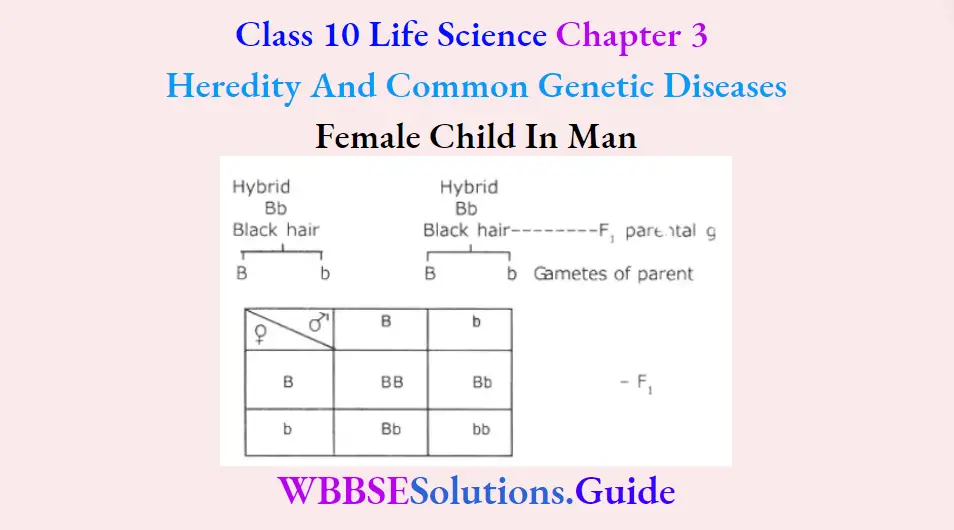
(2) Female gamete ovum contains (22x+x) chromosome. Male gamete sperm also contains (22x+x) chromosome. These two gametes unite to form a female child.
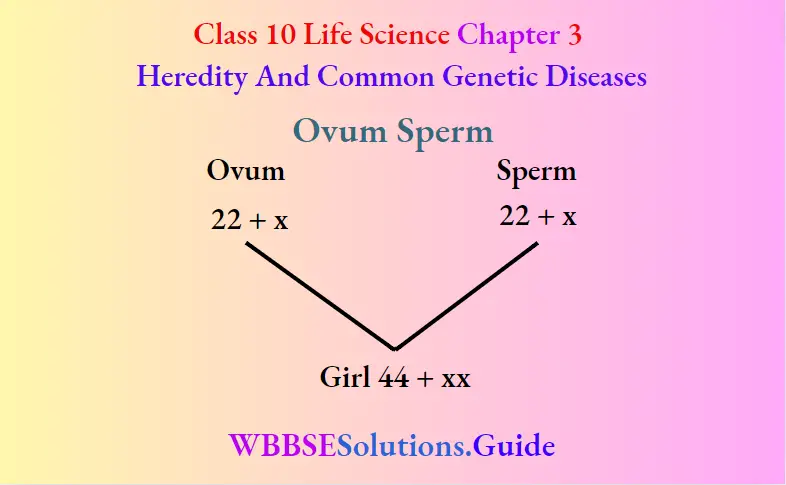
Question 19. Briefly explain the following behavioural adaptations :
(1)Problem-solving in chimpanzees,
(2) Communication in honeybees.
Answer:
(1) Problem-solving chimpanzees: Just like humans, chimpanzees create and use tools to make their lives easier. Termites are one of the himpanzees・favorite foods, but how to reach the creatures deep within their mounds presents quite a problem. Chimpanzees pick up a twig and stripe the leaves off of it Then they stick the twig into one of the holes in the termite mound, leave it there for a moment, and slowly pull it out as termites clung to the twigs they pick them off with their lips and scrunched them. They are using the stem as a tool to fish・for insects. Chimpanzees have also been seen using tools such as stone hammers to chop up and reduce food into smaller bite-sized portions. Chimpanzees like eating nuts. They hammer them open with stone or wood.
Non-human primates especially chimpanzees-self-medicate. Chimpanzees in the wild appear to practice herbal medicine. They consume numerous items with medicinal properties, such as anti-bacterial agents and deworming herbs.
(2) Communication in honeybees Perhaps the most famous and fascinating language of the honey bee is communicated through a series of dances done by
foraging worker bees who return to the hive with news of nectar, pollen, or water. The details of the dance languages were worked out by Karl von Frisch (1967). Two common types of dances are the so-called round dance and the waggle dance. The dance in a figure-eight (8) patterns. It involves a shivering side-to-side motion of the abdomen. The bee first runs straight ahead for a precise distance wagging her
Question 20. Explain in brief the dominant and recessive characters from the result of Mendel’s monohybrid cross experiment in the pea plant. What is genotype?
Answer:
(1) Mendel’s monohybrid cross experiment ・Mendel selected two sets of garden pea plants One set consisted of pure tall plants and the other of Pure dwarf
plants He then cross-pollinated all plants with dwarf plants artificially. He also made reciprocal crosses. He collected all the seeds. He sowed them in the field for germination. He observed that all the plants were tall. He called them the F, generation. Based on observations of the Monohybrid cross we can Clarify some points:-
(1) F, generation obtains one factor from the pure tall plant and another factor from the pure dwarf plant. It has both the factors for single character tallness. Hence it is a hybrid. Here only the Pure Tall factor expresses itself. So this plant is a hybrid tall. The pure dwarf factor is unable to express itself. Keeping the above facts in view, we can define the following terms in this way:-
(1) Dominant:- The factor present in a hybrid expresses itself in a generation is called dominant. Such as the tall (TT) factor is a dominant factor of tallness character.
(2) Recessiv:- The factor Present in a hybrid unable to express itself in a generation is called recessive. Such as the dwarf (tt) factor is a recessive factor of tallness character.
Genotype The genetic constitution of an organism is called genotype. Example-Pure tall (TT), hybrid all- Tt, pure dwarf-tt.
Question 21. Why did Mendel select pea plants for his experiments? Mention any three reasons for it. What is hybridisation? Why is Mendel called the father of genetics? What do you mean by character
Answer:
Mendel selected garden peas as his experimental material because ・;
(1) These are annual self-fertilised plants with bisexual flowers.
(2) The plants could be grown easily and crossing could be done without any difficulties.
(3) The hybrid plant obtained from the cross between two varieties of pure plants ais completelyfertile.
The artificial process which is used to produce hybrid is called hybridization. He performed cross-breeding experiments on sweet pea plants analysed the records obtained from observations and formulated them in the form of laws.
Any inheritable feature is called a character.
WBBSE Class 10 Life Science Chapter 1 Control And Co-Ordination In Living Organisms Long Answer Questions
Chapter 1 Control And Co-Ordination In Living Organisms Long Answer Questions
Question 1. Describe in brief the locomotion in Amoeba.
Answer.
Locomotion in Amoeba:
Amoeba locomotes with the formation of pseudopodium (singular). During locomotion, a blunt pseudopodium is formed in the direction of movement simultaneously the pseudopodia (pi.) on the opposite side are withdrawn.
Locomotory organ: Pseudopodia.
Type of locomotion: Pseudopodial or amoeboid movement Process: Several theories have been put forward to explain the formation of pseudopodia, of these the sol-gel theory forwarded by Hyman (1917) and later supported by Mast (1925) is the most accepted.
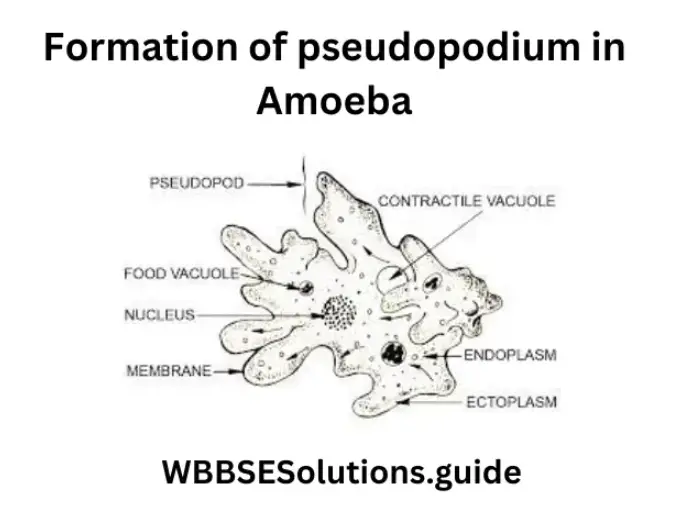
The body of Amoeba is differentiated into three parts. These are (1) a thin and elastic Plasmalemma, (2) an outer non-granular ectoplasm, and (3) an inner granular endoplasm. The endoplasm is further differentiated into an outer jelly-like plasma gel and an inner more fluidy plasmasol. In the formation of pseudopodium, four processes occur simultaneously
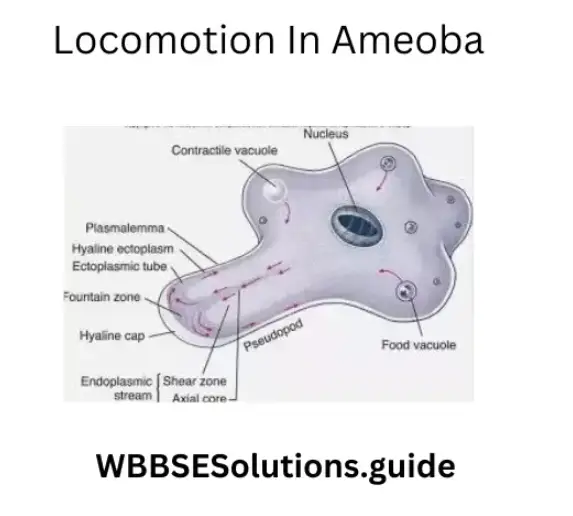
- At the advancing end of the body, the plasma gel partially changes to the solstice (solution) and thus becomes thinner and weaker than the rest of the plasma gel.
- The plasma gel of the opposite end contracts and causes hydraulic pressure on the plasmas.
- Due to the hydraulic pressure, the plasmas are pushed forward towards the softened plasma gel which, being weak, cannot withstand the pressure and develops an outward bulge to receive the plasmas.
- At the periphery of the bulge, the plasmas change into the gel state (gelation). Thus, a tube of plasma gel with a core of plasmas and a covering of ectoplasm is formed. This is the pseudopodium. Pseudopodium is formed in the direction of movement
- Simultaneously the pseudopodia on the opposite side are withdrawn and the amoeba moves forward in the direction of the newly formed pseudopodia.
Question 2. Describe in brief the locomotion in Earthworms.
Answer.
Locomotory organs in earthworms are :
1) Buccal Cavity 2) Setae 3) Body muscles. The buccal cavity acts as a sucker and the setae act as legs. Body muscles are of two types – circular and longitudinal. The alternate contraction and relaxation of these muscles make the body thin and thick respectively.
Type of Locomotion: Creeping locomotion.
Process: Locomotion in earthworms is described in the following six steps :
1. The locomotion starts with the contraction of the circular muscles, which extends to the anterior end. The anterior half of the earthworm becomes thin and elongated.
2. After extending fully the earthworm attaches its mouth (buccal cavity) to the soil which acting as a sucker firmly grasps the soil.
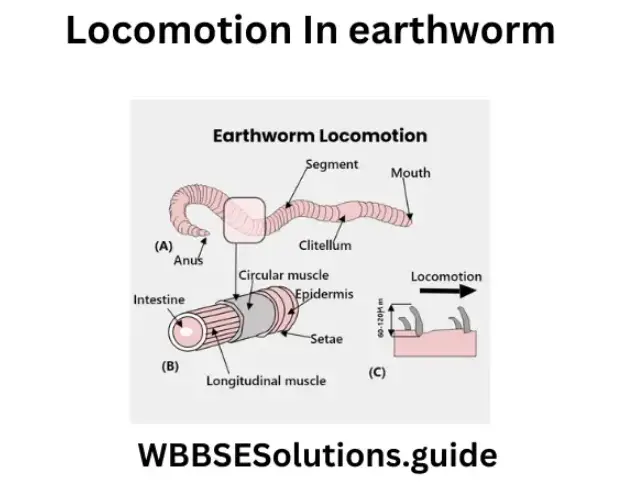
3. Then the setae of the thin region protrude out by the contraction of protractor muscles. The protruded setae firmly grip the soil.
4. At this time the posterior half of the body is free from the soil, and its longitudinal muscles are now ready to contract Due to their contraction the posterior half becomes short
5. After shortening the posterior half, the setae of this region protruded out to take a firm grip on the soil.
6. When the posterior half is completely anchored, the mouth and the setae of the anterior half are withdrawn and the earthworm begins to elongate moving forward. Thus the forward movement is by alternate waves of elongation passing over the whole body. During locomotion, the coelomic fluid serves as a kind of hydraulic skeleton. Sometimes the earthworm may move in a backward direction. It has been calculated that the earthworm can travel a distance of 25 cm in 1 minute.
Question 3. Describe in brief the locomotion of cockroaches.
Answer.
Locomotion of cockroaches
1) Locomotory organs: 1) Three pairs of thoracic legs.
- Pairs of Antagonistic (extensor and flexor) muscles act along the ball and socket joint which divides the leg into five parts.
- Two pairs of wings are present at the posterior side of the second and third segments of the thorax.
- The dorsoventral muscles and longitudinal muscles.
2. Process of Walking Locomotion: It takes place as follows :- The extensor and flexor muscles first contract which causes the straightening of joints in 1st and 3rd leg of one side and the 2nd
- leg of the other side.
- As a result, these legs get lifted and move forward.
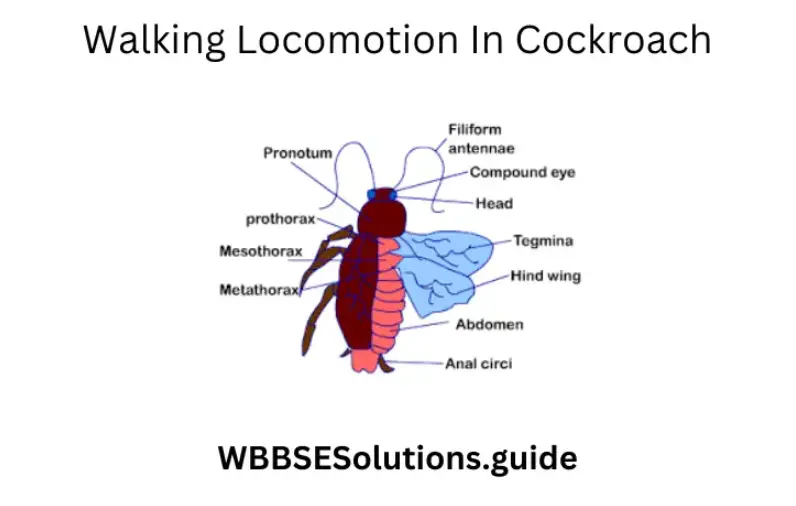
- The other three legs provide support to the body and remain attached to the ground with the help of a claw and sticky pad arolium provided at the terminal portion of limbs.
- Next to it, the extensor and flexor muscles relax which causes the bending of the legs. As such the three legs come back on the ground.
- Similarly, the other three legs are moved forward whilst the remaining ones provide support and in this way cockroach moves forward.
2. Flying Locomotion: The male cockroach only flies during the breeding season and in times of danger. The female cockroach cannot fly.
- Process of locomotion:
The forewings (upper wings) of cockroaches are thick and leathery and are called mesothoracic wings. They are not used for flying. The hind wings (lower wings) are smaller and thin and are called meta-thoracic wings. They are used for flying. The movement of wings is brought about by dorsoventral muscles and longitudinal muscles. The contraction of dorsoventral muscles lowers the dorsal wall of the tergum and thus the wings move upward. The contraction of longitudinal muscles arches the wall upward and so the wings move down. This process is repeated and the movement of the hind wing in the manner of ‘8’ helps to support the body and moves the body forward.
Question 4. Describe in brief the locomotion in fish.
Answer.
Locomotion in fish
Swimming is brought about by the whole of the body.
Fins do not contribute at all to forward movement The main function of fins is to control the stability and direction of the fish.
Locomotory organs: Myotome muscles, tail & tail fins.
Type of Locomotion: Swimming.
Type of fins: Two kinds of fins are present on the trunk and tail: paired fins and unpaired or median fins.
The paired fins are of two types :
1. Pectoral fins: Present close to the head and correspond to front legs of other vertebrates (two in number).
2. Pelvic fins: Correspond to the hind legs (two in number).
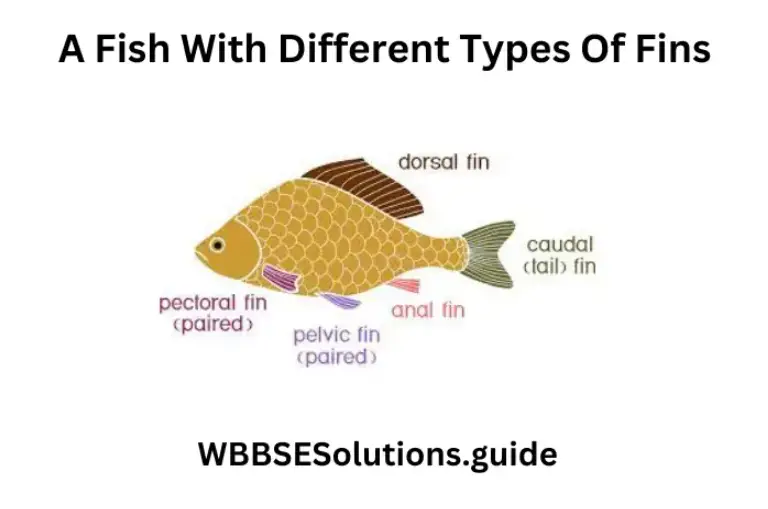
The unpaired or median fins are of three types :
1. Dorsal fin: Present along the top middle line of the trunk (1).
2. Caudal fin : Grows from the tail (1).
3. Anal or Ventral fin: Grows along the middle on the lower side behind the anus (1).
Role of fins in swimming :
1. The paired fins (pelvic and pectoral) control the pitching movement of the fish, causing it to swim downwards or upwards according to the angle at which they are held against water.
2. Pectoral fins help to maintain the fish at rest at any depth.
3. The paired fins are also how the fish slows down and stops locomotion. Thus they act as brakes.
4. The median fins (dorsal, caudal, and ventral) control the rolling and yawing movements of the fish by increasing the vertical surface area presented to the water. During rolling, the median fins prevent the fish from wobbling, i.e., tilting right and left on its axis. Yawing is the tendency to turn in different directions in the same horizontal plane.
Role of myotomes in locomotion (swimming) in Fish :
The fish actively swims by the side-to-side movements of the body particularly the tail. These movements start from the head and continue to the tail like a wave. During the wave of the side-to-side movements, the different regions of the body, from front to back, kick the water backward and sideward, pushing the fish forward. The wave-like movements of the body are a result of the contraction of myotome muscle blocks from the head to the tail in a serial manner and alternation on the right and the left sides.

The two successive equal and opposite sideways movements of the tail cancel each other out and the fish moves forward.
Swim bladder: Fishes can stay at a particular depth in the water by making their bodies weightless compared with the surrounding water. Most fish achieve this buoyancy by having in their body cavity an air-filled bladder running just beneath the spinal column. This air-filled bladder is known as the swim bladder (buoyancy organ). It acts like a float in providing buoyancy or upthrust in water.
Question 5. Describe in brief the tactic movement in plants.
Answer.
The tactic movement in plants:
Tactic or Taxis: This type of movement of locomotion occurs due to external stimuli like light, chemicals temperature, etc. The direction of the movement is
controlled by the direction of the stimulus. Tactic movement is of three types:
1) Phototactic movements: Many unicellular algae move towards diffuse light (positive phototactic movements) or away from the light of high intensity (negative phototactic movements), e.g. the movements of the chloroplast in the palisade cells which move and arrange and rearrange themselves in the cell in response to light stimulus and the movements of zoospores of certain algae which move in response to light
2) Thermotactic movements: Here, temperature regulates the change of place or position of a plant Some algae move towards the moderately warmer region of water (positively thermotatic), but away from a region of very high temperature (negatively thermotactic), e.g. the rapid rotational cytoplasmic movement in the leaf of Vallisnaria due to increase in temperature.
3) Chemotactic movements: These movements are induced by specific chemical substances acting as external stimuli. Such movements may be either positively chemotactic (e.g. spermatozoids of fern moving towards the ovum under the influence of malic acid secreted by the archegonium) or negatively chemotactic (e.g. movements of certain bacteria and algae away from acidic or alkaline medium).
Question 6. Briefly describe the different types of tropic movements in plants.
Answer.
Tropic movement in plants: It is a type of movement of curvature that comes under the category of induced or paratonic movement
Definition: When the direction of movement (response) of the plant organs bears a definite relation with either towards or away from the external stimulus, then the movement is called tropic movement
Tropic movements are of the following types, depending upon the nature of the stimuli:
1. Phototropism 2. Geotropism 3. Hydrotropism.
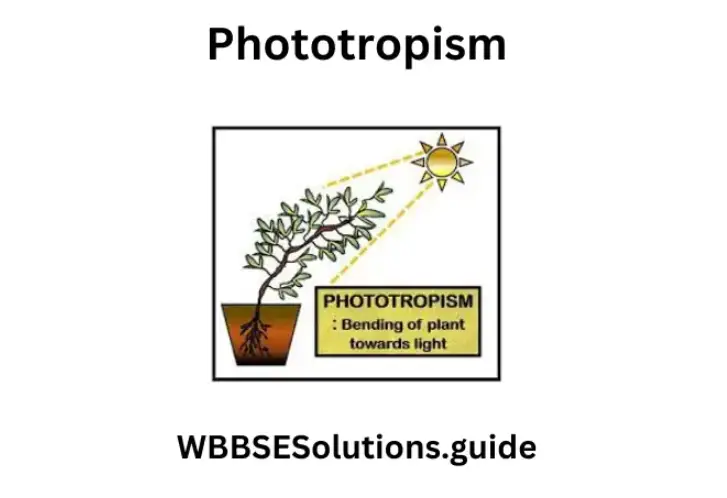
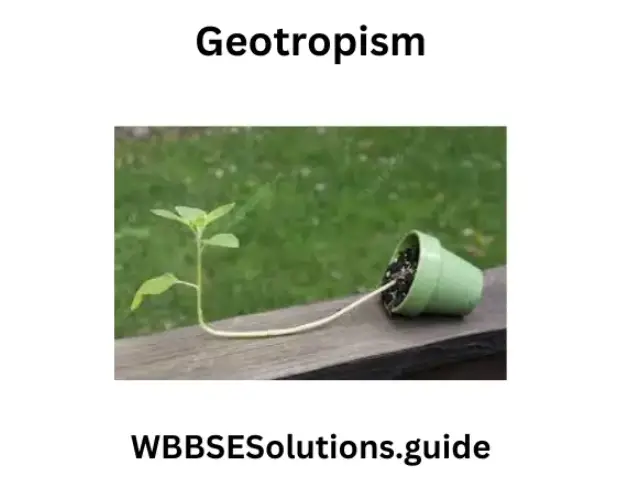
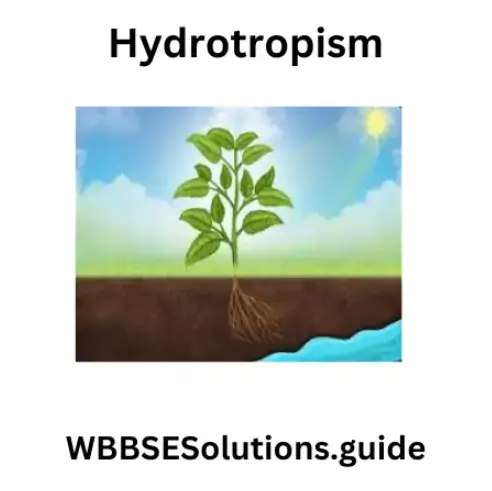
1. Phototropism or Heliotropism: The movement of plant organs in response to the source of light and they are said to be positively phototropic while the roots move away from the source of light and are called negatively phototropic, whereas the leaves and branches grow perpendicular to the sun rays and are said to be diaphototropic.
2. Geotropism: The movement of the plant organs induced by the force of gravity and soil is known as Geotropism or Geotropic movement. Generally, the primary roots move towards the force of gravity in the soil while the primary shoot moves away from the gravitational force of the earth. Thus they are positively and negatively geotropic respectively. The lateral roots and branches grow normally at right angles (perpendicular) to the force of gravity and the movement is called diageotropic. The breathing roots of the Rhizophora plant are an exception, showing negative geotropism.
3. Hydrotropism: The movement of plant organs in response to the source of water is called Hydrotropism or Hydrotropic movement The roots are said to be positive hydrotropic because they move towards the source of water while the shoot system moves away from the water and are said to be negative hydrotropic.
Question 7. Describe nastic movement in plants.
Answer.
Nastic movement in plants: When the curvature movements are induced by the influence of external stimuli light and temperature, they are termed as nastic (paratonic) movement. Nastic movements in which the response, i.e., the movement of plant organs, bears no relation to the direction of the stimulus. The stimulus acts on the protoplasm of cells from all sides.
According to the nature of the stimulus, nastic movements may be photonasty, thermonasty, chemonasty, nyctinasty, seismonasty, etc. where the stimuli are light; temperature, and chemical substances. In nastic movement, the direction of movement is not determined by the external stimuli. The response of the plant organ is always the same from whatever direction the stimulus may come.
1) Photonasty — The movements are concerned with the opening and closing up of flowers, e.g. the flowers of Pentapetes phoenicea fully open at noon, whereas they close at night The opening and closing of leaves of many leguminous plants in day and night afford best examples of photonasty; in these, light from all direction acts as stimulus which causes opening and closing up of leaflets. Similarly, the leaves of Oxalis expand at day time and remain semiclosed and drop at night Light and darkness cause variation in the turgidity of the cell of pulvinar tissues, hence the movement.
2) Thermonasty — The example of the tmonasticcurvature is afforded by the opening of the flowers of Tulips, where an increase in temperature affects the opening of the flower; a consequent fall in temperature brings about the closing of flowers.
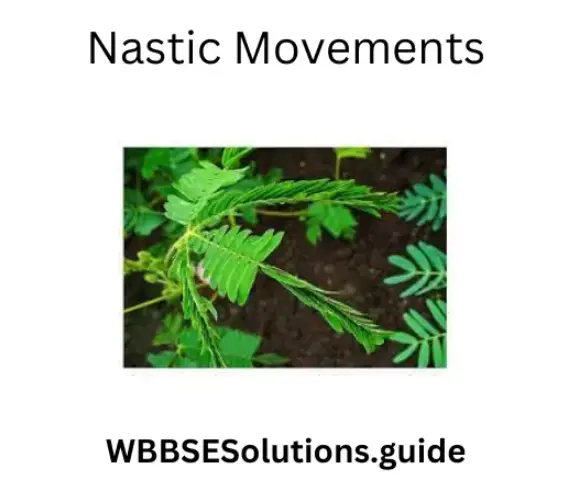
This is due to the change in the turgor condition of pulvinar tissue.
3) Chemonasty — It is the movement induced by chemical substances. This type of movement is seen in insectivorous plants. As soon as an insect sits in the center of a leaf of sundew (Drosera sp.), the tentacles move towards it
4) Nyctinasty — It is the most common of the Nastic movements, where changes in temperature and light during the day and night induce visible response which may be termed as nyctinasty. Thus the opening and closing of certain flowers are examples of nyctinasty. Nyctinastic movement of variation due to changes of turgor in the pulvini is also exhibited by the leaf or leaflets of Leguminosae (e.g. clover, Indian Telegraph
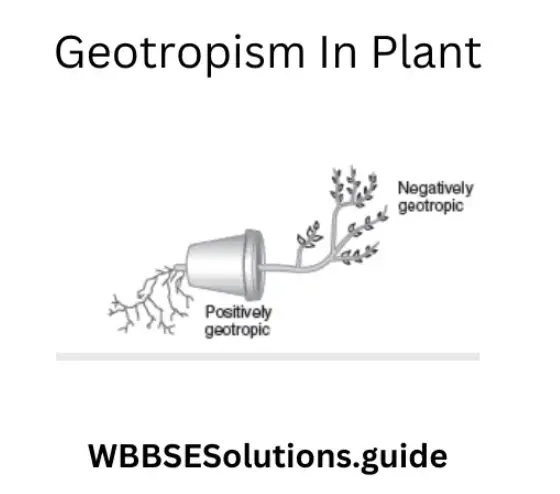
(Oesmodium grants), Acacia, Bauhinita, etc), Oxalidacease (e.g. Oxalis acetosella and also some species of fern and Marsilea). This movement is controlled by both light and temperature. The individual factors acting singly may induce photonastic and monastic movements. These movements are brought about by changes in the turgor of the cells of the pulvinus at the base of the petiole.5) Seismonasty — When a leaf of Mimosa pudica is subjected to sudden touch or shock of any kind, the leaf and its parts droop down very rapidly, and the leaflets close up, altogether, presenting a new appearance.
The movements are brought about by changes in the turgor pressure of the cells of the pulvinus.
Question 8. Give the hormonal explanation of geotropism
Answer.
Hormonal explanation of geotropism
Hormonal explanation of Geotropism: Due to the force of gravity accumulation of hormones takes place more on the undersurface of the root and stem. As root cells need less hormone concentration for their growth, the upper surface grows faster than that of the under surface and as a result root bends downward.
Question 9. Describe the flying locomotion in cockroaches.
Answer.
Flying: Cockroaches rarely fly. Generally, male cockroach flies. There are two pairs of wings held at right angles to the thorax during flight. The fore wings are tough and leathery but the hind wings are thin, membranous, and folded like a fan. The wings are without muscle. The movement of wings is controlled by two different sets of muscles in the thorax. These muscles are not connected to the wings. On muscle runs from the roof (tergum-dorsal surface) to the floor (sternum-ventral surface) of the thorax which is termed dorsoventral muscle or tergo-sternal muscle. The second muscle, the longitudinal, muscle runs anteroposteriorly
Contraction of the dorsoventral muscles (elevator muscle) lowers the dorsal wall of the roof (tergum) and thus forces the wing up. Contraction of the longitudinal muscle
(depressor muscle) arches the dorsal wall or roof (tergum) upwards and so forces the wings down. This process is rapidly repeated for flight In flight the tough leathery forewings
are held at right angles to the body and do not beat. Only the membranous hind wings beat in a complicated manner supporting the body as well as driving it forward.
Question 10. Describe the process of bipedal locomotion in man.
Answer.
The process of bipedal locomotion in man
Process of Bipedal Locomotion in Man: Walking in man is brought about by movements of the legs produced by sets of antagonistic muscles contracting and relaxing alternately. In the first step of movement, the heel bone is raised above the ground due to the contraction of calf muscles. Simultaneously extension of the pelvic joint and knee joint
takes place by contraction of the muscles in front of the thigh. In the next step, muscles contract thrusting the toe backward against the ground, so propelling the body forward, and then lifting the toe from the ground. In the next step, the leg is pushed forward.
When the leg moves forward the body also bends forward and due to the force of gravity and with the relaxation of the muscle the heel first comes down at the ground level and sets down in a new position. The toe then comes down to the ground level.
Question 11. What is a synovial joint? What are its different types?
Answer.
Synovial Joint: A movable joint containing synovial fluid, like a white portion of an egg, is called a synovial joint Synovial joint consists of a ligament, covering of the articular capsule le, synovial membrane surrounding the synovial cavity, synovial fluid inside and articular cartilage.
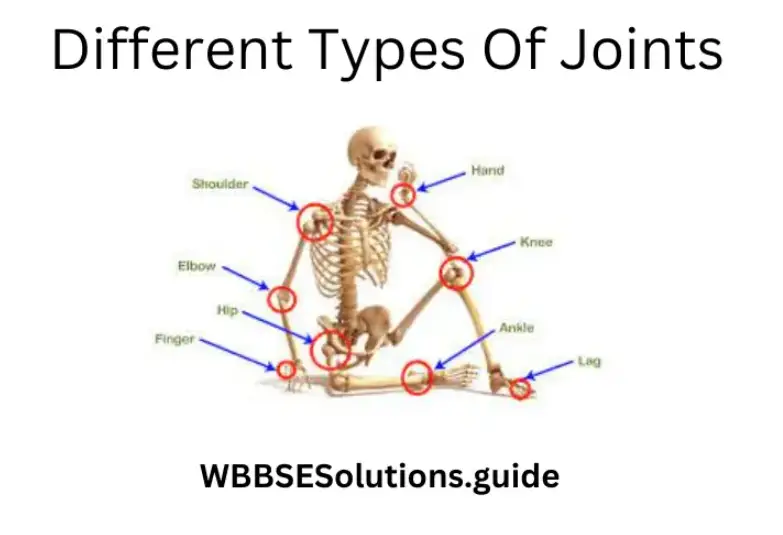
Following are the different synovial joints:
(1) Ball and socket joint: In this type of joint the ball-shaped head (end) of a bone articulate within the cup-shaped head (end) of the other bone; e.g. at the hip the femur or thigh bone joins the pelvis or hip girdle and at the shoulder where the humerus in the upper arm joins the scapula or shoulder blade. Ball and socket joints allow movement in three planes.
(2) Hinge joints: Hinge joints, like those in the elbow, finger, in knee, permit movement in one plane only.
(3) Pivot joint: In this type of joint, the concave end of a bone is attached to the ball-like end of another bone, where the first bone rotates around the head of the second bone. Example: atlas (1st vertebra) and axis (2nd vertebra) joint.
(4) Condyloid Joint: In this type of joint the convex end of a bone joins with the concave end of another bone. Here the movement takes place in one plane only.
For example, joints between the radius and carpal, metacarpals, and phalanges. The different movable joints of the skeleton are enclosed by a capsule of fibrous connective tissue, the synovial
membrane. The ends of each bone are covered with a smooth, slippery layer of cartilage. In the cavity, the bursa, between the articular cartilage, a lubricating fluid, the synovial fluid, is found that is secreted by the membrane lining the joint cavity.
Question 12. Define and classify joints. Name the part of the plant which moves away from the soil. Name the part of the plant that moves towards sunlight. What types of movements are there?
Answer.
Joints
The point at which two separate bones meet is called a joint. There are several different kinds of joints in our body.
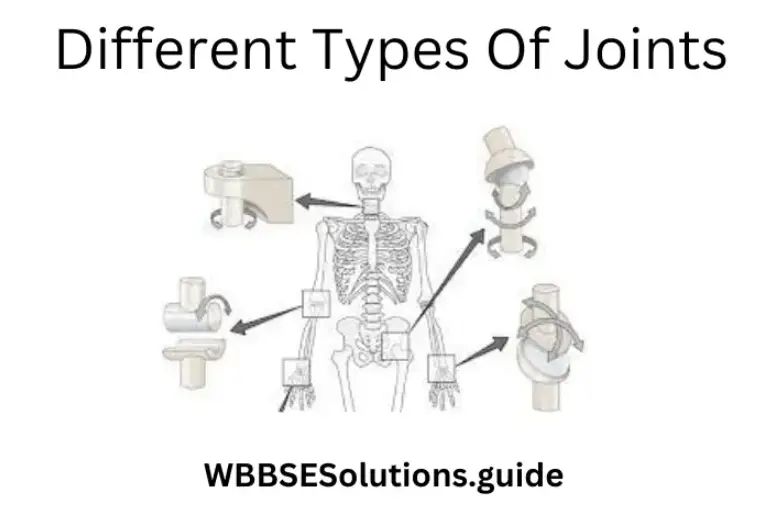
1. Immovable joint: In this type of joint no movement is possible between the two bones. The sutures between the bones of the brain box are examples of immovable joints.
2. Partially movable joint: Here only very little ‘ (partial) movement occurs between the two bones. For example, the joint between a rib and the breastbone or between the vertebrae.
3. Movable joint: In this type of joint varying degrees of movement are possible between the two bones forming the joint.
Question 13. Write two functions of the nervous system. What is a synapse? What is meninges?
Answer.
Functions of the nervous system:
Functions of the Nervous system (a) It controls the different activities of different organ systems of the body, (b) It coordinates functions of organ systems.
Synapse:
Synapse The physiological junction between the dendrites of one neuron and the terminal dendrites of another neuron is called a synapse.
Meninges:
Meninges The membranes that cover the brain are collectively called meninges.
Question 14. What is nerve? Write one characteristic of each of the afferent and efferent nerves. Mention the functions of the cerebrum.
Answer.
Nerve:
(1) Nerve A collection of nerve fibers covered by myelin sheath is called a nerve.
(2) Characteristics of afferent and efferent nerves
(1) Afferent nerve is made up of sensory neurons and it carries impulses from the sense organ to the central organ.
(2) Efferent nerve is made up of motor neurons and it carries impulses from the central organ to the motor organ.
(3) Function of cerebrum
(1) It controls all types of voluntary movements of muscles.
(2) It regulates and co-ordinates the voluntary movements.
(3) It controls the movement of the ball.
Question 15. Write two functions of the cerebral cortex. Describe the protective part of the eyes.
Answer.
Functions of the cerebral cortex
(1) Functions of cerebral cortex (1) Cerebral cortex establishes the conditioned reflex actions through the development of new connections with different subcortical centers.
(2) It controls the activity of autonomic nervous system.
(2) Sclera It is the outermost layer of the eye. It is made of very tough connective tissue and forms the white portion of the eye. This part is called the cornea. It is covered by a membrane called conjunctiva.
Question 16. Wis an isa neuron? Discuss the relation between a neuron and a nerve. What is ganglion?
Answer.
Neuron
(1) Neurone The structural and functional unit of the nervous system is called the neurone.
(2) Relation between the neuron and a nerve Neurone is the structural and functional unit of the nervous system. A bundle of nerve fibers covered with special connective tissue is called a nerve. Relation The nerve fibre of a neurone is the main material of a nerve. Hence, neurons take an active part in the production of a nerve.
(3) Ganglion The structure formed by the fusion of cell bodies of neurons located outside the Central Nervous System is called a ganglion.
Question 17. What do you understand nervous system? Mention the characteristics and features of afferent and efferent nerves. What is a synapse?
Answer.
Nervous system:
(1) Nervous system The organ system which is only present in higher group of animals whose main function is to control and coordinate the functions
of other organ systems of the body, called the nervous system.
(2) Characteristic features of afferent nerve
(1) It is made by nefibersbres of sensory neurons.
(2) It carries impulses from the receptor of sense organs to central organs (brain and spinal cord).
(3) Characteristic features of efferent nerve
(1) It is made by nerve fibers of motor neurons.
(2) It carries impulses from the central organ to the motor organ (Muscles and glands).
(4) Synapse The physiological junction between the terminal, dendrite neuronurone with the dendrite of another neuron is called a synapse.
Question 18. Describe in brief the three main parts of the human brain. Mention two functions of skin as a sense organ.
Answer.
Three main parts of the human brain
(1) Structure of three main parts of the human brain
(1) Cerebrum, (2) Cerebellum, (3) Medulla oblongata.
(1) Cereb It is the largest part of the brain. It is ® the part of the full brain. Its mass is 1050 gm. It has a fissure in its length due to which it seems it is made by two hemispheres. The shape of each part is semi-spherical. This part has sulci and gyrus.
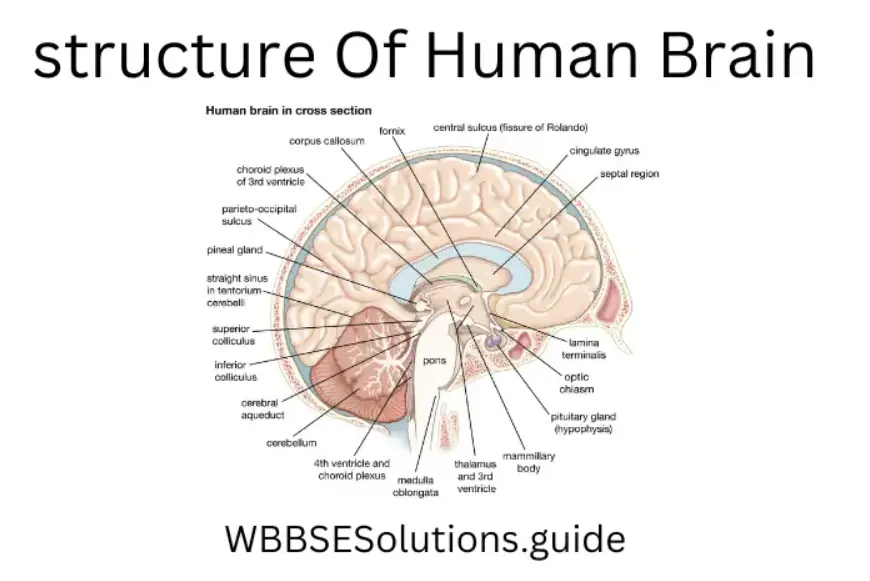
(2) Cerebellum It is fully covered by cerebrum. It is divided into two parts (left and right). The left part is related to left-organ scans and the right part is related to the right-side organs of the body.
(3) Medulla oblongata is the lowest part of the brain. It is located between the cerebellum and the Spinal Cord. Its outer and inner parts are made up of white matter and grey matter respectively.
(2) Two functions of skin as a sense organ
(1) It receives external stimuli! (i.e., hot, cold, pain of Alpin)
(2) It realizes pressure and weight
Question 19. What is a nerve? What is its function? Mention the characteristics of two main types of nerves and cite examples.
Answer.
Nerve:
(1) Nerve A collection of nerve fibers covered by myelin sheath is called a nerve.
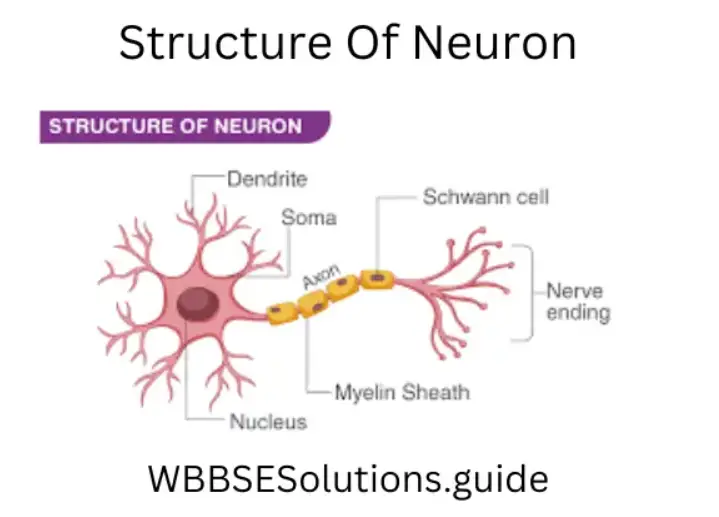
(2) Function of a nerve It carries impulses from receptor organs to the central organ and from the central organ to motor organs.
(3) Characteristics of afferent and efferent nerves (1) Afferent nerve is made up of sensory neurons and it carries impulses from the receptor of the sense organ to the central organ.
(2) Efferent nerve is made up of motor neurons and it carries impulses from the central organ to the motor organ.
(4) Examples (1) Olfactory nerve, (2) Optic nerve.
Question 20. Write one main difference between sensory and motor nerves with one example each. Mention one function of each of gibberellin, cytokinine, and thyroxine.
Answer.
Main difference between sensory and motor nerves
(1) Function of Gibberellins It promotes the development of fruits without seed.
(2) Function of Cytokinine It takes part in the cytokinesis of plant cells.
(3) Function of Thyroxine By increasing the blood sugar level, synthesizing protein (in low dose), and depressing protein synthesis (in high dose) it influences metabolism.
Question 21. Describe the structure of the human eye. Explain the mechanism of vision.
Answer.
The structure of the human eye
Each eye is spherical. It lies in a cavity in the skull called the eye socket and is attached to it by three pairs of muscles that move it in different directions. The eyeball is hollow.
Structure Eye is made up of three layers
(1) Sclera, (2) Choroid, (3) Retina.
(1) Sclera It is the outermost layer. It is made of very tough connective tissue and forms the white portion of the eye. This part is called the cornea. It is covered by a membrane called conjunctiva.
(2) Choroid It is the middle layer. It contains many capillaries. It supplies nutrients to the inner parts of the eye. The choroid forms the pigmented muscular curtain which is called the iris. The hole of the iris is called the pupil which is round-shaped
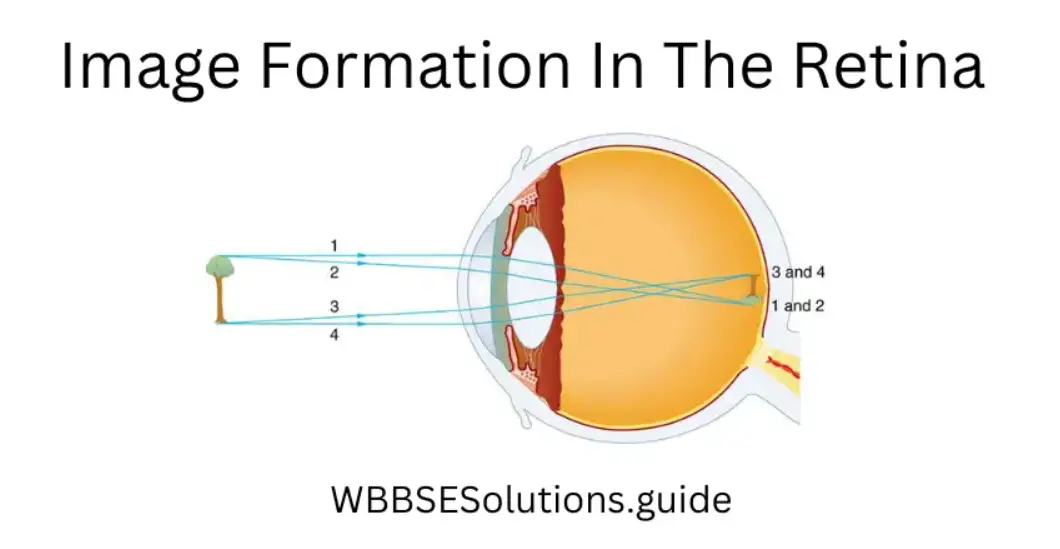
(3) Retina The innermost layer which is a very delicate sheet of tissue, called the retina. This layer contains the rod and cone cells which are sensitive to light and color respectively. These cells are more closely packed at a spot point. This spot is called the yellow spot Optic nerve meets at a point of this layer. This point is called the blind spot. Here sensory cells are absent. The place of the retina at the front of the eye is taken by the circular transparent biconvex lens which is held in place by suspensory ligament The suspensory ligament is attached to the choroid coat at its outer edge. The part of the eye in front of the lens is filled with watery aqueous humor. The part behind the lens is filled with telly-like vitreous humor.
Mechanism of vision All the transparent parts of the eye allow light to pass through them. The pigmented parts limit the amount of light entering the eye. The iris allows light to enter the eye only through the pupil. The cornea, aqueous humor, lens, and vitreous humor all act as refracting media. They make the images falling on the retina clear and detailed. The images formed on the retina are inverted (real), but in the brain, this is corrected to give the impression of an erect object
Question 22. How many types of reflex actions are there? Explain with examples.
Answer.
(1) Types of reflex action There are two types of reflex action :
(1) Inborn or unconditioned reflex action.
(2) Conditioned reflex action.
(1) Inborn or unconditioned reflex action A reflex action that is present in the body from the time of birth is called unconditional or unconditioned reflex action.
Example – Knee Jerk reflex action.
(2) Acquired or conditioned reflex action The reflex action that is acquired as a result of repeated training after birth is called acquired or conditioned reflex action.
Example – Salivation in the absence of food but in the presence of a stimulus like a ringing bell.
Question23. What is Auxin hormone? Write three functions of this hormone.
Answer.
Auxin hormone:
(1) Auxin: A group of nitrogenous orgaadsadds containing an indole group produced within meristematic tissue of root and stem apex is called Auxin.
(2) Functions of auxin –
(1) Controlling weeds: By spraying 2,4-D (2,4 – Dichloro phenoxy acetic acid) unwanted dicotyledonous weed plants can be destroyed from the field mono-cotyledonousous crops like wheat.
(2) Rooting of cutting: Cutting is a method of artificial vegetative reproduction. One end of the branch is dipped into a solution of Auxin before placing it into the ground. It increases the rate of rooting.
(3) In parthenocarpy: It helps in the formation of seedless fruits.
Question 24. What is the unit of the nervous system? Mention the names of its three major parts. What is reflex action? Cite one example of reflex action.
Answer.
(1) Name of the unit of nervous system Neurone.
(2) Name of three major parts of neuron (1) Cell body, (2) Dendron, (3) Axon.
(3) Reflex action The involuntary automatic actions controlled by the Central Nervous System are called reflex action.
Example Uplift of leg when touched with a hot object
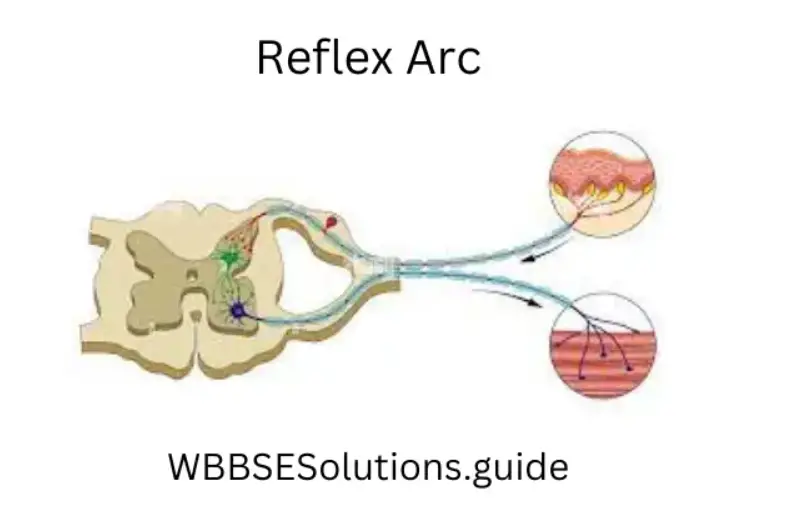
Question 25. Mention the sources of gibberellins and kinins. Discuss the applicative aspects of plant hormones in agriculture.
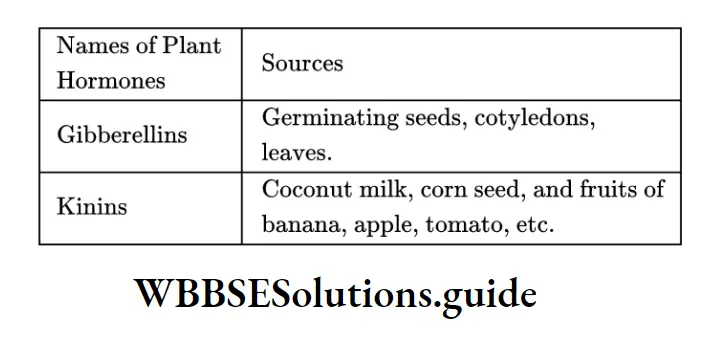
(2) Applicative aspects of plant hormones in agriculture
(1) In the destruction of weeds Dicotyledonous herbs like amaranthus are removed from the field of monocotyledonous crops like wheat by the spray of 2.4 -D and 2,4,5 Tricholorophenoxy acetic acid.
(2) Prevent sprouting The development of adventitious buds of tubers is controlled by the use of auxin. So, potatoes can be stored for a longer time.
(3) For early rooting During cutting IAA and IBA are used at the cut ends. It initiates early rooting at the cut ends.
Question 26. Write two functions of gibberellines. How is glucose regulated in the blood? Which hormone decreases glucose levels in the blood?
Answer.
Functions of Gibberellins –
(1) It checks and minimizes the dormancy period of seeds.
(2) It takes part in sex determination.
(2) Process of regulation of glucose in the blood:-
Regulation of glucose in the blood is done by insulin. It increases the rate of glucose absorption and stimulates the process of glycolysis. It also helps in the synthesis of glycogen in liver and muscle cells. It prevents the conversion of glycogen to glucose. It induces the synthesis of fat from glucose in adipose tissue and maintains the glucose level in the blood.
(3) Insulin.
Question 27. Why are hormones called chemical coordinators in the living body? Write the site of formation and any two functions of the Gibberelline hormone.
Answer.
(1) Hormones a£ chemical co-ordinator in the body of an organism:- Hormones are complex organic chemicals that are produced in one part of an organism and obtain information about their function from here and then transported to another part of the organism where they perform their function. Hormones control the various metabolic reactions and bring a co-ordination between different metabolic reactions.
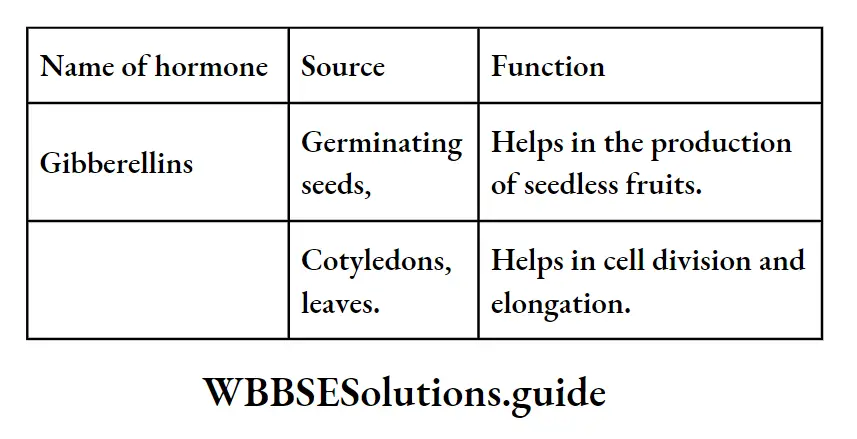
Question 28. Which hormone is known as the ’emergency hormone’ and why? Write the sources of gibberellin and any two functions of the hormone.
Answer.
(1) Adrenalin hormone is known as emergency hormone. Reason:- It is secreted at the time of danger and helps to control sudden excitement by influencing the nervous system and increasing blood flow, thereby helping the person to face the abnormal condition successfully.

Question 29. Where is the thyroid gland located? Name the hormones secreted from it. What are the main functions of those hormones?
Answer.
(1) The thyroid gland is situated at the root of the throat, one on either side of the trachea. The two lobes are joined by an isthmus, which is situated in front of the 2nd, 3rd, and 4th tracheal rings.
(2) (1) Thyroxine (2) Calcitonin.
(3) Functions of Thyroxine
(1) Thyroxine increases the metabolic activities of almost all the tissues of the body.
(2) It has effects on growth.
(3) It causes vasodilation in most body tissue, thus increasing blood flow.
(4) It increases the rate of heartbeat
(5) It increases the rate of respiration.
(6) It increases the rapidity of secretion of the digestive juice.
Function of Calcitonin
(1) It promotes the deposition of calcium in the bones and decreases extracellular fluid calcium ion concentration.
(2) It maintains calcium balance in the blood.
Question 30. What is the source of estrogen and testosterone hormones in the human body and write two functions of each.
Answer.
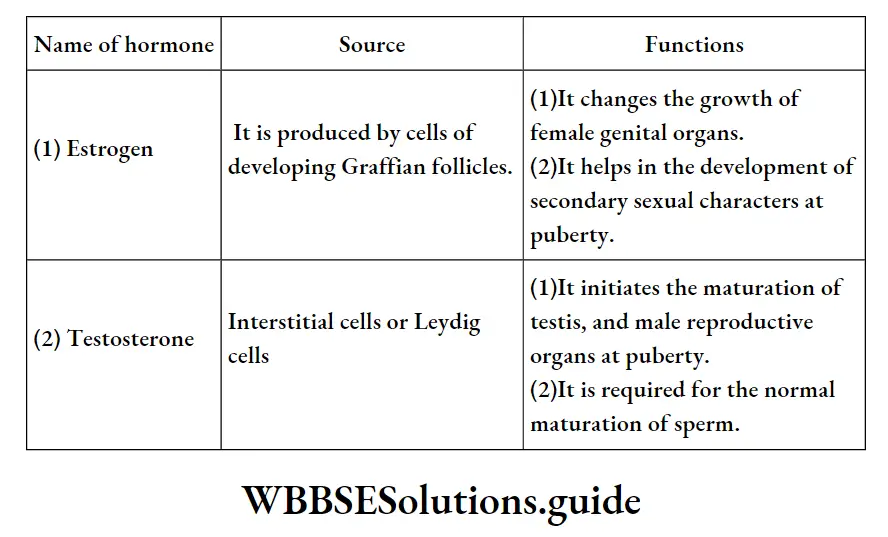
Question 31. Mention the names of two female sex hormones and one function of each of those.
Answer.
(1) Estrogen (2) Progesterone.
The function of Estrogen Estrogen controls the development of female sex organs and female features.
The function of Progesterone Progesterone controls the uterus changes in the menstrual cycle.
Question 32. Wherefrom are TSH and thyroxine hormones secreted? Mention any two functions of the thyroxine hormone. Name the diseases caused by to hyposecretion of this hormone among children and adults.
Answer.
(1) TSH (Thyroid Stimulating Hormone) is secreted from the anterior lobe of the pituitary gland.
Thyroxine is secreted from the thyroid gland.
(2) Function of thyroxine hormone (1) It controls metabolic reaction.
(2) This hormone helps in the development of the nervous system.
(3) Children – Cretinism, Adult – Myxoedema.
Question 33. Mention the source of Insulin. Mention the functions of this hormone. Which hormone is called emergency hormone and why?
Answer.
(1) Beta cells of islets of Langerhans (pancreas) are the source of Insulin.
(2) It reduces the blood sugar level by converting glucose into glycogen.
(3) Adrenalin is called emergency hormone. Because it gives courage to the
individual during an emergency period, i.e., anger, fear, etc.
Question34. Which hormone is known as the “Emergency hormone”? From which gland is it secreted? Discuss two functions of that hormone. Mention the place of secretion and the place of action of auxins.
Answer.
(1) Name of Emergency Hormone Adrenaline.
(2) Name of the gland Adrenal medulla.
(3) Function of Adrenaline (1) It increases the rate of blood circulation, (2) It increases the rate and depth of respiration.
(4) Place of secretion of auxins Apical meristematic tissue of root and stem.
(5) Place of action of auxins It acts at the place of cell division and cell elongation.
(3) Sites of secretion and functions of insulin and adrenaline hormones :
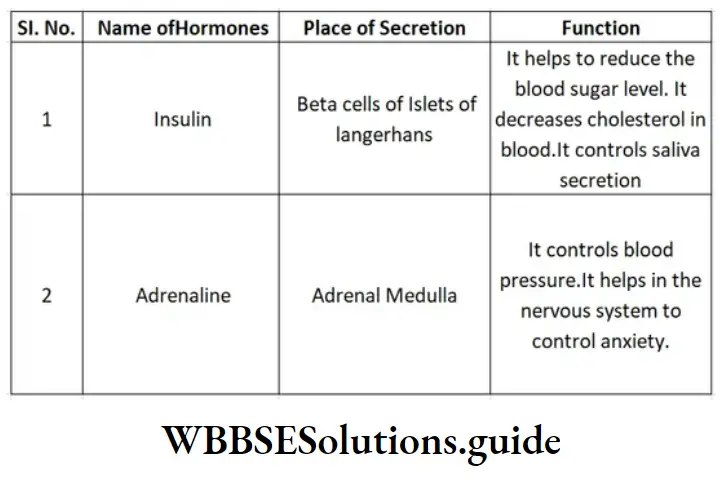
Question 35. Name three animal hormones that are not secreted from the pituitary gland mention their sources and write the functions of any two of those hormones.
Answer.
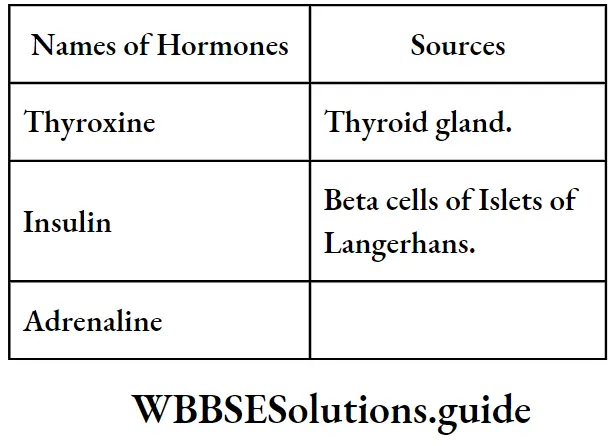
(2) Functions of thyroxine and insulin
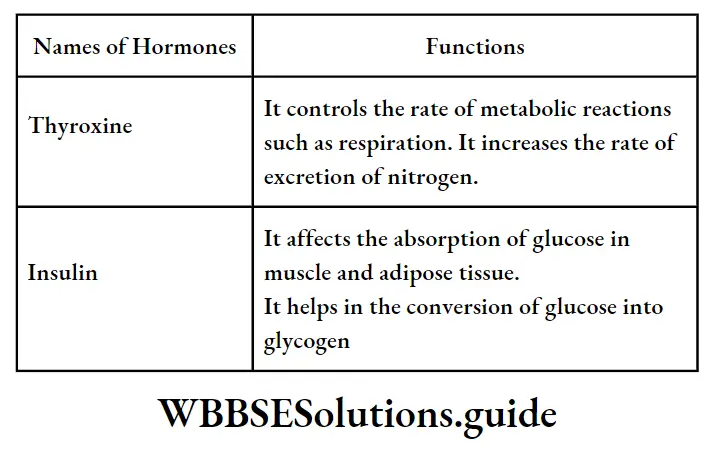
Question 36. Which gland is considered the master gland and why? Mention the name band function of two trophic hormones secreted from this gland.
Ans. (1) (1) Pituitary gland is considered as the Master gland.
(2) Reason This gland is considered a Master gland because some hormones secreted from its anterior lobe control the functions of another endocrine gland.
(2) (1) TSH (Thyroid Stimulating Hormone) It initiates the thyroid gland to secret thyroxin.
(2) GTH (Gonado Trophic Hormone) influences the growth of the testis in males and ovaries in females.
Question37. Write two characteristics of hormones. Why is a hormone called the “chemical messenger”? Mention one functional difference between the nervous system and the endocrine system.
Answer:
Characteristics of hormones
- Their molecular weight is low.
- Their remaining quantity is destroyed and excreted at the end of the reaction.
- Because they have received orders from their place of production (such as endocrine glands) and act accordingly on the target organs.
- Nervous System
- It does not take part in metabolism.
- Endocrine System
- It takes part in metabolism.
Question 38. Name two hormones that are responsible for apical dominance and division of cytoplasm in plant cells respectively. Write the full name of two hormones produced in the anterior pituitary and one function of each.
Answer.
(1) Hormone responsible for apical dominance —Auxin
(2)Hormone responsible for the division of —– cytoplasm
(3) (1)TSHACTH —ThyroidAdrenoStimulatingCortico (2)TrophicHormoneHormone—Cytokinin.
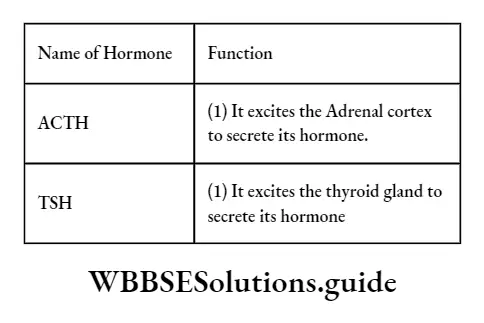
Question 39. Describe the parts of the Nervous system.
Answer.
Parts of the Nervous system
(1) Central Nervous System (CNS): This part of the nervous system is the supreme controller of all body responses. CNS includes :
(1) Brain or Encephalon, which occupies the cranial cavity, and contains the higher governing centers.
(2) Peripheral Nervous System (PNS): All nerves originating from the CNS and constituting the PNS are subdivided into the following two components :
(1) Cerebrospinal nervous system: It is the somatic component of the PNS which includes 12 pairs of cranial nerves (originating from the brain) and 31 pairs of spinal nerves (originating from the spinal cord). It innervates (supplies) the somatic structures of the head and neck, limbs, and body wall.
(2) Autonomic nervous system (ANS): It is the visceral component of the PNS which includes the visceral or splanchnic nerves. It innervates the viscera, glands,
blood vessels and nonstriated muscles.
ANS consists of two divisions :
(1) Sympathetic and (2) para-sympathetic systems.
These two systems have antagonistic effects, i.e., while one system promotes the activity of the organs, the other system retards. Thus they control and co-ordinate the activities of internal or visceral organs. This coordination is involuntary
Question 40. What is the unit of the nervous system? Describe its structure and functions.
Answer.
Unit of the nervous system
(1) Neuron(e) is the unit of the nervous system.
(2) Structure of Neuron (e): It is the structural and functional unit of the nervous system and consists of a nerve cell body with all its processes.
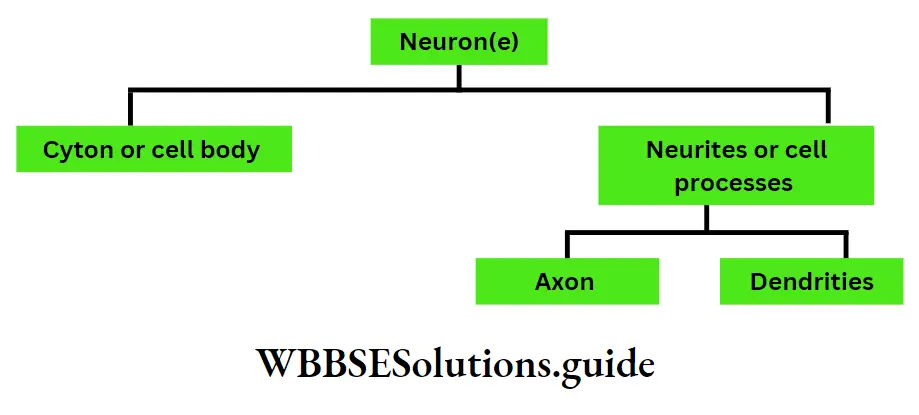
1. CYTON : (also called soma or perikaryon)
The soma is present In the following places of the nervous system.
(1) In the grey matter of CNS.
(2) small clusters called ganglia in the PNS.
It is found in different sizes and shapes (spherical, oval, spindle, etc.) It consists of the following :
1. Neuroplasm: It is a mass of cytoplasm surrounded by a cell membrane.
Various structures are suspended in it
2. Nucleus: It occupies the central part of the soma and contains, usually, one prominent nucleolus.
Function: Controls all the functions of the cyton.
3. Nissl bodies (also called tigroid substances): They are named after the discoveror Franz Nissl. These are granular structures (maybe rod-shaped) present all over the cyton. They may extend in the dendrites but not in the Axon.
Function: They synthesize the proteins of neurons.
4. Mitochondria: It is present both in cyton and axon.
Function: Performs respiration (production of ATP)
5. Neuro-fibrils: These are thread-like structures. They are present in both soma and neurites.
Function: They transmit impulses.
6. Centrioles: In the past, it has often been stated that centrioles are not present in neurons but studies with the electron microscope have shown that centrioles are present.
Function: They help in the production and maintenance of micro-tubules. Besides these, some other structures are also present
1. Golgi apparatus
4. Lyso-somes
2. Neurites or cell processes :
The processes arising from the cell body of a neuron are called neurites. These are of two kinds : (1) Dendrites and (2) Axon.
1. Dendrites or Dendrons: These are short; numerous, afferent processes arising from the different regions of the cyton. They are characterized by the following :
(1) They are tapering processes, i.e., thick at the origin but much thinner at the end.
(2) They branch repeatedly and irregularly.
(3) They bear numerous small spines called Gemmules to increase the surface area.
(4) Their cytoplasm consists of neurofibrils,missess granules, and mitochondria.
(5) They are rough in external appearance.
Functions :
1. They receive the sensory impulses and conduct them towards the cell body.
2. In some cases they modify to act as receptors, e.g. Dendrons of olfactory cells modify into olfactory rods and receive impulses or olfaction (smell) in the olfactory region of our nose.
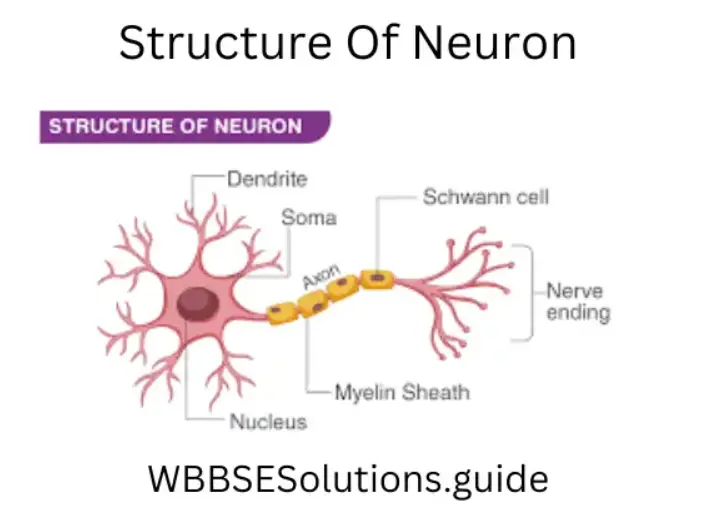
2. Axon or Axis Cylinder or Neuraxon: It is a single long efferent process arising from the axon hillock of the cyton and is of uniform thickness. It is better known as “nerve fiber”. Based on the presence of myelin sheath, it is of two types:
(1) Myelinated and (2) Non-Myelinated nerve fibers.
(1) Myelinated or Medullated Nerve Fibers: As the name suggests, they are surrounded by a layer of the myelin sheath. The nerves look white (due to the high refractive index of the myelin sheath). The great majority of nerve fibers in our body are myelinated nerves. They are found in
(1) The white matter of central nervous system.
(2) The peripheral nerves. It consists of the following parts from inside outwards
(1) Axis Cylinder: It constitutes:-
The Axoplasm: It is the central core of the axon and is pasty (semi-fluid) in nature. Within the axoplasm (1) mitochondria, (b) axoplasmic vesicles and
(2) neuro fibrils can be seen but its granules are absent (It also contains axis fibrils that run parallel to the axis of the fiber).
Axolemma: The axoplasm is ensheathed (covered) by a membrane called axolemma. It is a non-nucleated, semi-permeable membrane.
Functions: Many substances like proteins are not synthesized by the axon but are formed by the cyton. These substances are transported from the cyton to the whole of the axon by the axoplasm. This transportation is called axonal flow.
(2) Myelin sheath or Medullary sheath: Outside the axis cylinder lies the myelin sheath. Myelin has a whitish appearance. The sheath is made up of lipid materials and protein. It is formed by:-
(1) The Schwann cells (In peripheral nerves)
(2) Oligodendrocytes (In the nerves of CNS)
Functions : (1) Increases the speed of conduction of nerve impulse, (2) Acts as an insulator by reducing loss of electrical activity.
(3) Neurilemma (Neurolemma) (Also called Schwann cell sheath): This is the externalmost covering of the axon. It is unbroken and nucleated.
Functions: It helps in the regeneration of nerves.
(4) Nodes and Inter-nodes: The myelin sheath does not form a continuous sheath but is interrupted at regular intervals. The gaps so produced are seen as constrictions or nodes known as the Nodes of Ranvier. The segment of the axon between two successive nodes is called an “Inter-nodal segment”. The longer the segment, the faster the rate of conduction of nerve impulses.
(5) Schwann Cells: They lie between the neurilemma and the myelin sheath. In between two nodes of Ranvier, there is a single cell consisting of one (and only one) nucleus of Schwann.
Function: They are responsible for the formation of the myelin sheath.
(6) Endoneurium: It is a tube of connective tissue that envelopes each nerve
Fibre outside the neurilemma.
Wbbse Class 10 Life Science Question Answer
(7) Branches of axon: An axon may give off a variable number of branches. At its termination, the axon breaks up into several fine branches called telodendria. From the sides of the axon, several branches arise at right angles and are known as collaterals. The collaterals and telocentric often form small bulbous swellings at the synapse called terminal boutons (or bouton teminaux).
2) Amyelinated or Non-medullated nerve fibers (Also called fibers of the remark): These nerve fibers are called non-medullated because they have no myelin sheath. Thus, their diameter is very small. It consists of an axis cylinder covered by neurilemma with a single cell of Schwann. Nodes of Ranvier are absent They are found in :
(1) The grey matter of CNS. (2) The peripheral nerves. The function of Axon: They transmit the impulses away from the cell body to the other neurons via a synapse.
Question 41. How many types of neurons are there?
Answer.
Neurons are classified on the following basis:-
(1) based on the direction of transmission of impulses :
(1) Motor neurons: Transmit impulses from the CNS to the effectors.
(2) Sensory neurons: Transmit impulses from receptors to the CNS.
(3) Intermediate neurons: Confined to the CNS and connect the motor and the sensory neurons.
(2) based on the number of fibers arising from nerve cells :
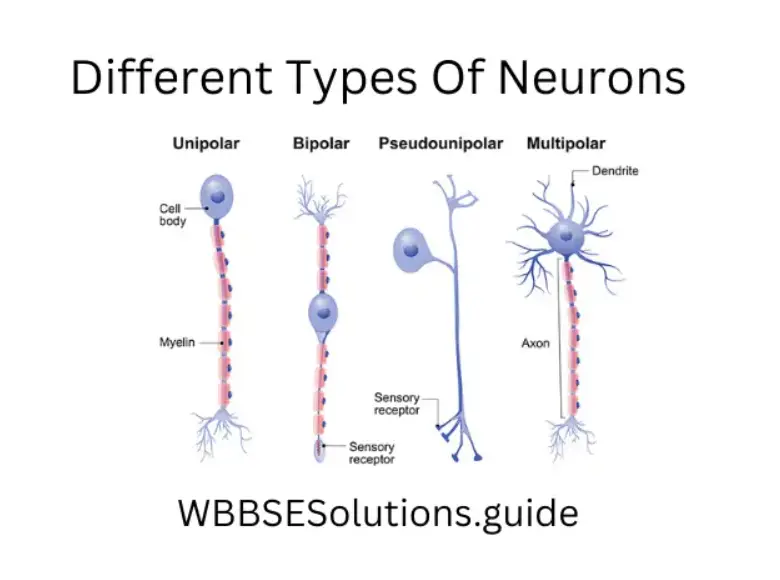
(1) Apolar: Having no axon or dendrites.
(2) Unipolar : A neuron with a single fibre.
(3) Bipolar: A neuron with two fibers, e.g. a neuron with one dendrite and one axon.
(4) Multipolar: A neuron with many fibers.
(3) based on the presence of myelin sheath :
(1) Myelinated: Those neurons whose axons have a covering- of the myelin sheath.
(2) Non-Myelinated: Those neurons whose axons do not have a covering of myelin sheath.
Question 42. Name the different cranial nerves. Mention the organs innervated and their functions.
Answer:
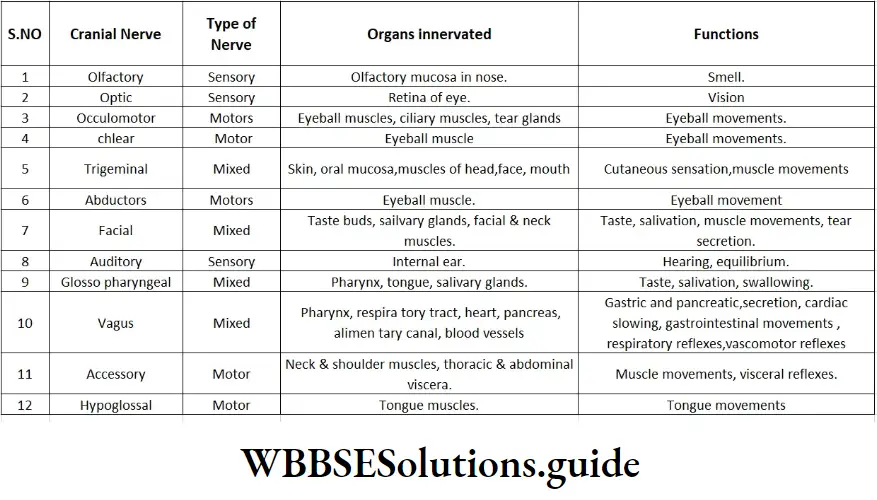
Question 43. What are the characteristic features of afferent and efferent nerves?
Answer.
Characteristic features of afferent nerve :
1. It is also called sensory nerve.
2. It arises from the dorsal horn and runs through the dorsal nerve root of the spinal cord.
3. It connects the sensory organs to the brain and spinal cord.
4. It carries the stimulusthe the brain and spinal cord the the rom sensorgansrgan.
5. They are generally unipolar or bipolar.
Example : 1st, 2nd & 8th cranial nerves.
Characteristic features of efferent nerve :
1. It is also called a motor nerve.
2. It arises from the right ventral horn and runs through the ugh ventral nerve root the the of spinal cord.
3. It connected the cts brain and spinal cord to the effector organs, that is, muscles and glands.
4. It carries impulses from the brain and spinal cord to the effector organs.
5. They are generally multipolar. Ex: 11th & 12th cranial nerves.
Wbbse Class 10 Life Science Question Answer
Question 44. What is the importance of the nervous system? Write the name of the structural and functional unit of the nervous system.
Answer.
Importance of the nervous system
(1) The importance of the nervous system is explained as follows :
(1) It controls, harmonizes, and regulates all voluntary muscular activities, involuntary activities such as breathing, heating of the heart, rates of secretion of some endocrine gland and ds, rapidly changing visceral ever to bring about coordination among the various organs of the body.
(2) It is responsible for memory and intelligence and provides higher mental processes, i.e., consciousness, ambition, and judgment It is also responsible for emotional activities. Thus it enables us to remember, to think, and to reason.
(3) The nervous system acts as a museum of past incidents and experiences.
(4) The stimuli in the form of nerve impulses travel along the incoming nerve from the receptors to the spinal cord and the brain. Here the impulses are analysed and order is passed into other outgoing nerves which lead the information from the brain to the effector organs which then makes a suitable response.
(2) The structural and functional unit of the nervous system is the neuron.
Question45. Mention the functions of any three of the arts of neurons.
Answer.
The function of the ions of three main neurons neurons are
(1) Cyton or cell body: Its functions are
1. It receives nerve impulses from its dendrite and transmits them to the axon.
2. It produces nerve processes.
3. It also provides space for the attachment of nerve processes.
4. The Nissl bodies contain RNA and act like ribosomes.
5. It has some degeneration generation and regeneration of neurons.
(2) Dendrites (Dendron) Its functions are
1. They impulses impulses from the axon of the other, neuron and send the impulses
to the cell body.
2. It establishes fun relations relation with other neurons.
3. In some neurons dendrites are modified into receptors.
3) Axon: Its functions are:-
1. Axons act as efferent processes that receive impulses from the cell body and transmit
them to the next neuron through synapses or to the muscles through
junctions.
2. It establishes junctional relations with other neurons.
3. It takes part in the formation of nerve fibers.
Question 46. What is a synapse? Mention one similarity and one dissimilarity between the functions of the nervous system and hormones in the animal body.
Ans.
Synapse – The specialized junctions of neurons with one another or with effector organs (muscle or gland) are termed synapses.
OR, The point of junctional communication or contact between the dendrites of one neuron and the axon or cell body of another neuron is called a synapse.
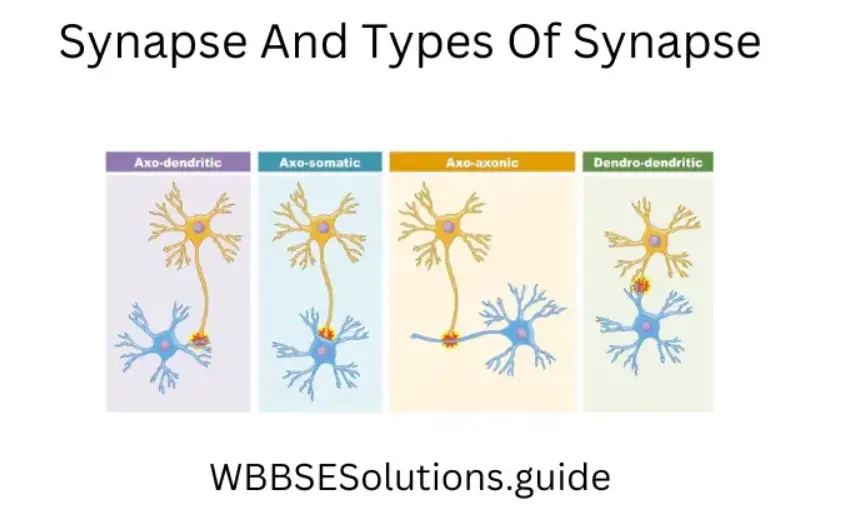
(2) Distribution – Synapses occur in the central nervous system and the ganglia of the autonomic nervous system.
(3) Types – 1 . Axoaxonic
2. Axosomatic 3. Axon dendritic.
(4) Function – Transmission of impulse between the neurons.
2. Basis Nervous system And Hormone
similarity coordination
Dissimilarity physicochemical chemical coordinator
Rapid in action slow in action
47. What is neurone ? Discuss the relation between a neuron and a nerve. What is ganglion?
Answer.
Neurone
(1) Neurone or nerve cell is the structural and functional unit of the nervous system. It consists of main three parts, viz. 1. Cell body or cyton., 2. Axon.,
3. Dendron. Its main function is the transmission of impulses.
(2) Neurone-nerve relation: A nerve is a bundle of nerve fibers ensheathed by connective tissue. Neurone is made up of an axon, having cyton or cell body and dendrites. Axon is covered by a sheath called the myelin sheath, together with neurilemma forming the axis cylinder. When two or more axis cylinders are covered by a connective tissue called endoneurium with blood vessels, then this bundle is called nerve fiber. Two or more nerve fibers may be joined by a perineurium, which may be covered by another epineurium to form a nerve.
(3) Ganglion: A mass of nervous tissue containing many cell bodies and synapses usually enclosed in a connective tissue sheath. In vertebrates, most ganglia occur outside the CNS (exceptions are basal ganglia in the brain).
In invertebrates, ganglia occur along the nerve cords and most anterior pairs are analogous to the vertebrate brain, invertebrate ganglia constitute a part of the CNS
Types : (1) Basal Ganglia: It receives impulses from the thalamus and influences motor impulses.
(2) Submandibular ganglia It relays impulse to the submandibular and sublingual salivary gland.
Question 48. What is the brain? A chart shows the different parts of the human brain.
Answer.
Brain
The brain is the master organ of the body. The human brain, a highly specialized organ, is present in a bony case called cranium which protects it from external injuries. The brain of an adult weighs about 1350 gms and is mainly composed of nervous tissue. In the brain, the grey matter is situated on the surface while the white matter forms the interior.
The brain can be differentiated into three main regions: forebrain, midbrain, and hindbrain.
Wbbse Class 10 Life Science Question Answer
Question 49. Describe the structure & functions of the forebrain.
Answer.
Cerebrum :
1. It is the largest part of the brain and is proportionally larger in man than in any other animal.
2. It consists of two cerebral hemispheres joined together by a broad curved thick band of nerve fibers called corpus callosum.
3. The cerebral hemispheres have an outer region of densely packed nerve cells called the cerebral cortex. It forms the grey matter of the brain.
4. Each cerebral hemisphere is divided into four lobes namely frontal, parietal, temporal, and occipital by three deep and wide fissures. The specific areas control different activities of the body.
5. The surface area of each hemisphere is increased by numerous infoldings or convolutions called gyri (singular gyrus). The gyri are separated by depressions called sulci.
6. The cerebral cortex is the region of various kinds of activities. These can be broadly classified into three areas.
Functions: 1. The sensory areas receive impulses from receptors and register impressions of what we see, hear, and feel.
2. The motor areas transmit impulses to various organs and control voluntary movements like the activities of the trunk, limbs, and face.
3. The association areas give the ability to register impressions and respond by interpreting past experiences. It is associated with memory, learning, reasoning, and intelligence
(2) Thalamus: It is a region present at the center of the forebrain.
All sensory information that reaches the cerebral hemispheres first passes through the thalamus.
Function: Its function is to interpret sensory signals and then channel them to the appropriate cerebral cortex region.
(3) Hypothalamus: It is present beneath the thalamus, hence the name hypothalamus (Hypo = below). It consists of grey matter scattered in the white matter.
Functions: 1. It is a control center for many internal control mechanisms or the autonomic nervous system and is associated with temperature regulation, water balance, hunger, blood pressure, etc.
2. It is also a reflex control center and is associated with sleeping, feeding, emotions, etc.
3. In association with the pituitary gland it secretes neurohormones and controls the release of hormones from the anterior pituitary.
4. It also controls the synthesis and release of posterior pituitary hormones.
Question 50. Name the cells from which the midbrain is made up. Mention its functions.
Answer.
Midbrain: It, consists of groups of nerve cells – grey matter scattered in the white matter. It connects the forebrain and the hindbrain. It has four corpora quadrig
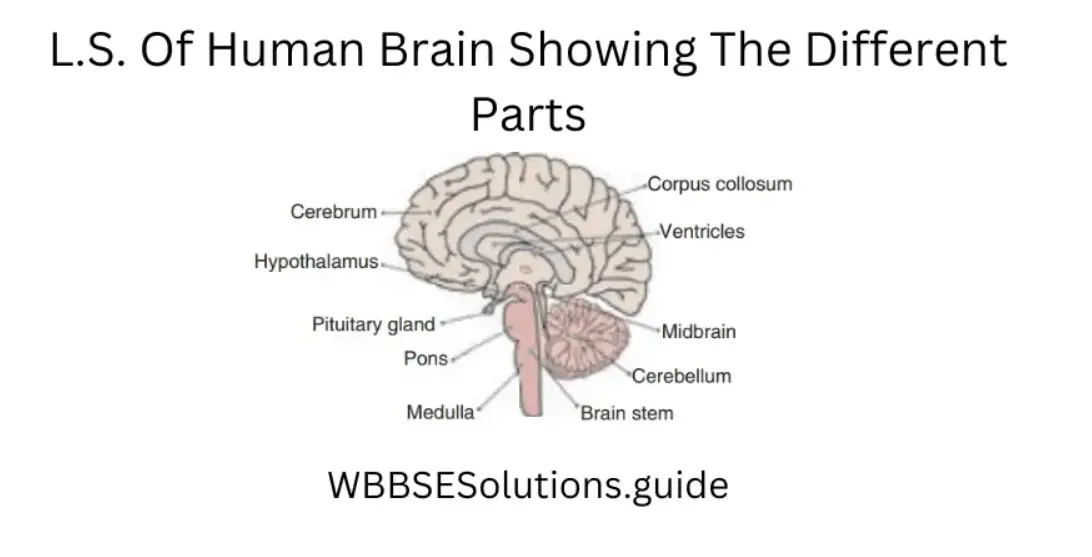
Functions: 1. It is the reflex center of every movement and auditory response.
2. The lower part of mid brain is associated with muscular reflexes and balancing reflexes. Mid brain can not be easily distinguished as it is enclosed by the forebrain.
(2) LH: In males, it is known as ICSH. (1) In Female: It controls ovulation.
(2) In Male: It helps the secretion of testosterone hormone.
Question 51. Mention the structure & functions of different parts of the hindbrain.
Answer.
Hindbrain: It consists of the cerebellum on the dorsal side and the brain stem (pons and medulla) on the ventral side.
Cerebellum: It is somewhat at the back of the head and consists of two cerebellar hemispheres just like the cerebrum. It also has grey matter on the surface and white matter in the central part It gives the appearance of two halves of a large walnut
Function:
(1) It is a large reflex center for the coordination of muscular body movements and
(2) maintenance of posture or equilibrium.
(3) The cerebellum is also associated with certain voluntary muscular movements originating in the forebrain.
Pons: It lies just above the medulla and acts as a bridge carrying ascending and descending tracts between the brain and spinal cord.
Function: It sends impulses to the cerebellum and controls breathing.
Medulla oblongata or medulla: It is the posterior-most part of the brain and continues into the spinal cord. Various ascending and descending tracts cross over from left to right and right to left in the medulla. Any damage to one of its sides causes paralysis on the opposite side of the body.
Function: 1. Since it carries the nerve tracts connecting the spinal cord to the brain, all communications between the brain and the spinal cord pass through it
2. It also contains the cardiac, respiratory, and vasomotor centers that control
complex activities like heart action, respiration, coughing, etc.
Question 52. What is a plant hormone? Name the different types of plant hormones.
Answer.
Plant hormone:
(1) Phytohormones: The organic compounds, synthesized in certain parts of the plants but exerting their influence in some other parts are called plant hormones
or phytohormones.
(2) In plants only five substances are officially classified as plant hormones. However, some other substances are being studied that may eventually be classified also as hormones.
The five main plant hormones are :
1. Auxin 2. Gibberellin 3. Cytokinin 4. Abscisic acid 5. Ethylene.
Wbbse Class 10 Life Science Question Answer
Question 53. What is auxin? How many types of auxin are there? Mention the physiological functions of auxin.
Answer.
Auxin:
(1) Auxin is a generic term applied to those hormones whose primary function is cell elongation.
The first auxin to be discovered is Indole 3-acetic acid (IAA). Other auxins, either natural or synthetic, resemble IAA in their physiological effects.
(2) The natural and synthetic auxins are as follows :
1. Natural Auxin: Auxins which are synthesized in plants are called natural auxins. Ex : IAA (Indole acetic acid), IPA (Indole propionic acid).
2. Synthetic Auxin: Auxins which can be synthesized in the laboratory are called synthetic auxins. Ex: NAA (Naphthalene acetic acid), IBA (Indole butyric acid); 2, 4-D (2, 4-Diclorophenoxy acetic acid), MCPA (2 Methyle 4-Chloro Phenoxy Acetic acid).
(3) The major physiological functions of auxins are as follows
1. Cell elongation
2. Apical dominance.
3. Phototropism
4. Geotropism
5. Root initiation
6. Parthenocarpy.
Delaying senescence of leaves by preventing the formation of abscissions layer.
Question 54. What are gibberellins? Who isolated them? Mention the functions of gibberellins.
Answer.
Gibberellins:
(1) Gibberellins are phytohormones first extracted from the fungus Gibberella fujikuroi (Fusarium moniliforme), the fungus that causes the banana disease, also called foolish seeding disease.
(2) The first Gibberellin was isolated in crystalline form by Yabuta and Sumiki in 1938. Chemically they are related to compounds called terpenoids.
(3) The major physiological functions of gibberellins are as follows:
1. Elongation of internodes.
2. Promotion of flowering.
3. Induction of parthenocarpy.
4. Breaking dormancy of the seeds and buds.
5. Induction of bolting, i.e., conversion of genetically dwarf plants into tall plants as well as their flowering.
Question 55. What are cytokinins? Who discovered it? Mention the important functions of cytokinins.
Answer.
Cytokinins:
(1) Cytokinins are phytohormones which induce cell division.
(2) The first cytokinin named kinetin was discovered by Miller and Skoog in 1954. Kinetin is a 6-furfury laminopurine – a degradation product of nucleic acid. Later in 1964 Letham and Miller isolated another cytokinin named Zeatin from corn milk, i.e., extract of immature corn (maize) caryopses. However, the most widely occurring cytokinin in plants is isopentenyl adenine (IPA).
(3) The major functions of cytokinins are as follows :
1. Induction of cell division.
2. Cell enlargement
3. Root and shoot initiation.
4. Breaking of seed and bud dormancy.
Question 56. Mention the source of the auxin hormone. Discuss the functions of that hormone in the plant body.
Answer.
(1) Source: Meristematic cells of growing regions like root tip, and shoot tip.
(2) Functions of auxin :
1. Cell division: Auxin hormone helps in nuclear division and thus promotes cell division. As a result, cells divide profusely which causes the growth of the meristematic region.
2. Cell elongation: Auxin softens the cell wall by removing calcium linkage present in the cell wall. It increases the uptake of water in the cell, thus the size of cells increases.
3. Callus formation: Auxin helps in callus formation for the healing of wounds. When applied to cuttings or wounds the permanent cells of the pith and the cortex region divide and redivide to form a callus – a wound tissue.
4. Cambial activity: Cambium cells become active due to the movement of IAA (Indole Acetic Acid) from the developing buds towards the region of reactivation of cambium during the growing season and take part in secondary growth.
5. Apical dominance: Auxin allows the growth of the apical or terminal bud and inhibits the growth of lateral buds.
6. Xylem formation: Auxin helps in xylem formation. The division of xylem cells takes place in the presence of auxin
7. Tropic movement: Auxin occurs at the root apex and stem apex. Auxin tends to move away from the light and towards gravity.
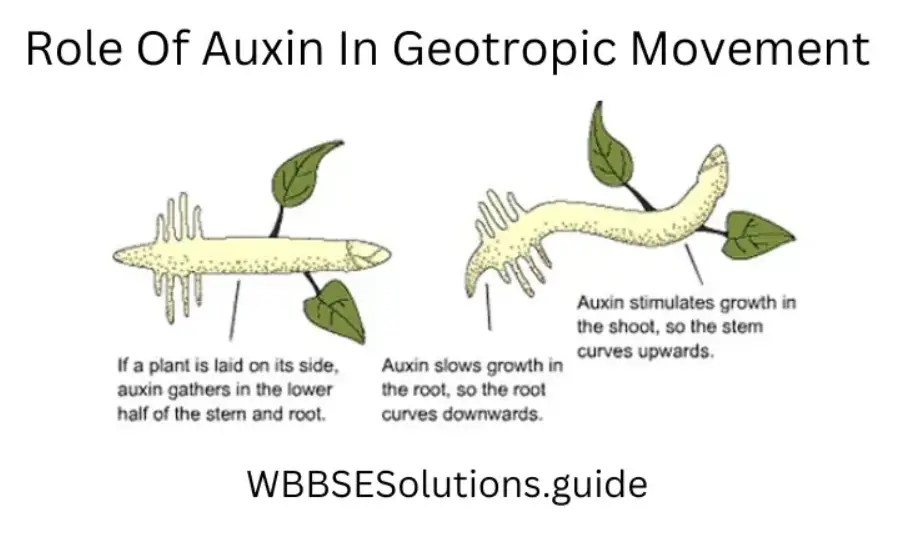
Auxin controls two types of movement:1) Phototropic movement – When light falls the auxin moves towards the darker side. The action of auxin is different in stem and root In stem more auxin causes more growth while in root more auxin causes less growth. So the stem moves towards the light showing positive phototropism and the root moves away from the light, that is towards the dark showing negative phototropism.
2) Geotropic movement – As stated earlier, the auxin moves towards gravity. More auxin causes more growth in the stem so it grows away from gravity showing negative geotropism and as more auxin causes less growth in the root it moves towards gravity showing positive geotropism.
Question 57. Name the different hormones secreted from the anterior pituitary gland. What are their functions? Mention the hyper and hypo activities of the anterior pituitary gland.
Answer.
The different hormones secreted from the anterior pituitary are :
(1) ACTH, (2) GH (3) TSH, (4) GTH.
(1) Functions of ACTH :
1. Stimulates adrenal glands to produce cortisone.
2. It also affects profound changes in the adrenal structure.
3. It stimulates lipolysis in adipose tissue and mobilises fat from it, this is called adipokinefic active of ACTH.
(1) Hypersecretion leads to Cushing’s disease.
(2) Hyposecretion leads to Addison’s disease.
(2) Functions of STH :
1. Promotes overall growth of the body.
2. Increases metabolism.
3. Reduces nitrogen excretion.
4. Promotes protein synthesis.
5. Promotes blood sugar level.
6. Reduces fat
7. Stimulates lactation in women after childbirth.
(1) Hypersecretion causes Gigantism in infants and Acromegaly in adults.
(2) Hyposecretion causes Dwarfism in infants and Simmond’s disease in adults.
(3) Functions of TSH :
1. It stimulates the growth and secretion of the thyroid gland.
2. It increases the iodine uptake.
3. It affects general metabolism.
4. It stimulates glycolysis & TCA cycle.
5. It enhances the release of stored thyroid hormones.
(1) Hypersecretion leads to Grave’s disease.
(2) Hyposecretion results in the enlargement of the thyroid gland.
(4) Functions of GTH: It influences Gonads (ovary & testis). It is of two types –
(1) FSH & (2) LH or ICSH.
(2) FSH: 1) In Females: Oestrogen secretion: It is a gonadotrophic hormone. It is gametogenic in action and stimulates the development of the ovarian follicles and secretion of estrogen hormone.
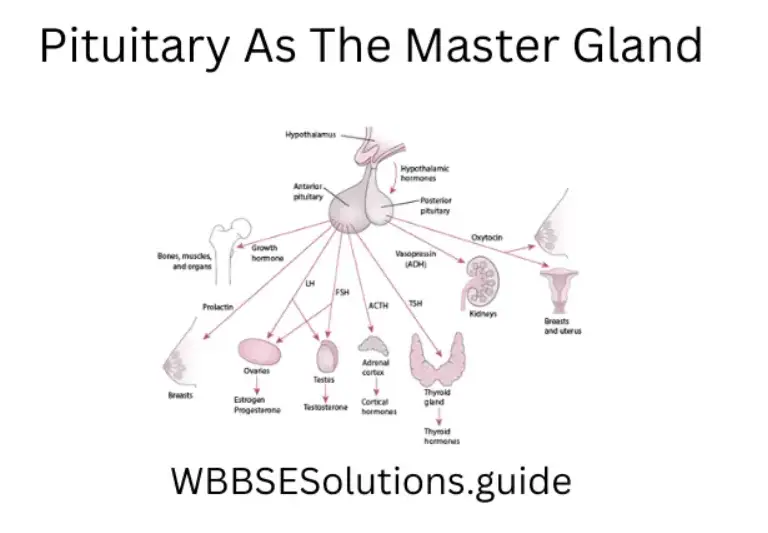
2) In Male: Spermatogenesis: It helps in cortex spermatogenesis (formation) of sperms.
(2) LH: In males, it is known as ICSH. (1) In Female: It controls ovulation.
(2) In Male: It helps the secretion of testosterone hormone.
Question 58. Mention the site of secretion and function of the Thyroxin hormone. What are the effects of its hypo and hypersecretion?
Answer.
(1) Site of Secretion – Thyroid gland.
Functions of Thyroxine (a calorigenic hormone) :
1. Regulates basic metabolism (BMR).
2. Controls absorption of glucose from the intestine.
3. Increases the blood sugar level.
4. Increases the heartbeat, cardiac output & blood pressure.
5. Controls body temperature by calorigenic effect
6. Causes normal development of the central nervous system.
7. Helps in the maturation of R.B.C.
(1) Hypersecretion causes Grave’s disease or Exophthalmic goiter.
(2) Hyposecretion causes Cretinism in children, Myxoedema in adults & Simple
Goitre (swelling of the neck, i.e., enlargement of the thyroid gland).
Question 59. Mention the site of secretion of Insulin. Discuss the functions of this hormone. Mention its hyper and hypo action.
Answer.
Site of Secretion: B cells of Islets of Langerhans of the pancreas.
(1) Functions of Insulin :
1. Glucose absorption: It influences glucose absorption in muscles and adipose tissues.
2. Controls glucose metabolism: Under its influence synthesis of glycogen from glucose in muscles and liver increases. It also reduces the breakdown of glycogen into glucose.
3. Antiketogentic: Under its influence lipids are inhibited from oxidation to produce ketone (acetone) bodies, therefore, insulin is termed as an anti-ketogenic hormone.
Hypersecretion of Insulin: Increased insulin secretion leads to hypoglycemia, i.e., decreased glucose level in the blood.
Hyposecretion of Insulin: Less insulin secretion leads to diabetes mellitus.
Question 60. Mention the site of secretion of adrenaline hormone. Discuss the function of this hormone. Mention its hyper and hypo activities.
Answer.
Site of secretion: Medulla of the adrenal gland.
(2) Functions of Adrenaline: Emergency hormone: It helps to control sudden excitement by influencing the nervous system and increasing blood flow and, therefore, is known as an emergency hormone. Controls blood pressure: It influences the blood vessels and controls blood pressure. Influences respiration: It controls the muscles of the respiratory organs and
thereby influences respiration. 3-F’s Hormone: Under conditions of fight, flight, or fright it causes changes that increase the efficiency of the animal.
For Eg.: (1) Increases heartbeat and breathing.
(2) Diversion of blood from the gut to muscles.
(3) Conversion of glycogen to glucose in the liver.
Hypersecretion: It causes rapid heartbeat, headache, and high.blood pressure, excess glucose in the blood. It also causes Cushing’s syndrome.
Hyposecretion: Addison’s disease: in the early stage of the disease, symptoms
are dark pigmentation of the skin (especially the hand, neck, and face).
Question 61. Name the hormones secreted from gonads. Mention their functions.
Answer.
1. Ovary and testis (singular) are known as gonads. The ovaries are paired oval bodies located in the pelvic cavity of a female. The important hormones secreted by the ovaries are estrogen, progesterone, and relaxin.
(1) Oestrogen: Site of secretion: Graffican follicle of the ovary, placenta.
Function : (1) Oestrogen stimulates the growth, development, and functional activities of primary and secondary sex organs.
(2) It regulates the menstrual cycle and stimulates breast development
(3) Oestrogen also has a cholesterol-lowering effect
Hypersecretion: It leads to disturbance in menses or cancer formation.
Hyposecretion: It causes failure of menses and ill-developed genital tract
(2) Progesterone: Site of Secretion: Corpus luteum of the ovary.
Functions : (1) Promotes secretory changes in uterine endometrium for pregnancy,
(2) implantation of zygote and
(3) formation of placenta,
(4) Also promotes the development of mammary glands.
Hyposecretion causes abortion and misconceptions.
2. Testes (plural) are located in the scrotal sac, hanging outside of the body at the junction of two legs in males. The main hormone secreted from the testis is Testosterone. Site of secretion: Interstitial cells of Leydig cells of the testis.
Functions :
(1) They are required for the normal maturation of sperm.
(2) Effect the growth of accessory sex organs, (3) development of secondary sexual characters in males, and (4) inhibits thymus.
Hyposecretion causes poor development of sexual characters leading to feminism.
Wbbse Class 10 Life Science Question Answer
Question 62. In the human body, locate the different endocrine glands.
Answer.
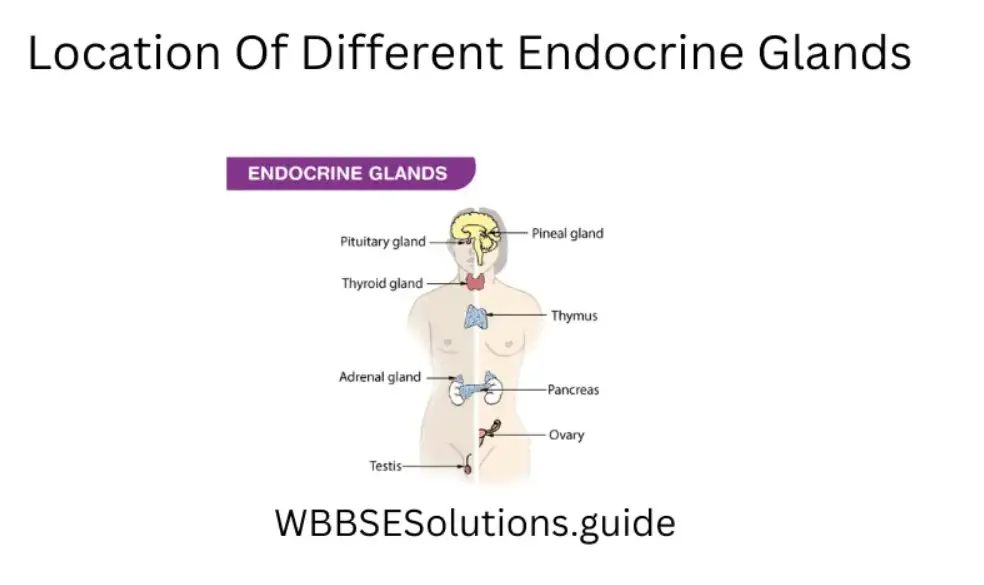
Question 63. Briefly describe the mechanism of sensing environmental changes and stimuli in plants.
Answer.
Mechanism of sensing environmental changes and stimuli in plants:
(1) Plant organs sensing light with photosensitive compounds: They are also called phototropins, cryptochromes, and phytochromes, each reacting very specifically to certain wavelengths of light These light sensors tell the plant whether it is day or night, how long the day is, how much light is available and from where the light comes.
Shoots grow towards light and roots usually grow away from light. These responses are called phototropism and skototropism respectively. This phenomenon is brought about by the plant hormone along with the pigments mentioned above.
Many plants exhibit certain phenomena at specific times of the day; for example, certain flowers open only in the mornings. Plants keep track of the time of the day with an internal molecular clock. This internal clock coupled with the ability to perceive light also allows plants to measure the time of the day and so find the season of the year.
The seeds of many plants sprout only after they are exposed to light This response is carried out by phytochrome signaling. Plants are also able to sense the quality of light and respond appropriately.
For example, in low light conditions, plants produce more photosynthetic pigments. If the light is very bright or if the levels of harmful UV increase, plants produce more of their protective pigments, that act as sunscreens.
(2) Production of signaling molecules: Wounded tomatoes are known to produce the volatile odor methyl-jasmonate as an alarm signal. Plants in the neighborhood can then detect the chemical and prepare for the attack by producing chemicals that defend against insects or attract predators.
(3) Hormonal signaling in plants: Plants systematically use hormonal signaling to coordinate their development and morphology. Morphogenesis in a developing plant is brought about by a delicate balance between auxin and cytokinin. Phytochrome, gibberellin, and the hypothetical hormone florigen bring about the modification of apical meristem to floral meristem.
(4) Trapping of prey by insectivorous plants: Stinging hairs of insectivorous plants like Sundew close the leaflets when they come in contact with the insect body. This is primarily due to the monastic movement
(5) Shock-based movement in plants: Any type of mechanical or electrical pressure releases the water molecule from the pulvinus in Mimosa pudica and the plant droops down. After some time with the discontinuity of the touch, the plant again regains its original configuration.
This is called the seismonastic movement This was denoted by Acharya J.C. Bose, who showed that a low electricity shock of 1.3 volts can result in drooping and retraction movement in Mimosa pudica.
Bose uses a crescograph to measure the rate of growth of a plant which is a device to magnify plant growth up to 10,000 times when they are stimulated by different stimuli like temperature, chemicals, gases & Electricity and thereby they not only proved that plants have life but also showed that they show varied responses to stimuli.
6) Movement due to osmotic stress: The leaflets of the Indian Telegraph plant Desmodium gyrans automatically go up and down with the loss and gain of turgidity of the basal leaflets. As the leaflets go down, they lose turgidity, become light, and go up.
(7) Growth movement due to touch: The tendril of a pea or vine grows like a spring-surrounding a solid rod-like support and there by the plant despite having a non-woody stem that can stand to erect This phenomenon occurs by the initial touch of the solid support causing the bending of the tendril (thigmotropism) followed by growth in the spring like manner (circumnutation).
Wbbse Class 10 Life Science Question Answer
Question 64. How are the physiological activities of plants regulated to increase agricultural yield?
Answer.
Regulation of physiological activities of plants leading to an increase in Agricultural Productivity :
(1) Apical growth of plant shoots and roots is promoted by auxin, so plant size decreases.
(2) Healing of wounds by the formation of callus tissue through auxin prevents infection or insect damage.
(3) Prevention of abscission of leaves by auxin causes pre-harvest loss of leaves.
(4) Parthenocarpic (seedless) fruit development with the help of auxin makes fruit like grapes economically more viable.
(5) Destruction of weed hosts with certain synthetic auxin compounds like 2,4-D reduces the competition from different weed plants.
(6) Initiation of intercalary growth by elongating the internode by gibberellin (GA3), induces growth for different stem vegetables.
(7) Transformation of apical bud to floral bud by GA3, induces more branching.
(8) Gibberellin induces early germination of seed.
(9) Morphogenesis by the induction of root or shoot through auxin-cytokinin balance is very useful for plant tissue culture.
(10) Cytokinin induces a bushy habit of a plant which is useful for plants like tea, where more apical buds and leaves are required.
Question 65. Briefly explain with examples the chemical coordination in the human body.
Answer.
There are several examples of coordination in our body —
(1) Goosebumps, result from the erection of the hairs in our skin. It is an involuntary, or uncontrollable response to cold temperatures or strong emotions. When we are in a cold environment, our thermoreceptors signal to our brain that our body temperature is decreasing.
This triggers the release of the hormone epinephrine (adrenaline), which targets the erector pili (smooth muscles surrounding hair follicles) and causes them to contract The contraction of these muscles causes our hairs to stand erect. These raised hairs cause the insulating air layer to expand, allowing your body to retain more heat.
(2) Most cells in the human body use the sugar called glucose as their major source of energy. To ensure a constant supply of glucose to cells, blood glucose levels must be maintained at relatively constant levels. In a healthy person, blood glucose levels are restored to normal levels primarily through the actions of two pancreatic hormones, namely insulin and glucagon.
(3) In the modern environment one is exposed to various stressful conditions. Stress can lead to changes in the serum level of many hormones. Some of these changes are necessary for the fight or flight response to protect oneself.
Adrenaline, along with nor-epinephrine is largely responsible for the immediate reactions we feel when stressed and combating stress. Along with the increase in heart rate, adrenaline also gives you a surge of energy that you might need to run away from a dangerous situation and also focuses your attention.
(4) Blood pressure is the pressure exerted by circulating blood upon the walls of vessels. Hormonal responses exist for both lowering and raising blood volume. The kidneys provide a hormonal mechanism (the renin-angiotensin-aldosterone system) for the regulation of blood pressure by managing blood volume.
Epinephrine and nor-epinephrine hormones, secreted by the adrenal medulla, raise blood pressure by increasing heart rate and the contractility of the heart muscles and by causing vasoconstriction of arteries and veins.
Antidiuretic hormone (ADH), a hormone produced by the hypothalamus and released by the posterior pituitary, raises blood pressure by stimulating the kidneys to retain water (raising blood pressure by increasing blood volume).
(5) Basal Metabolic Rate (BMR) is the rate of energy expended by animal (such as human) bodies when at rest. The thyroid hormones triiodothyronine (T3) and thyroxine (T4) are the main regulators of BMR. BMR increases when the quantity of these hormones in the blood increases. Some other hormones such as testosterone, insulin, and human growth hormone (HGH) can also increase the body’s metabolic rate.
(6) Sex Hormones: In most animal species the brain controls and regulates sexual behavior primarily using hormones. The sex hormones are estrogen and testosterone. Sexual behavior is influenced by the hypothalamus. It stimulates the pituitary gland to release the sex hormones.
In the female the target gland of the gonadotrophic hormone is the ovary, the ovary has two functions, the first one is to produce eggs, and the other is to secrete hormones. Estrogen and progesterone are the hormones released by the ovary?
Question 66. “Accommodation is the ability of the eye lens to adjust its focal length”. Explain the statement.
Answer.
Accommodation- viewing near and distant objects:
The accommodation is a reflex action of the eye, in response to focusing on a near object, then looking at a distant object (and vice versa), comprising coordinated changes in convergence, lens shape, and pupil size.
The lens is responsible for accommodation, the adjustment of the eye for observing near or far objects. It does this by changing its shape. This changes the focal length of the lens and permits it to focus the image formed on it by the cornea.
The lens is suspended from the muscular ciliary body by many delicate zonule fibers attached to its equator. In the normal relaxed condition (that is, with no tension placed on the fibers by contraction of the ciliary muscle) the lens’ shape is such as to refract rays from distant objects, and the eye is focused at infinity.
Accommodation for close vision requires tension to be exerted to deform the lens. Contraction of the muscles of the ciliary body tugs at the fibers and changes the shape of the lens. The eye adjusts the shape of the lens to keep objects in focus.
Looking at distant objects: Ciliary muscles relaxed -*• lens becomes thin -»• focal length of the lens increases. Looking at objects closer to the eye: Ciliary muscles contract -*ÿ increases the curvature of the eye lens -*• lens becomes thick -*ÿ focal length of the lens decreases.
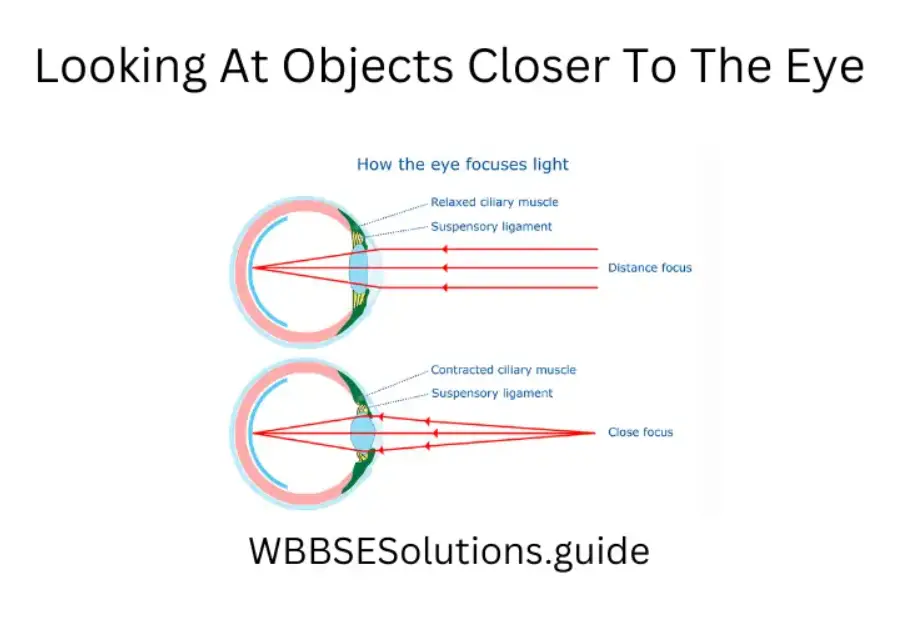
An example of accommodation can be cited from daily life situations. Good driver vision is a crucial factor in road safety, both for the pedestrians and passengers of the car. This is required to avoid road accidents by taking note of obstacles, traffic signals, and road directions.
Distance acuity is probably the most important visual skill for driving. Distance acuity is the ability to focus and see clearly at far distances. Even the simplest reactions in driving take at least 0.4 seconds.
A driver has to change focus quickly and easily from the road to the dashboard and back again. Being able to see color is also pretty important in the car.
Question 67. Briefly explain different defects of vision and their corrective measures.
Answer.
Defects of visions and corrective measures:
A -person with normal eyes can, by accommodation, see all objects that are at a distance greater than about 25 cm from the eye. If due to certain abnormalities the eye is unable to accommodate itself to various distances, then the eye is said to be defective. Some common defects of the eye are –
(1) Myopia: Near-sightedness, also called myopia is a common name for impaired vision in which a person sees near objects clearly while distant objects appear blurred. In such a defective eye, the image of a distant object is formed in front of the retina and not at the retina itself. Consequently, a nearsighted person cannot focus clearly on an object farther away than the far point of the defective eye.
Causes: This defect arises because the power of the eye is too great due to the decrease in focal length of the crystalline lens. This may arise due to either-(1) excessive curvature of the cornea, or (2) elongation of the eyeball.
Correction: This defect can be corrected by using a concave (diverging) lens. A concave lens of appropriate power or focal length can bring the image of the object back to the retina itself.

(2) Hyperopia or hypermetropia: Farsightedness, also called hyperopia or hypermetropia, common name for a defect in vision in which a person sees near objects with blurred vision,
while distant objects appear in sharp focus. In this case, the image is formed behind the retina.
Cause: This defect arises because either (1) the focal length of the eye lens is too great, or (2) the eyeball becomes too short, so that light rays from the nearby object, say at point
N, cannot be brought to focus on the retina to give a distinct image.
Correction: This defect can be corrected by using a convex (converging) lens of appropriate focal length. Eyeglasses with converging lenses supply the additional focusing power
required for forming the image on the retina.
(3) Presbyopia: Presbyopia is a progressive form of farsightedness that affects most people by their early 40s. The power of accommodation of the eye decreases with aging. Most people find that the near point gradually recedes.
Causes: It arises due to the gradual weakening of the ciliary muscles and diminishing flexibility of the crystalline lens.
Correction, Simple reading eyeglasses with convex lenses correct most cases of
presbyopia. Sometimes, a person may suffer from both myopia and hypermetropia.
Such people often require bi-focal lenses. In the bi-focal lens, the upper portion of the bi-focal lens is a concave lens, used for distant vision. The lower part of the bi-focal lens is a convex lens, used for reading purposes.
Question 68. What do you mean by bipedal locomotion? what are the characteristics of plant hormones?
Answer.
Bipedal locomotion
In the animal kingdom, only man has the effective capacity to walk and run on his two legs. Locomotion in man is la affected by the movement of legs, though the hands keep the balance of the body, Thistle moving.
The kind of locomo is called the bipedal locomotion.
1. They are mainly produced at the tips, root tips, etc.
2. Plant hormones are natural, artificial, and postulated.
3. Chemically plant hormones are acidic or alkaline in nature.
4. Plant hormones are secreted from meristematic cells.
5. These are transported from the site of secretion to the site of action by conducting tissues, mainly by phloem.
6. Plant hormones are mostly growth hormones.
Question 69. What are the characteristics of hormones? What are the characteristics of animal hormones? How is nerve impulse transmitted through synapse?
Answer.
Characteristics of hormones
1. These are present in the body in minute quantities and can act at very low concentrations.
2. They often act at a site remote from their site of production.
3. They are transported through the body fluids.
4. A hormone may act at more tissue tissue target tissues.
5. They are degraded after their actions are over.
6. They influence the activity of a process but cannot initiate a pro-quick-acting quickly acting (slow-acting or acting (estrogen).
2. These are secreted from the endocrine glands.
3. It is carried from the site of secretion to the target organ by the blood flow.
4. It acts in a very low concentration.
5. It is destroyed and excreted as soon as its function is over.
6. Chemically they steroids steroid site peptides steroid or peptides in nature.
7. Perform various activities including the growth of the organism.
8. They help the body cope with emergency demands such as infection, trauma,
emotional stress, dehydration, starvation, hemorrhage, and temperature extremes.
They are secreted in response to specific stimuli.
When an impulse arrives at the tip of the axon it releases neurotransmitters like adrenaliacetylcholineholine from the synaptic vesicles. The chemical diffuses across the synaptic cleft and reaches the dendrite of the next neuron causing depolarization of the membrane there. A new impulse then passes through the next neuron.
Question 70. Write the common characteristic features of the endocrine gland cataract cataracts cataract occur. How can it be rectified?
Answer.
1. Anatomical characters — The endocrine glands are devoid of excretory ducts and are highly vascularised.
2. Chemical characters — They synthesize some definite hormones and secrete them into the blood leaving the organ.
3. Functional — The materials secreted by such glands have some definite physiological actions. That means each gland has some definite functions in the body as evidenced by the fact that surgical removal of the gland leads to impairment of certain physiological functions that are corrected by administration of the gland extract to the animal.
The reason for this defect is that the lens loses its transparency and becomes opaque due to the deposition of protein materials and calcium minerals in the lens. This opaque the e condition of the lens does not allow the light rays from objects to pass through the lens. This defect can be rectified by surgically removing the lens and it has to be replaced by a highly convex lens.
Question 71. Which animal hormone was discovered first? Write its origin and function. What was the contribution of Acharya Jagadish Chandra Bose to sensitivity in plants?
Ans. (1) Secretin.
(2) Secretin is secreted from the small intestinal mucosa. It stimulates the secretion of bile from the liver as well as the secretion of bicarbonate and water in the pancreatic juice. Acharya Jagadish Chandra Bose made substantial discoveries in plant physiology. One of his inventions is the Crescograph, which he used to measure plant’s response to different stimuli. He demonstrated with experiments that plants too crescographph Crescograph was used to record the plant pulses when it was connected to a plant called Desmodium gyrans.
The plant root was hydrobromic hydrobromic acid till its set, m. Initially, the plant showed a steady deflection of the pointer in the crescograph and soon it became unsteady and then vibrated violently and finally stopped suddenly, indicating the death of the plant
Question 72. What is apical dominance? Name the hormone responsible for the formation of lateral buds. How can apical dominance be demonstrated sensitivity Sensitivity?
Answer. (1) Apical dominance is a physiological phenomenon in plants in which the growth of the apical bud inhibits the development of lateral buds.
(2) Auxin is the hormone responsible for the formation of lateral buds.
(3) Apical dominance can be easily demonstrated by cutting the API, and cal the bud because in the absence of the apical bud, active growth starts in the lateral buds. Sensitivity is the ability to detect the change in the environment and react to the stimuli. It is moreanimalssunced in animals the ability to show locomotion. Some of the lower plants can exhibit locomotion like in unicellular or colonial green algae and their response to stimuli is easily detectable which is in terms of positive or negative tactic movement But higher plants are fixed to the substratum with the help of roots and they cannot move from place to place, so they exhibit growth movement which is very slow and cannot be de CrtnCertain Though
certain plants are relatively more sensitive and they exhibit turgor movement in response to electrical or mechanical shock.
Question 73. (1) What is auxin? (2) What is its role in phototropism? Mention any two functions of GTH.
Answer. (1) Auxin is a class of plant growth hormone. It is produced at the tips of root & shoot.
(2) Phototropism is the movement of plant parts towards or away from light Auxin controls this movement by its differential presence in a particular area causing unequal rates of growth of the two sides of that plant part functions to functions of G.Follicle-stimulatingcle stimulating hormone increases, the growth of ovary stimulates to secrete estrogen from Grafian follicles in females and in males it stimulates seminiferous tubules of the testis and causes spermatogenesis.
(2) Luteinising hormone stimulates corpus luteum in females to seprogesteroneer one, and in males, it stimulates the interstitial theal cells of the testis to secrete testosterone.
Question 74. Classify animal hormones according to their chemical nature giving three examples of each class a ss. What is a hormone?
Answer. Animal hormones are chemically of three types
(1) Protein or peptide hormones: Ex – STFI, ACIH, insulin.
(2) Amines & modification acids: Ex – Adrenaline, thyroxine, melatonin.
(3) Steroid hormones : Ex – Estrogen, progesterone, testosterone.
(1) Hormones are organic substances produced by a group of cells in one part of the body that after being transported by body fluid influence growth and other physiological activities at a site remote from its place of production.
(2) Hchemical agents agent released from one group of cells which travel through the body fluid to affecgroupsgroupsferent group of cells. (Bayliss and Starling -1904).
Question 75. What are the functions (importance) of the nervous system? Define thermonasty with an example.
Answer.
Functions (importance) of the nervous system
(1) It controls all the voluntary and involuntary activities.
(2) It regulates and coordinates the activities of the bodies.
(3)It receives, transmits andinformationinformations, and then formulates a response for the effector organs.
(4) It helps in thinking and learning.
(5) It maintains the equilibrium of the body) It is the sum of the past incidents and experiences.
(ininIt helps in maintaining the integrity between an organism and the external environment.
(8) It is the seat of imagination, intelligence, judgment, ideas, etc.
(9) It also controls the emotional activities.
The movement of plant organs in variations to variation in temperature is known as thermonasFlowersower and s of tulips, crocus open when the temperature increases during daytime and clotemperatureee temperature falls at night.
Question 76. What is the the necessity of nervous system in the body? What i photo nasty? What is tropism?
Answer.
Necessity of nervous system in the body
The body of a man (or any other multicellular animal) is made of many organs specialized to perform different functions. In any society which includes people doing different sorts of work, an administrator is required to activities the activities of all the people.
Similarly in our body, a controller is required to coordinate and regulate all the functions (both voluntary and involuntary) andcoordinatorinator is no other than the nervous system. The movement of plant organs caused by the change in light intensity is called photonasty.
This type of movement occurs due to the o change in turgor pressure of certain cells involved in the movement of the organ. The tropic movements are the movements of the plant organs in which the direction of movement is determined by the direction of stimuli. If the movement is towards the source of the stimulus, it is called positive; if it is away from the source, it is called negative.
Question 77. What is the advantage of a seneuroneurone having numerous synaptic connections? What tactic movement?
Answer.
Across the synapse, the impulse is transmitted through chemicals, sucacetylcholineholine, and adrenaline. A sensory nerve has to carry the stimulus quickly to the brain or spinal cord across a synapse. This depends on moacetylcholineholine secretion which acts as a stimulus transmitter.
More synaptic connections increase the transmitting efficiency of the nervous stimulus. Tactic movement or Taxism: The movement of the entire plant, e.g. Chlamydomonas, Valvox, etpartspartsr plant parts like sperm antherozoids of moss or fern in response to external stimulus is called ‘tactic movement’ or ‘taxis’.
Question 78. Explain why nerve impulse flows more rapidly in myelinated nerve fibers than in non-myelinated fibers. What is the function of Corea in the human eye?
Answer.
In non-myelinated, nerve fiber depolarization changes are repeated all over the length of the fiber, so the action potential has to travel the entire length of the fiber. On the other hand, in myelinated fiber depolarization occurs only at nodes of Ranvier which do not contain the myelin sheath; so the action potential hops through nodes of Ranvier and is faster. This type of conduction is known as saltatory.
(1) It allows the light to pass into the eye.
(2) It acts as a refrective medium.
Question 79. Why should edible salt be ed? Where is testosterone produced? State one advantage of stereoscopic vision.
Answer.
Iodized edible salt helps in the formation of thyroxin because iodine is an essential part of it. So, if edible salt is not iodized the body will not get sufficient iodine; tha a ere will be a deficiency of thyroxin. Testosterone is setestesrom testets. The stereoscopic vision is of great importance for estimating the distance and shape of the object
Question 80. What is the the source of adrenalin hormone? What is it called an emergency hormone? What is stereoscopic vision?
Answer. (
1) Source of adrenalin hormone – AdrThe adrenalinalind.
(2) Adrenalin hormone one is known as emergency hormone. Reason It is the secretomes time of danger and helps to control excitement by influencing the nervous system and increasing blood flow, thereby helping the person to face the abnormal condition successfully.
The visit here-dimensional three dimensional) the aspect of the object portrayed is called stereoscopic vision.is found in animals having binocular vision, e.g. in man.
Question 81. Which hormone is released from the testes? Mention its functions.
Answer.
(1) Testosterone is the the released from the testes.
(2) Functions of testosterone
(1) It promotes the growth of secondary semalesmalesgans in males.
(2) It facilitates sperm production, (3) It also promotes the growth of muscles and bones.
Quesa a tion 82. Why is a hormone called chemical messenger? Mention the secretion motion and function of estrogen. What is hypermetropia and how can it be corrected? What is meant by “binocular vision”?
Answer.
(1) Because they have received order from their place of production (such as endocrine glands) and act accordingly on the target organs.
(2) (1) Site of secretion Graffian follicles of ovary.
(2) Function It helps in the development of female sex organs and the growth of mammary glands.
Haarmetropia ithe the s a defect of the eye ithe n which the person cannot see nearby objects. clearly but the distant vision is clear. It can be corrected by using a convex lens. The vision in which both eyes participate in viewing an object is called binocular vision, e.g. in man.
Question 83. Mention the place of secretion and function of Auxin, ACTHand, and Adrenaline hormone. What is myopia and how can it be corrected?
Answer.
Place of secretion and function
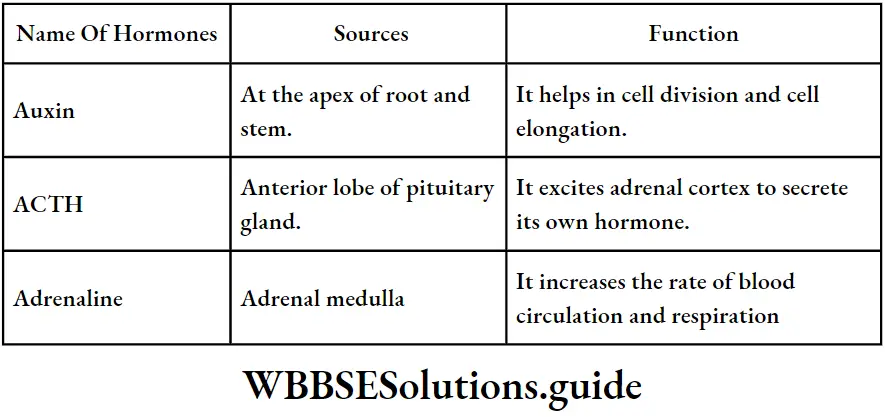
Myopia is the defect of the eye in which a person can see nearby things clearly but distant objects are blurred. It can be corrected by using a concave lens.
Question 84. Write two functions of each of ACTH, TSH and, STH in the human body. What type of lens is used to correct the following defects of the eyes: (1) Astigmatism (2) Myopia (3) Hypermetropia?
Answer.
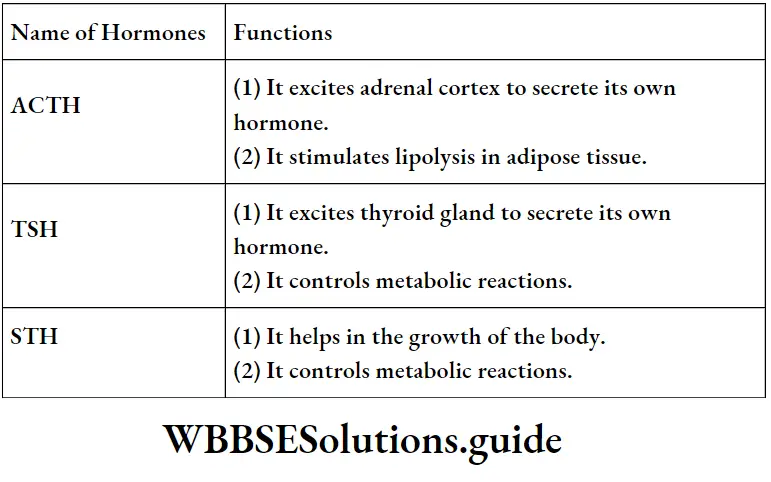
(1) Spherical lens (2) Concave lens (3) Convex lens.
Question 85. Name three animal hormones that are not secreted from the pituitary gland and mention their sources. Name some major eye defects of man.
Answer.
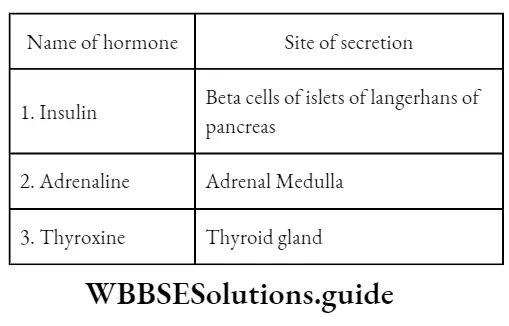
The major eye defects of man are – Myopia, Hypermetropia, Astigmatism, Glaucoma, CatarCataractsColour-blindness, etc.
Question 86. Write the full names of any three hormones secreted from the anterior pituitary gland. What types of visions are associated with rods and cones?
Answer.
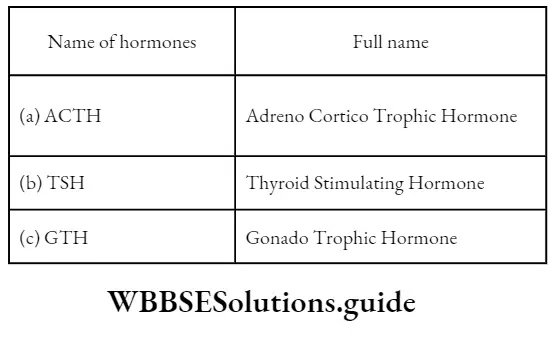
The rods are associated with night vision (dim light) and cones are associated with coloucoloron.
Question 87. Write any three characteristics of animal hoa a rmos. What is a blind spot?
Answer.
Three characteristics of animal hormone
(1) Their places of secretion (endocrine gland) and action are different
(2) They are concentrations concentration.
(3) The remaining quantity of hormone is destroyed and removed from the body by the process of excretion n.
The point on the retina having no rods and cones is called the blind spot It is insensitive to light so no image is formed here.
Question 88. What do you mean by endocrine and exocrine glands? Give examples. Mention the location of the nd function of the yellow spot.
Answer.
(1) Endocrine glands The duct the less glands of an animal body secrete the hormones directly into tbloodstreameam are known as endocrine glands. Ex.:-
Pituitary gland.
(2) Exocrine glands Glands that discharge their secretion through ducts are called exocrine glands. Ex. Salivary glands.
The yellow spot is located on the retina. It is responsible for the formation of the sharpest image.
Question 89. Mention the sites of secretion and functions of insulin and adrenaline hormones. What is ‘Fovea’ or ‘Yellow Spot’?
Answer.
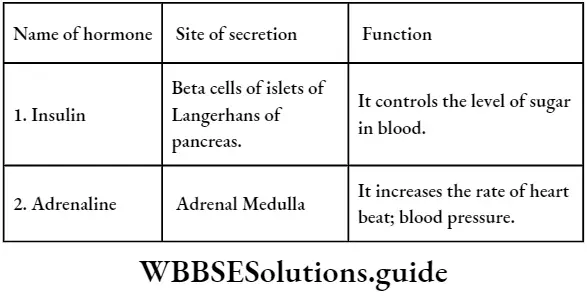
The fovea or yellow spot is the region on the retina just opposite the lens where cones are very densely packed.
Question 90. Give names of one plant hormone and two animal hormones and mention their functions. What is the function of aqueohumour vitrehumormour?
Ans.
(1) Plant Hormone – Auxin. Function It helps in growth and controls tropic movement.
(2) Animal Hormone (1) Thyroxine. Function It controls metabolic reactions.
(2) Insulin. Function maintains blood sugar level. humorous urus and vitreous humor maintain the spherical shape of the eyeball.
Question 91. Mention the place of secretion and two functions of each of GTH, Insulin, Thyroxine, and Adrenaline the hormones in the human body. What are receptors?
Answer. Place of secretion and two functions
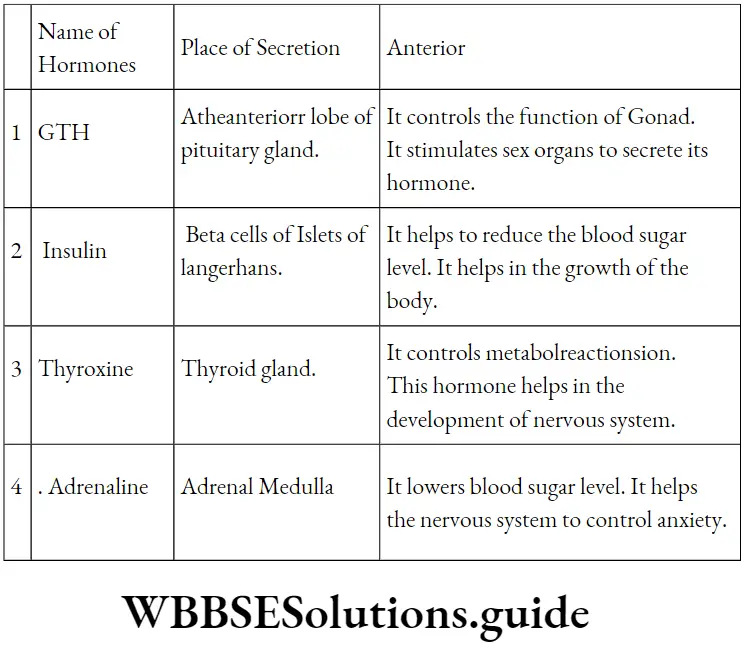
Structures at the end of sensory nerve fibers collect information from the external and internal environment of the body.
Question 92. Describe three important functions of gibberellins. Name the pigments present in rod and cone cells.
Answer:
The function of Gibberellin (1) It checks and inimizesises the dormancy period of seeds.
(2) It helps in parthenocarpy.
(3) It helps in the determination of sex.
Rod cells contain Rhodopsin and cone cells contain Iodopsin.
Question 93. What parthenocarpy? Mention two differences between Auxin and anHormone-producing more producing glands are called endocrine glands. Explain.
Answer.
Parthenocarpy
(1) Parthenocarpy The production of seedless fruit using artificial plant hormones but withfertilizingsoffthe the ovum is called parthenocarpy.
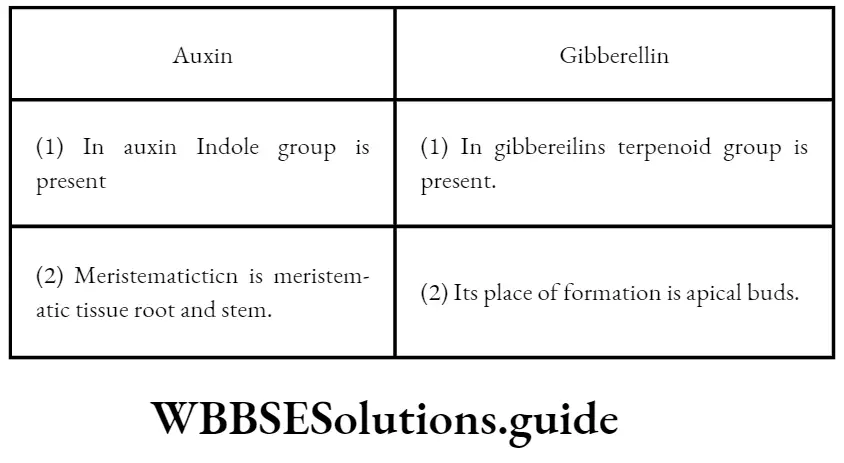
Because these ducts have no duct and in the absence of ducts they directly pour down their secretions (hormones) into the blood vessels.
WBBSE Class 10 Life Science Chapter 1 Control And Co-Ordination In Living Organisms MCQS
Chapter 1 Control And Co-Ordination In Living Organisms MCQs
Question 1. When the intensity of the stimulus is the cause of movement, it is termed as_________________
(1) Tropism
(2) Tactism
(3) Nastism
(4) None of the above
Answer. (3) Nastism
Question 2. Earthworm moves with the help of_______________
(1) Setae
(2) Pseudopodia
(3) Tube feet
(4) Cilia
Answer. (1) Setae
Question 3. Balancing organ of fish are_______________
(1) Lateral line
(2) Swim bladder
(3) Gills
(4) Fins
Answer. (2) Swim bladder
Read and Learn More Class 10 Life Science MCQs
Question 4. The locomotory organ of amoeba are______________
(1) Setae
(2) Pseudopodia
(3) Tube feet
(4) Cilia
Answer. (2) Pseudopodia
Question 5. Tactic movement is found in________________
(1) Chlamydomonas
(2) Earthworm
(3) Cockroach
(4) Fish
Answer. (1) Chlamydomonas
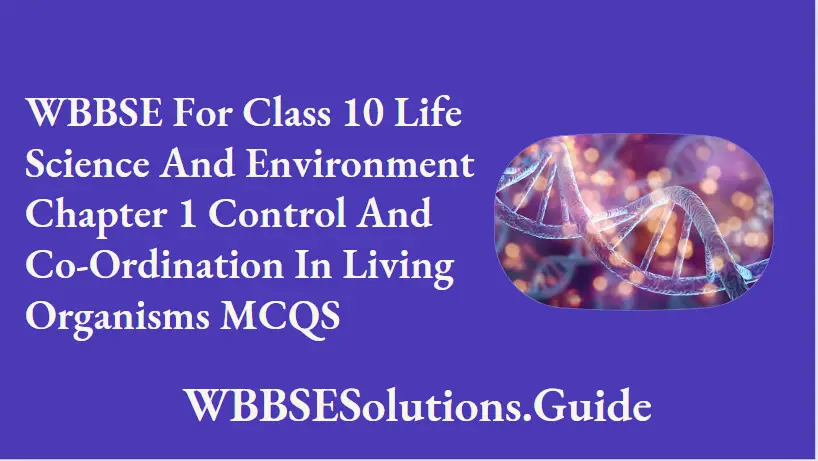
Question 6. of stimulus is the cause of tropic movement.
(1) Intensity
(2) Source
(3) Direction
(4) None of the above
Answer. (c) Direction
Question 7. Locomotion in plants is termed as_________________
(1) Tropism
(2) Tactism
(3) Nastism
(4) None of the above
Answer. (2) Tactism
Question 8. What is the other name of thigmotropism?
(1) Phototropism
(2) Heliotropism
(3) Hydrotropism
(4) Haptotropism
Answer. (4) Hapto tropism
Question 9. Number of joints in our body are________________
(1) twenty four
(2) twenty three
(3) twenty one
(4) twenty two
Answer. (4) twenty two
Question 10. Movable joints allow
(1) free movement in various directions
(2) no movement
(3) a limited degree of movement
(4) none of the above
Answer. (1) free movement in various directions
Question 11. Ball and socket joint is__________________
(1) slightly movable joint
(2) immovable joint
(3) movable joint
(4) none of the above
Answer. (3) movable joint
Question 12. Pivot joint allows
(1) rotation only
(2) movement in one direction only
(3) the sliding of bones
(4) limited degree of movement
Answer. (1) rotation only
Question 13. The movement of an organ in response to the stimulus of moisture is known as:
(1) Geotropism
(2) Phototropism
(3) Hydrotropism
(4) Haptotropism
Answer. (4) Hydrotropism
Question 14. The orientation of stems and roots in response to the force of gravity is called:
(1) Chemotropism
(2) Geotropism
(3) Hydrotropism
(4) Thigmotropism
Answer. (2) Geotropism
Question 15. The locomotory organs of hydra are :
(1) Setae
(2) Cilia
(3) Flagella
(4) Basal disc, foot & tentacles
Answer. (4) Basal disc, foot & tentacles
Question 16. Schwann cell is related to which of the following?
(1) Dendrite
(2) Axo
(3) Cell body
(4) Synapse
Answer. (2) Axon
Question 17. “Titillation brings about the contraction of the foot” – What kind of reflex action is it?
(1) Habitual reflex action
(2) Congenital superficial reflex action
(3) Complex reflex action
(4) Congenital deep reflex action.
Answer. (2) Congenital superficial reflex action
Question 18. Which of the following is not present in a neuron?
(1) Schawann cell
(2) Plastid
(3) Nissl’s granule
(4) Node of Ranvier.
Answer. (2) Plastid
Question 19. Which of the following co-ordinates the balance of the body during locomotion?
(a) Cerebrum
(b) Cerebellum
(c) Pons
(d) Medulla oblongata.
Answer. (b) Cerebellum
Question 20. The optic nerve is a _________
(1) Motor nerve
(2) Spinal nerve
(3) Mixed nerve
(4) Sensory nerve
Answer. (4) Sensory nerve.
Question 21. How many pairs of cranial nerves are present in the human body?
(1) 10
(2) 12
(3) 14
(4) None of these.
Answer. (2) 12
Question 22. Two hemispheres of cerebrum remain connected by_________________
(1) Corpus striatum
(2) Corpus luteum
(3) Corpus callosum
(4) Medulla.
Answer. (3) Corpus callosum
Question 23. The olfactory nerve helps in the sensation of___________.
(1) vision
(2) smell
(3) hearing
(4) taste.
Answer. (2) smell
Question 24. The protective covering of the brain is____________.
(1) Pericardium
(2) Conjuctiva
(3) Pleura
(4) Meninges.
Answer. (4) Meninges.
Question 25. Which one is not a component of the Complex Reflex arc?
(1) Afferent neurone
(2) Efferent neurone
(3) Intermediate neurone
(4) Afferent nerve.
Answer. (4) Afferent nerve.
Question 26. Which one of the following is associated with the nasal body?
(1) Cell body
(2) Axon
(3) Schwann cell
(4) Neurilemma.
Answer. (1)Cell body
Question 27. The number of spinal nerves in man is_______________.
(1) 10 pairs
(2) 12 pairs
(3) 31 pairs
(4) 33 pairs
Answer. (3) 31 pairs
Question 28. The main component of the central nervous system is____________.
(1) Brain
(2) Spinal cord
(3) Both Brain and Spinal cord
(4) None of them.
Answer. (3) Both Brain and Spinal cord
Question 29. Which part of the brain performs thermoregulation?
(1) Cerebrum
(2) Cerebellum
(3) Hypothalamus
(4) Pons
Answer. (3) Hypothalamus
Question 30. The region of the human brain that regulates “body balance” is___________
(1) Cerebrum
(2) Cerebellum
(3) Thalamus
(4) Hypothalamus
Answer. (2) Cerebellum
Question 31. In the eye of which animal pecten is found?
(1) Fish
(2) Tiger
(3) Pigeon
(4) Toad
Answer. (3) Pigeon
Question 32. The area of the eye for best vision is ___________
(1) Blindspot
(2) Yellow spot
(3) Optic disc
(4) Cornea.
Answer. (2) Yellow spot
Question 33. The point where the retina and the optic nerve meet is called.
(1) Yellow spot
(2) Optic centre
(3) Blindspot
(4) Eye spot
Answer. (3) Blindspot
Question 34. Hypermetropia is corrected by __________
(1) Convex lens
(2) Concave lens
(3) Cylindrical lens
(4) Photochromatic lens
Answer. (1) Convex lens
Question 35. The shape of lens present in human eye is____________
(1) Concave
(b) Convex
(d) Biconvex
(3) Biconcave
Answer. (d) Biconvex.
Question 36. The part of the human eyeball that is photosensitive is__________
(1) Choroid
(2) Sclera
(3) Cornea
(4) Retina.
Answer. (4) Retina.
Question 37. The oval window is found in_______________
(b) Ear
(d) Heart
(a) Brain
(c) Eye
Answer. (2) Ear
Question 38. Rhodopsin is the pigment of_______________
(1) Rod cells
(2) Cone cells
(3) Epithelial cells
(4) Olfactory cells.
Answer. (1) Rod cells
Question 39. Where is the sclera located?
(1) tongue
(2) skin
(3) eye
(4) ear
Answer. (3) eye
Question 40. The part of the human eye that functions as a refraction medium is___________
(1) Cornea
(2) Retina
(3) Vitreous humor
(4) Choroid.
Answer. (3) Vitreous humor
Question 41. What is Auxin?
(1) Animal Hormone
(2) Enzyme
(3) Plant Hormone
(4) Excretory Product
Answer. (3) Plant Hormone
Question 42. Which one of the following is a hormone?
(1) Pepsin
(2) Reserpine
(3) Ethylene
(4) Cytosine.
Answer. (3) Ethylene
Question 43. What is Gibberelline?
(1) Animal hormone
(2) Enzyme
(3) Plant hormone
(4) Excretory product
Answer. (3) Plant hormone
Question 44. The hormone which is not a phytohormone is____________
(1) STH
(2) IAA
(3) GA.
(4) None of the above
Answer. (1) STH
Question 45. The type of movement of plants influenced by auxin is____________
(1) Nyctinasty
(2) Photonasty
(3) Phototropism
(4) Hydrotropism
Answer. (3) Phototropism
Question 46. Hormones are also called_________
(1) enzymes
(2) receptor
(3) physical co-ordinators
(4) chemical co-ordinators
Answer. (4) chemical co-ordinators
Question 47. An artificial hormone is __________________
(1) Indole acetic acid
(2) Naphthalene acetic acid
(3) Gibberellic acid
(4) Ziatin
Answer. (2) Naphthalene acetic acid
Question 48. Insulin is secreted from___________.
(1) Anterior part of Pituitary gland
(2) Thyroid gland
(3) Kidney
(4) Pancreas
Answer. (4) Pancreas
Question 49. Which of the following glands is a mixed gland?
(1) Thyroid
(2) Pituitary
(3) Pancreas
(4) Liver.
Answer. (3) Pancreas
Question 50. Which one of the following is not an endocrine gland?
(1) Salivary gland
(2) Adrenal gland
(3) Thyroid gland
(4) Pituitary gland.
Answer. (1) Salivary gland
Question 51. From which of the following endocrine glands is ACTH secreted?
(1) Adrenal gland
(2) Thyroid gland
(3) Islets of Langerhans in pancreas
(4) Pituitary gland.
Answer. (4) Pituitary gland.
Question 52. Which one of the following is an endocrine gland?
(1) Salivary gland
(2) Liver
(3) Tear gland
(4) Thyroid gland.
Answer. (4) Thyroid gland.
Question 53. From which of the following glands is Insulin secreted?
(1) Thyroid gland
(2) Pituitary gland
(3) Islets of langerhans
(4) Adrenal gland.
Answer. (3) Islets of langerhans
Question 54. Disease caused by deficiency of Thyroxine is________________
(1) Anaemia
(2) Cretinism
(3) Diabetes
(3) Polyurea.
Answer. (2) Cretinism
Question 55. Which one is an emergency hormone?
(1) STH
(2) Thyroxine
(3) Adrenaline
(4) Insulin.
Answer. (3) Adrenaline
Question 56. In the absence of which of the following there is an increase in blood sugar level?
(1) Thyroxine
(2) Insulin
(3) Glucagon
(4) Adrenaline.
Answer. (2) Insulin
Question 57. From which of the following glands is thyroxine secreted?
(1) Thyroid gland
(2) Pituitary gland
(3) Adrenal gland
(4) Islets of langerhans.
Answer. (1) Thyroid gland
Question 58. Iodine is the essential component for the hormone____________
(1) Insulin
(2) Glucagon
(3) Adrenaline
(4) Thyroxine.
Answer. (4) Thyroxine.
Question 59. From which of the following endocrine glands is a somatotrophic hormone secreted?
(1) Adrenal gland
(2) Pancreas
(3) Pituitary gland
(4) Thyroid gland.
Answer. (3) Pituitary gland
Question 60. Which of the following hormones is secreted from the pituitary gland?
(1) Thyroxine
(2) Insulin
(3) Adrenaline
(4) STH
Answer. (4) STH
Question 61. The hormone Testosterone is secreted from____________
(1) Testis
(2) Ovary
(3) Adrenal gland
(4) Thyroid gland.
Answer. (1) Testis
Question 62. Which one is a mixed type among the following glands?
(1) Thyroid
(2) Pituitary
(3) Pancreas
(4) Adrenal
Answer. (3) Pancreas
Question 63. The name of a hormone secreted from the ovary is______________.
(1) Oestrogen
(2) Testosterone
(3) GTH
(4) ACTH
Answer. (1) Oestrogen
Question 64. Which one is not an endocrine gland?
(1) Salivary gland
(2) Pituitary gland
(3) Thyroid gland
(4) Adrenal gland.
Answer. (1) Salivary gland
Question 65 The endocrine glands do not secrete____________.
(1) Insulin
(2) Thyroxine
(3) Pepsin
(4) Adrenalin
Answer. (3) Pepsin
Question 66. Which of the following hormones control physical, mental, and sexual growth in man?
(1) S.T.H
(2) GT.H
(3) T.S.H.
(4) Thyroxine
Answer. (4) Thyroxine
Question 67. Emergency hormone is secreted from________
(1) Pituitary
(2) Thyroid
(3) Adrenal
(4) Pancreas gland.
Answer. (3) Adrenal.
Question 68. Hypofunctioning of S.T.H. leads to_______
(1) dwarfism
(2) cretinism
(3) goitre
(4) diabetes mellitus.
Answer. (1) dwarfism.
Question 69. Which one of the following hormones participates in the metamorphosis of a toad?
(1) Auxin
(2) GT.H
(3) Adrenalin
(4) Thyroxine.
Answer. (4) Thyroxine.
Question 70. Which one of the following hormones is secreted from the ovary?
(1) Insulin
(2) Testosterone
(3) Oestrogen
(4) GTH
Answer. (4) Oestrogen
Question 71. Which one is not an endocrine gland?
(1) Salivary gland
(2) Pituitary gland
(3) Thyroid gland
(4) Adrenal gland
Answer. (1) Salivary gland
Question 72. Deficiency of which hormone causes Diabetes mellitus?
(1) Thyroxin
(2) Insulin
(3) Adrenalin
(4) STH.
Answer. (2) Insulin
Question 73. Which of the following endocrine glands secrete thyroxine?
(1) Thyroid
(2) Testes
(3) Adrenal
(4) Pituitary
Answer. (1) Thyroid
Question 74. Who discovered the sensitivity of plants?
(1) Parlor
(2) J.C. Bose
(3) Darwin
(4) Went
Answer. (2) J.C. Bose
Question 75. Which type of movement shows in Volvox?
(1) Phototropic
(2) Thermotropic
(3) Phototactic
(4) Gsotropic
Answer. (3) Phototactic
Question 76. Chemonastic movement is found in___________
(1) Drosera
(2) Sunflower
(3) Oxalis
(4) Mimosa Pudica
Answer. (1) Drosera
Question 77. Seed germination is induced by which hormone?
(1) Gibberellic acid
(2) Auxin
(3) Cytokinin
(4) ABA
Answer. (1) Gibberellic acid
Question 78. Which hormone delays leaf senescence?
(1) Auxin
(2) Gibberellin
(3) Cytokinin
(4) IAA
Answer. (4) Cytokinin
Question 79. The surface area of wings is increased in birds with the help of_____________.
(1) Pectoralis major
(2) Pectoralis minor
(3) Remiges
(4) Rectrices
Answer. (3) Remiges
Question 80. Triceps helps in______.
(1) Flexion
(2) Abduction
(3) Adduction
(4) Extension
Answer. (4) Extension
Question 81. Klinostat demonstrates____________.
(1) Geotropism
(2) Hydrotropism
(3) Thigmotropism
(4) Phoxotropism
Answer. (1) Geotropism
Question 82. Avena coleoptile test is for___________.
(1) Auxin
(2) Gibberellin
(3) Cytokinin
(4) ethylene
Answer. (1) Auxin
Question 83. Stress is reduced by____________
(1) ADH
(2) Adrenaline
(3) Renin
(4) STH
Answer. (2) Adrenaline
Question 84. TRH is produced from_____________.
(1) Hypothalamus
(2) Adrenal
(3) Pituitary
(4) Thyroid
Answer. (1) Hypothalamus
Question 85. Milk releasing hormone is_____________.
(1) Oxytocin
(2) Vasopresin
(3) TnRH
(4) TSH
Answer. (1) Oxytocin
Question 86. The following is a motor nerve_________________
(1) Facial
(2) Oculomotor
(3) Optic
(4) Trigeminal
Answer. (2) Oculomotor
Question 87. The part of the brain that joins it with the spinal cord is_____________.
(1) Medulla
(2) Pons
(3) Hypothalamus
(4) Cerebellum
Answer. (1) Medulla
Question 88. Synovial joints are______________
(1) Immovable
(2) Freely movable
(3) Slightly movable
(4) Fixed
Answer. (2) Freely movable
Question 89. Retrices in bird are located in___________
(1) Tail feather
(2) Wing
(3) Sternum
(4) Legs
Answer. (1) Tail feather
Question 90. The Semicircular canals are located in______
(1) Eye
(2) Ear
(3) Nose
(4) Tongue
Answer. (2) Ear
Question 91. Adduction and abduction is a common phenomenon found in____________
(1) Leg
(2) Arm
(3) Shoulder
(4) Both arm and shoulder
Answer. (d) Both arm and shoulder
Question 92. Stimulus is______________________
(1) A physical force
(2) Energy
(3) Changed environment
(4) None of these
Answer. (2) Energy
Question 93. Irritability is________________
(1) Respond to stimulus
(2) Non-respond to stimulus
(3) Changes within body
(4) None of these
Answer. (1) Respond to stimulus
Question 94. FSH is secreted from_______________
(1) Thyroid gland
(2)Adrenal gland
(3) Pituitary gland
(4) Graafian follicles
Answer. (4) Graafian follicles
Question 95. Who is called the father of endocrinology?
(1) E.H. Starling
(2) Thomas Addison
(3) Huxley
(4) Peterson
Answer. (2) Thomas Addison
Question 96. The gland having both exocrine am3 endocrine functions is____________
(1) Thyroid
(2) Gastric
(3) Pancreas
(4) Pituitary
Answer. (3) Pancreas
Question 97. Another name for antidiuretic hormone is ____________
(1) Oxytocin
(2) Prolactin
(3) Vasopressin
(4) None of these
Answer. (c) Vasopressin
Question 98. Which one of the following is not an endocrine gland?
(1) Thyroid
(2) Pituitary
(3) Adrenal
(4) Parotid
Answer. (4) Parotid
Question 99. Gigantism is due to over-secretion of which one of the following?
(1) LH
(2) GH
(3) TSH
(4)ADH ‘
Answer. (4) GH (Growth Hormone)
Question 100. The anterior lobe of Pituitary is also called _____________
(1) Pars nervosa
(2) Pars distalis
(3) Pars intermedia
(4) None of these
Answer. (2) Pars distalis
Question 101. The reabsorption of water by kidney tubules is stimulated by_______________
(1) Oxytocin
(2) Androgen
(3) Protection
(4) Vasopressin
Answer. (4) Vasopressin
Question 102. The smallest endocrine gland is______________
(1) Thyroid
(2) Parathyroid
(3) Adrenal
(4) Pituitary gland
Answer. (4) Pituitary gland
Question 103. The largest endocrine gland in adult is___________
(1) Thyroid gland
(2) Pituitary
(3) Adrenal
(4) Ovary
Answer. (1) Thyroid gland
Question 104. The secretion of endocrine gland is directly released in________________
(1) Blood
(2) Gut
(3) Lymph
(4) Ducts
Answer. (1) Blood
Question 105. The pituitary gland in mammals is made up of____________
(1) Two parts
(2) Three parts
(3) Six parts
(4) One part only
Answer.(2) Three parts
Question 106. Which one of the following is not an endocrine disease?
(1) Goitre
(2) Pneumonia
(3) Cretenism
(4) Dwarfism
Answer. (2) Pneumonia
Question 107. Deficiency of thyroid hormone causes ________________
(1) Exophthalmic goitre
(2) Acromegaly
(3) Myxoedema
(4) All of three
Answer. (3) Myxoedema
Question 108. The hormone that regulates basal metabolism in the body is secreted from_____________
(1) Pituitary
(2) Thyroid gland
(3) Pancreas
(4) Parathyroid
Answer. (2) Thyroid gland
Question 109. The function of the thymus gland is _____________
(1) Immunity
(2) Growth
(3) Formation of RBC
(4) Fight or flight
Answer. (1) Immunity
Question 110. Kidney stones may be caused by hypersecretion of the ________________
(1) Thyroid gland
(2) Parathyroid gland
(3) Thymus
(4) Pancreas
Answer. (2) Parathyroid gland
Question 111. Hormones are destroyed mainly in______________
(1) Liver
(2) Heart
(3) Stomach
(4) Intestine
Answer. (1) Liver
Question 112. The glucagon hormone in pancreas is secreted by________________
(1) Gamma cells
(2) Alpha cells
(3) Delta cells
(4) Beta cells
Answer. (2) Alpha cells
Question 113. Which of the following has a higher level in summer and a lower level in winter?
(1) Thyroxine
(2) Insulin
(3) Glucagon
(4) Vasopressin
Answer. (4) Vasopressin
Question 114. Which of the following induces parturition?
(1) Vasopressin
(2) Oxytocin
(3) GH
(4) TSH
Answer. (2) Oxytocin
Question 115. Islets of langerhans are found in _________________
(1) Anterior pituitary
(2) Kidney Cortex
(3) Spleen
(4) Endocrine pancreas
Answer. (4) Endocrine pancreas
Question 116. The hormone responsible for fight and flight response is______________
(1) Adrenalin
(2) Thyroxine
(3) ADH
(4) Oxytocin
Answer. (1) Adrenalin
Question 117. Which gastrointestinal hormone stimulates insulin secretion?
(1) Gastrin
(2) CCK
(3) Secretion
(4) GIP
Answer. (4) GIP
Question 118. During an emergency, which of the following hormones is secreted?
(1) Aldosterone
(2) Thyroxine
(3) Adrenalin
(4) Calcitonin
Answer. (3) Adrenalin
Question 119. When the animal is aggressive and attacks, the hormone responsible for it is_________________
(a) Thyroxin
(b) Testosterone
(c) Oxytocin
(d) Adrenalin
Answer. (d) Adrenalin
Question 120. The hormone produced in allergic reaction is _____________
(a) Gluco corticoides
(b) Mineralo corticoides
(c) Nor epinephrine
(d) Epinephrine
Answer. (a) Gluco corticoids
Question 121. Which is the gastrointestinal hormone?
(a) Prolactin
(b) Enterokinase
(c) Nor – epinephrin
(d) Secretin
Answer. (d) Secretin
Question 122. In plants, auxin synthesis occurs in _________________
(a) Cortex
(b) Xylem cells
(c) Phloem cells
(d) Root and shoot tips
Answer. (d) Root and shoot tips
Question 123. A substance that induces dormancy of seed is _____________
(a) ABA
(b) GA
(c) Urea
(d) Cytokenin
Answer. (a) ABA
Question 124. Cytokinin can cause _____________
(1) Early senescence in leaves
(2) Delay in leaf senescence
(3) Elongation of internodes
(4) Parthenocarpy
Answer. (2) Delay in leaf senescence
Question 125. Promoting cell division in plants is the characteristic of___________
(1) Abscisic acid
(2) Ethylene
(3) IAA
(4) Cytokinin
Answer. (4) Cytokinin
Question 126. The term cytokinin was introduced by________________
(1) Miller and Skoog
(2) Letham
(3) Steward
(4) None of these
Answer. (4) None of these
Question 127. Auxin were first isolated from the plants by______________
(1) Went
(2) Boysen – Jensen
(3) Darwin
(4) Sachs
Answer. (1) Went
Question 128. Gibberellins in pure crystallin a form were first isolated_____________
(1) By Kurosawa
(2) From rice plants in Japan
(3) By Yabuta and Sumiki
(4) Both 2 and 3
Answer. (3) By Yabuta and Sumiki
Question 129. The formation of pseudopodia results in ___________________
(1) Ciliary movement
(2) Amoeboid movement
(3) Flagellar movement
(4) Muscular movement
Answer. (2) Amoeboid movement
Question 130. The function of synovial fluid is___________
(1) Avoid friction
(2) Lubrication
(3) Nourishment
(4) All of these
Answer. (4) All of these
Question 131. The connective tissue joining muscle to bone is________________
(1) Ligament
(2) Tendons
(3) Synovial fluid
(4) None of these
Answer. (2) Tendons
Question 132. Animals which can not exhibit locomotion are___________
(1) Corals
(2) Sponges
(c) Amoeba
(4) Both (1) and (2)
Answer. (4) Both (1) and (2)
Question 133. plant can exhibit locomotion_______________
(1) Chlamydomonas
(2) Spirogyra
(3) Volvox
(4) Both (1) and (3)
Answer. (4) Both (1) and (3)
Question 134. Earthworm shows locomotion by______
(1) Scales
(2) Muscles
(3) Setae and muscles
(4) Pseudopodia
Answer. (3) Setae and muscles
Question 135. Which one shows bipedal locomotion?
(1) Toad
(2) Cockroach
(3) Man
(4) Lizard
Answer. (3) Man
Question 136. The streaming movement of protoplasm within a cell is ________________
(1) Diffusion
(2) Osmosis
(3) Cyclosis
(4) All
Answer. (3) Cyclosis
Question 137. Fin which helps the fish to steer the direction is______________
(1) Pectoral fin
(2) Pelvic fin
(3) Caudal fin
(4) Dorsal fin
Answer. (3) Caudal fin
Question 138. The type of movement in Mimosa pudica is _____________
(1) Nyctinasty
(2) Photonasty
(3) Seismonasty
(4) Chemonasty
Answer. (3) Seismonasty
Question 139. The tropic movement in plants is controlled by________________
(1) Gibberellins
(2) Auxin
(3) Cytokinin
(4) Ethylene
Answer. (2) Auxin
Question 140. The other name of sleeping movement in plants is____________
(1) Thermonasty
(2) Nyctinasty
(3) Chemonasty
(4) All
Answer. (2) Nyctinasty
Question 141. ‘V-shaped muscle in fishes is known as _____________
(1) Swim bladder
(2) Pectoral fin
(3) Myotome muscle
(4) None
Answer. (3) Myotome muscle
Question 142. Muscle present at the anterior side of upper arm is________________
(1) Triceps muscle
(2) Flexor muscle
(3) Biceps muscle
(4) All of these
Answer. (3) Biceps muscle
Question 143. Connective tissue joining bone to bone is___________________
(1) Tendon
(2) Ligament
(3) Cartilage
(4) None
Answer. (2) Ligament
Question 144. Movement of locomotion in plants induced by external stimulus is _____________
(1) Tactic movement
(2) Tropic movement
(3) Nastic movement
(4) Cyclosis
Answer. (1) Tactic movement
Question 145. The seismonastic movement is found in plants_____________
(1) Touch me not plant
(2) Mimosa pudica
(3) Lajwanti
(4) All of these
Answer. (4) All of these
Question 146. Centre of thirst and hunger is_________________
(1) Medulla oblongata
(2) Cerebellum
(3) Cerebrum
(4) Hypothalamus
Answer. (4) Hypothalamus
Question 147. Corpus callosum is seen in the________
(1) Pituitary
(2) Ovary
(3) Brain
(4) Thyroid
Answer. (3) Brain
Question 148. Cavities of the brain are called _____________
(1) Auricles
(2) Coelom
(3) Lumen
(4) Ventricles
Answer. (4) Ventricles
Question 149. In reflex action, the term ‘executive’ refers to_________
(1) Sensory neuron
(2) Motor neuron
(3) Association neuron
(4) Dorsal root ganglion
Answer. (2) Motor neuron
Question 150. A serious injury to medulla will cause_____________
(1) Death
(2) Paralysis
(3) Stroke
(4) None of these
Answer. (1) Death
Question 151. The average weight of the human brain is _________
(1) 1000 gms
(2) 1200 gms
(3) 1350 gms
(4) 1500 gms
Answer. (3) 1350 gms
Question 152. Point out which one is not a reflex action.
(1) Sneezing
(2) Yawning
(3) Coughing
(4) Weeping
Answer. (4) Weeping
Question 153. Conditioned reflex is related to_____________
(1) Sanger
(2) Haeckel
(3) Pavlov
(4) Flemming
Answer. (3) Pavlov
Question 154. Micturition Centre is_____________
(1) Medulla
(2) Cerebrum
(3) Cerebellum
(4) Pons
Answer. (2) Cerebrum
Question 155. In vertebrate neurotransmitter is_____________
(1) Acetylcholine
(2) Sympathein
(3) Both (1) and (2)
(4) None
Answer. (3) Both (1) and (2)
Question 156. Acetylcholine is________
(1) Toxin
(2) Chemical transmitter
(3) Vitamin
(4) Enzyme
Answer. (2) Chemical transmitter
Question 157. The antiseptic property of tears is due to_________
(1) Nasozyme
(2) Septizyme
(3) Lysozyme
(4) All the three
Answer. (3) Lysozyme
Question 158. Fovea Centralis is also known as___________
(1) Red spot
(2) Yellow spot
(3) Green spot
(4) White spot
Answer. (2) Yellow spot
Question 159. The point on the retina where most clear image is formed is______________
(1) Area central
(2) Blindspot
(3) Fovea centralis
(4) Ora service
Answer. (3) Fovea centralis
Question 160. The vitreous humour :
(1) Keeps the lens in position
(2) Supports retina
(3) Act as refractory medium
(4) All the three
Answer. (4) All the three
Question 161. The pigments found in the cone are _________
(1) Iodopsin
(2) Rhodopsin
(3) Erythrobabe
(4) None of these
Answer. (1) Iodopsin
Question 162. The organ of corti is found in____________
(1) Internal ear
(2) External ear
(3) Eye
(4) Skin
Answer. (1) Internal ear
Question 163. The maculae are located in ____________
(1) Utriculus
(2) Sacculus
(3) Both (1) and (2)
(4) Neither 1 nor 2
Answer. (3) Both (1) and (2)
Question 164. The number of ear ossicles in man is______________
(1) 1
(2) 2
(3) 3
(4) 4
Answer. (3) 3
Question 165. Alzheimer disease is characterised by______________
(1) Dementia
(2) Degeneration of brain
(3) Degeneration of vertebrae
(4) Both (1) and (2)
Answer. (d) Both (a) and (b)
Question 166. Sense of smell is perceived by________________
(1) Pituitary
(2) Hypothalamus
(3) Olfactory lobe
(4) Cerebrum
Answer. (3) Olfactory lobe
Question 167. Which one of the following does not act as a Neurotransmitter?
(1) Cortisone
(2) Acetylcholine
(3) Epinephrine
(4) Norepinephrine
Answer. (1) Cortisone
Life Science Class 10 West Bengal Board Chapter 1 Control And Co-Ordination In Living Organisms Fill In The Blanks
Question 1. Chemotropism is affected by___________substances.
Answer. Chemical
Question 2. Root is__________phototropic.
Answer. Negatively.
Question 3. During flight the tail of a bird works like a__________and at the time of sitting it acts as a__________organ.
Answer. Propeller, balancing.
Read and Learn more about WBBSE Solutions for Class 10 Life Science And Environment
Question 4. Locomotion by tail is found in_________cell and______
Answer. Sperm, fish.
Question 5. Prawn swims in water by___________
Answer. Swimming legs.
Question 6. Flagella helps in the movement of___________
Answer. Euglena.
Question 7. The__________is geotropic and the stem is__________
Answer. Root, phototropic.
You can download the class 10 WBBSS Life Science book pdf from wbbsesolutions.guide
Question 8. Somersault locomotion is found in__________
Answer. Hydra.
Question 9. In_____lower leaflets of the trifoliate leaf alternately move up and down due to changes in____________
Answer. Telegraph plant, turgor pressure
Question 10. The three-layered membranous covering of the human brain is collectively called___________
Answer. Meninges
Question 11. In plants nervous system is__________
Answer. Absent
Question 12. The tear gland is the secretory center of__________in eye.
Answer. Tear
Question 13. The place where optic nerve enters into the retina is___________
Answer. Blind spot
Question 14. The central nervous system consists of____________and spinal cord.
Answer. Brain
Question 15. Eye is called a___________ organ.
Answer. Sense of photo-receptor.
Question 16. Macula lutea is same as__________or_______ while scala media is the other name of___________
Answer. Yellow spot, fovea, the middle part of the cochlea.
Question 17.____________ is a gaseous animal hormone.
Answer. Pheromone
Question 18. Dwarfism is the cause of_____________failure.
Answer. Pituitary
Question 19. __________regulates the cell division in plants.
Answer. Kinin
Question 20. Direct action of the thyroid hormone is on the__________
Answer. Growth
Question 21. Islets of langerhans secrete______ and___________ hormones.
Answer. Glucagon, Insulin
Question 22. Pineal gland secretes__________
Ans. Melatonin
Question 23.___________ is a gaseous plant hormone.
Answer. Ethylene
Question 24.__________ hormone is responsible for fertilization.
Answer. Fertilizin
Question 25.___________ is a emergency hormone and is secreted from______
Answer. Adrenaline, Adrenal gland.
Question 26.__________ is a wound hormone of the plants.
Answer. Traumatic.
Question 27. The three-layered membranous covering of the human brain is collectively called ‘___________ ‘
Answer. Meninges.
Question 28. ___________of neuron conduct impulse from the previous neuron to the cell body.
Answer. Dendrite.
Question 29. The cavities inside the central nervous system are filled with a fluid called___________
Answer. Cerebro Spinal Fluid.
Question 30. The cerebrum is the_________part of the brain.
Answer. Largest
Question 31. The structural and functional unit of the nervous system is called______
Answer. Neuron.
Question 32. The part of the brain related to balancing is called___________
Answer. Cerebellum.
Question 33. The meeting place of two neurones is called__________
Answer. Synapse.
Question 34. The action that is controlled by the spinal cord is called_____action.
Answer. Reflex.
Question 35. The eyeball has____________layers of covering.
Answer. three.
Question 36. With the use of _______________lens, myopia can be corrected.
Answer. Concave.
Question 37. Rod and cone cells are located in___________
Answer. Retina.
Question 38. The semicircular canal is present in ___________
Answer. Internal ear.
Question 39.____________ plays an active role in cell division.
Answer. Auxin.
Question 40.______________ helps in seed germination by removing dormancy of seeds.
Answer. Gibberellin.
Question 41. Tropic movement is controlled by____________
Answer. Auxin.
Question 42. Three natural plant hormones are Auxin, Gibberellins and__________
Answer. Cytokinin.
Question 43. _________is the group name of plant hormones.
Answer. Phytohormone.
Question 44. Cytokinin stimulates mitotic cell division in the__________tissue.
Answer. Meristematic.
Question 45. Auxin hormone promotes__________ dominance in plant.
Answer. Apical.
Question 46.___________ hormone helps in the control of weeds.
Answer. Auxin.
Question 47.___________ retards senscence in plants.
Answer. Cytokinin.
Question 48. Due to deficiency of_______hormone Diabetes mellitus takes place in our body.
Answer. Insulin.
Question 49. Hyperfunctioning of STH causes______ in humans.
Answer. Acromegaly.
Question 50. The chemical messenger in an animal body is_______
Answer. Hormone.
Question 51. The hormonal system and nervous system are similar because both are systems of________
Answer. Co-ordination.
Question 52.________ is secreted by_________ cells of Islets of langerhans.
Answer. Insulin, Beta
Question 53. Chemical co-ordination is controlled by___________
Answer. Hormone.
Question 54. TSH stands for___________
Answer. Thyroid Stimulating Hormone.
Question 55. _____________is a mixed gland.
Answer. Pancreas.
Question 56. Hormones are present both in_______and__________
Answer. plant, animal.
Question 57. Hormones are secreted ___________from
Ans. Endocrine.
Question 58. Cretinism is caused by less secretion of__________
Answer. Thyroxine.
Question 59. The name of the hormone that is secreted from the anterior pituitary gland that regulates thyroxine secretion is known as____________
Answer. Thyroid Stimulating Hormone.
Question 60. The leader of endocrine orchestra is____________
Answer. Pituitary.
Question 61. The hormone that is secreted from the anterior pituitary and regulates the secretion of adrenal cortical hormone is__________
Answer. ACTH.
Question 62. The hormone secreted from the anterior pituitary gland which regulates the secretion of thyroxine is known as _____________________
Answer. Thyroid-stimulating hormone
Question 63. Locomotion is always affected by___________
Answer. Stimulus.
Question 64. In movement no___________of body takes place.
Answer. Displacement.
Question 65. Taxism is displacement of________body.
Answer. Whole.
Question 66. Tropism is a movement of curvature due to__________
Answer. Growth.
Question 67. Nastism is a movement of curvature due to___________
Answer. Turgor.
Question 68. The other name of thigmotropism is___________
Answer. Haptotropism.
Question 69. Nyctinasty is caused due to___________and_____________
Answer. Light, temperature.
Question 70. Animals which cannot locomote are called____________
Answer. Sessile.
Question 71. The other name of amoeboid movement is____________
Answer. Wriggling.
Question 72.__________ muscles of fish help in movement.
Answer. Myotome.
Question 73.____________ joint is an example of hinge joint.
Answer. Elbow.
Question 74. __________is a point where ends of bones meet.
Answer. Joint.
WBBSE Class 10 Life Science Chapter 5 Environment And Its Resources MCQS
Chapter 5 Environment And Its Resources MCQs
Question 1. All the living beings on land, water, and air on Earth constitute
(1)Biosphere
(2) Lithosphere
(3) Atmosphere
(4) Hydrosphere
Answer: (1) Biosphere.
Question 2. The envelop of air surrounding the earth is called –
(1)Lithosphere
(2) Hydrosphere
(3) Atmosphere
(4) Biosphere
Answer: (3) Atmosphere.
Question 3. The greenhouse effect is due to –
(1) CO2
(2) CO
(3)SO2
(4) NO2
Answer: (1) CO2.’
Read and Learn More Class 10 Life Science MCQs
Question 4. Earth is protected from ultraviolet radiation using-
(1)Rain
(2) Ozone layer
(3) Cloud
(4) Fog
Answer: (2) Ozone layer.
Question 5. Which one of the following bacteria fixes nitrogen in soil?
(1) Azotobactor
(2) Eschertia
(3) Trichoderma
(4) Solmonella
Answer: (1) Azotobactor.
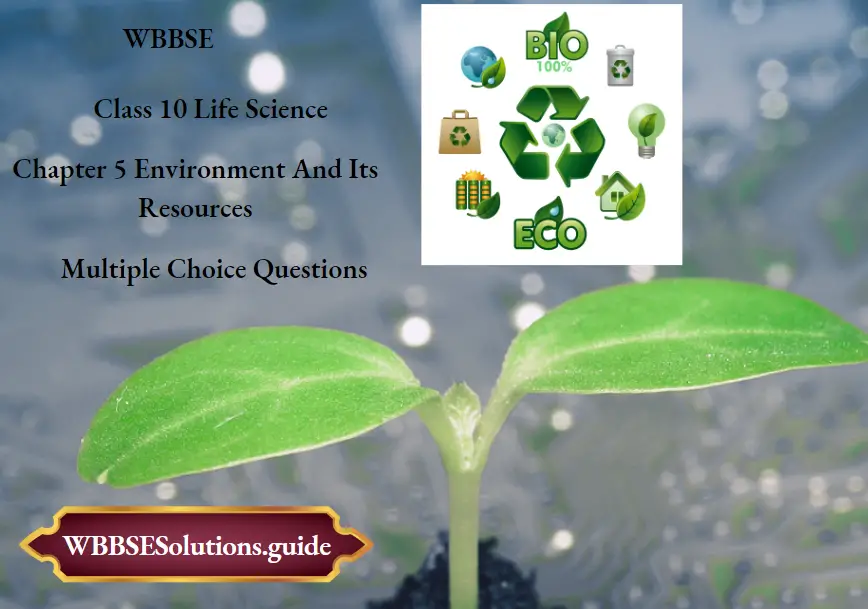
Question 6. Which one of the following is the primary consumer?
(1) Grass
(2) Tiger
(3) Goat
(4) Vulture
Answer: (3) Goat.
Question 7. The total organic matter present in an ecosystem is called –
(1) Biome
(2) Litter
(3) Biomass
(4) Biotic community
Answer: (3) Biomass.
Question 8. What is the characteristic of energy flow in an ecosystem?
(1) Circular
(2) Unidirectional
(3) Multidirectional
(4) Introspective
Answer: (2) Unidirectional.
Question 9. Which one is not a producer in the ecosystem?
(1) Pea plant
(2) Grass
(3) Algae
(4) Agaricus
Answer: (4) Agaricus.
Question 10. In a pond ecosystem, phytoplankton acts as —
(1)Producer
(2) Primary consumer
(3) Secondary consumer
(4) Decomposer
Answer: (1) Producer.
Question 11. The law of energy flow is formulated by
(1) Clarke
(2) Lindeman
(3) Odum
(4) Haeckel
Answer: (2) Lindeman.
Question 12. The first order consumer in the grassland ecosystem is –
(1) Toad
(2) Dragonfly
(3) Sparrow
(4) Snake
Answer: (2) Dragonfly.
Question 13. The orchid is —
(1) Parasite
(2) Saprophyte
(3) Epiphyte
(4) Commensal
Answer: (3) Epiphyte.
Question 14. The energy at every level is reduced by –
(1) 5%
(2) 10%
(3) 1%
(4) 50%
Answer: (2) 10%.
Question 15. An example of stenothermal animals is-
(1) Birds
(2) Tools
(3) Ants
(4) Fishes
Answer: (1) Birds.
Question 16. The size of the population increases due to –
(1) Low natality.
(2) High mortality
(3) Low natality and emigration
(4) Low mortality and immigration
Answer: (4) Low mortality and immigration.
Question 17. The term ecosystem was coined by –
(1) Tansley
(2) Elton
(3) Odum
(4) Lindemann
Answer: (1) Tansley.
Question 18. Cuscuta-reflex is an example of-
(1) Prediction
(2) Endoparasitism
(3) Ectoparasitism
(4) Brood parasitism
Answer: (3) Ectoparasitism.
Question 19. The free-floating plant specimens are called –
(1) Benthos
(2) Zooplankton
(3) Phytoplankton
(4) Nakton
Answer: (2) Zooplankton.
Question 20. Interconnected food chains are called –
(1) Food chain
(2) Food web
(3) Food pyramid
(4) Trophic level
Answer: (2) Food web.
Question 21. Which is the main source of energy in the ecosystem?
(1) Atomic energy
(2) Solar energy
(3) Electrical energy
(4) None of them
Answer: (2) Solar energy
Question 22. Among the following which is the primary consumer?
(1) Snake
(2) grasshopper
(3) toad
(4) Hawk
Answer: (2) grasshopper
Question 23. The word ‘ecosystem’ was first coined by.
(1) Tansley
(2) Odum
(3) Lamarck
(4) Lindemann
Answer: (1) Tansley
Question 24. The chief source of the evolution of 02 in the atmosphere is
(1) Photosynthesis
(2) Respiration
(3) Combustion
(4) Water
Answer: (1) Photosynthesis
Question 25. Which of the organisms can fix solar energy?
(1) Protozoa
(2) Fungi
(3) Green plant
(4) Parasitic plant
Answer: (3) Green plant
Question 26. Ecological pyramids are of-
(1) two types
(2) three types
(3) four types
(4) five types
Answer: (2) three types
Question 27. The amount of C02 present in the atmosphere is –
(1) 6.5%
(2) 0.34%
(3) 3.34%
(4) 0.03%
Answer: (4) 0.03%
Question 28. Among the following that can release oxygen in the ecosystem is
(1) Producer
(2) Consumer
(3) Decomposer
(4) All of them
Answer: (1) Producer
Question 29. The biosphere is also called –
(1) Lithosphere
(2) Hydrosphere
(3) Atmosphere
(4) Ecosphere
Answer: (4) Ecosphere
Question 30. Primary consumers were called
(1) Haeckel
(2) Elton
(3) Odum
(4) Tansley
Answer: (2) Elton
Question 31. The steps in the food chain are called –
(1) Pyramid
(2) Producers
(3) Trophic levels
(4) Consumers
Answer: (3) Trophic levels
Question 32. The total energy which is present in the food is termed as –
(1) Net production
(2) Food production
(3) Gross production
(4) None of them
Answer: (3) Gross production
Question 33. The example of a parasitic food chain is –
(1)Decaying organic matter—> Earthworm —> Bacteria
(2)Green plants —> Man —> Entamoeba
(3)Green plants —> Grasshopper —> Toad —> Snake
(4)All of them
Answer: (2) Green plants—> Man—> Entamoeba
Question 34. The denitrifying bacteria is
(1) Nitrosomonas
(2) Azotobactor
(3) Micrococcus
(4) All of them
Answer: (3) Micrococcus
Question 35. Aquatic animals which live at the bottom of the sea are called –
(1) Plankton
(2) Benthos
(3) Newton
(4) None of them
Answer: (b) Benthos
Question 36. All the living beings of land, water, and air on earth constitute –
(1) biosphere
(2) lithosphere
(3) atmosphere
(4) hydrosphere
Answer: All the living beings of land, water, and air on Earth constitute the biosphere.
Question 37. The envelopes of air surrounding the earth are called –
(1) Lithosphere
(2) Hydrosphere
(3) Atmosphere
(4) Biosphere.
Answer: The envelops of air surrounding the earth is called the atmosphere
Question 38. The part of the earth which is covered by water is called –
(1) Hydrosphere
(2) Lithosphere
(3) biosphere
(4) atmosphere.
Answer: The part of the earth that is covered by water is called the hydrosphere.
Question 39. The metallic element present in the exhaust of automobiles is-
(1) mercury
(2) copper
(3) lead
(4) iron.
Answer: The metallic element present in the exhaust of automobiles is lead.
Question 40. The greenhouse effect is due to –
(1) CO2
(2) CO
(3) NO2
(4) SO2
Answer: The greenhouse effect is due to CO2
Question 41. The term biosphere is used for the zone of earth where life exists
(1)In the hydrosphere
(2)In the atmosphere
(3)On the lithosphere
(4)In the lithosphere, hydrosphere and atmosphere.
Answer: The term biosphere is used for the zone of earth where life exists, in the lithosphere, hydrosphere, and atmosphere.
Question 42. Earth is protected from ultra violet radiation using-
(1) Rain
(2) Ozone layer
(3) cloud
(4) fog
Answer: Earth is protected from ultra violet radiation using an Ozone layer.
Question 43. Biosphere consists of –
(1) Atmosphere
(2) Hydrosphere
(3) Lithosphere
(4) All of them
Answer: The biosphere consists of all of them.
Question 44. Which of the following metabolic activities is not directly associated with the oxygen cycle?
(1) Respiration
(2) Excretion
(3) Photosynthesis.
Answer: Excretion is not directly associated with the oxygen cycle.
Question 45. The work of denitrifying bacteria is to –
(1) Get N2 from air
(2) Change N2 to NH3
(3) Return N2 to air
(4) Change Amino acid to NH3
Answer: The work of denitrifying bacteria is to return N2 to air.
Question 46. Which of the following bacteria fixes nitrogen in soil?
(1) Azotobacter
(2) Escheritia
(3) Trichoderma
(4) Salmonella.
Answer: Azotobacter bacteria fix nitrogen in soil.
Question 47. The process by which ammonia is transformed into nitrate is –
(1) Fixation
(2) Assimilation
(3) Nitrification
(4) Ammonification.
Answer: The process by which ammonia is transformed into nitrate is Nitrification.
Question 48. The world climate is threatened by an increase in the concentration of –
(1) Oxygen
(2) Carbon dioxide
(3) Nitrogen
(4) Water Vapours.
Answer: The world climate is threatened by an increase in the concentration of Carbon dioxide.
Question 49. Bio geochemical cycles are known as
(1) Cycles of matter
(2) Material cycles
(3) Sedimentary cycles
(4) Gaseous cycles.
Answer: Bio geochemical cycles are known as cycles of matter.
Question 50. Which bacterium is present in the root nodules of leguminous plants?
(1) Azotobacter
(2) Rhizobium
(3) Clostridium
(4) B. denitrificance.
Answer: Rhizobium is present in the root nodules of leguminous plants.
Question 51. CO2 is eliminated from the atmosphere through
(1) respiration
(2) combustion
(3) nutrition
(4) photosynthesis.
Answer: CO2 is eliminated from the atmosphere through photosynthesis.
Question 52. What is the percentage of 02 in the atmosphere?
(1) 20.60%
(2) 77.17%
(3) 0.03%
(4) 0.80%
Answer: The percentage of 02 in the atmosphere is 20.60%.
Question 53. The percentage of Nitrogen in the atmosphere is
(1) 0.03
(2) 77.17
(3) 20.60
(4) 0.04
Answer: The percentage of Nitrogen in the atmosphere is 77.17.
Question 54. Bacillus vulgaris is capable of
(1) ammonification
(2) nitrification
(3) denitrification
Answer: Bacillus vulgaris is capable of ammonification.
Question 55. A denitrifying bacteria is
(1) Pseudomonas
(2) Thiobacillus
(3) Micrococus
(4)AII
Answer: A denitrifying bacteria is Thiobacillus.
Question 56. A nitrifying bacteria is
(1) Pseudomonas
(2) Thiobacillus
(3) Nitrobacter
(4) Rhizobium.
Answer: A nitrifying bacteria is Nitrobacter.
Question 57. Which of the following organisms does not take part in the oxygen cycle?
(1) Psudomonas
(2) Euglena
(3) Mushroom
(4) Blue green algae
Answer: Mushrooms do not take part in the oxygen cycle.
Question 58. To increase the nitrogen content of the soil is necessary
(1)watering the soil
(2)adding organic manure, animal wastes, and dead bodies to the soil
(3)adding lime to the soil
(4)cutting away all the plants.
Answer: To increase the nitrogen content of the soil adding organic manure, animal wastes, and dead bodies to the soil is necessary.
Question 59. Which of the following is the primary consumer?
(1) Grass
(2) tiger
(3) goat
(4) vulture.
Answer: Goat is the primary consumer.
Question 60. The total organic matter present in an ecosystem is called –
(1) Biome
(2) litter
(3) Biotic community
(4) biomass
Answer: The total organic matter present in an ecosystem is called biomass.
Question 61. Ecological pyramids were proposed by –
(1)Tansley
(2) Odum
(3) Elton
(4) Shelford
Answer: Ecological pyramids were proposed by Elton.
Question 62. What is the nature of the characteristic of energy flow in the ecosystem?
(1) Circular
(2) Unidirectional
(3) Multi-directional
(4) Introspective.
Answer: The nature of characteristics of energy flow in the ecosystem is always Unidirectional.
Question 63. Which one is not a producer in the ecosystem?
(1) Pea plant
(2) Grass
(3) Algae
(4) Agaricus.
Answer: Agaricus is not a producer in the ecosystem.
Question 64. All animals in a particular ecosystem collectively form –
(1) A fauna
(2) A flora
(3) Nothing of flora & fauna
(4) Both flora & fauna.
Answer: All animals in a particular ecosystem collectively form a fauna.
Question 65. The ultimate source of energy that flows through the living world is-
(1) Moon
(2) Sun
(3) Neither moon nor sun
(4) Both moon and sun.
Answer: The ultimate source of energy that flows through the living world is the Sun.
Question 66. Which one of the following organisms is the primary consumer?
(1) Toad
(2) Snake
(3) Grasshopper
(4) Peacock.
Answer: Grasshopper is the primary consumer.
Question 67. The base of the general food pyramid is occupied by –
(1) Autotroph
(2) Carnivore
(3) Decomposer
(4) Herbivore
Answer: The base of the general food pyramid is occupied by autotrophs.
Question 68. In a pond ecosystem, phytoplankton act as –
(1) Producers
(2) Primary consumers
(3) Secondary consumers
(4) Decomposers.
Answer: In a pond ecosystem, phytoplankton acts as producers.
Question 69. The law of energy flow was formulated by –
(1) Clarke
(2) Lindeman
(3) Odum
(4) Kendai
Answer: The law of energy flow was formulated by Linde Man.
Question 70. Name a first-order consumer in the ecosystem of grass covered field.
(1) Toad
(2) Dragonfly
(3) Sparrow
(4) Snake
Answer: Dragonfly is a first-order consumer in the ecosystem of grass-covered fields.
Question 71. Govt, of India, set up the Indian Board of Wildlife in –
(1) 1861
(2) 1952
(3) 1972
(4) 1976.
Answer: Govt, of India, set up the Indian Board of Wildlife in 1952
Question 72. Govt, of India, introduced the Wildlife Protection Act in –
(1) 1961
(2) 1972
(3) 1952
(4) 1956
Answer: Govt, of India, introduced the Wildlife Protection Act in 1972
Question 73. In India horned Rhinoceros are protected in –
(1) Jaldapara
(2) Sundarban
(3) Corbett National Park.
Answer: In India horned Rhinoceros are protected in Jaldapara.
Question 74. Cultivation of the same crop on the same soil year after year is called
(1) Silviculture
(2) Horticulture
(3) Monoculture
(4) Multiple Crop
Answer: The cultivation of the same crop on the same soil year after year is called monoculture.
Question 75. Corbett National Park is famous for the conservation of-
(1) Rhinoceros
(2) Tiger
(3) Lion
(4) Deer.
Answer: Corbett National Park is famous for the conservation of Tiger.
Question 76. Large-scale deforestation decreases –
(1) Drought
(2) Soil erosion
(3) Global Warming
(4) Rainfall
Answer: (4) Rainfall.
Question 77. Which one is used as food?
(1) Spirogyra
(2) Volvox
(3) Spirulina
(4) Chlamydomonas
Answer: (3) Spirulina.
Question 78. The practice of growing fruits, vegetables, and ornamental plants is called –
(1) Agriculture
(2) Pisciculture
(3) Apiculture
(4) Horticulture
Answer: (4) Horticulture.
Question 79. Which one is an edible fungus?
(1) Mucor
(2) Agaricus
(3) Yeast
(4) Penicillium
Answer: (2) Agaricus.
Question 80. The rearing and management of honey bees is called –
(1) Apiculture
(2) Sericulture
(3) Pisciculture
(4) Horticulture
Answer: (1) Apiculture.
Question 81. The growing of timber-yielding plants is-
(1) Agriculture
(2) Horticulture
(3) Sylviculture
(4) Sericulture
Answer: (3) Sylviculture.
Question 82. The water that is fit for drinking is –
(1) Salty water
(2) Potable water
(3) Rainwater
(4) Polluted water
Answer: (2) Potable water.
Question 83. Fisheries include –
(1) Fish
(2) Shellfish
(3) Prawn
(4) All of these
Answer: (4) All of these.
Question 84. ‘Sufu’ a food is produced from –
(1) Yeast
(2) Mucor
(3) Chlorella
(4) None of these
Answer: (2) Mucor.
Question 85. The seeds of ‘Chilgoza’ are obtained from –
(1) Cycas
(2)Pinus
(3) Mass
(4) Fern
Answer: (2) Pinus.
Chapter 5 Environment And Its Resources Very Short Type Questions And Answers
Question l. Name a nitrogen-fixing symbiotic microbe in soil.
Answer: The name of a nitrogen-fixing symbiotic microbe in the soil is Rhizobium leguminous sodium.
Question 2. Write the name of a free-living nitrogen-fixing bacteria in the soil.
Answer: The name of a free-living nitrogen-fixing bacteria in soil is Azotobacter.
Question 3. Which type of algae can absorb nitrogen directly from the atmosphere?
Answer: Blue-green algae (Ex: Nostoc and Anabena) can absorb nitrogen directly from the atmosphere.
Question 4. Name one de-nitrifying bacterium present in soil.
Answer: The name of one de-nitrifying bacterium present in soil is Thiobacillus denitrificance.
Question 5. Name one nitrifying bacteria.
Answer: The name of a nitrifying bacteria is Nitrobacter.
Question 6. Name one N2 – fixing blue-green algae.
Answer: The name of one N2-fixing blue-green algae is Nostoc.
Question 7. Name the gas which is essential for the plants but cannot be absorbed directly from the air.
Answer: Nitrogen gas (N2 ).
Question 8. Name a gas that can be directly absorbed by the plants from the air but cannot be absorbed directly by the animals.
Answer: Carbon dioxide (CO2 ).
Wbbse Class 10 Life Science Solutions
Question 9. In the nitrogen cycle which bacterium converts nitrite to nitrates.
Answer: Nitrobacter.
Question 10. Do all plants take up nitrogen directly from the air?
Answer: No.
Question 11. Which element is prevalent in a maximum amount in the atmosphere and can not be taken up by plants and animals directly?
Answer: Nitrogen.
Question 12. Which mineral substance absorbs CO2 from the air?
Answer: Lime stone/Calcite/Feldspar
Question 13. Due to which life process of plants the amount of carbon-di-oxide is decreased in the environment?
Answer: Photosynthesis.
Question 14. Mention one role of the living organisms in the carbon cycle to remove carbon from the atmosphere.
Answer: Photosynthesis.
Question 15. Mention the cycle of the gas that can be directly absorbed neither by plants nor by animals.
Answer: This is the cycle of Nitrogen gas.
Question 16. Mention one importance of the oxygen cycle.
Answer: It is essential for respiration and combustion.
Question 17. Which group of living organisms in an ecosystem is called a producer?
Answer: The autotroph group of living organisms in an ecosystem is called the producer.
Question 18. How many classes of ingredients participate in an ecosystem?
Answer: Two (Abiotic and biotic)
Question 19. What organisms are responsible for the decay of organic matter?
Answer: Decomposers (Saprophytic bacteria and fungus)
Question 20. Who are the producers in the ecosystem?
Answer: Green plants.
Question 21. What is the main source of energy in an ecosystem?
Answer: The sun.
Question 22. Name a sanctuary of West Bengal.
Answer: The name of a sanctuary in West Bengal is ‘Jaldapara.’
Wbbse Class 10 Life Science Solutions
Question 23. Give an example of a sanctuary in W.B. for rhinoceros conservation.
Answer: ‘Jaldapara’ is an example of a Sanctuary in W.B. for rhinoceros conservation.
Question 24. For the conservation of which animal, Sundarban Sanctuary is famous?
Answer: Sundarban Sanctuary is famous for the conservation of the ‘Royal Bengal Tiger.’
Question 25. Jaldapara Sanctuary is famous for the conservation of which animal?
Answer: Jaldapara Sanctuary is famous for the conservation of horned Rhinoceros.
Question 26. Name a sanctuary in West Bengal other than Sundarban.
Answer: ‘Jaldapara’ is a sanctuary in West Bengal other than Sundarban.
Question 27. Give one example of renewable natural resources.
Answer: Solar energy is an example of renewable natural resources.
Question 28. Where are tiger conservation projects situated in West Bengal?
Answer: Namkhana, Basirhat.
Question 29. Give two examples of conservation.
Answer:
(1) Soil conservation
(2) Forest conservation.
Question 30. Write the names of two forests in India where the tiger is conserved.
Answer:
(1) Sundarban – West Bengal and
(2) Bandipur – Karnataka.
Question 31. Where in West Bengal is the sanctuary for the tiger?
Answer: Sundarban.
Question 32. Mention any one measure to conserve a near-extinct plant or animal.
Answer: For the conservation of near to extinct plants or animals sanctuaries and National Parks should be established.
Question 33. Due to the insufficiency of rainfall in a particular area, there is a severe water crisis there. Write one of the many measures that you may take to face the situation.
Answer: To face the situation we should arrange hand pipes and deep tube wells.
Wbbse Class 10 Life Science Solutions
Question 34. What are the four main divisions of the environment?
Answer:
(1) Lithosphere
(2) Hydrosphere
(3) Atmosphere
(4) Biosphere.
Question 35. Define biosphere.
Answer: The world of living organisms together with the physical world (ex – land, water, and air) is called the biosphere.
Question 36. What are livestock?
Answer: These are domesticated farm animals such as cows buffalo, and sheep, reared to get meat and milk.
Question 37. What is an ecosystem?
Answer: The structural and functional unit of ecology is called an ecosystem.
Question 38. Define Apiculture.
Answer: The rearing and management of honey bees to produce honey on a large scale.
Question 39. What are the roles of animal husbandry in human welfare?
Answer: In dairy products, Meat, Labour, Fibre, and making fertilizer.
Question 40. Define Afforestation.
Answer: The process of planting trees in an area of land to form a forest is called afforestation.
Question 41. Name two non-conventional energy sources.
Answer:
(1) solar energy
(2) tidal energy
Question 42. What is the Red Data Book?
Answer: The book in which the names of globally extinct and endangered species are enlisted.
Question 43. What is potable water?
Answer: The water used for safe drinking is called potable water.
Question 44. What do you mean by watershed?
Answer: Rainwater is collected, stored, and used to meet the demand for fresh water.
Question 45. What is life?
Answer: The plants and animals in their natural habitat are called wildlife.
Question 46. Why is a forest called a biodiversity hot spot?
Answer: Because it gives shelter to many smaller to larger plants and animals.
Wbbse Class 10 Life Science Solutions
Question 47. Name two environment-friendly sources of energy.
Answer:
(1) Wind energy,
(2) Water energy.
Question 48. Primary consumers are called “key industry animals”. Why?
Answer: Because they change the plant materials into animal material.
Question 49. Mention the names of two animals included in the list for preservation.
Answer:
(1) one horned rhinoceros
(2) crocodiles.
Question 50. What is meant by ‘nitrogen fixation’?
Answer: The conversion of atmospheric nitrogen into nitrite and nitrate is called nitrogen fixation.
Question 51. Name two blue-green algae helpful in N2 fixation.
Answer:
(1) Nostoc,
(2) Anabaena.
Question 52. What is meant by the bio-geo-chemical cycle?
Answer: The circulation of the essential chemical nutrients in a biosphere is called the biogeochemical cycle.
Question 53. What will happen primarily if all the green plants in an ecosystem are lost?
Answer: The ecosystem will not exist and finally this universe will be lifeless.
WBBSE Solutions For Class 10 Life Science Chapter 5 Environment And Its Resources Short Answer Questions
You can download the class 10 WBSE Life Science Book pdf from wbbsesolutions.guide
Chapter 5 Environment And Its Resources Short Answer Questions
Question 1. Mention the percentage of nitrogen, oxygen, and carbon dioxide in the air.
Answer:
(1)’Nitrogen’ – 77.17%
(2)Oxygen – 20.60%
(3) Carbon di-oxide – 0.03%
Question 2. What is the Nitrogen Cycle?
Answer: The cyclic rotation of atmospheric nitrogen gas from the atmosphere to soil from soil to the living body and again from the living body to its source is called the nitrogen cycle.
Question 3. What is meant by nitrification?
Answer: The process of conversion of ammonia to nitrite (NO2) and nitrite to nitrate (NO3) with the help of nitrifying bacteria (such as Nitrosomonas and Nitrobacter) is called nitrification.
Question 4. Mention the different components of an ecosystem.
Answer: There are two components of an ecosystem
(1)Abiotic Soil, water, minerals, air, temperature, light, humidity, etc.
(2)Biotic Producers, consumers, and demmposers.
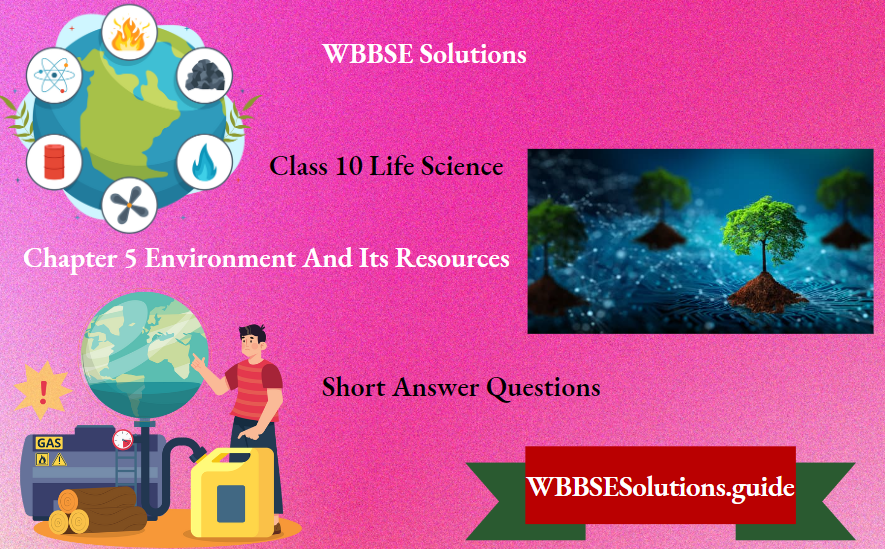
Question 5. Name two abiotic and three biotic components of the ecosystem.
Answer:
(1) Abiotic:-
(1) soil and
(2) water.
(2) Biotic:-
(1) producers,
(2) consumers,
(3) decomposers.
Wbbse 10th Class Life Science Question Answer
Question 6. What do you understand by the term producer in the ecosystem?
Answer: The autotrophs (green plants) that can convert solar energy into potential chemical energy by the process of photosynthesis are called producers. ExampleMango trees.
Question 7. What is meant by Consumer?
Answer: The organisms that are unable to prepare their food by the process of photosynthesis and directly or indirectly depend on autotrophs for their food, are called consumers. Example Grasshopper, butterflies, toad, snake.
Question 8. Give the name of the denitrifying bacterium and mention its functions.
Answer:
(i) Bacillus denitrificance.
(ii) Function It converts nitrate and nitrite into free form of nitrogen. This also helps to return nitrogen to its source.
Question 9. What is Biomass?
Answer: The weight of all the organisms forming a given population in a given area is called biomass.
Question 10. What do you mean by plankton and nekton?
Answer: PlanktonThe free-floating microorganisms are called plankton.
For example algae and protozoa.
Nekton Swimming animals in the pelagic zone of the sea or lake are called nekton.
Example Fishes and whales.
Question 11. Arrange the following organisms in the correct sequence (from producer to secondary consumer): Kingfisher – Algae – Fish.
Answer: Algae – fish – kingfisher.
Question 12. Explain the food chain in the ecosystem.
Answer: The linear arrangement of living organisms in which one is the food of the other organism and the transfer of food energy occurs systematically is called a food chain. Example:- Grass – Grasshopper – Toad – Snake – peacock.
Question 13. What is meant by decomposer in an ecosystem?
Answer: The saprophytic organisms like bacteria and fungi which decompose the dead body of plants and animals, are called decomposers.
Question 14. Write the names of three organic and three inorganic components of an ecosystem.
Answer:
(1) Organic components –
(1)Carbohydrates,
(2) Proteins,
(3) Fats.
(2) Inorganic components –
(1) Water,
(2) Air,
(3) Minerals (Ca, Mg, Fe, etc.)
Question 15. Indicate with arrows the path of the flow of energy among toads, vultures, grass, snakes, and grasshoppers in a grassland ecosystem.
Answer: Grass > Grasshopper> Toad > Snake > Vulture.
Question 16. Write the difference between the Food chain and the Food web.
Answer:
Question 17. What is a food pyramid?
Answer: Food pyramid The gradual reduction of the trophic level of the food chain of an ecosystem producing a conical pyramid-like structure is called an ecological pyramid. Ex. pyramid of number, pyramid of mass, and pyramid of energy.
Question 18. What disaster would occur in a grassland ecosystem if the application of pesticides kills the decomposer bacteria and fungi The ecosystem will be unbalanced in the absence of decomposers. The dead bodies of plants and animals will be accumulated on the earth.
Question 19. Explain how biotic factors of an ecosystem are dependent on abiotic factors.
Answer: Producers, consumers, and decomposers are biotic factors. Consumers and decomposers obtain their food from producers directly or indirectly. Producers obtain water from the soil and air. These two are raw materials. Sunlight is obtained from the sun. They prepare their food by the process of photosynthesis. Thus biotic factors are dependent on abiotic.
Question 20. Mention the role of producers in an ecosystem.
Answer: Producers use solar energy to prepare their food. This food is the source of food for other living. They also produce oxygen gas. This gas is used by living for respiration.
Question 21. What is meant by conservation?
Answer: The process of proper utilization and management of natural resources (like air, water, soil, etc.) to keep their composition normal for the welfare of human beings is called conservation.
Question 22. Mention two main purposes of conservation.
Answer:
(1) To maintain the balance of ecosystem and
(2) to ensure a continuous yield of useful plants, animals, and materials by establishing a balanced cycle of harvest and renewal.
Wbbse 10th Class Life Science Question Answer
Question 23. What is meant by the conservation of soil?
Answer: To keep the normal balance of the components of soil which are essential for plant growth is called soil conservation.
Question 24. What is a National Park?
Answer: A national park is an area that is strictly reserved for the betterment of wildlife and where activities like forestry, grazing, and cultivation are not allowed. Ex – Kaziranga, Corbett, Gir, Kanha, etc.
Question 25. What do you mean by sanctuary?
Answer: A sanctuary is a protected area that is reserved for the conservation of only animals and human activities like harvesting of timber, and collection of minor forest products, and private ownership rights are allowed so long as they do not interfere with the wellbeing of animals. Ex-Jaldapara, Nagarjun sagar, Dachigam.
Question 26. What is a reserve forest or protected forest?
Answer: It is a forest area that is protected with all its components by the India Forest Act. Entrance without permission is prohibited. Ex-Gorumara, periyar.
Question 27. Mention any two causes of soil erosion.
Answer:
(1) Exposed dry soil without any vegetation.
(2)Overgrazing by cattle.
Question 28. Write two aims and objectives of conservation.
Answer:
(1) To maintain the ecological balance.
(2) To protect the endangered species.
Question 29. The population of deer in a particular forest land has suddenly and rapidly increased. What steps (any two) will you take to bring back a balance in the ecosystem after analyzing the possible causes of the increase in the population of deer?
Answer:
(1) Provide food and water as early as possible.
(2) The tree plantation scheme should be sped up.
Question 30. The biosphere is considered the largest biological system. Give reasons.
Answer: Because the biosphere has a structure made up of all the living and nonliving components of Earth where each component performs a certain function. Their functions make the biosphere dynamic and stable.
Question 31. A plant cannot absorb Nitrogen directly from the air.
Answer: Reasons
(1)Direct nitrogen-absorbing biological processes are absent in plants.
(2)Nitrogen gas is insoluble in water.
(3)Nitrogen is a comparatively less reactive gas.
Question 32. Why is the pyramid of energy always upright?
Answer: The pyramid of energy is always upright because the flow of energy always takes place from producer to consumer, which means in one direction only.
Wbbse 10th Class Life Science Question Answer
Question 33. Name two case studies in India for the food crisis.
Answer:
(1) Irish Famine (1851) induced by fungus Phytophthora – infestans causing late blight of potato.
(2) Great Bengal Famine (1942) induces by the fungus Dreschlera-oryzae causing the Brown spot disease of Rice.
Question 34. Why are windmills located in coastal areas?
Answer: Because the minimum wind velocity required to run a windmill is 20 km/hour, which is possible only in coastal areas.
Question 35. What is geothermal energy?
Answer: The energy obtained from the interior of the earth is called geothermal energy.
Question 36. What is biomass?
Answer: The matter contained in the body of plants and animals is called biomass. It is used to produce energy. It contributes 15% of total energy.
Question 37. What is Eutrophication?
Answer: Excess amounts of untreated sewage and pollutants are dumped into water bodies, accelerating the growth of algae and depleting O2 content, result in damage to aquatic life and the water smells pungent.
Question 38. Define biomagnification.
Answer: The gradual increase of harmful chemicals like pesticides from one trophic level to another through a food chain is called biomagnification.
Question 39. What is global warming?
Answer: Due to the increase in CO2 concentration in the atmosphere, the temperature of the earth increases causing the melting of glaciers and polar caps cap is called global warming.
Question 40. What are greenhouse gases?
Answer: The gases which cause the greenhouse effect are called greenhouse gases, eg. Methane, CO2 water vapor, etc.
Question 41. Define ecology and environment.
Answer:
Ecology :
The natural surrounding of an organism, which affects its life, by directly influencing its activities, is called an environment. It includes both physical and living environments.
Environment:
The branch of science which deals with the interrelationship between the living organism and the environment is called ecology.
E. Flaeckel (1869) first proposed the term ecology.
Question 42. Mention the relationship between the food chain and the food web in the ecosystem.
Answer:
Food Chain :
The sequential process in which one organism consumes another to transfer food energy is called a food chain.
Food web:
The network of various food chains that are interconnected at various trophic levels is called the food web.
Relation: Many food chains of the same habitat form a food web. So, the food chain is a structural and functional unit of the food web. In a food web food chains are interconnected and interdependent.
Question 43. Define two types of ecology.
Answer:
Autecology:
The study of an individual organism or individual species and its interaction with the environment.
Synecology :
The study of a group of organisms or living communities and their interrelationship with the environment.
Question 44. What is meant by nitrogen fixation? Mention the role of symbiotic bacteria in that process.
Answer:
(1) Nitrogen fixation The conversion of atmospheric free nitrogen gas into the form of nitrite (NO2) and nitrate (NO3) is called nitrogen fixation.
It takes place in three ways –
(1) Natural fixation,
(2) Biological fixation,
(3) Chemical fixation.
Wbbse 10th Class Life Science Question Answer
(2) Role of symbiotic bacteria in nitrogen fixation Rhizobium bacteria lives in the root nodules of leguminous plants like peas and grams. It converts nitrogen into ammonia in the presence of the enzyme ‘ nitrogenase’. Further, this ammonia is utilized by plants to produce their nitrogenous substances.
N2 + 3H2 = 2NH3
Question 45. Discuss in brief the role of free-living and symbiotic bacteria in the fixation of free nitrogen in the soil.
Answer:
(1) Role of free-living bacteria Some saprophytic bacteria live freely in soil and convert free nitrogen into nitrite and nitrate, for example – Azotobacter and Clostridium.
(2) Role of symbiotic bacteria They live in the root nodules of leguminous plants i.e., peas and grams. They convert nitrogen into ammonia in the presence of the enzyme nitrogenase. This ammonia is used to form nitrogenous compounds by the plant.
Question 46. Discuss two important roles of organisms in supplying carbon dioxide to the environment.
Answer: Role of organisms in supplying carbon-di-oxide to the environment –
(1)Respiration Every living organism releases carbon dioxide into the environment during respiration.
(2)DecompositionThe dead bodies of organisms are decomposed by saprophytic bacteria and fungi. The carbon dioxide gas produced during decomposition is returned to the environment.
(3)Burning Carbon dioxide gas returns to the environment due to the burning of different types of fuels, such as coal, petrol, diesel, etc.
Question 47. Explain in brief how energy flows through the living components of the ecosystem.
Answer: The way energy flows in the living components of the ecosystem
(1)Solar energy is the only source of energy flow.
(2)Only producers can transform the solar energy into chemical energy. This chemical energy is stored within food. Solar energy never goes back to the sun from the producer. Primary consumers get their energy from producers and this energy also never goes back to the producers.
In the same way, secondary consumers obtain energy from primary consumers and tertiary consumers get energy from secondary consumers. After the death of producers and consumers, decomposers decompose the dead bodies and obtain energy.
(3) There is a gradual decrease in the energy flow from the beginning to the end of a food chain.
Question 48. What do you mean by reserve forest? Name a reserve forest in West Bengal.
Answer: It is a forest area that is protected with all its components by the India Forest Act. Entrance without permission is prohibited. Ex – Gorumara, periyar.
Question 49. Mention any three ways of water conservation.
Answer: Methods of water conservation
(1)By preventing excess cutting of trees and promoting the practice of excess tree plantation.
(2)By treating sewage and industrial wastes in water treatment plants before releasing them into rivers.
(3)By constructing dams and bunds.
Question 50. Mention in brief the importance of wildlife conservation.
Answer: The importance of wildlife conservation.
(1) Wildlife (plants and animals) maintains the continuity of the ecosystem of nature through the balance of population and food chains.
(2)They keep our environment clean, for example, green plants and scavenger birds.
(3)They are a source of various medicines.
(4)They help to understand the mechanism of evolution.
(5)They are a source of foreign currency, for example, visiting national parks by foreigners.
Question 51. What are decomposers? What role is played by it in an ecosystem?
Answer: Decomposes are also called reducers. The organism gets its nutrients from dead organisms and decaying organic matter, eg. Bacteria, and fungi.
Decomposers and transformers return the chemical nutrients to nature by decomposing and reducing the dead bodies, then these nutrients can be reused by the producers. It takes an important role in recycling the chemical nutrients, which also maintain the balance of the ecosystem.
Question 52. What is the nutrient cycle?
Answer: The cyclic movement of the chemical elements, i.e. nutrient cycling of the biosphere between the living organism to the environment is called the Bio-geo-chemical cycle.
These are the gaseous cycles (Carbon and Oxygen cycle)
Sedimentary cycle (Sulphur & Phosphorus)
Hydrological cycle (Water cycle)
Substances such as oxygen, carbon dioxide, water, and minerals are constantly absorbed by organisms, but as soon as these substances are lost from the physical world, they are replaced by natural processes and balance the ecosystem.
Chapter 5 Environment And Its Resources Descriptive Type Questions And Answers
Question 1. What are the impacts of environmental factors on an organism at the individual level?
Answer:
(1) Light:
The productivity of food in green plants depends on light. Trees are more productive than submerged plants.
Photoperiodism is the phenomenon in which flowering and seed germination depend on the duration of light. Plants are long-day plants (pea, radish), short-day plants(dahlia, Sugarcane), and day-neutral plants (cotton, tomato).
The intensity and color of light also control the process of photosynthesis. Light enhances the pigmentation of skin for many animals too, light is important in what they use.
(2)Temperature:
The plants of tropical regions have a greater number of stomata to regulate temperature. The plants in temperate regions have spiny leaves to reduce the damage caused by frost. Temperature affects the genetics of enzymes and through it the basal metabolism, activity, and other physiological functions of the organism.
A few organisms can tolerate and thrive in a wide range of temperatures. (Eurythermal), but a vast majority of them are restricted to a narrow range of temperatures (Stenothermal).
In some animals body temperature varies with environmental temp, Called poikilo thermic animals (cold-blooded).
Eg fishes, amphibians, and reptiles.
Some animals maintain constant body temperature in any environment, called warm-blooded animals (Homeothermic animals).
Eg birds and mammals.
(3)Humidity:
Animals living in desert regions have few sweat glands and excrete urine very less. Plants growing in arid climates develop features that resist atmospheric dryness. They have less and sunken stomata, waxy leaves, developed tap roof system.
Question 2. What is the impact of environmental factors on an organism at the population level?
Answer:
A group of individuals of the same species inhabiting a particular geographic area at a given period is called a population.
The total number of species in a specific natural habitat is called population density.
The population density changes by change in four basic processes, two of which contribute to an increase and two to a decrease in population –
(1)Natality:
Refers to several births during a given period in the population that are added to initial density.
(2)Mortality :
Mortality is the number of deaths in the population during a given period.
(3)Immigration :
Immigration is the number of individuals of the same species that have come into the habitat from elsewhere during the period under consideration.
(4)Emigration:
Emigration is the number of individuals in the population who left the habitat and lived elsewhere during the period under consideration.

If N is the population density at time (t) then its density at time (t + l)is –
Nt+1 = Nt+ [(B + I)-(D + E)]
Question 3. Explain the interaction among the population at the community level.
Answer:
There is no such habitat and such a situation is even inconceivable. For any species, the minimal requirement is one more species on which it can feed.
Even a plant species, which makes it our food, can not survive alone. It needs soil microbes to break down the organic matter in the soil and return the inorganic nutrients for absorption. This is called interaction in population.
Population interaction
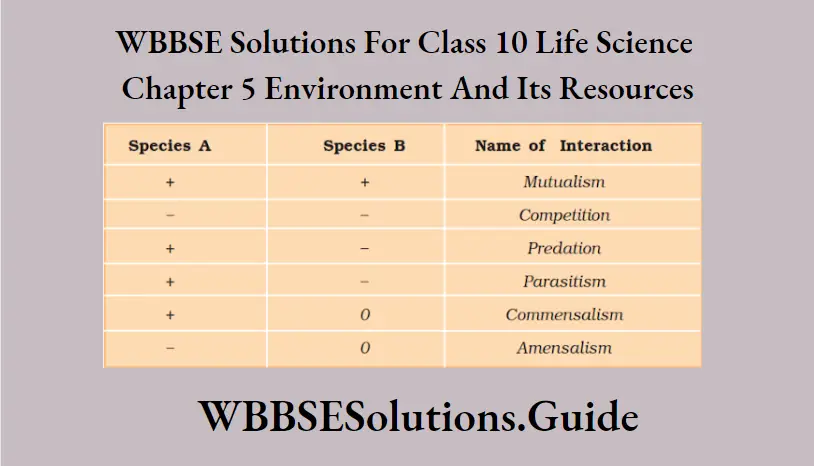
1. Symbiosis or Mutualism:
It is an interspecific co-operation in which two species live in a physically close association and both are benefited by each other.
Eg. Lichen is the association of algae and fungi. Nitrogen-fixing bacteria in nodules of Leguminous plants.
Competition :
Interaction is where members of the same or other species compete with each other to acquire, food, shelter, and water. It may be inter-specific or intra-specific. In the competition process, the fitness of one species is significantly lower in the presence of another species.
Eg. weeds in crop fields compete for food and shelter with crops and finally reduce the productivity of crops.
Predation:
In this type of interaction one species attacks (Predator) another species (Prey) to kill and consume it. The predator obtains nutrients and energy from the prey. The predator keeps the prey population under control.
Biological control methods adopted in agricultural pest control are based on the ability of the predator to regulate the prey population. But if a predator is too efficient and over-exploits its prey, then the prey might become extinct, and following it, the predator will also become extinct for lack of food.
Parasitism:
The interaction in which the parasite gets the benefit and the host gets the loss. Parasite may be –
Ectoparasites – draw nutrients from the outside body of the host.
eg. Female anopheles mosquito, Leech, bedbugs.
Endoparasites – live inside the body of the host and collect nutrients from them.
Eg. – Tapeworm, Ascaris.
Obligatory parasites – the organism leading parasitic life throughout its life cycle.
Eg. Tapeworm, Ascaris.
Facultative parasites – organisms show parasitic behavior in certain periods of their life cycle.
eg. Female anopheles mosquito.
Commensalism :
This is the interaction in which one species benefits and the other is neither harmed nor benefited.
Eg. (1) an orchid growing as an epiphyte on a mango branch and
(2) barnacles growing on the back of the whale benefited while neither the mango tree nor the whale derived any apparent benefit.
Question 4. Explain the interaction between organism and their organizations at the ecosystem level.
Answer:
Functional interrelation between biotic communities and their habitat constitutes an ecosystem.
There are two aspects of the ecosystem.
(1)Structural aspects-
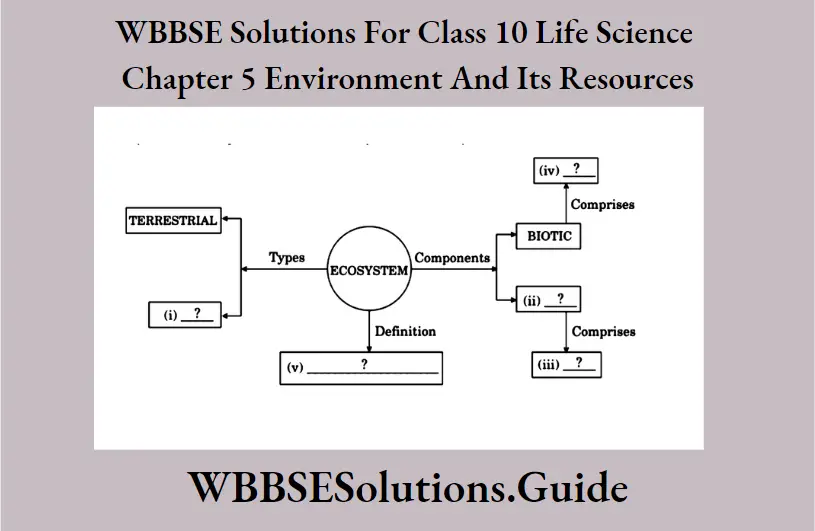
Light – Source of energy of the living world.
Temperature – In the optimum temperature life process functions smoothly. Water – It influences the life of organisms. Aquatic organisms depend on water for their survival.
Atmosphere – The atmospheric pressure varies inversely with the altitude. Lower atmospheric pressure of oxygen and this condition is harmful.
Topography – The altitude, landscape, the amount of light falling on a place or wind blowing add to form the topographic factors of an ecosystem.
Question 5. Difference between food chain and food web.
Answer:
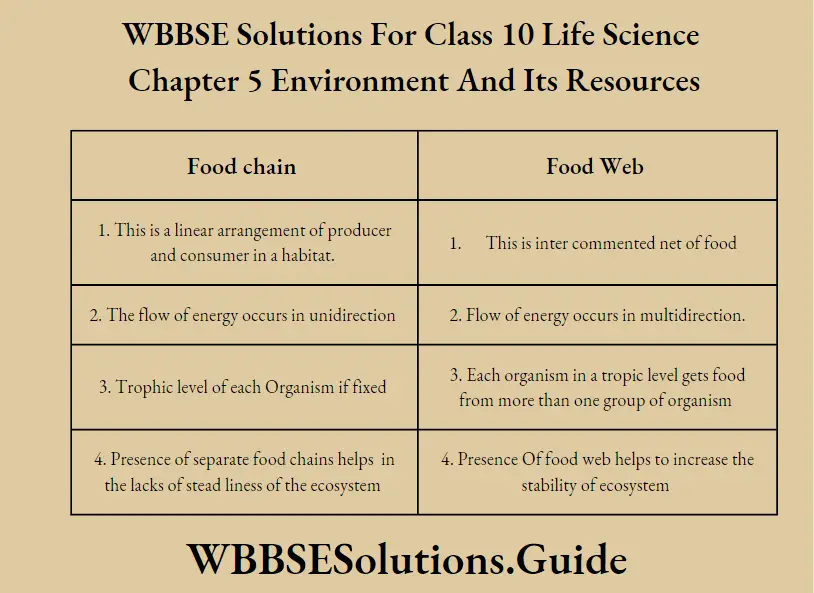
Question 6. What is an ecosystem? Mention the different components of an ecosystem. Briefly describe the role of abiotic and biotic factors which control an ecosystem.
Answer:
Ecosystem :
The basic structural and functional unit of ecology is called an ecosystem.
Components of Ecosystem :
There are two components of the ecosystem –
1. Abiotic,
2. Biotic
1. Abiotic – The non-living constituents of the environment are called abiotic.
Abiotic constituents are divided into three groups :
(1)Inorganic material –
This consists of water, soil, minerals (Ca, K, Mg, Fe, etc.), and gases like oxygen, Carbon dioxide, and nitrogen.
(2)Organic material –
Carbohydrates, proteins, and Fats of dead. organisms constitute the organic material.
(3)Climatic factors –
Rainfall, temperature, light, and humidity are climatic factors.
The principal climatic factor is light (solar energy). This energy is trapped by green plants during photosynthesis and stored as chemical energy in Carbohydrates.
2. Biotic – All the living organisms (plants and animals) of the environment are called biotic.
Biotics are classified into three groups –
(1)Producers,
(2) Consumers,
(3) Decomposers.
(1)Producers:- Green plants and photosynthetic bacteria that can prepare their food by the process of photosynthesis in the presence of sunlight are called producers.
(2)Consumers:- The heterotrophic organisms mostly animals which can not prepare their food by the process of photosynthesis and get it from other organisms, are called consumers.
There are three types of consumers –
(1) Primary consumers – The herbivores that directly eat the plant are called primary consumers.
Ex – goat, rabbit, deer, etc.
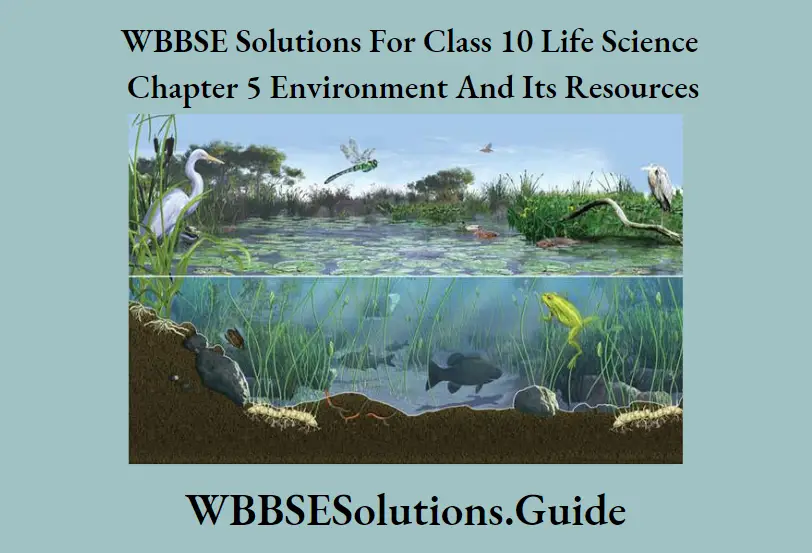
(2)Secondary consumers – The animals that eat herbivorous animals are called secondary consumers.
Ex-Fox, fish crow, snake, etc.
(3)Tertiary consumers – The animals that are not eaten by other animals are called tertiary consumers.
Ex – Hawk, owl, vulture, shark, tiger, lion, etc.
(3)Decomposers:- The saprophytic organisms that can decompose the organic materials of dead bodies of living organisms into simple inorganic materials are called decomposers.
Ex – Saprophytic bacteria and fungi.
Question 7. What is a food chain? Name the different types of food chains. Define them.
Answer:
Food chain
(1) The arrangement of living organisms in which food energy passes from producer to consumer in a linear sequence of eat and be eaten is called a food chain.
(2) Types of food chain :
There are three types of food chains –
(1)Grazing food chain,
(2) Detritus food chain,
(3) Parasitic food chain.
(1)Grazing food chain :
The food chain that starts from producers and passes through consumers like primary, and secondary, and terminates with top consumers is called a grazing food chain.
Grasses -> insects -> Amphibians snakes -» peacock.
(2)Detritus food chain –
The food chain starts from dead organic matter, goes into microorganisms, and then to detritus-feeding organisms (detrivores) and their predators is called detritus food chain.
Dead organic matter -» microorganism -» small fish -> large fish.
(3)Parasitic food chain –
This chain passes from larger animals to smaller animals.
Plant -> Man -» Eschertia coli.
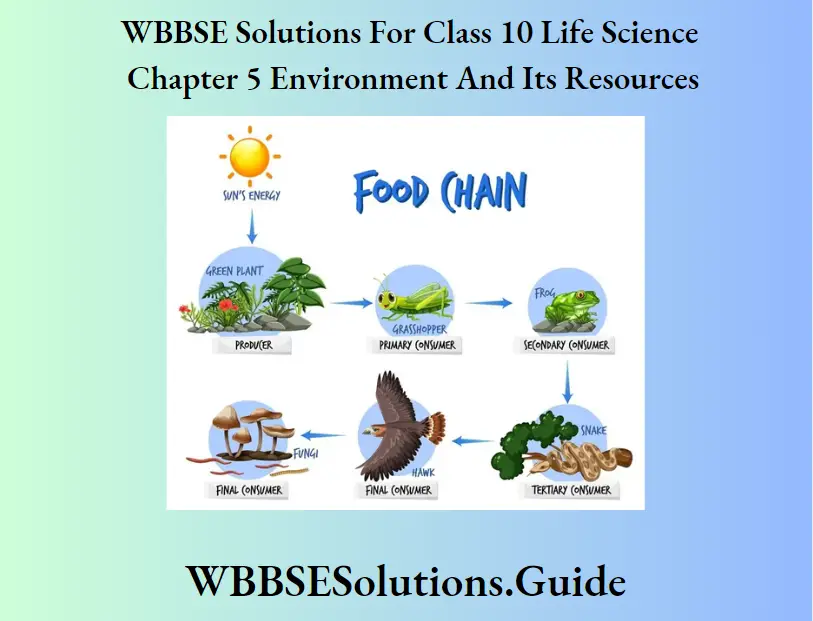
Question 8. What is an ecosystem? Explain what is meant by energy flow in an ecosystem.
Answer:
(1) The basic structural and functional unit of ecology is called an ecosystem.
(2) Energy flow in an ecosystem:-
In an ecosystem sun is the main source of energy. In the sun hydrogen is constantly transformed to helium with the release of an enormous amount of energy. This energy leaves the sun and passes into outer space in the form of light and other radiations.
Only a very small amount (0.1% of the total energy falling on earth) of light energy is absorbed by green plants and utilized in the formation of food. The radiant energy of the sun is transformed into chemical energy during photosynthesis. This chemical energy is stored within food (glucose).
Primary consumers feed on producers and thereby get the potential energy of producers. The secondary consumers feed on primary consumers, from where they get their potential energy. Similarly, tertiary consumers get their potential energy from secondary consumers.
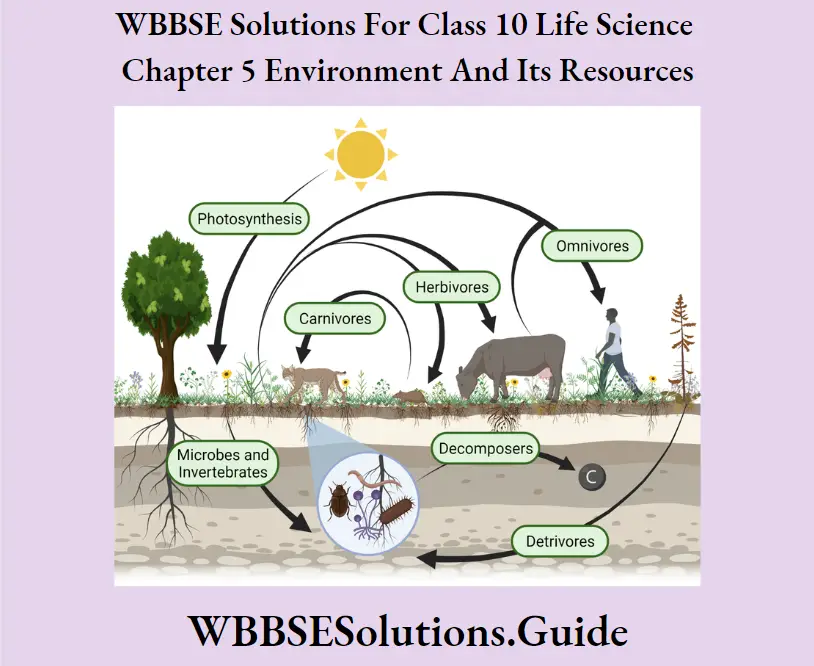
The transfer of food energy from producers to various types of consumers is called a food chain.
A large part of energy is lost as heat at each transfer of energy; only a small amount of energy is converted into biomass.
Nature of energy flow in an ecosystem
(1)Solar energy is the only source of energy flow.
(2)Energy flow is unidirectional –
The green plants utilize light energy to prepare their food. This light energy never goes back to the sun. Primary consumers get their energy from the green plants and this energy never goes back to the green plants. The same thing happens with secondary consumers and tertiary consumers.
After the death of plants and animals, decomposers decompose the dead bodies. Heat energy is liberated during decomposition. This heat energy can not be utilized by green plants and animals.
(3) Gradual decrease in the energy flow – There is a gradual decrease in the energy flow from the beginning to the end of a food chain. The primary consumers do not get all the energy obtained by the producers. A part of energy is used by the producers, another part of the energy is lost and the remaining part of the energy is stored.
Question 9. (1) Discuss the role of organisms in the removal of free carbon dioxide from the environment, (2) What is meant by nitrification? Discuss the role of bacteria in this process.
Answer:
(1) Role of organism:-
Terrestrial green plants use free carbon di-oxide of air and aquatic submerged green plants use carbon di-oxide gas which is dissolved in the water for the process of photosynthesis. Some chemosynthetic bacteria, i.e., nitrosomonas also remove free carbon dioxide from the atmosphere for the preparation of their food.
(2)Nitrification:-
The process of conversion of ammonia into nitrite and nitrite into nitrate with the help of bacteria like Nitrosomonas and Nitrobacter respectively is called nitrification.
Question 10. Discuss the significance of cyclic rotation of elements like carbon, oxygen, and nitrogen in the environment.
Answer: Significance of cyclic rotation of carbon, oxygen, and nitrogen in the environment
Importance of carbon cycle:-
(1)Carbon is an important element of organic compounds.
(2)Its simple form C02gas is a raw material for photosynthesis by which green plants prepare their foods in the form of glucose.
(3)It helps in the formation of protoplasm which is a living material,
(4)It maintains the balance of carbon in its source.
Importance of Oxygen cycle:-
(1)It is necessary for respiration.
(2)It helps living to continue their life in this universe, otherwise, in the absence of this process, the universe will become lifeless.
(3)It takes part in the formation of living material, protoplasm.
(4)We cannot imagine a living world in the absence of oxygen.
(5)It helps in combustion.
(6)The cycle of oxygen is essential for different types of organic and inorganic chemical reactions.
(7)This cycle keeps the composition of air fixed/constant.
Importance of nitrogen cycle:-
(1)Nitrogen is an essential element of some important substances like protoplasm, protein, enzymes hormones, etc.
(2)It takes part in the formation of cells, tissue, and organs.
(3)This cycle maintains the balance of nitrogen between living and non-living worlds.
Question 11. What is the main source of nitrogen in higher plants ordinarily? Where do the animals obtain this element? Mention the role of bacteria in the nitrogen cycle.
Answer:
(1) Main source of nitrogen:-
The water soluble nitrogenous compounds present within soil which are formed by the process of fixation are the source of nitrogen in higher plants.
(2)Animals obtain nitrogen from their food (ex. protein)
(3)Role of bacteria in the nitrogen cycle:-
Bacteria take an active part in the completion of the nitrogen cycle.
Different types of bacteria are involved in different stages.
(1)Fixation of atmospheric nitrogen:-
Nitrogen-fixing bacteria convert atmospheric nitrogen gas into nitrite and nitrate such as
Symbiotic bacteria — Rhizobium leguminosorium.
Free-living bacteria – Azotobacter, Clostridium.
(2)Ammonification:-
The ammonifying bacteria convert amino acids into ammonia.
Example – Bacillus-ramosus, Bacillus vulgaris.
(3)Nitrification:-
Nitrosofying bacteria convert ammonia to nitrite and nitrifying bacteria convert nitrite to nitrate.
Example – Nitrosomonas, Nitrobacter.
(4)Denitrification :-
Denitrifying bacteria convert nitrite and nitrate into free atmospheric nitrogen gas. Example – Bacillus suletilis, Bacillus denitrificans.
Question 12. Name the gas which is essential for plants but cannot be absorbed directly from the air. What is the normal percentage of that gas in the air? With the help of a diagram, briefly describe the cycle of the said gas.
Answer:
(1) Name of the gas:- Nitrogen.
(2) The normal percentage of nitrogen gas in atmospheric air is 77.17%.
(3)Process of nitrogen cycle:- The cycle of nitrogen gas is completed in the following stages
(1) Fixation of atmospheric nitrogen:-
The process of conversion of free nitrogen into nitrite and nitrate is called fixation.
This process occurs by three methods –
(1) Natural method,
(2) Chemical method,
(3) Biological method.
(1)Natural Method:-
Nitrogen gas reacts with oxygen gas to produce nitric oxide during electric discharge in the atmosphere. The electric discharge provides energy which is necessary for the reaction. Nitric oxide reacts with oxygen gas to produce nitrogen dioxide. This oxide reacts with rainwater and forms nitrous and nitric acid. These acids react with oxides of metals present in the soil to form their nitrite and nitrate respectively.
N2 + O2 = 2NO
2NO + O2 = 2NO2
2NO2 + H2O = HNO2 + HNO3
CaO + 2HNO2 = Ca(NO2)2 + H2O
CaO + 2HNO3 = Ca(NO3)2 + H2O
(2)Chemical Method:-
In the laboratory nitrogen gas is allowed to react with hydrogen gas to produce ammonia in the presence of iron powder which acts as a catalyst. Now ammonia reacts with carbon dioxide gas to produce urea.
N2 + 3H2 = 2NH3
2NH3 + CO2 = (NH2)2CO + H2O
(3)Biological Method:-
Some bacteria and algae are capable of fixing atmospheric nitrogen.
Nitrogen fixation by bacteria:-
By symbiotic bacteria:-
Rhizobium lives in the root nodules of leguminous plants like peas and gram and converts nitrogen into nitrite and nitrate. Plants use this nitrite and nitrate. Rhizobium takes glucose from the host.
By saprophytic bacteria:-
Azotobacter and Clostridium are present in soil. They convert nitrogen into nitrite and nitrate within their body. Nitrite and nitrate present in their body mix in soil after their death.
By autophytic bacteria:-
Rhodomicrobium (colored) and desulphuricans (colorless) are anaerobic and autophytic. They convert nitrogen into nitrite and nitrate.
Nitrogen fixation by algae:-
Some algae (Nostoc, Anabaena, and Calothrix) convert atmospheric free nitrogen into nitrite and nitrate.
(2)Absorption of fixed nitrogen:-
The nitrite and nitrate forms of compounds produced by the process of fixation are soluble in water. They enter into the cavity of root hairs and finally into the plant cells through absorption.
(3)Assimilation of absorbed nitrogen:-
The nitrogenous compounds are now assimilated by metabolic reactions. Various complex nitrogenous organic compounds like proteins, hormones, enzymes, etc. are formed within the plant body. Animals get nitrogen from the plant. The process of assimilation of plant nitrogenous compounds takes place in the animal body, due to which animal complex nitrogenous organic compounds are formed.
(5)Ammonification:-
Production of ammonia due to the decomposition of complex organic nitrogenous compounds present within the dead bodies of plants and animals with the help of ammonifying bacteria like Bacillus vulgaris and Bacillus ramosus is called ammonification.
Protein – Amino acid, Amino Acid – Ammonia (NH3).
(6)Nitrification:-
The conversion of ammonia into nitrite and nitrate with the help of nitrifying bacteria is called nitrification.
2NH3 + 3O2 = 2HNO2 + 2H2O + 1,30,000 K. cal. (Nitrosomanas)
2HNO2 + 02 = 2HNO3 + 35,000 K. cal. (Nitrobacter)
(7)Denitrification :-
The conversion of nitrite and nitrate present within the soil to free nitrogen gas with the help of denitrifying bacteria like Bacillus denitrificans is called denitrification.
5S + 6KNO3 + 2CaCO3 = 2K2SO4 + 2CaSO4 + 2CO2 + 2N2 + 6,60,000 cal.
Question 13. Discuss the interrelationship among the different components of the system.
Answer:
There are two main components of an ecosystem in
(1) abiotic and
(2) biotic.
Soil, minerals, water, gases, temperature, light, etc. collectively constitute the abiotic part of the ecosystem. Livings like producers, consumers, and decomposers form the biotic part of the ecosystem. Green plants convert solar energy into chemical energy during photosynthesis.
Plants take carbon dioxide and water from their outer sources for photosynthesis and form glucose as food. Oxygen gas is also liberated during this process. Heterophytic plants and all animals obtain their food from the plants. Here animals are called consumers.
Decomposers decompose the dead bodies of producers and consumers by secreting enzymes. Thus they help to return the materials to their respective sources.
There is a cyclic rotation of materials occurring in an active ecosystem and the flow of energy is unidirectional. The energy flows from producer to consumer.
Question 14. Discuss the importance of the carbon cycle, nitrogen cycle, and nitrogen cycle.
Answer:
Importance of carbon cycle:-
(1)Carbon is an important element of organic compounds.
(2)Its simple form CO2 gas is a raw material for photosynthesis by which green plants prepare their foods in the form of glucose.
(3)It helps, in the formation of protoplasm which is a living material.
(4)It maintains the balance of carbon in its source.
Importance of nitrogen cycle:-
(1)Nitrogen is an essential element of some important substances like protoplasm, protein, enzymes hormones, etc.
(2)It takes part in the formation of cells, tissues, and organs.
(3)This cycle maintains the balance of nitrogen between living and non-living worlds.
Importance of bacteria in the nitrogen cycle:-
(1)They convert atmospheric nitrogen in the form of NO2 and NO3 so that they can be absorbed by plants,
for example:- Rhizobium.
(2)They decompose the dead bodies of living organisms and change protein into ammonia, for example:- Bacillus vulgaris.
(3)They convert ammonia into nitrite, for example Nitrosomonas.
(4)They convert nitrite into nitrate, for example:- Nitrobacter.
(5)They convert nitrite and nitrate into free nitrogen, for example:- Bacillus denitrificans.
Question 15. Discuss the importance of Tiger conservation, purpose of conservation, soil conservation, water conservation
Answer:
Importance of Tiger conservation:-
(1) The tiger helps in balancing the forest ecosystem.
(2)They are conserved in national parks and zoos for the collection of foreign money.
(3)They are also conserved for recreation, for example:- circus.
Importance of purpose of conservation:-
(1)To keep the environment clean and balanced.
(2)To balance and maintain the continuity of the ecosystem.
(3)To store the nutrients and other necessities in proper quantity.
(4)To protect the living organisms from diseases.
(5)To save the living organisms from disappearance from this universe
Importance of soil conservation:-
(1)To keep the macro and micro essential elements in proper quantity.
(2)To increase the fertility of the soil.
(3)To supply nutrients to the plants for their proper growth.
(4)For the survival of the living organism, i.e., plants depend directly and animals depend indirectly on soil.
Question 16. Discuss the importance of water conservation & forest conservation.
Answer:
Importance of water conservation:-
(1)To protect living organisms from various diseases.
(2)To maintain the balance of the aquatic ecosystem.
(3)To keep water fresh and clean.
(4)To maintain the stock of water for future use.
(5)To provide a safe environment for the survival of aquatic life.
Importance of forest conservation:-
(1)To save the habitat of wild animals.
(2)To balance the forest ecosystem.
(3)For the continuity of the bio-geochemical cycle.
(4)To obtain useful substances i.e., medicine, latex, food, cloth, etc.
(5)To obtain timber for various functions such as doors, windows, tables, chairs, etc.
(6)To check soil erosion.
(7)To increase rainfall.
(8)To purify atmospheric air.
(9)To maintain the balance of O2 and CO2 in the atmosphere.
Question 17. Name a gas that can be directly absorbed by the plants from the air but cannot be absorbed directly by the animals. What is the normal percentage of that gas in the air? With the help of a diagram briefly describe the cycle of the said gas.
Answer:
(1) Name of the gas – Carbon dioxide.
(2)Normal percentage of carbon dioxide gas in air is 0.03% to 0.04%.
(3)Methods of carbon dioxide gas cycle The cycle of carbon dioxide gas is completed in the following three stages –
(1) Removal of carbon dioxide gas from its source,
(2) Assimilation of carbon dioxide gas,
(3) Returning of carbon dioxide gas to its source.
(1)Removal of carbon dioxide gas from its source:-
The autotrophs (green plants) intake carbon dioxide from their source to perform the process of photosynthesis.
(2)Assimilation of carbon dioxide gas:-
The carbon dioxide gas which is taken from the environment by autotrophic organisms is assimilated into complex organic molecules like glucose. The green plants can fix 4.9 x 1012 kg of carbon per year. The heterophytes and animals get their required carbon from the autotrophs.
(3)Returning of carbon dioxide gas to its source:-
The carbon dioxide gas returns to its source by the following methods
(1)Respiration:-
Every living organism performs the process of respiration to obtain energy. The carbon dioxide gas produced during respiration is returned to its source.
(2)Combustion:-
The carbon dioxide gas produced due to the burning of different types of fuels is returned to its source.
(3)Decomposition:-
The dead bodies of various plants and animals are decomposed by the action of decomposers. Carbon dioxide produced during decomposition due to their respiratory activity is returned to its source.
(4)Evaporation:-
The carbon dioxide gas which is dissolved in different sources of water returns to its source during the evaporation of water from these sources.
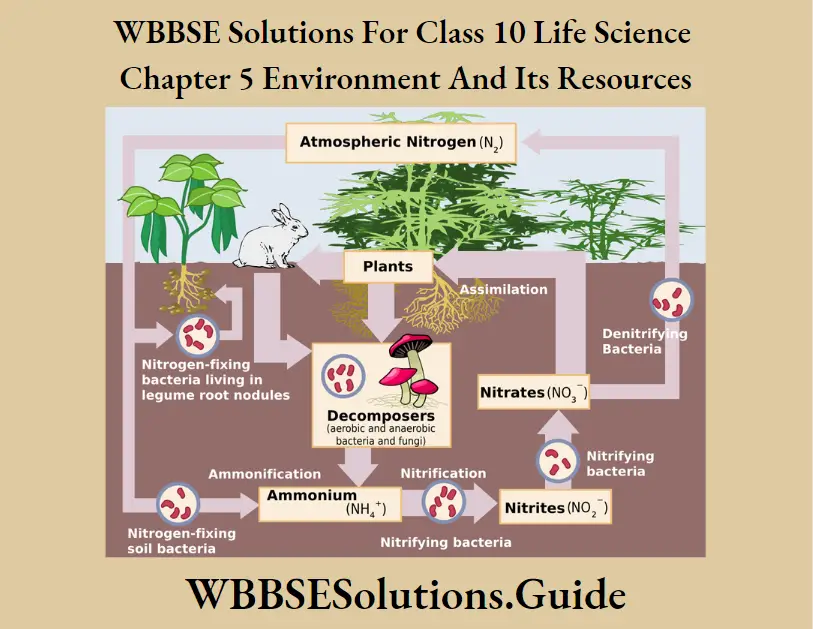
Question 18. Discuss briefly the role of Bacteria in releasing and fixing nitrogen in the environment.
Answer:
Role of Bacteria in releasing and fixing nitrogen in the environment:
Nitrogen is the most important constituent of the protoplasm of the living organism. Though the atmosphere contains as much as 77.17% elementary nitrogen, most living organisms cannot utilize this gaseous nitrogen to synthesize their protein. Some bacteria are capable of fixing the atmospheric nitrogen.
Some free-living bacteria like Clostridium, azotobacter, etc. can fix atmospheric nitrogen into nitrogenous compounds.
Symbiotic bacteria like Rhizobium live in the root nodules of leguminous plants and some symbiotic bacteria like Casuarina live in the root nodules of nonleguminous plants and can fix atmospheric nitrogen.
Some ammonifying bacteria like Bacillus ramosus, Bacillus vulgaris, etc. release ammonia from the protein of dead organisms.
Some nitrifying bacteria convert ammonia into nitrite ions. Nitrosomonas converts ammonium ions into nitrite ions and Nitrobacter converts nitrite into nitrate ions.
Some denitrifying bacteria like Bacillus denitrificans, pseudomonas, etc. convert nitrite and nitrate into atmospheric free nitrogen.
Question 19. What is the source of oxygen in atmospheric air? What is meant by ‘oxygen cycle? Describe the oxygen cycle in nature with the help of a line drawing.
Answer:
(1) Source of oxygen:-
Green plants supply oxygen gas to the atmosphere during the process of photosynthesis.
(2)Oxygen cycle:-
The process by which oxygen from its source enters into the living body, takes part in metabolic reaction, and in the last, returns to its source, is called the oxygen cycle.
(3)Methods of oxygen cycle:-
The cycle of oxygen is completed in three stages
(1)Removal of oxygen from its source:-
Respiration Every living organism takes in oxygen gas for respiration.
Combustion Some quantity of oxygen is utilized during the burning of different fuels.
(2)Taking part in metabolic reaction:-
Carbon dioxide and water are produced during respiration. Carbon dioxide comes out to the atmosphere but the oxygen atom present in water is assimilated to form complex organic molecules.
(3)Returning of oxygen to its source:-
Green plants produce oxygen gas during the process of photosynthesis. This gas comes out through the stomata of the leaves and is mixed with atmospheric air.
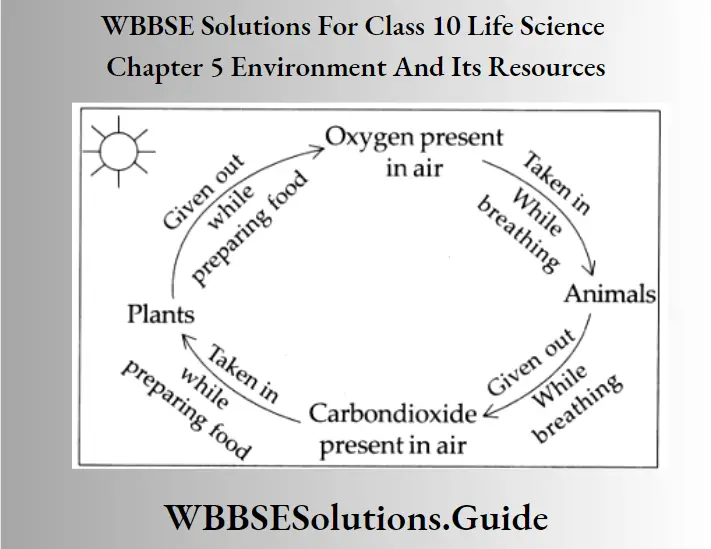
Question 20. What is an ecosystem? Explain the interrelationship among the different components of the ecosystem.
Answer:
(1) Ecosystem :
The basic structural and functional unit of ecology is called an ecosystem.
(2)Inter-relationship among the components of ecosystem :
There are two main components of an ecosystem in
(1) abiotic and
(2) biotic.
Soil, minerals, water, gases, temperature, light, etc. collectively constitute the abiotic part of the ecosystem. Living beings like, producers, consumers, and decomposers form a biotic part of the ecosystem. Green plants convert solar energy into chemical energy during photosynthesis. Plants take carbon dioxide and water from their outer sources for photosynthesis and form glucose as food.
Oxygen gas is also liberated during this process. Heterophytic plants and all animals obtain their food from the plants. Here animals are called consumers. Decomposers decompose the dead bodies of producers and consumers by secreting enzymes. Thus they help to return the materials to their respective sources.
There is a cyclic rotation of materials that occurs in an active ecosystem and the flow of energy is unidirectional. The energy flows from producer to consumer.
Question 21. What do you mean by water conservation? Mention the means of conservation of water.
Answer:
(1) Water conservation:-
The use of the proper quantity of water and to prevent the addition of harmful substances into its sources is called water conservation.
(2)Methods of water conservation:-
(1)By preventing excess cutting of trees and promoting the practice of excess tree plantation.
(2)By treating sewage and industrial wastes in water treatment plants before releasing them into rivers.
(3)By constructing dams and bunds.
(4)By preventing washing, bathing, and cleaning of animals in pond water.
(5)By forbidding testing of bombs in oceans.
(6)By checking active sedimentation in lakes, ponds, rivers, etc.
(7)By controlling the use of pesticides and insecticides.
Question 22. What do you mean by forest conservation? Mention the means of forest conservation.
Answer:
(1) Forest conservation :
To control the excessive cutting of trees for timber and set of industries and to protect it from fire and disease is called forest conservation.
(2)Means of conservation of forest:-
(1)By cutting down only matured trees.
(2)By promoting the practice of regular plantation of new sampling at specific distances.
(3)By preventing forest fires.
(4)To restrict the entrance of domestic animals.
(5)By implementing the laws formulated by the state and central government.
(6) Through mass awareness programs, people should be informed about the dangerous effects of deforestation.
(7)By protecting them from diseases and pests.
(8)By checking block cutting.
Question 23. Discuss in brief the means of conservation of tigers.
Answer:
Means of conservation of tiger:-
(1)By promulgating the laws for unnecessary killing of tigers. A person violating the law is liable to legal action.
(2)To establish National Parks, sanctuaries, Protected areas, and Reserve forests in the different parts of the country.
(3)Educate the public so that they can understand the importance of tigers in this universe. For this lectures based on the importance of tigers should be arranged in universities, colleges, and schools. To develop mass consciousness cinema shows should be arranged. Print media also may be helpful in this program.
Question 24. What are the meanings of the terms Sanctuary and Reserve Forest? Give one example of a Sanctuary in West Bengal. Mention the importance of those forests.
Answer:
(1) Sanctuary:-
A sanctuary is a protected area that is reserved for the conservation of only animals and human activities like harvesting of timbre, and collection of minor forest products, and private ownership rights are allowed so long as they do not interfere with the well-being of animals. Ex-Jaldapara, Nagarjuna sagar, Dachigam.
Reserve forest:-
It is a forest area that is protected with all its components by the India Forest Act. Entrance without permission is prohibited. Ex – Gorumara, periyar.
(2)Sanctuary in West Bengal — Jaldapara
(3)Importance of Reserve forest
(1)To save the habitat of wild animals.
(2)To balance the forest ecosystem.
(3)For the continuity of the bio-geochemical cycle.
(4)To obtain useful substances, i.e., medicine, latex, food, cloth, etc.
(5)To obtain timber for various functions such as doors, windows, tables, chairs, etc.
(6)To check soil erosion.
(7)To increase rainfall.
(8)To purify atmospheric air.
To maintain the balance of 02 and C02 in the atmosphere.
Question 25. Why is the replenishment of forests necessary? Or, What is the importance of forests in human life?
Answer:
Forest is an important natural resource that provides us with many valuable things:
(1) Atmospheric regulation:
Forest regulates 02 and CO2 balance. The CO2 content in the atmosphere is taken up by the plants during photosynthesis and O2 is released. This O2 is used by the living organisms in the process of respiration.
(2)Control soil erosion :
The branches of roots firmly bind the soil particles with the ground. The dense leaves of forests prevent raindrops from hitting the soil rich in organic matter is porous and permeable and serves as a natural filtering agent. The humus increases the adhering capacity of the soil particles and prevents soil erosion.
(3)Productive use:
Forests provide several products such as timber, fruits, seeds, cloth, furniture, medicine, building materials, papers, and one of the important sources of economy.
(4)Local use :
People living in nearby villages collect firewood from the forest. They also collect honey, timber, cotton, fur, wool, and meat and market it for money. Medicinal plants, gums, and resins were also collected from the forest.
(5)Watershed protection :
Forests help to protect an area of land that separates water flowing to different rivers or seas.
Question 26. Write the important functions of the forest.
Answer:
(1) It maintains the ratio of O2 and CO2.
(2)It provides a natural habitat for wildlife plants and animals.
(3)In maintains climatic conditions by rainfall.
(4)It prevents soil erosion.
(5)It is an important source of building materials.
(6)It is used by local inhabitants for different purposes involving food and shelter.
(7)It provides medicines, spices, honey, clothes, paper, furniture, and other useful substances.
Question 27. Name the major types of forest in the world.
Answer:
(1) Tropical rain forest
(2)Sub-tropical forest
(3)Mediterranean forest
(4)Temperate forest
(5)Coniferous forest
(6)Plantation forest
Question 28. What are the causes of deforestation?
Answer:
Causes of deforestation
(1) Population explosion
(2)Uncontrolled cutting of trees
(3)Development of road and railways
(4)Forest fires destroy trees and animal life
(5)Destruction of timber-yielding trees by fungal infection and by pest
(6) A water reservoir (dam) constructed across the stream used for generating power.
(7) Over-exploitation of land resources.
(8) Transformation of tropical rainforest to grassland.
(9)Forests are damaged by storms and snow.
Question 29. What are the consequences of deforestation?
Answer:
The consequences of deforestation
(1) Global warming – due to deforestation, the concentration of greenhouse gases (CO2) increases in the atmosphere causing global warming.
(2)Decrease in groundwater level
(3)Change in soil character and erosion
(4)Wildlife extinction – forest is a natural habitat for millions of flora and fauna. Deforestation makes them homeless.
(5)Frequent floods and droughts destroy large numbers of trees.
(6)C02 consumption and oxygen production are affected adversely.
(7)Change in climatic conditions by affecting rain.
(8) Decrease in the quality and quantity of timber.
(9)Deterioration in the quality of life of the weaker section of people living in the forest.
(10)Increasing incidents of landslides.
Question 30. Define Afforestation. Write the importance of water on earth.
Answer:
Afforestation:
Process of planting trees in an area of land to form a forest. It increases the protective and productive outputs.
Water is a vital natural resource used for various purposes.
(1)Drinking purpose:
Water that is fit for drinking is called potable water and it is essential for all living organisms.
(2)Agriculture:
Plants need water to synthesize their food. A large quantity of water is used for the irrigation of crop fields.
(3)Industry:
Water is used as raw material, solvent, and washing medium in industry. The industry is very dependent on adequate water supplies. Major water users are steel, paper, textile, chemical, and petroleum refining and they account for nearly 80 percent of industrial water demand.
Question 31. Write the uses of water for different purposes.
Answer:
Uses of water for different purposes
(1) Used in agriculture for irrigation of crops.
(2)Used for cooking, washing, bathing, cleaning, etc.
(3)Used in chemical laboratories as solvent.
(4)Used for performing various chemical reactions.
(5)Used in textile and paper industry.
(6)Water can dissolve gases like O2 and oxygen.
(7)Used in photography.
(8) Water is used in biochemical reactions and enzymatic activities.
(9)Water is used to generate electricity in hydroelectric plants.
(10) Waterways of inland streams and oceans are effective through fare.
Question 32. What is the over-utilization of water?
Answer:
Over-utilization of water
We often misuse water sources in many ways. All citizens are made aware of the proper use of water and avoid misuse of this natural resource.
During personal use, we often discard some amount of drinking water, during bathing and washing we misuse water. In some areas, tap water on streets is always open. In many areas, agricultural fields are irrigated with underground water. Wastage of water occurs in many industries.
Question 33. Define water scarcity and mention its causes.
Answer:
When the water demand is more than its occurrence, it causes scarcity.
The factors that cause scarcity of water are :
(1)due to drought – it is due to lack of rainfall for sufficient duration, severe drought, resulting in a reduction in groundwater level, and destruction of grassland and crops.
(2)due to misuse of water – improper utilization and distribution of water.
(3)Global warming – Excessive heat dries out surface water.
(4)Pollution – Disposal of sewage water in streams and lakes is a wasteful technique. So sources of fresh water are polluted and wasted.
(5)Increased human demand for water and overuse of water.
(6)Increase in human population.
(7)Lack of access to safe drinking water.
Question 34. What are the consequences of overuse of water?
Answer:
Consequences of overuse of water
(1) Reduction in agricultural productivity
(2)Extreme dryness of soil
(3)Desertification and loss of forest cover
(4)Groundwater pollution with arsenic or fluoride
(5)Gradual depletion of groundwater for drinking purposes.
(6)Affecting industrial products.
Question 35. Define water conservation. Name the various methods of water conservation.
Answer:
Conservation.
The conservation of water by proper use and save it for future use is called conservation.
To meet the water scarcity problem, water has to be conserved by the following methods:
(1)proper distribution and utilization of water
(2)proper drainage method to be implemented
(3)increase in recharging of soil with water
(4)rainwater harvesting
(5)proper maintenance of ponds and lakes
(6)avoid misuse or overuse of water in houses and industries.
Question 36. Write the steps of Rainwater Harvesting.
Answer:
Steps of Rainwater Harvesting
It is a simple and effective method of water management by which rainwater is collected, stored, and used to meet the demand for fresh water.
This form of harvesting rainfall benefits all, particularly in areas where rainfall is less.
Rooftop rainwater harvesting forms one of the best methods, a simple and low-cost technique, requiring minimum knowledge.
It consists of 3 main steps-
(1)roof surface for collection of rainwater,
(2)gutters and drain pipes are required for the transport of water from the roof to the storage reservoir,
(3)storage tanks are used to store water.
Water from the storage tank, passed through the filter, may be used as drinking water.
Question 37. What are the advantages and disadvantages of rainwater harvesting?
Answer:
Advantages:
(1) Rainwater is generally free from germs and contaminations.
(2)It is soft water with neutral PH and does not contain any salt.
(3)Rainwater does not harm water pipes and reservoirs by corrosion.
Disadvantages :
The supply of water depends on the amount of rainfall. In rooftop farms, rainwater may be contaminated with air pollutants, animal or bird droppings, insects, etc. so it needs regular cleaning and repairing.
Question 38. What are the different sources of food?
Answer:
(1) Agriculture:
The maximum quantity of food we consume is agricultural products. These include cereals, pulses, and oil seeds. Disease-resistant grains are raised and seeds are vernalised by special treatment.
(2)Horticulture :
The practice of growing flowers, fruits, and vegetables is called horticulture. Hybridization techniques and modern methods of cultivation are being used for the production of new varieties.
(3)Animal husbandry:
The breeding, feeding, and caring of domestic animals is called animal husbandry. It provides us with meat and dairy products.
(4)Fishery:
Scientific breeding and rearing of fishes. There are freshwater fishes and marine water fishes. They are rich in protein, vitamins, minerals and fats.
Question 39. What are alternative food sources?
Answer:
Alternative food sources
To meet the additional demand for food, scientists and nutrition experts have found dietary potential in some plant products, other than the common food materials.
Bacteria and fungi are used for preparing bread, alcoholic drinks, cheese, pickles, and yogurt.
Blue-green alga spirulina is used as food. Plant seeds form a good source of food for animals and humans. Animal sources of food are meat, milk, and dairy products. Honey is produced by bees and eggs by birds are used as food. Fungus used as food are mushrooms.
Yeast is used to produce yeast cake.
Some edible forms of algae are laminaria, Sargassum, and Porphyra. Chlorella is used as food. Bryophytes like mosses provided food for birds and mammals. The seeds of pinus giardiana (chilgoza) can be taken as food. Sago (sabudana) is a carbohydrate-rich matter extracted from the stem of palm trees.
Question 40. Write a note on “world food problem and its effect.”
Answer:
“World food problem and its effect.”
The United Nations report indicated that in the years 2012-2013, more than 800 million people all over the world suffered from hunger. One of the serious earliest food scarcity in the form of famine faced by the people of Bengal caused the death of many people in 1776.
The causes of world food problems are –
(1)Slow down of production of main cereal crops
(2)Damaged caused due to natural calamity •
(3)Increase in price of food.
(4)Demand of biofuel
(5)Increased population
(6)Increasing urbanization
(7)Intensive farming and irrigation system
(8) Erosion of soil.
Question 41. What are the uses of energy?
Answer:
Uses of energy
The capacity of doing work is called energy. All forms of energy are convertible.
(1)Domestic use:
In rural areas, wood, coal, and kerosene oil are utilized as sources for cooking, lighting, and other purposes. In urban areas, it is used for lighting, heating, cooling rooms, washing machines, etc.
(2)Commercial use:
Energy is used on a large scale in hotels, malls, restaurants, and shops for lighting, cooling, and other purposes.
(3)Industrial use:
Coal, oil, and natural gas are used for heating, burning, lighting, and running machines.
(4)Transport use :
Most of the vehicles in the air, water, or on the road run with petroleum products.
Question 42. What are the reasons for growing energy needs?
Answer:
Reasons for growing energy needs
The economic growth of a nation depends on energy. Just before 50 years ago, the scope of using energy was at least 10 times less than in recent days. The development of power resources in an organized manner results in the industrial development of the country.
The requirement of energy is indispensable in the fields of agriculture, transport, business, and domestic purposes. The different forms of energy in use are thermal energy, electrical energy, light energy, mechanical and chemical energy. An increase in living standards is also responsible for the increase in energy demand.
Question 43. How does the wastage of energy take place? How is energy conserved?
Answer:
Wastage of energy means, losing energy without any work. More urban use with non-stop usage, unnecessary use of vehicles, and poor road conditions are some common ways to waste energy.
Energy conservation takes place through its judicious use in the following ways –
(1)Keeping the lights and fans closed when not in use in houses & offices.
(2)Switching off the ignition of the vehicles when standing a traffic signals.
(3)Regular maintenance of machines so that power consumption may be reduced.
(4)Use of solar heater.
(5)Use of better combustion technology for fuels of the vehicles.
(6)By using renewable sources of energy.
Chapter 5 Environment And Its Resources Chart Type Questions
1. Environment And Its Resources National Parks
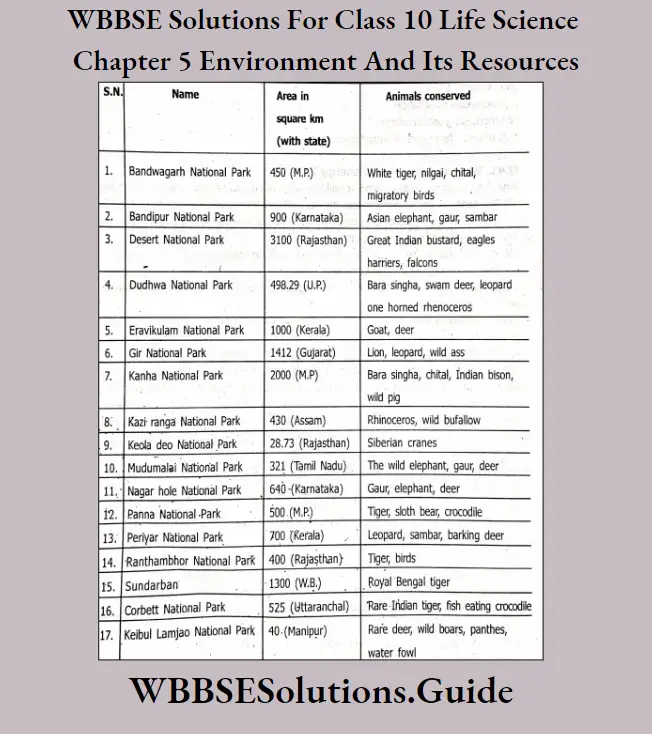
2. Environment And Its Resources Wild Life Sanctuaries
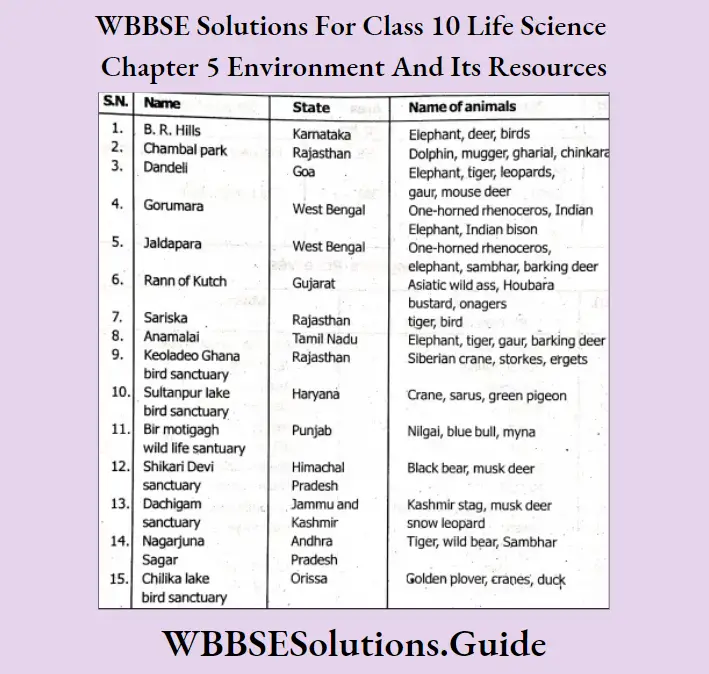
3. Environment And Its Resources Wildlife Reserves in India
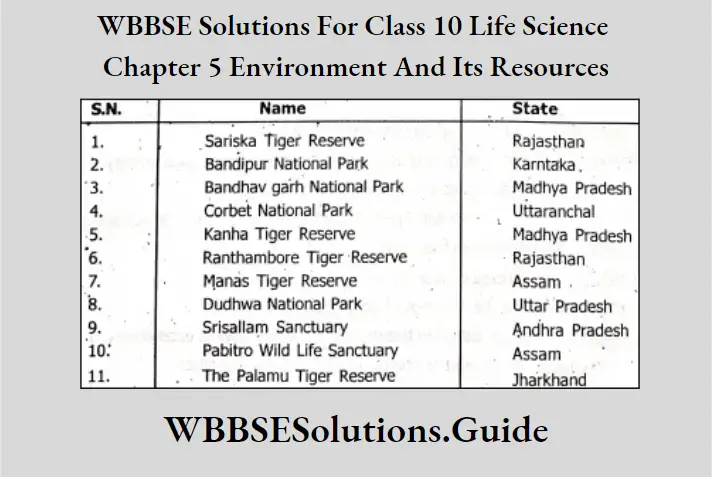
4. Environment And Its Resources Reserve Forests
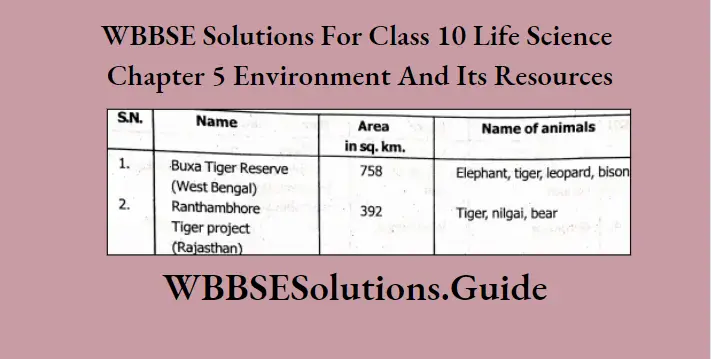
5. Environment And Its Resources Biosphere Reserves

Chapter 5 Environment And Its Resources Bio Scientist
1. In 1866 Earnest Hackel coined the term Ecology.
2. In 1927 Charles Elton stated that Ecology is the scientific natural history.
3. In 1935 A. G. Tansley gave the term Ecosystem.
4. In 1966 Odum mentioned the Abiotic and Biotic components of the ecosystem. He also defined the food chain in that year.
5. In 1972 Odum defined conservation.
6. In 1927 Elton gave the concept of an ecological pyramid.
7. In 1942 R. Lindeman denoted the model of energy flow in an ecosystem.
8. In 1993 wild classified land based on land use capabilities.
Question 1. Write a note on intraspecific and interspecific competition.
Answer:
1. Intraspecific competition :
There are two basic types of such competition—
(1)Scramble competition :
In such competition, the individuals of a community get access to resources sub-divided into small parts. Each individual obtaining a scarce amount of resources may not survive in the long run.
(2)Contest competition :
In such competition, the successful individuals of a community obtain the resources whereas the unsuccessful ones do not have any access to the resources.
An example of intraspecific competition is where resources are limited. The visiting flamingoes in South American lakes and fishes residing in the lakes compete for common Zooplankton.
2. Interspecific competition :
Competition takes place between individuals of different species of the same community for food, space, and other requirements that are limiting, each is affected by the pressure of the other. At times resources may not be limited by the feeding capacity of a species but may be reduced due to interference caused by other species.
An example of interspecific competition is where resources are not limited but the inhibitory influence of one species on another takes place.
Question 2. Classify plants and animals based on temperature control.
Answer:
Plants are divided into four categories based on their heat-tolerating capacity—
(1) Megatherms — plants that can tolerate high temperatures throughout the year for example; desert vegetation and tropical rain forests. Tropical plants require constant high temperatures for their maximum growth,
(2) Mesotherms — plants that can withstand high as well as low temperatures; for example, tropical deciduous forests, aquatic plants,
(3) Microtherms — plants growing in regions of low temperature, for example mixed coniferous forests,
(4) Hekistotherms — plants growing in regions where the temperature is very low, for example alpine vegetation. Alpine plants are adapted for short summer periods for flowering and fruiting. Plants receive energy from absorbed solar radiation and convection and they lose heat by radiation, convection, and evapotranspiration.
Based on temperature control animals are divided into three groups :
(1)Poikilothermal or Ectothermic animals or Cold-blooded animals whose body temperature changes with changes in their environmental temperature, e.g. most invertebrates.
(2)Homeothermic or Endothermic animals or Warm-blooded animals whose body temperature is independent of the temperature of their environment, e.g. birds and mammals.
(3)Heterotherms — Animals with limited power of temperature regulation respond to extreme temperatures by aestivation and hibernation, e.g. some marsupials.
Question 3. Write a note on the different types of parasites.
Answer:
Different types of parasites:
(1)Phytoparasite:
Plant parasites; for example, root nematodes, aphids, lac insects, stem borers, and wasps form galls on plants like oats, and willows. Mites from witches broom in Hackberry.
(2)Zooparasite :
Animal parasites; for example, Platyelminthes, nematodes, and arthropods.
(3)Hyperparasite:
Such parasites live on another parasite, example, Plasmodium vivax a protozoan is a hyperparasite of the female Anopheles mosquito which is a parasite of humans.
(4)Temporary parasite: Parasites like mosquitoes and bugs which suck blood from their hosts. For example, Leech (Hirudinaria) sucks the blood of cattle and man.
(5)Permanent parasite :
Entamoeba histolytica, certain platyhelminthes, nematodes, and arthropods are examples of permanent parasites.
(6)Ectoparasites:
live on the external surface of host organisms; for example, lice on humans, ticks on dogs, copepods on marine fishes, louse (Pediculus) sucks blood spreading diseases like typhus, Rat flea (Xenopsylla) — Spreads germs of plague from rat to man. Cuscuta is a rootless leafless parasite on hedge plants.
(1)Entamoeba histolytica — protozoan living in the human intestine causes amoeboic dysentery.
(2)Plasmodium vivax — a protozoan living in human blood that causes malaria.
Question 4. Define the different types of food chains with examples. What is a food web?
Answer:
Types of food chains:
There are three types of food chains — predator food chain, parasitic food chain, and saprophytic or detrital food chain.
1. Predator food chain :
A predator food chain starts from green plants and extends upto carnivores, i.e., it includes consumers only. Here the size of the living organism gradually increases, but their number gradually diminishes.
2. Parasitic food chain :
A parasitic food chain goes from larger (host) to smaller (parasite) animals.
3. A saprophytic or detrital food chain :
A saprophytic food chain goes dead organisms or organic matter into microorganisms. Such food chains are interconnected with each other to form a food web.
Examples of the food chain :
(1)Predator food chain — Grass —> Grasshopper —> Frog —> Snake —> Eagle
(2)Parasitic food chain — Plant— > Pig —> Helminth
(3)Saprophytic food chain — Dead animal —> Maggot —> Frog — Snake —> Peacock.
Food Web :
(1) Definition :
When different food chains of the same habitat are interconnected with each other to form a complicated network then the feeding relationship is known as a food web.
Question 5. Write a note on the role of animal husbandry in human welfare.
Answer:
Role of animal husbandry in human welfare :
Animal husbandry can be used to obtain a lot of benefits for mankind which are as follows —
1. Dairy products — Milk and other dairy products such as yogurt, cheese, paneer, butter, ice cream, etc. could be obtained.
2. Meat — The demand for protein is mainly covered by cattle and other animals.
3. Land management — Grazing by live stocks can be used to control the growth of weeds In the agricultural field.
4. Labour — Horses, donkeys, yaks, etc. can be used for mechanical carriers.
5. Fibre — Sheep provides fur or wool for the textile industry.
6. Fertilizer— Cow dung can be used as manure for the crop field. The blood and bones of animals are also used as fertilizer.
Question 6. Discuss the impact of light on organisms at the individual level.
Answer:
Effect of light:
(1) In green plants, chloroplasts tend to concentrate on the surface of a leaf, which gets more light,
(2) Productivity is higher in those plants that receive more and brighter light. That is why trees are more productive than submerged aquatic plants,
(3) In some plants, a span of daylight affects their growth and flowering. This phenomenon is known as Photoperiodism. Plants, such as dahlia, sugarcane, strawberry, etc. bloom in shorter daylight periods and are called Short Day Plants (SDP). The plants, such as peas, radishes, spinach, etc. bloom in longer daylight periods and are called Long Day Plants (LDP). In some plants, such as tomatoes, cucumbers, cotton, etc. daylight does not have any significant impact. These are known as Day Neutral Plants (DNP).
(4) Light enhances the pigmentation of skin,
(5) Birds and bats show circadian rhythm (daily rhythm of activities), which is controlled by light.
Question 7. Discuss the effect of temperature on organisms at the individual level.
Answer:
Effect of temperature:
(1) Plants grown in desert regions have light-colored
body hairs, acting as heat reflectors. They have fewer stomata to reduce transpiration,
(2) Plants growing in hot but humid climates of tropical regions have thick leaves to increase the rate of transpiration,
(3) In amphibians, reptiles, and fishes, body temperature varies with environmental temperature. These animals are, therefore, known as poikilothermic animals. On the other hand, birds and mammals have constant body temperature in any environment. These are known as homeothermic animals,
(4)Some animals, such as toads, house lizards, ants, etc. can withstand a wide range of temperature variations in the environment. These are called eurythermal animals. Some animals, such as fishes and other cnidarians cannot tolerate wide temperature fluctuation. These are called stenothermal animals.
Question 8. What is parasitism? Classify parasites based on their position in the host body and the duration of parasitism.
Answer:
Parasitism :
Parasitism is the most advanced type of interspecific interaction in which one species depends upon other species for food or shelter or both. Here, the dependent member (parasite) is benefited, but the helping member (host) is deprived.
Based on their position in the host body, parasites may be of two types —
(1) Ectoparasites :
These parasites draw nutrients from outside the body of the host.
Example: Louse, ticks, bedbugs.
(2) Endoparasites :
These parasites live inside the body of the host and collect nutrients from them.
Examples: Tapeworms, roundworms, Plasmodium (malarial parasite), etc.
Based on the duration of parasitism, they may be of two types —
(1) Obligatory parasites :
These species lead parasitic life throughout their life cycle.
Examples: Tapeworm, roundworm, Plasmodium, etc.
(2) Facultative parasites:
These species show parasitic behavior in certain periods of their life cycle. Example: Female mosquitoes suck blood only during egg maturation and before laying eggs.
Question 9. Write a note on the carbon cycle.
Answer:
Carbon cycle: The carbon cycle refers to the cyclic exchange of carbons in the physical and biological systems,
(1) Reservoir pool:
The carbon bed of the lithosphere acts as a reservoir pool for carbon,
(2) Cyclical pool :
Cyclical pool involves the atmosphere and the seawater
(3) Utilization of carbon from nature:
Utilization of carbon from nature involves two pathways —
(1) Biological path:
The biological path of carbon utilization involves the activities of green plants and shelled mollusks. Green plants trap carbon within cellular compounds by photosynthesis. Shelled mollusks utilize carbon of CO2 to prepare their shell,
(2) Physicochemical path:
The physicochemical path or carbon utilization involves certain marine deposits, such as limestone, dolomite, feldspar, etc. Limestone, feldspar, etc. absorb carbon (CO2) to prepare calcium carbonate (CaCO3).
(4) Return of carbon to nature :
Carbon is returned to the environment by two paths —
(1) Biological path :
All living forms (except a few anaerobes) release CO2 by respiration. CO2 is released into the nature by decomposition of organic matter. After the death of mollusks, their carbon-rich shells are decomposed to produce CO2.
(2) Physicochemical path:
Combustion of fossil fuel, wood, etc. forest fires, and volcanic eruptions produce huge quantities of CO2. This cyclic process of utilization and return of carbon to nature occurs at the same rate. This helps to maintain constant carbon content in the environment. Ecosystem, similar cyclic exchange also occurs in the case of other elements.
Question 10. How can energy be conserved in daily life?
Answer:
Energy conservation in daily life:
To meet our-future requirements, we need to conserve energy. By following the measures mentioned below, energy can be conserved to a large extent.
(1)Lighting :
Utilize maximum daylight by painting walls in a lighter shade. Keep lamps dust-free. Replace bulbs with CFL or LED lamps. Use electronic chokes instead of copper chokes.
(2)Fans :
Switch off the fan when you leave the room. Fit electronic regulators for ceiling as well as table fans.
(3)Electric iron :
Set the regulator at the appropriate position for ironing at medium heat. Use a sprayer to moisten clothes.
(4)Kitchen appliances :
Use mixers preferably for wet grinding. Do not the run machine in over or under-load conditions. Do not open the microwave oven’s door frequently to check food. Use flat bottom pans to get full contact with the heating plate of the induction oven.
(5)Gas oven:
Cook in regulated flame. Off it or simmer the flame during the preparation of food to save LPG. Use pressure cookers as much as possible. Cover the pans while cooking. Let items reach room temperature after taking them out of the refrigerator, before cooking.
(6)Water heater:
Install solar water heater replacing the electric water heater. Do not use the water heater for too long time.
(7)Electronic devices :
Switch off TV and audio systems when you leave the room for even short intervals.
(8) Computers:
Turn off the computer when not in use. Turn off the monitor during long downloading.
(9)Refrigerator:
Use star-rated energy-saver models. Keep it in moderate cooling mode. Do not keep the door open for a long time. Make sure that the door sealing pads are airtight. Set the refrigerator in such a position so that air can easily circulate the refrigerator.
(10)Washing machines :
Run in full load condition at optimum water level. Set a timer as recommended. Apply detergent in the right quantity. Avoid washing with hot water as much as possible. Prefer drying under the sun.
(9)Air conditioners:
Install energy saving star—rated sets. Select the set, with cooling capacity, as per the room size. Operate in moderate cooling mode. Fit the outdoor unit in a shady place. Clean filters regularly. Seal the doors and windows.
(10)Home:
Select heat-reflecting and light-shaded paints for the outside wall. Use film-coated reflecting glass in windows. Position the windows in the right place to maintain cross ventilation.
Question 11. Write a note on the abiotic components of an ecosystem.
Answer:
Abiotic Components:
Abiotic components of an ecosystem consist of nonliving factors.
These factors are of two types —
(a) Climatic and
(b) Edaphic.
The climatic factors contain temperature, light, wind, humidity, rainfall, and water whereas the edaphic factors include soil, topography, etc.
1. Temperature :
Temperature is such an important abiotic factor that it has a great influence on the distribution of organisms and their metabolism. Most organisms can survive in a temperature range of 10°—50°C.
2. Light:
It is another important abiotic factor. The intensity, quality, and duration of light have a great impact on the living world. Light provides energy to the producers for photosynthesis. The energy stored in the synthesized food by green plants is the source of energy for all types of consumers directly or indirectly.
3. Water:
Water, the most important abiotic factor, is very much essential! for life. Earth’s surface consists of 71% water. Water is one of the main raw materials of photosynthesis, which is the source of food for the living world.
4. Air:
The gases present in the atmosphere, mainly oxygen, carbon dioxide, and nitrogen have a great impact on living organisms. Oxygen is too much necessary for respiration. Carbon dioxide is used as a raw material for photosynthesis. Nitrogen is needed for synthesizing protein.
5. Soil:
It is the surface layer of land as well as it is an important edaphic factor of ecosystem. The distribution of plants like halophytes (in saline soils), lithophytes (in rocky soil), osteophytes (in acidic soils), psammophytes (in sandy soils), etc. is mainly influenced by the soil. Soil is the source of all the macro and microelements essential for living organisms.
6. Topography :
The distribution of plants and animals is influenced by different types of habitats like plains, hills, slopes, etc. Temperature decreases with altitude, so topography plays a major role in the distribution of plants and animals.
7. Minerals :
The distribution of microbes, plants, and animals depends upon the availability and concentration of minerals, which have an important role in the growth and development of the organisms.
Question 12. Define and classify the ecological pyramid.
Answer:
Ecological Pyramid:
1. Definition :
The graphical representation of the gradual reduction of the trophic levels of food chains, i.e., from producers to different types of consumers forms a conical shape known as an ecological pyramid. It was denoted by Elton (1927).
The first trophic level is the base and the successive trophic levels make up the upper tiers and apex.
2. Types :
Ecological pyramids are of three types —
(1) Pyramid of numbers,
(2) Pyramid of biomass and
(3) Pyramid of energy.
(1)Pyramid of numbers:
The numerical relationship among different trophic levels is represented by a pyramid of numbers. In this type of pyramid, the number of producers is highest and the number of different consumers is decreased in the successive levels of the pyramid from bases to apex.
(2)Pyramid of biomass :
The pyramid of biomass indicates the decrease or the gradual reduction in biomass at each trophic level from base to apex.
(3)Pyramid of energy :
The energy flow in an ecosystem and total energy at each trophic level of the food chain is represented by a pyramid of energy.
Question 13. Write a note on the major types of forests in the world.
Answer:
Major types of forests in the world :
1. Tropical rainforests:-
Year-round high temperatures and abundant rainfall make this a dense, lush forest. Tropical rainforests are found near the equator. They are vital storehouses of biodiversity on the planet, and yet face severe threats today, with much of their original extent depleted.
2. Sub-tropical forests:-
These are found to the sound and north of the tropical forests. The trees here are adapted to resist the summer drought.
3. Mediterranean forests:-
These forests are found to the south of the temperate regions around the coasts of the Mediterranean, California, Chile, and Western Australia. The growing season is short and almost all trees are evergreen, but mixed hardwood and softwood.
4. Temperate forests:-
Found in such places as Eastern North America, Northeastern Asia, and Western and Eastern Europe, temperate forests are a mixture of deciduous and coniferous evergreen trees. Usually, the broad-leaved hardwood trees shed leaves annually. There are well-defined seasons with a distinct winter and sufficient rainfall.
5. Coniferous forests:-
Coniferous forests inhabit the cold, windy regions around the poles. There are both hardwoods and conifers found in this region. The conifers are evergreen and structurally adapted to withstand the long drought-like conditions of the long winters, whereas the hardwoods are deciduous.
6. Montane forests:-
These are also known as cloud forests because they receive most of their precipitation from the mist or fog that comes up from the lowlands. Some of these montane woodlands and grasslands are found in high-elevation tropical and temperate zones. Plants and animals in these forests are adapted to withstand the cold, wet conditions and intense sunlight. Trees are mainly conifers.
7. Plantation forests:-
There are around 140 million hectares of “plantation forests” in the world, accounting for around 7% of global forest cover. The productivity of planted forests, in terms of supplying a sustainable volume of timber and fiber, is usually greater than natural forests.
Plantations produce around 40% of industrial wood. Both the plantation area and contribution to world wood production are projected to continue to increase in the foreseeable future.
Question 14. Discuss the stages of energy flow in an ecosystem.
Answer:
Stages of energy -flow:
Now energy flow in the ecosystem takes place in three successive stages :
(1) Acquisition of energy,
(2) Uses of energy and
(3) Unidirectional flow of energy.
1. Acquisition of energy :
The source of energy in the ecosystem is solar radiation. 12.3 x 1022 calories of solar energy reach the earth each year. Of which a major part is reflected in the space due to the presence of clouds, smoke, and dust particles.
According to German Scientist Rudolf Geiger, about 42% of solar energy is reflected in space due to the presence of clouds, dust particles, etc. in the atmosphere. 10% of the solar energy and ozone, oxygen, water vapor, carbonic acid, etc. are absorbed by the suspended solid particles in the air.
In the daytime 48% of the solar energy falls on the earth. Some of the light energy is also reflected from the surface of the earth. The remaining light energy is entrapped by the chlorophyll present in the palisade and spongy parenchymatous cells of the mesophyll tissue of the leaf where photosynthesis takes place. As a result, light energy is transformed into kinetic energy which is stored as potential energy in the carbohydrate food matter.
The primary production in the ecosystem is the production of glucose by green plants. The energy released during this time is called gross production. After respiration and other living processes the energy left behind is termed as net production or NP.
2. Uses of energy :
In an ecosystem, the producers transform solar energy into chemical energy and later in the presence of water and carbon dioxide prepare carbohydrates. These plants are taken in by animals and thus potential energy is acquired by them. Again when the secondary consumers feed on primary consumers they also acquire potential energy.
Thus when tertiary consumers take in secondary consumers, we see a similar flow of potential energy to occur. Thus the main source of energy of all animals is food. The amount of energy acquired from food is called gross energy intake and in short, denoted by the letter I.
When energy flows through the different trophic levels of an ecosystem we can see that some energy is dissipated as heat at each step which is of no use.
In the year 1942, Raymond Lindemann formulated the law called the 10 percent law. According to this law, about 10% of total energy is transmitted during energy flow through several trophic levels. That is why we notice a diminution in the amount of energy. Energy used up by a body to function properly is called respiratory energy (R).
For example, about 100 kg of organic food present in the grass, will make 100|10 kg. or
10 kg. biomass in the case of herbivorous animals, and of about — kg. i.e. 1 kg biomass in case of carnivores. According to Lindemann’s 10% law, in a grassland ecosystem about 100 kg of grass would increase 10 kg of flesh in the body of a deer. If this deer is taken in by a tiger its flesh would help in increasing 1 kg of flesh in the body of the tiger. Thus a gradual diminution of energy is noticed.
The formed energy is spent in digestion, metabolism, and performing other physiological functions by an animal. Some energy is also liberated as heat and thus lost to the surroundings.
3. Energy flow is unidirectional:
Producers obtain their light energy from the solar energy. This light energy once entrapped by the chlorophyll cannot retrace its path but is given out to surroundingsding. Thus, along the trophic level energy gets transmitted step by step but once given out it cannot follow its way back. Thus the energy flow is unidirectional.
WBBSE Solutions For Class 10 Life Science Chapter 4 Biology And Human Welfare Short Answer Questions
You can download the class 10 WBBSE Life Science book pdf from wbbsesolutions.guide
Chapter 4 Biology And Human Welfare Short Answer Questions
Question 1. What do you mean by biocontrol?
Answer: Using bacteria, viruses and some protozoa to control the pest naturally is called biocontrol.
Question 2. What are microphones?
Answer: Bacteria like Bacillus polymyxa, and Pseudomonas species of Aspergillus have the power to release phosphate from bound form and remain unable to be in dissolve states are called microphones.
Question 3. Name two free-living N, fixing bacteria.
Answer: Azotobactor and Bacillus polymyxa.
Read and Learn more about WBBSE Solutions for Class 10 Life Science And Environment
Question 4. Name two cyanobacteria.
Answer: Nostoc and Anabaena.
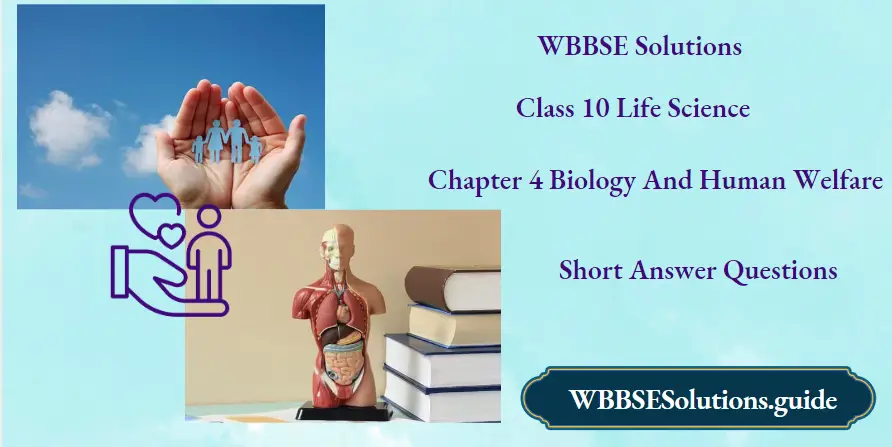
Question 5. What is mycorrhiza?
Answer: Symbiotic association of some fungi with roots of seed-bearing plants.
Question 6. Name one symbiotic bacterium.
Answer: Rhizobium leguminosarium.
Wbbse Class 10 Life Science Solutions
Question 7. Where from azotobactrine produced?
Answer: from the bacterium Azotobactor.
Question 8. What is meant by immunity?
Answer: The ability of the human body to resist almost all types of pathogenic microbes, toxins and other antigens.
Question 9. Name the parasites responsible for causing different types of human malaria.
Answer: Plasmodium vivex, Plasmodium falciparum, Plasmodium malariae, Plasmodium ovale.
Question 10. What are AIDS-related complexes?
Answer: AIDS-related complex is the most serious form of AIDS and is characterised by swollen lymph nodes, night sweats, fever and loss of weight.
Question 11. Name the pathogen of pneumonia.
Answer: Pneumonia is mainly caused by a diplococcus bacterium.
Question 12. What is allergy?
Answer: Allergy can be defined as an appropriate and excessive immune response of a person to some harmless common environmental substances, which come in contact with or enter the body.
Wbbse Class 10 Life Science Solutions
Question 13. Expand AIDS and HIV.
Answer: Acquired Immuno Deficiency Syndrome. Caused by a virus known as Human Immuno Deficiency Virus. There are three species of HIV which infect human beings: HIV-1, HIV-2 and HIV-3.
Question 14. Who is the “Father of Immunology”?
Answer: Louis Pasteur. He coined the term vaccination.
Question 15. What is interferon?
Answer: A small protein produced by vertebrate cells either naturally or in response to viral infection, which is capable of inhibiting viral multiplication.
Question 16. Which kind of Ig is most abundant in blood?
Answer: Ig G
Question 17. What is the chemical nature of antibodies?
Answer: Glycoprotein.
Question 18. What kind of immunity is achieved by vaccination?
Answer: Artificial active immunity.
Question 19. What is a booster dose of vaccination?
Answer: It is a subsequent dose of vaccine given after the primary dose to develop the effective and high level of antibody in blood for long-lasting immunity.
Question 20. Who discovered that the female anopheles mosquito is the vector of Plasmodium?
Answer: Sir Ronald Ross.
Question 21. Why male mosquitoes can not transmit malaria?
Answer: Because their mouth parts are not adopted for piercing human skin and bloodsucking.
Question 22. Who first coined the term antibiotics?
Answer: Selman Waksman in 1942.
Question 23. Name four products produced due to the fermentation of yeast.
Answer: Ethyl alcohol, Butyl alcohol, Acetaldehyde and phenyl ethanol.
Wbbse Class 10 Life Science Solutions
Question 24. What are probiotics?
Answer: When fermented milk products, idli, and dosa are taken in our body then they produce a special kind of microbes within the digestive system of human beings called probiotics.
Question 25. What is rennet?
Answer: From the stomach of the calf rennet is extracted which contains an enzyme renin used in cheese making.
Question 26. What is BOD?
Answer: Biological Oxygen Demand. The amount of biodegradable organics present in water is not measured directly but measured in terms of the requirement of oxygen of the microbial degradation process at 20°C, which is called Biological Oxygen Demand.
Question 27. What is biological control?
Answer: A natural method of pathogen and pest control in which bacteria, viruses and other insects like agents take part is called biological control.
Question 28. What is leg haemoglobin?
Answer: Within the root nodules of leguminous plants lies a haemoglobin-like compound called leg haemoglobin. It facilitates the diffusion of oxygen to the very rapidly respiring nitrogen-fixing symbiotic bacteria within the root nodule cells.
Question 29. Which type of blue-green algae is associated symbiotically with Azolla?
Answer: Anabena azolla.
Question 30. Which disease is known as “break-bone fever”?
Answer: Dengue.
Question 31. Expand OPV, BCG, DPT, WASH, MMR AND UNICEF.
Answer:
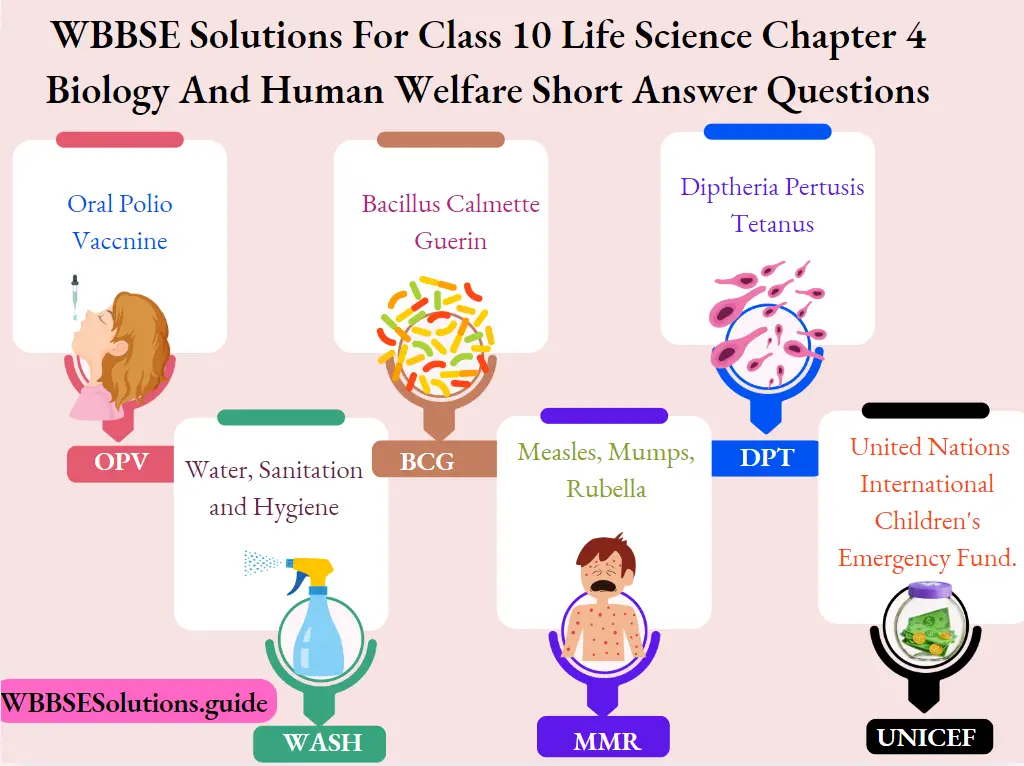
Question 32. What is vaccination? Give one example of the vaccine.
Answer: The process by which weak or dead pathogens are injected into the body to produce immunity against infectious disease by producing antibodies is called vaccination.
The principle of immunisation or vaccination is based on the property of ‘memory, of the immune system.
Question 33. What is immunisation? What do you mean by natural immunity and artificial immunity?
Answer:
Active immunity:
When a person is exposed to an antigen, the lymphocyte of his own body produces antibodies. This is called active immunity.
Passive immunity:
When pre-formed or ready-made antibodies are directly given to a person to protect the body, it is called passive immunity.
Question 34. Briefly describe the structure of the antibody.
Answer: Chemically antibody molecules are proteins in nature like globulins of blood plasma. So these molecules are also known as immunoglobulins (Ig). An immunoglobulin molecule is a ‘Y’ – shaped structure. Each molecule has specific antigen-binding sites by which it attaches with a specific antigen to inactivate it.
Wbbse Class 10 Life Science Solutions
Question 35. State the purpose of the WASH program.
Answer:
One objective:
The overall objective of UNICEF in the area of water, sanitation and hygiene (WASH) is to contribute to the realization of children’s rights to survival and development through the promotion of the sector and support to national programmes that increase equitable and sustainable access to, and use of, safe water and basis sanitation services, and promote improved hygiene.
Question 36. State two points of importance of biofertilizers.
Answer:
(1) The yield of plants can be increased by 15% – 35% by the application of biofertilizers.
(2) The inoculum which has to be applied in the field can be prepared by the farmers themselves.
Question 37. What are microphones?
Answer: Some bacteria like Bacillus polymyxa, Pseudomonas striata, and species of Aspergillus have the power to release phosphate from bound or immobile form and remain unable to be in dissolved states. These biofertilizers are called microphos.
Chapter 4 Biology And Human Welfare Descriptive Type Questions And Answers
Question 1. Define Immunity.
Answer:
Immunity:
Immunity means the body’s defence against disease. The body has numerous methods of preventing and curing infections. The defence system in our body works at two levels-
1. Local Defence System:
It tackles the germs in their possible points of entry. It includes a protective mechanical barrier, germ-killing secretion and germ-fighting WBC.
2. Immune System:
It deals with the germs after they have entered into the body tissue.
Immunity may be defined as the “Capacity of our body to deal with foreign substances that enter our body and to render them harmless”.
Wbbse Class 10 Life Science Solutions
Question 2. Classify immunity.
Answer:
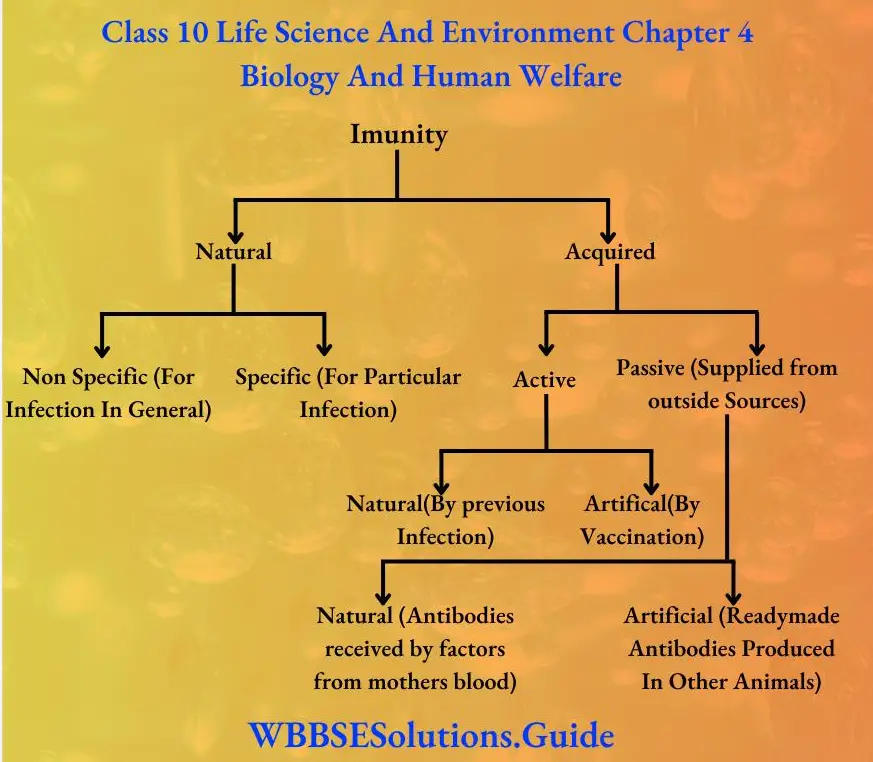
Question 3. Differentiate between Active and Passive Immunity.
Answer:
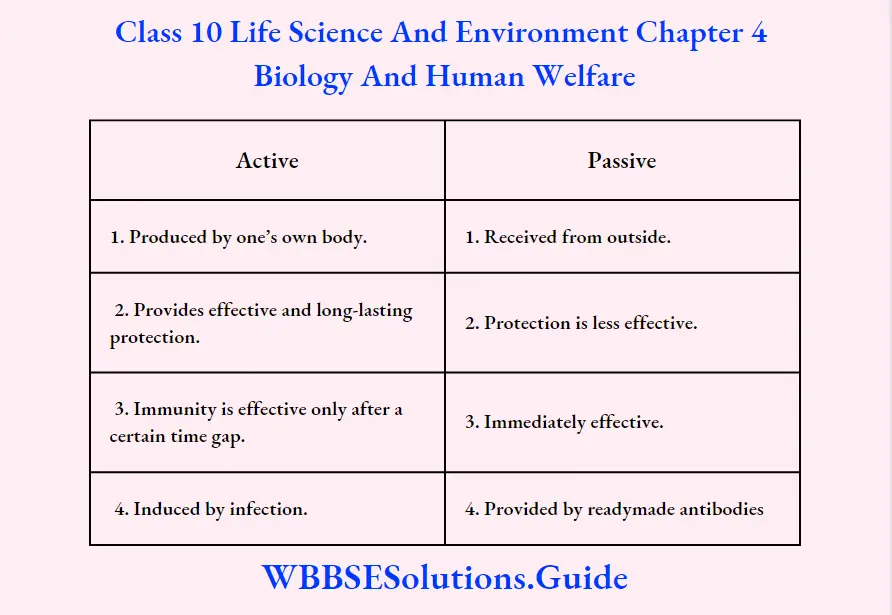
Question 4. Difference between antigen and antibody.
Answer:
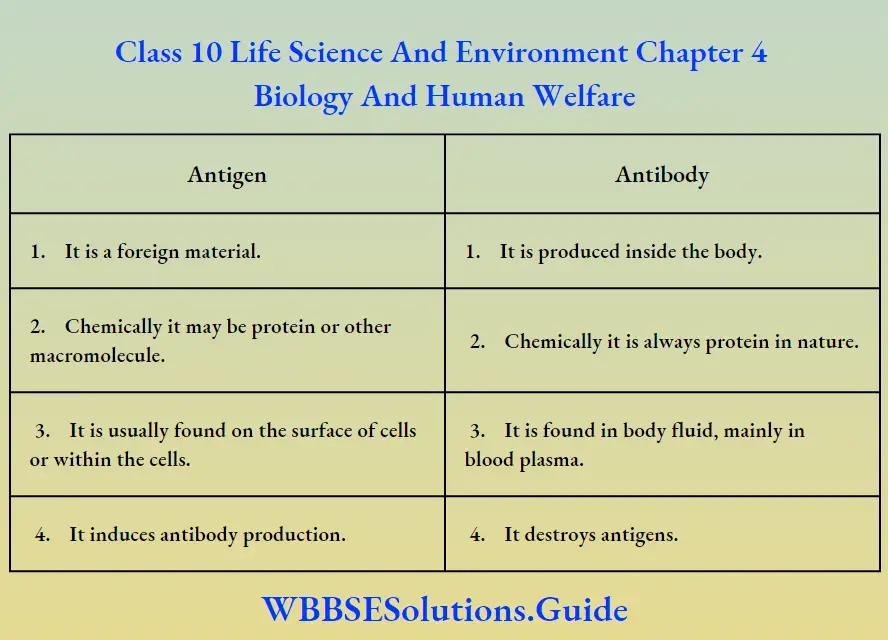
Question 5. What are antigens and antibodies?
Answer:
Antigen:
These are foreign substances which, on entering into the body evoke an immune response and are responsible for specific reactions with the antibodies. Since the antigens induce immune responses, they are also called immunogens.
Antigenes are usually found on the cell surface of pathogenic microbes. They enter into the body through food, beverages and air.
Antibodies:
These are special chemicals found in the blood which act against the germs. These are proteins and are produced on exposure to antigens. These are specific, which means that one kind of antibody acts against only one particular type of antigen.
Wbbse 10th Class Life Science Question Answer
Question 6. Draw the National Immunisation Schedule.
Answer:
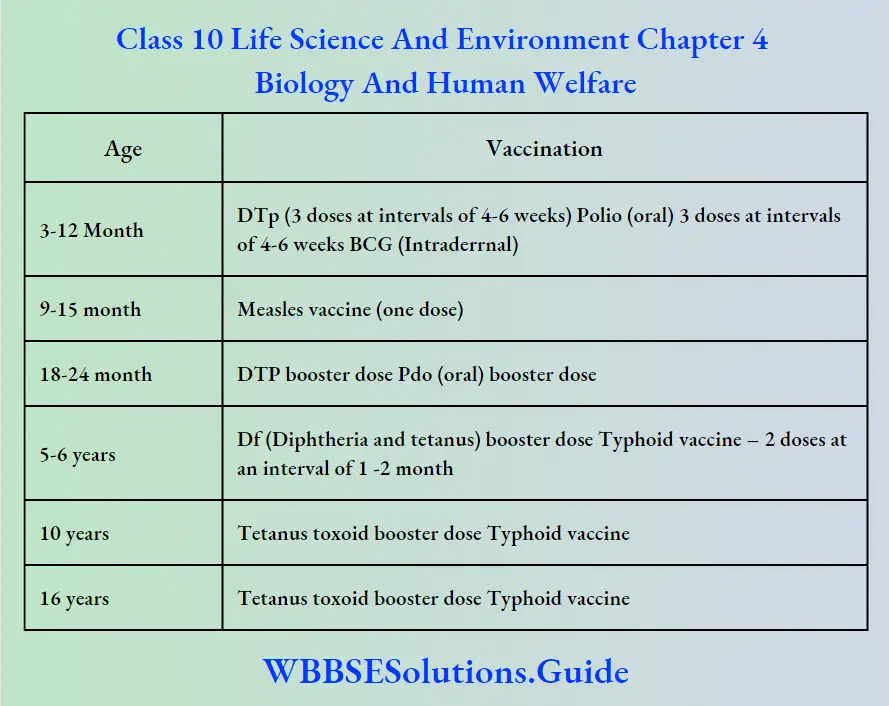
Question 7. How do microbes help us in our everyday life?
Answer:
Biocontrol agents:
The use of microbes to control pathogenic pests is termed as biological control.
(1) Bacteria:
(1) bacteria like Bacillus thuringiensis (Bt) can be utilised to control butterflies, caterpillar which act as microbial biocontrol agents. These Bt toxin genes when introduced into cotton plants, such plant get the power to resist the attack of insect pests.
(2) Ladybird beetles provided with red and black markings live by eating aphids.
(3) Bs toxin may be transferred to aquatic cyano-bacteria that kill the mosquito larva.
(2) Virus:
Baculovirus, a group of viruses, can destroy sawflies, mosquito larva stem borers, etc. The bacteriophage virus can destroy salmonella bacteria from water bodies.
(3) Protozoa:
Nosema sp. are protozoa microbes that directly penetrate the epithelium of insect gut and kill them. Metlasia grandis effectively control cotton ball weevil.
(4) Fungi :
The free-living fungus Trichoderma influences some plant pathogens as a biocontrol agent. Cordyceps is pathogenic to plant pathogenic nematodes. Use of microbes as biofertilizers: Microorganisms like bacteria, cyanobacteria and fungi when added to the soil, enrich the soil nutrients due to their biological activity and thereby increase the nitrogen content of the soil biofertilizer.
Free-living bacteria like Azotobactor and Clostridium and symbiotic bacteria like Rhizobium enrich the soil with nitrogen. Pseudomonas convert complex organic phosphate to simpler soluble inorganic phosphate which are easily utilized by plants. These biofertilizers are called microphos.
Rhizobium leguminosarium can fix nitrogen in peaplant. Rhizobium phaseoli can fix nitrogen in beans. Rhizonbium Japanicum can fix nitrogen in soybean.
Nostoc and Anabena are free-living cyanobacteria that act as biofertilizers in paddy fields.
Mycorrhiza :
The symbiotic association of some fungi with the roots of seed-bearing plants is called mycorrhiza. In this association, the fungi develop hyphae around the rood tip. They increase the life span of the roots of plants by providing food to them. They play an important role by absorbing selective elements.
Wbbse 10th Class Life Science Question Answer
Question 8. What are the concepts and components of WASH? Write its significance in eliminating disease burden.
Answer:
The concepts and components of WASH
WASH stands for water, sanitation and hygiene. Programm UNICEF (United Nations International Children Emergency Fund) has developed a global strategy to lift the standard of health of school children by providing them with adequate safe drinking water, proper sanitation and a sense of hygiene. This programme is popularly known as WASH. Besides providing water and sanitation facilities in school, children are made aware of the importance of washing hands before taking food. This can reduce waterborne disease.
According to UNICEF, there are three main components-
(1) To enable a child-friendly environment in the school.
(2) To improve hygiene behaviour among the students
(3) To build infrastructure for water supply and sanitation services.
Question 9. Define antigens. Write the chemical nature of antigens.
Answer:
Antigens
Antigens are foreign proteins which initiate immune response after entering the body and are capable of the production of specific antibodies from B-lymphocytes and interaction with the antibodies.
Chemical nature:
Antigens are large and complex molecules. Most often they are proteins. Nucleic acid, lipoprotein, glycoprotein and certain large polysaccharides may also act as antigens.
Question 10. What are epitopes? What are antibodies? Write the chemical nature of antibodies.
Answer:
Epitopes:
The specific portion of an antigen which is recognised by B and T- Lymphocytes of the immune system and to which an antibody binds is called epitopes. The epitopes are variously shaped, structurally distinct regions located on the surface of an antigen molecule. The sequence of amino acids in an epitope determines its shape.
Antibodies:
An antibody is a protein produced in the body in response to the entry of an antigen and is capable of reacting specifically with the same antigen to inactivate it. Thus antigens are antibody generators and antibodies are antigen destroyers.
Antibodies are also called immunoglobulins (Igs). The basic structure of the antibody molecule consists of four polypeptide chains. There are two long chains called heavy chains and two short chains called light chains. The four chains are held together by a disulphide bond forming a ‘Y’ shaped molecule. The Ig molecule has a constant part and a variable part. The variable part is located at the top of two arms of the Y and it contains the antigen binding site and forms an antigen-antibody complex. As a result of this antigen-containing micro-organisms are destroyed.
Question 11. Name some common diseases in humans. Mention their causative organism and symptoms.
Answer:
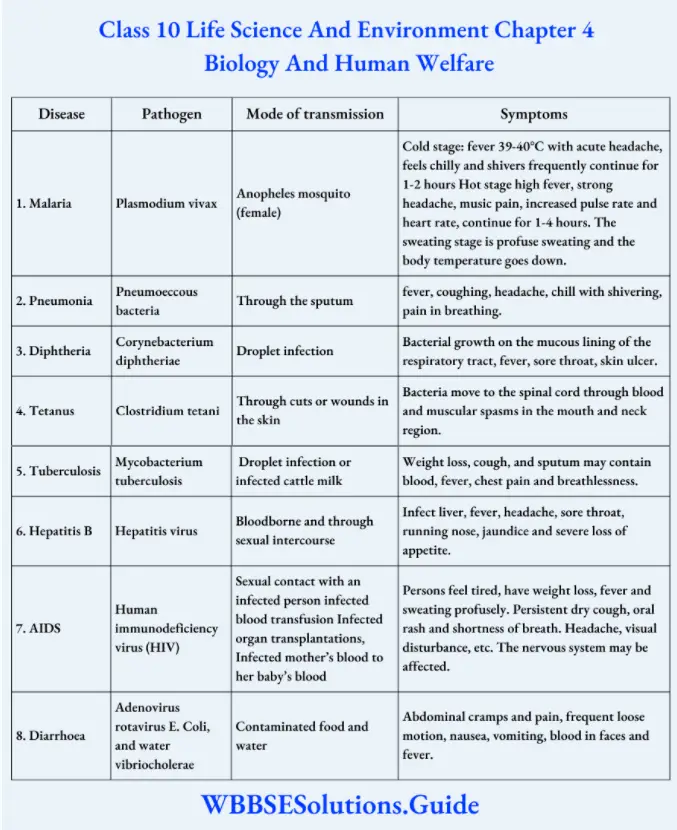
Question 12. What is vaccination? Name the different types of vaccines.
Answer:
Vaccination:
Vaccination is the introduction of any kind of dead or weakened germs into the body of a living being to develop immunity against the respective diseases.
Different types of vaccine:
A vaccine may be the preparation of any one of the following four categories:
(1) Killed germs:
As the TAB vaccine for typhoid
Salk’s vaccine for poliomyelitis
Rabies vaccine for dog bite
(2) Living weakened germs:
As the vaccine for measles BCG vaccine for tuberculosis.
(3) Living fully virulent germs:
As for smallpox. In this vaccination, a person is inoculated with cowpox virus which is very similar to smallpox virus.
(4) Toxoids:
As for diphtheria and tetanus. The toxoids are extracts of toxin secreted by bacteria and these poison are made harmless by the addition of formalin. Such extracts are called toxoids.
Question 13. Name the different types of antibodies with their location and functions.
Answer:
Based on their physical, chemical and physiological nature, antibodies are grouped into five categories –
IgA: Found in body secretion like saliva, tears, milk etc. It provides a primary defence mechanism against local inflexion.
IgD: Found mainly on the plasma membrane of lymphocytes. It acts as an antigen receptor. It is effective against toxins and allergens.
IgE: It is located on mast cells and basophils. It protects against parasitic worms.
IgM: It is found in blood and lymph. It is the largest immunoglobulin. It helps to body defence.
IgG: It is found in blood, lymph and intestine. It protects the body against bacteria and viruses by phagocytosis.
Question 14. Define Vaccine and Vaccination.
Answer:
Vaccine and Vaccination
A vaccine is a suspension of antigenic material used for the prevention of an infectious disease. It contains live but weakened micro-organisms or killed micro-organisms. Vaccination is the introduction of any kind of dead or weakened germs into the body of a living being to develop immunity against the disease.
Wbbse 10th Class Life Science Question Answer
Question 15. How microbes are related to human welfare?
Answer:
Microbes like bacteria and fungi grow in the media rich with nutrients forming calories.
They help in human welfare in the following ways
(1) In industrial food processing like preparation of dairy products, dough, single cell protein which serve as a source of modern food etc.
(2) Beverages obtained due to fermentation by yeast.
(3) Bacteria and fungi are used in the preparation of antibiotics. Antibiotics are chemical substances liberated from some microorganisms which inhibit the perfect growth and proper development of other microorganisms.
(4) Several organic acids are produced by the microbes as industrial products.
eg. acetic acid and lactic acid.
(5) Certain microbes are used in Sewage treatment. Wastewater and excrement are carried away in sewers.
Eg. Methanogen bacteria
(6) Microbes help in energy generation. Biogas is used as an excellent fuel produced due to the anaerobic breakdown of biomass by the use of methanobacterium.
Question 16. Write about the importance of microbes in agriculture.
Answer:
(1) Microbes as fertilizers:
Micro-organisms like bacteria, cyanobacteria and fungi when added to the soil, enrich the soil nutrients due to their biological activity and thereby increase the nitrogen content of the soil called biofertilizers.
(2) Microbes as biocontrol agents:
The use of bacteria, viruses and other insect-like agents to control pests and pathogens in the natural method is called biocontrol Bacillus thuringiensis (Bt), is a bacterial species that has the power to kill different insect pests.
Question 17. State the importance of lymphocytes.
Answer:
Role of Lymphocyte:
(1) Large lymphocytes are immature. During maturation large lymphocyte gradually loses cytoplasm and becomes a small lymphocyte which is matured.
(2) Small lymphocytes can be of two types – B-lymphocyte and T-lymphocyte. B- B-lymphocyte is produced and matured in bone marrow, whereas T-lymphocyte is produced in bone marrow but matured in the Thymus gland.
(3) When the B-lymphocyte is stimulated by an antigen, it produces a specific antibody. This is called humoral immunity.
(4) T-lymphocyte recognises the antigen or part of antigen. This is known as cellular immunity.
(5) T-lymphocyte stimulates B-lymphocyte to form antibodies.
question 18. Define the different types of immunity with examples.
Answer:
1. Inherited Immunity (Innate Immunity):
This immunity is present at the time of birth, e.g. Different types of WBC are present in the blood of a newborn body. These WBCs will protect the body against antigens as soon as it is exposed to air outside the mother’s body immediately after birth.
2. Acquired Immunity:
The type of immunity which is acquired by a person during his lifetime is called acquired immunity.
3. Active immunity:
When a person is exposed to an antigen, the lymphocyte of his own body produces antibodies. This is called active immunity.
4. Passive immunity:
When performed or readymade antibodies are directly given to a person to protect the body, it is called passive immunity.
Wbbse 10th Class Life Science Question Answer
Examples:
(1) Acquired active natural immunity- Once someone suffers from pox, generally pox virus cannot attack him any more.
(2) Acquired active artificial – Vaccination and stimulation of lymphocytes to produce antibodies, e.g. Injection of cholera vaccine.
(3) Acquired passive natural – Mother’s IgA enters the body of the baby along with milk; the mother’s IgG enters the foetus through the placenta.
(4) Acquired passive artificial-performed antibody (antivenom) from a rabbit or horse may be injected into a snake bite patient.
Question 19. How do vaccines work in our body? State the use of vaccine.
Answer:
Vaccines “teach” our body how to defend itself when germs, such as viruses or bacteria, etc. invade the body. The steps are –
(1) The body is exposed to a very small, very safe amount of virus or bacteria that have been weakened or killed.
(2) Our immune system then learns to recognize and attack the infection, if our body is exposed to that infection later in life.
(3) As a result, our body will not become ill or we may have a milder infection. This is a natural way to deal with infectious diseases.
Uses of vaccination:
A vaccinated person develops immunity against diseases like Mumps, Tuberculosis (TB), abies (causing hydrophobia), Polio, Cholera, Measles, Tetanus, Typhoid, Smallpox, and so on when vaccines for those diseases are injected into their body.
Question 20. State the historical development of vaccines.
Answer:
Historical perspective:
Edward Jenner and Vaccination :
For many centuries, smallpox devastated mankind. In modern times, we don’t have to worry about smallpox. We are grateful for the remarkable work of Edward Jenner. With the rapid advancement of vaccination, the historic origin of immunisation is often forgotten.
Edward Jenner (17 May 1749-26 January 1823) was a British physician and scientist who was a pioneer of smallpox vaccine, the world’s first vaccine. He is often called as “the father of Immunology”. It is said that “Jenner’s work saved more lives than the work of any other human.”
Jenner observed that milkmaids were generally immune to smallpox. Cowpox is a disease in cows, similar to smallpox, but much less virulent. Jenner noticed that cows suffering from cowpox form blisters from where pus comes out. While handling the cow, milkmaids received this pus from a cow. This cowpus protected the milkmaids from smallpox. Jenner collected this pus from cows and also from cowpox blisters on the hands of milkmaids. He then inoculated the material to different persons who developed immunity against smallpox and did not suffer from smallpox any more.
Jenner’s discovery was accepted and vaccination was recognised in 1840 by the British Government.
Question 21. Write a short note on nitrogen-fixing bacteria.
Answer:
Nitrogen-fixing bacteria
Symbiotic nitrogen-fixing bacteria: Hellriegel and Wilfarth (1888) showed that the leguminous plants with root nodules were able to increase the percentage of nitrogen in the soil. Within the root nodules reside a type of bacterium. He suggested that there lies a symbiotic relationship between the nodule bacteria and the host plant. That symbiotic bacterium was named Bacillus radicicola by Beijerinck (1888). Later on, it was renamed Rhizobium leguminosarium by Frank (1890).
The gram-negative, rod-shaped bacterium Rhizobium enters from the soil as infection threads into the roots of Leguminous plants, where due to the influence of certain substances like biotin or amino acid, enzymes, sugars and vitamins, may cause the root cells to divide forming root nodules. Certain growth substances like Indole Acetic Acid (IAA) secreted by the bacteria cause root hairs to curl.
Symbiotic nitrogen-fixing bacteria Rhizobium leguminosarium is residing in the root nodules of leguminous plants and converts nitrogen of air to soluble nitrates. Nitrates are used by host plants which results in increased growth and yield. With the death of host plants, root nodules release bacteria as well as nitrates into the soil whereby increases the fertility of the soil. Symbiotic bacteria Rhizobium fixes atmospheric nitrogen in the presence of a pigment called leghaemoglobin.
Within the root nodules of leguminous plants lies a haemoglobin-like compound called leghaemoglobin (LHb)- the only haemoglobin-like protein found to be present in higher plants. It facilitates the diffusion of oxygen (O2) to the very rapidly respiring nitrogen-fixing symbiotic bacteroids within the root nodule cells, thereby stimulating ATP production. The addition of phosphate fertiliser increases the efficiency of nitrogen fixation and in turn, increases crop yield.
Frankia, a nitrogen-fixing mycelial bacterium under Actinomycetes, is associated symbiotically with the root nodules of several non-leguminous plants Casuarina, Myrica, Rubus, Alnus, etc.
Question 22. State the importance of biofertilizers.
Answer:
Some points of importance of biofertilizers are stated as follows:
(1) The yield of plants can be increased by 15% – 35% by the application of biofertilizers.
(2) The inoculum which has to be applied in the field can be prepared by the farmers themselves.
(3) The soil texture was improved by the biofertilizers.
(4) In semi-arid conditions biofertilizers are also effective, giving a good result.
(5) They disallow pathogens to grow vigorously.
(6) Some vitamins and growth-promoting biochemicals can also be produced by
them.
Question 23. What is mycorrhiza? Explain the two types of mycorrhiza.
Answer:
(1) Mycorrhiza :
The symbiotic association of some fungi with the roots of seed-bearing plants is called mycorrhiza.
(2) Types of Mycorrhiza: Two types –
1. Ectotrophic mycorrhiza or Ectomycorrhiza :
In this case, the fungus lives outside the tissues of the root of Pine, Oak, Eucalyptus, Alunus, Betula, etc. The fungus replacing the normal root hairs of the plants forms a covering or mantle outside the roots of trees. This mantle increases the surface area of absorption, thereby increasing the uptake of water and mineral nutrients and in turn, increases plant vigour, growth and yield.
This mycorrhiza absorbs and stores nitrogen, phosphorus, potassium, and calcium in its fungal mantle. Simpler organic molecules are formed from complex organic molecules by them. They also convert insoluble organic compounds into soluble and easily absorbable forms. A network is formed when the fungal hyphae penetrate the intercellular spaces of the cortex of the root to form finally a net-like structure. This is called Hartig net.
2. Endotrophic mycorrhiza or Endomycorrhiza :
When a fungus lives inside the root cortex and does not form a mantle on the surface of the root, this mycorrhizal association is called endotrophic mycorrhiza. These associations are found in herbaceous species like orchids and some woody plants. Here fungus produces loosely interwoven hyphae, some of which penetrate the soil while others grow on the root cortex.
In the cortex, some hyphae grow in between the cortical cells, while some penetrate the cortical cells forming swollen vesicles or finely branched hyphal masses called arbuscles. This fungal association is called vesicular-arbuscular mycorrhiza (VAM). Mycorrhizal association is noted in the root of legumes, cereals, tobacco, soybean and many orchids like Vanilla, Neottia, etc.
Question 24. State the importance of mycorrhizas in plants.
Answer:
Importance of Mycorrhizas about plants:
(1) They increase the life span of the roots of plants by providing food to them.
(2) They increase the surface area of roots of host plants by mantle formation.
(3) Fungus spread their mycelia into the soil from where they absorb different kinds of nutrients causing increased growth of the plant.
(4) Mycorrhizas play an important role by absorbing selective elements like Ca, K, Fe, Br, Cl, S and N which move easily and also elements which do not move like Zn, Cl, P.
(5) Some of the mycorrhizas produce metabolites which can change the power of plants to develop roots from wood plant cuttings. They enhance better development of roots during vegetative propagation.
(6) The resistance power of plants also increases. They make less effect of pathogens and pests on host plant health so that they become free from illness.
Question 25. Define antigens and antibodies with examples.
Answer:
Antigen and Antibody:
The natural defence system of our body involves two substances
(1) antigen and
(2) antibody.
Antigen:
The foreign substances (pathogens & toxins), which on entering our body activate the body’s immune system to produce specific antibodies are called antigens. Antigens are also called attackers.
Examples of antigens:
(1) Antigens mainly include simple or conjugated proteins (glycoproteins, lipoproteins, nucleoproteins, etc.), present on the surfaces of viruses, bacteria, fungal spores, etc.
(2) Chemicals synthesized in the cells of pathogens may act as antigens.
(3) New proteins produced by cancer cells or virus-infected cells are antigenic.
(4) Toxic chemicals like snake venom and insect venom are also antigens.
Antibody:
The defensive protein molecule which is produced in the body in response to a specific antigen to inactivate it, is called an antibody.
Question 26. What is an immune response? Classify it.
Answer:
Immune response:
The formation of antibodies in response to a specific antigen in the body is known as the immune response. It is a complex process, which is discussed below.
Types of immune response:
Immune response is a combination of two types of responses-
(1) cell-mediated response and
(2) humoral response.
Cell-mediated response :
As soon as the antigen enters into the body, T- T-lymphocytes or T-cells quickly proliferate in the thymus (‘T’ here indicates thymus). T- cells are of different types, and perform different functions.
Question 27. State the different types of T-cells with their functions. State the different types of B-cells with their functions.
Answer:
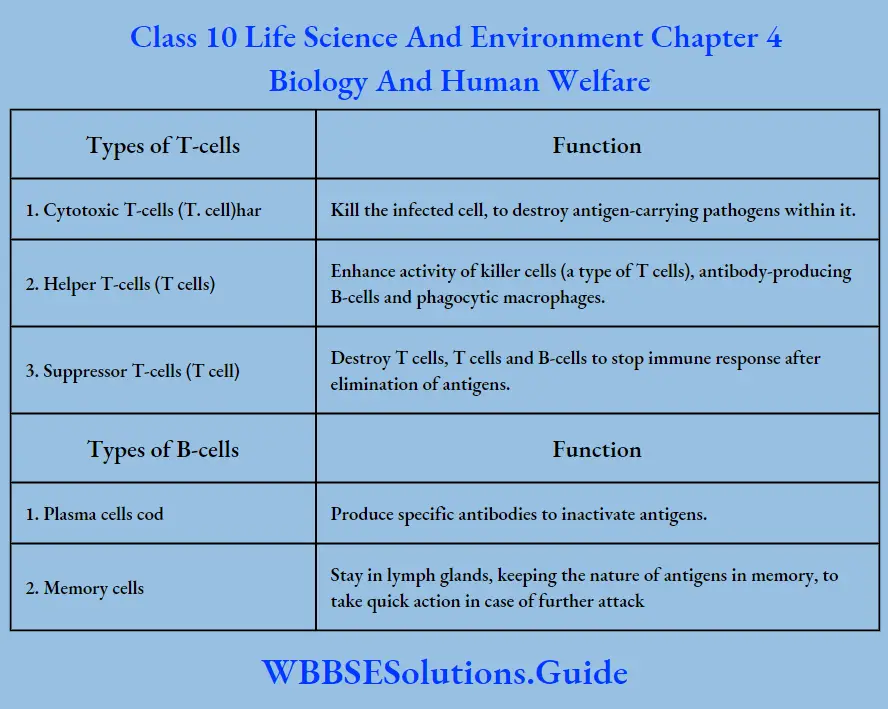
Question 28. How do microbes act as bio-control agents?
Answer:
Bio-control agents:
Several harmful organisms are spread in the environment from crop fields to water reservoirs. Scientists have found certain microbes which can act as natural enemies of those undesired organisms and reduce their population to a manageable level. These microbes are known as bio-control agents. There are some bacteria, viruses, fungi and protozoa that can be used as bio-control agents.
Bacteria as a bio-control agent:
Bacillus thuringiensis produces a poison, called BT toxin, which is used to control the larvae of moths, beetles and flies. Scientists have introduced some genetic materials of these bacteria in corn and cotton plants. As a result, BT toxin is synthesized in it, so that insect parasites cannot attack these plants.
Virus as a bio-control agent:
(1) Caudovirales is a group of phage viruses, which kill Salmonella (bacteria) from water bodies. This phage virus can be used to eliminate Salmonella from drinking water to protect us from severe diarrhoea.
(2) Nuclear Polyhedrosis Virus (NPV) or Cytoplasmic Polyhedrosis Virus (CPV) can kill larvae of moths and butterflies. These viruses are used to destroy some harmful insects like pine sawflies, gipsy moths, tussock moths, etc.
Protozoa as a bio-control agent:
(1) Nosema locusta is a protozoan microbe, which is used to control harmful grasshoppers.
(2) Mettasia grandis, another protozoa, effectively controls cotton ball weevils.
Fungus as a bio-control agent:
Beauveria bassiana is a fungus which can control mosquito populations effectively. It can be used in those areas where mosquitoes have developed resistance against chemical insecticides. It can also control termites, whiteflies and many other insects.
Question 29. How do microbes act as bio-fertilizers?
Answer:
Bio-fertilizers :
Certain microbes have a special ability to absorb atmospheric nitrogen and transform it into nitrates. After the death of these microorganisms, the trapped nitrogen gets mixed in the soil to increase its fertility. These microbes are now cultured and applied scientifically in crop fields to increase crop production. Therefore, these microbes are popularly known as bio-fertilizers.
Some of the bio-fertilizers are mentioned below.
Bacteria as bio-fertilizers:
(1) Rhizobium leguminosarum is.a symbiotic bacteria present in the root nodules of leguminous plants. These bacteria trap atmospheric nitrogen and convert it into nitrates. Ultimately this nitrate is transferred to the plant body as an essential nutrient.
(2) Some soil-living aerobic bacteria can absorb atmospheric nitrogen into the cells. After death, this nitrogen is released into the soil as nitrates and increases its fertility. Azotobacter sp., Azomonas sp., Derxia sp., Azospirillum sp., etc. are some examples.
(3) Among the anaerobic nitrogen-fixing bacteria, Clostridium, Chromatium, and Chlorobium are mentionable.
Cyanobacteria as bio-fertilizers:
Some cyanobacteria or blue-green algae can trap atmospheric nitrogen. These include Anabaena sp., Nostoc sp., Aulosira sp., Stigonema sp. Plectonema sp., etc. These blue-green algae are now cultured in the water of paddy fields. When these algae die and decompose, nitrates get absorbed in the soil and increase its fertility.
Mycorrhiza as bio-fertilizer:
Mycorrhiza is a symbiotic association between the roots of some plants and some fungi. In this association, the fungi develop hyphae (fine filaments of the fungal vegetative body) around the root tip or inside the cortex of roots. Mycorrhizal hyphae absorb phosphorus and nitrogenous nutrients from soil very efficiently. Besides this, it can remove harmful heavy metals like lead, mercury etc. from soil to reduce soil pollution. Mycorrhiza is formed in pines and some crop plants. The fungi involved in the formation of mycorrhiza are Boletus sp., Amanita sp., etc.
Question 30. Describe the different ways in which antibodies work.
Answer:
Antibodies work in different ways:
1. Neutralizing an Antigen:
The antibody can bind to an antigen, forming an antigen-antibody complex. This forms a shield around the antigen, preventing its normal function. This is how toxins from bacteria can be neutralized or how a cell can prevent a viral antigen from binding to a body cell thereby preventing infection.
2. Activating Complement:
Complement is a group of plasma proteins made by the liver that normally are inactive in the body. An antigen-antibody complex triggers a series of reactions that activate these proteins. Some of the activated proteins can cluster together from a pore or channel that inserts into a microbe’s plasma membrane. This lyses (ruptures) the cell.
3. Precipitating Antigens :
Sometimes the antibodies can bind to the same free antigen to cross-link them. This causes the antigen to precipitate out of the solution (a process called agglutination), making it easier for phagocytic cells to ingest them by phagocytosis.
4. Facilitating Phagocytosis:
The antigen-antibody complex signals phagocytic cells to attack. The complex also binds to the surface of macrophages to further facilitate phagocytosis.
Question 31. Write a short note on the experimental vaccine.
Answer:
Experimental Vaccine:
Several innovative vaccines are also in development and use:
(1) Dendrite cell vaccines combine dendritic cells with antigens to present the antigens to the body’s white blood cells, thus stimulating an immune reaction. These vaccines have shown some positive preliminary results for treating brain tumours.
(2) Recombinant vector-by combining the physiology of one microorganism and the DNA of the other, immunity can be created against diseases that have complex infection processes.
(3) DNA vaccine-in recent years a new type of vaccine called DNA vaccine, created from an infectious agent’s DNA, has been developed. It works by insertion (and expression, enhanced by the use of electroporation, triggering immune system recognition) of viral or bacterial DNA into human or animal cells.
(4) T-cell receptor peptide vaccines are under development for several diseases using models of Valley Fever, stomatitis, and atopic dermatitis. These peptides have been shown to modulate cytokine production and improve cell-mediated immunity.
Question 32. Write a short note on the comprehensive package for priority countries by UNICEF under the WASH programme.
Answer:
Comprehensive package for priority countries:
1. Promoting a balanced notional WASH programming framework:
UNICEF will encourage a three-pillar approach including the provision of water supply and sanitation services that are complemented by the promotion of improved hygiene behaviour and supported by an enabling environment.
2. Supporting intersectoral approaches:
Maximum child survival and development benefits are realized when hygiene, sanitation and water programmes are coordinated or integrated with other sectoral programmes including education, health and nutrition.
3. Providing catalytic and continuous support for scaling up sustainable WASH Programmes :
Targets will be met only when national service delivery programmes are significantly scaled up, and UNICEF will prioritize support activities that contribute to this end. However, increased coverage without improved sustainability is not true scaling-up, and UNICEF will actively work to identify and promote models to improve the sustainability of WASH services.
4. Supporting community management through effective decentralisation processes:
UNICEF will support measures that help create strong institutions at the intermediate level (municipal, district, province, etc.) since they are critical to supporting community-managed service provision, which is in turn essential to the sustained scaling up of WASH coverage.
5. Promoting safe and sustainable water supplies through improved water resources management:
UNICEF and its partners in the WASH sector have a responsibility to promote and implement measures to protect the freshwater resource base.
6. Focusing on sanitation, water quality and hygiene at the household level :
There is increasing evidence that a greater focus on the household level increases the effectiveness of sectoral programmes, especially in the areas of sanitation, water quality and hygiene promotion.
UNICEF will continue to promote affordable, safe household latrines; technology development in the area of household water treatment, and programmes that seek to improve household hygiene practices.
7. Addressing a child’s right to health and education through the provision of WASH in schools:
UNICEF is committed to ensuring that all children have access to high-quality water and sanitation services at school and the benefit of hygiene education. School-based WASH activities represent an opportunity to directly address a child’s right to both education and health.
Question 33. Write a short note on the package for all countries by UNICEF under the WASH programme.
Answer:
In all countries:
Strategies for all other countries where UNICEF works:
1. Advocacy and technical support for improving hygiene awareness and promoting behaviour change:
Including education, health, nutrition and young child survival and development programmes.
2. Technical support for water quality:
In the areas of water safety planning, water quality monitoring and quality mitigation programming.
3. Development of emergency preparedness plans for WASH:
Drawing on its competencies in emergency WASH programmes, UNICEF provides appropriate assistance to governments and other stakeholders in the development of national plans for WASH emergency preparedness.
4. Support to national monitoring for the achievement of MDG target 10:
UNICEF, with WHO, is the focal agency for global sector monitoring, and UNICEF also provides technical support for monitoring at the national level.
WBBSE Solutions Class 10 Life Science Chapter 3 Heredity And Common Genetic Diseases Short Answer Questions
Chapter 3 Heredity And Common Genetic Diseases Short Answer Questions
Question 1. What is Photosynthesis?
Answer:
Photosynthesis:
The anabolic reaction that occurs between carbon dioxide gas and water in the presence of sunlight and chlorophyll to produce glucose is known as photosynthesis.
Equation :- 6CO2 + 12H2O → C6H12O6 + 6H2 mknO + 6O2
Question 2. What are the raw materials necessary for the process of photosynthesis?
Answer:
(1) Carbon dioxide gas (CO2) and
(2) Water (H2O) is the raw material necessary for the process of photosynthesis.
Question 3. Where is mesophyll tissue located? What is its function?
Answer:
(1) Between the upper and lower epidermis of the leaf.
(2) It helps in photosynthesis.
Question 4. What do you understand by carbon assimilation?
Answer:
carbon assimilation
The reduction of carbon dioxide gas to produce glucose during the dark reaction of photosynthesis is called carbon assimilation.
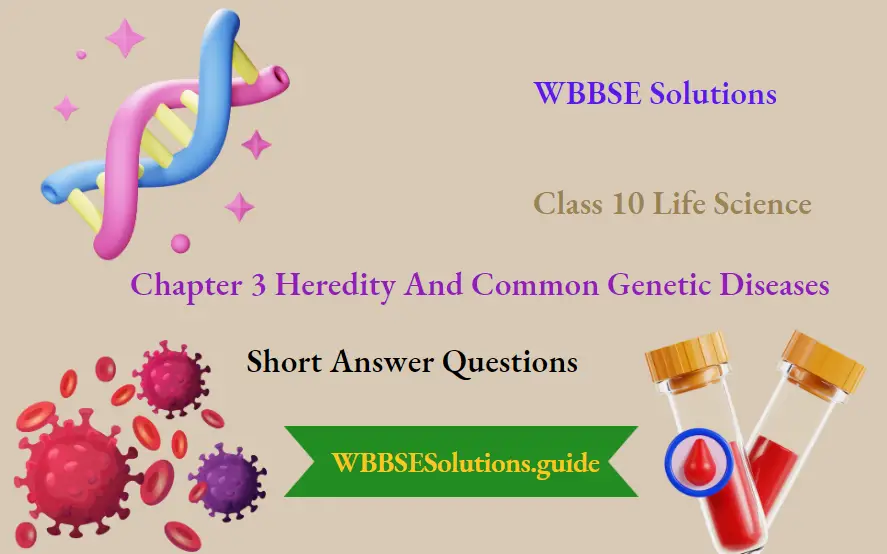
Question 5. What are the components of the environment necessary for photosynthesis? Where do the plants collect all these components?
Answer:
(1) CO2 – Air, Water
(2) H2O -Soil
(3) Light – Sun
(4) Chlorophyll – grana of Chloroplast.
Question 6. What is meant by “entrapping of solar energy” in the case of green plants?
Answer: The process by which chlorophyll molecules absorb solar energy and help to convert this energy into chemical energy is called “entrapping of solar energy”.
Question 7. Write the names of two animals that can carry out photosynthesis and the names of two plants unable to do photosynthesis.
Answer:
Name of animals —
(1) Euglena ;
(2) Chrysamoeba.
Name of plants —
(1) Agaricus;
(2) Mucor.
Question 8. In green plants which one process between photosynthesis and respiration does not occur during night and why?
Answer:
(1) Photosynthesis.
(2) Because sunlight is not available during the night.
Question 9. What is photolysis?
Answer:
Photolysis
When sunlight falls on the surface of the green leaves of plants, some part is absorbed by chlorophyll molecules, and the remaining part is reflected from the surface to the environment. The chlorophyll molecules are changed into activated chlorophyll after absorption of light.
Activated chlorophyll splits water molecules into H+ion and OH” ion. OH– ion loses one electron and is converted into OH radical. This OH radical is changed into water and oxygen gas. Water again takes part in metabolic reaction and oxygen comes out to the environment through stomata.
H+ ion gains one lose electron of OH– ion and changes into a neutral hydrogen atom. It combines with NADP (Nicotinamide Adenine Dinucleotide Phosphate) and reduces it into NADPH2. At the end of this reaction, the activated chlorophyll molecule resumes its original state.
Question 10. What is the role of carbon dioxide in photosynthesis?
Answer:
Role of carbon dioxide in the process of
photosynthesis:—
Carbon dioxide is a raw material for photosynthesis. In the dark phase of photosynthesis, it is reduced to glucose. Thus both elements—carbon and oxygen-are involved in the formation of glucose.
Question 11. What is photophosphorylation?
Answer:
Photophosphorylation
The formation of ATP molecules with the help of ADP molecules during the light phase of photosynthesis is called photophosphorylation.
Question 12. Explain the role of water in photosynthesis.
Answer:
Role of water in the process of photosynthesis:—
Water is a raw material of CO2. Thus it takes part in glucose formation. The oxygen of water is changed into the free form of oxygen gas which comes out through stomata.
Question 13. State the role of sunlight in photosynthesis.
Answer:
Role of sunlight in photosynthesis:—
influences the rate of photosynthesisThe intensity, quality, and duration of light influence the rate of photosynthesis. Photolysis of water occurs in the presence of light. Too much high-intensity light may even stop the process of photosynthesis. The inhibition of photosynthesis due to high-intensity light which slows down its rate is called solarization. The rate of photosynthesis is directly related to the duration of light.
Question 14, How is the O2 — CO2 balance in the environment dependent on the green plants?
Answer:
Importance of photosynthesis in maintaining the balance of CO2 and O2 in the environment:—
The percentage of CO2 and O2 gas in (air and water) is maintained by photosynthesis. Autotrophs take in CO2 gas from their environment for the process of photosynthesis. They liberate O2 gas during this process. All living organisms take in O2 gas and give out CO2 gas during respiration. Thus photosynthesis and respiration in a combined effect maintain the balance of CO2 andO2 in the environment.
Question 15. Point out the relevant difference between assimilatory starch and storage starch.
Answer:
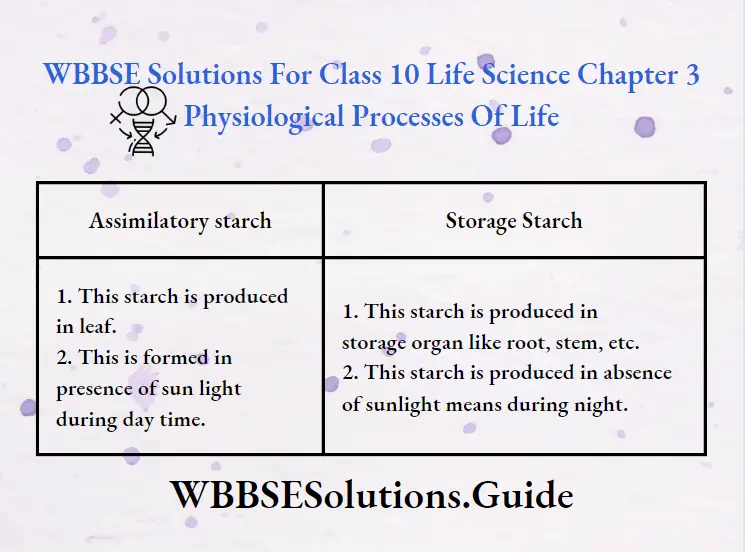
Question 16. What are the roles of chlorophyll and sunlight during photosynthesis?
Answer:
(1) Role of chlorophyll in photosynthesis:—
Chlorophyll is a magnesium-containing green pigment present in the chloroplast of green plants. The chlorophyll pigment first absorbs the incoming solar radiation. It results in the activation of the chlorophyll. Activated chlorophyll causes the dissociation of water. Hence chlorophyll helps in the photolysis of water.
(2) Role of sunlight in photosynthesis:—
The intensity, quality, and duration of light influence the rate of photosynthesis. Photolysis of water occurs in the presence of light. Too much high-intensity light may even stop the process of photosynthesis. The inhibition of photosynthesis due to high-intensity light which slows down its rate is called solarization. The rate of photosynthesis is directly related to the duration of light.
Question 17. Discuss any two significances of photosynthesis.
Answer:
(1) Solar energy is entrapped and converted into chemical energy by this process. This chemical energy is stored within food (ex. glucose). This food is the source of energy for all living Autotrophs and Heterotrophs.
(2) CO2 and O2 balance is maintained by this process with the association of respiration.
Question 18. Photosynthesis is a process of energy transformation.
Answer: The conversion of one form of energy to the other form of energy is called the transformation of energy. Solar energy is converted into chemical energy during the process of photosynthesis. Therefore photosynthesis is called a process of energy transformation.
Question 19. Photosynthesis is called an anabolic process.
Answer: The cellular reaction that forms complex substances from simple substances is called anabolic process. During photosynthesis complex substance glucose is formed from the simple substances carbon dioxide and water. Energy is entrapped and the dry weight of the plant is increased.
Question 20. Why is photosynthesis called carbon assimilation?
Answer: The transformation of a simple substance into a complex substance is called assimilation. The simple substance CO2 is converted into complex substance glucose during the process of photosynthesis. Hence, photosynthesis is called carbon assimilation.
Question 21. Why is photosynthesis termed an oxidation-reduction reaction?
Answer: Water and carbon dioxide are reactants. During photolysis, H2O is oxidized by activated chlorophyll and as a result of this, free oxygen gas is evolved. In the dark phase, CO2 gas is reduced by ATP and NADPH2 to produce glucose molecules.
Question 22. Why is photosynthesis called an endergonic process?
Answer: The metabolic reaction in which energy is stored, is called the endergonic process. During photosynthesis, solar energy is transformed into chemical energy and this energy is stored within glucose molecules.
Question 23. Why is assimilatory starch formed?
Answer: Glucose is produced by Photosynthesis. It is soluble in water. The concentration of water becomes high. It hampers the process of photosynthesis. To continue the process of photosynthesis glucose is converted into assimilatory starch during the day.
Question 24. Why photosynthesis and respiration are called opposite processes?
Answer:
Photosynthesis and respiration are two opposite processes:
(1) Photosynthesis is an anabolic or constructive process in which carbon dioxide and water are used by the chlorophyll-containing plant to produce glucose. Whereas respiration is a catabolic or destructive process in which glucose is broken down into carbon dioxide and water.
(2) Photosynthesis occurs in the presence of the sunlight. Light is not necessary for respiration.
(3) Photosynthesis is an energy-consuming process and the energy is stored as potential energy in glucose molecules. Respiration is. an energy-releasing process in which the stored potential energy of a glucose molecule is released as kinetic energy.
Question 25. Which type of metabolic process is photosynthesis and why?
Answer:
Photosynthesis is an anabolic type of metabolic process.
Because:-
(1) Solar energy is entrapped and converted into potential chemical energy.
(2) A complex substance glucose is formed from simple substances CO2 and H2O.
(3) The dry weight of the plant increases during this process.
Question 26. What is the relation between photosynthesis and energy cycle?
Answer:
Photosynthesis:-
The process by which green plants manufacture their food utilizing CO2, and H2O as raw materials with the help of sunlight and chlorophyll, is known as photosynthesis.
Energy Cycle:-
According to the law of conservation of energy, “Energy cannot be created nor destroyed, but transformed from one form to another.” This principle says that energy is continuously cycled in nature in different forms.
Relation between photosynthesis and energy cycle:-
The plants absorb about one percent of the sunlight falling on them. The sunlight contains solar energy. The incoming solar energy is absorbed by chlorophyll molecules. Then, by the process of photosynthesis, this solar energy is converted into usable chemical energy which is stored in the food molecule. Thus photosynthesis is involved. in the conversion of solar energy into chemical energy.
Question 27. What is the relation observed between photosynthesis and respiration occurring in green plants during the daytime?
Answer: The process of photosynthesis occurs in chloroplast. It requires CO2 and H2O. Glucose, oxygen, and water are produced as products of this reaction.
Respiration occurs in the cytoplasm and mitochondria of the same cell. It requires glucose and oxygen. Carbon dioxide, water, and energy are produced during respiration.
Relation:-
The process of photosynthesis and respiration occur in green plants during the daytime by helping each other. Because the end products of photosynthesis are the raw materials of respiration and the end products of respiration are the raw materials for photosynthesis. Hence both processes are interrelated.
Question 28. Define respiration.
Answer:
Respiration
The catabolic reaction that occurs continuously within all living cells to oxidize food substances and to change the potential chemical energy of food into kinetic energy is called respiration.
Equation :- C6H12O6 + 6O2→ 6CO2 + 6H2O + 686 K. Cal Energy
Question 29. Name any two respiratory organs of animals.
Answer:
(1) Man:—Lungs
(2) Fish:— Gills.
Question 30. Where are mitochondria located? What is its function?
Answer:
(1) Mitochondria is located in the cytoplasm of a living cell.
(2) It is the site of Kreb’s cycle. ATP is also stored within it.
Question 31. Name the two major phases of aerobic respiration.
Answer:
(1) Glycolysis or E.M.P. pathway.
(2) Kreb’s Cycle.
Question 32. Mention three main types of respiratory organs in animals.
Answer:
(1) Lungs:— Man.
(2) Trachea:— Cockroach
(3) Gills:— Fish.
Question 33. Name one respiratory organ of an animal suitable for performing respiration in an aquatic environment. In which organism does it occur?
Answer:
(1) Gills.
(2) Fish.
Question 34. What is aerobic respiration?
Answer: The process of respiration in which complete oxidation of food takes place in the presence of free oxygen is called aerobic respiration.
Equation:- C6H12O6 + 6O2 ——> 6CO2 + 6H2O + 686 K cal Energy.
Question 35. Name the chief respiratory organs of Amoeba, Cockroaches, Tadpole, and Bird.
Answer:
(1) Amoeba :— Plasma membrane
(2) Cockroach:— Trachea
(3) Tadpole:— Gills
(4) Bird:— Lungs with air sacs.
Question 36. What is an accessory respiratory organ? Cite two examples of animals where it is found.
Answer:
(1) The organs that are attached to the main respiratory organ and help the organism to take oxygen from another environment, are called accessory respiratory organs:
(2) (a) Magur (b) Koi.
Question 37. What is fermentation?
Answer: The partial anaerobic oxidation of organic compounds (Glucose) which occurs due to enzymatic action within the cytoplasm of microorganisms to produce different types of organic substances, i.e., Alcohol, lactic acid, etc. is called fermentation.
Question 38. What is Glycolysis?
Answer: The process of conversion of glucose into pyruvic acid within the cytoplasm of the cell in the presence of glycolytic enzymes is called Glycolysis.
Question 39. What is alcoholic fermentation?
Answer: The decomposition of organic substances in the presence or absence of oxygen but in the presence of microorganisms and one product is “Alcohol” called alcoholic fermentation.
Equation :- C6H12O6 + Zymase Yeast, 2C2H5OH + 2CO2 + 50Kcal
Question 40. What is the respiratory substance of the cell?
Answer: The organic compounds that are oxidized within living cells during respiration are called respiratory substances. Ex. Glucose, Amino acid, Fatty acid.
Question 41. What is a citric acid cycle? Why is it called so?
Answer: The process of formation of a group of eight Tricarboxylic organic acids within mitochondria is called the citric acid cycle.
Reason :
Citric acid is the first organic—acid formed within mitochondria. Hence the cycle is called the citric acid cycle.
Question 42. What is meant by — ‘Release of energy takes place in respiration’?
Answer: Potential chemical energy is stored within respiratory substances like glucose, amino acids, and fatty acids. The process of respiration converts this potential chemical energy into kinetic energy. Living organisms use this form of energy to perform their various vital function. The conversion of potential chemical energy of respiratory substances into a usable form of energy is the meaning of release of energy.
Question 43. Where and when does respiration occur?
Answer:
(1) Respiration occurs in the cytoplasm and Mitochondria of a living cell.
(2) It occurs day and night continuously.
Question 44. Name the respiratory organ of spider and tadpole larva.
Answer:
Spider — Book lung
Tadpole — External gill
Question 45. Rohu and Katla fishes are dead while on sale, but Indian Koi and Magur fishes still keep alive. How?
Answer: Because in Indian Koi and Magur fishes accessory respiratory organs, labyrinthi form and arborescent respectively are attached to the main respiratory organ, gills. These accessory respiratory organs can absorb oxygen gas in the air.
Question 46. While preparing curd, a little curd mixed with the milk helps to prepare the curd quickly. How?
Answer: The bacteria present in curd increase the rate of fermentation. So, the process of curd formation takes place quickly.
Question 47. Explain in brief why pouring oil on the sewage water kills the larvae of the mosquito.
Answer: Oil acts as a disinfectant and kills the larvae of the mosquito. It also covers the water’s surface. Due to this oxygen gas does not mix with water, In the absence of oxygen larvae can not perform the process of respiration. Hence, they die.
Question 48. Why are accessory respiratory organs necessary for some fishes?
Answer: Accessory respiratory organs are present in those fishes that live in muddy water. The percentage of oxygen is less due to the presence of mud in this water. To fulfill the requirement of oxygen accessory respiratory organs are originated.
Question 49. Why is the human lung provided with alveoli?
Answer: It increases the surface area for the exchange of gases like O2 and CO2. Another fact is that these are covered with blood capillaries through which the exchange of gases is possible.
Question 50. Why is aerobic respiration known as oxidative phosphorylation?
Answer: The complete oxidation of food in the presence of oxygen within living cells is called aerobic respiration. The formation of ATP mainly occurs within mitochondria in the presence of oxygen. Hence aerobic respiration is known as oxidative phosphorylation.
Question 51. Why is respiration considered as catabolism?
Answer: The cellular chemical reaction in which simple substances are formed from the breaking of complex substances is called catabolism. During respiration, simple substances like H, O, and CO, are formed from the complex substance glucose. Energy is released and the dry weight of living organisms is decreased.
Question 52. Why. is breathing rate faster in aquatic animals as compared to terrestrial animals.
Answer: Aquatic animals do more work in comparison to terrestrial animals. Hence they require more energy. To obtain more energy their breathing rate is higher. They also get less amount of oxygen from water.
Question 53. How is respiration related to nutrition?
Answer: The oxidative breakdown of substances in living cells to release energy is called respiration.
The total of processes like ingestion, digestion, absorption, assimilation, and egestion is called nutrition.
Relation:-
The process of nutrition supplies the raw materials such as glucose, amino
“acids, and fatty acids for respiration, and respiration produces energy which is necessary for nutrition. Thus both processes are complementary to each other.
Question 54. “The calorific value of the protein is 4.1-kilo calorie/gm”. Explain.
Answer: When one gram protein (Amino acid) is oxidized within the cell during respiration 4.1 kilo calorie energy is released.
Question 55. What is nutrition?
Answer: Nutrition is a combination of processes (like ingestion, digestion, absorption, assimilation, and egestion) by which living organisms receive and utilize nutrients for the maintenance of their functions and growth.
Question 56. What are the different phases of animal nutrition?
Answer:
(1) Ingestion
(2) Digestion
(3) Absorption
(4) Assimilation
(5) Egestion.
Question 57. Name any two plants of which one is autophytic and the other heterophytic.
Answer:
(1) Autophytic:- Mango, Neem.
(2) Heterophytic:—Cuscuta, Yeast.
Question 58. What are the names of the first phase and the last phase of animal nutrition?
Answer:
(1) First phase:— Ingestion.
(2) Last Phase:— Egestion
Question 59. What is food?
Answer: The nutrients which supply energy and help in the formation of body substances are called food.
Example:—
(1) Carbohydrates
(2) Proteins and
(3) Fats.
Question 60. Name two food components that do not supply energy.
Answer:
(1) Vitamins.
(2) Mineral salts.
Question 61. Name two plant sources and two animal sources of a fat type of food.
Answer:
(1) Plant:— Coconut oil and Palm oil
(2) Animal:— Butter and Ghee.
Question 62. What is heterophilic nutrition? Give example.
Answer:
(1) The mode of nutrition by which non-green plants obtain their food is called heterophytic nutrition.
(2) Example:— Agaricus.
Question 64. Define the term ‘Parasite’. Give an example of a parasitic animal.
Answer:
(1 The organisms who obtain their food from other living organisms (host) are called parasites.
(2) Entamoeba histolytica.
Question 65. Define Autotrophic nutrition.
Answer: The mode of nutrition to obtain their food utilized by green plants is called Autotrophic nutrition.
Example — Green Mango tree.
Question 66. Give one plant and one animal example of a partial parasite.
Answer:
(1) Plant partial parasite — Viscum album.
(2) Animal partial parasite — Mosquito.
Question 67. Name two parasitic plants.
Answer:
(1) Cuscuta
(2) Rafflesia.
Question 68. Mention the principal types of food. Cite one example of each type.
Answer:
(1) Carbohydrate:— Wheat, Milk.
(2) Protein:— Soyabean, Fish.
(3) Fat:— Coconut oil, Butter.
Question 69. Name one parasitic plant and its host.
Answer:
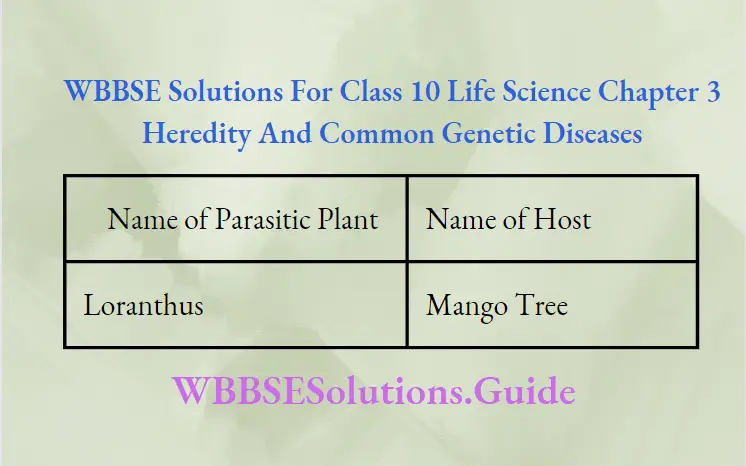
Question 70. Write two differences between parasites and symbionts.
Answer:
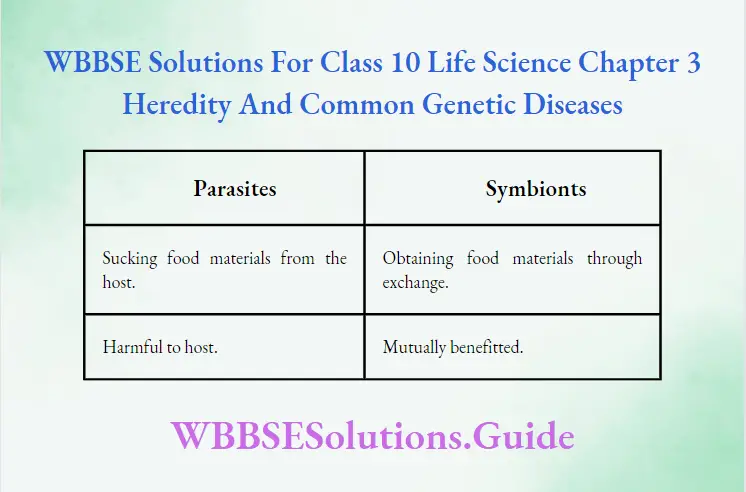
Question 71. Mention any two importance of the process of nutrition.
Answer:
(1) For a steady supply of energy:-
Food is the source of energy for living organisms. Simple soluble foods are supplied to the cells for the conversion of chemical energy into kinetic energy. These foods are the product of the process of nutrition.
(2) For Bodybuilding and growth:-
The process of nutrition supplies the material for body building and growth.
Question 72. Write two differences between saprophytic and symbiotic plants.
Answer:
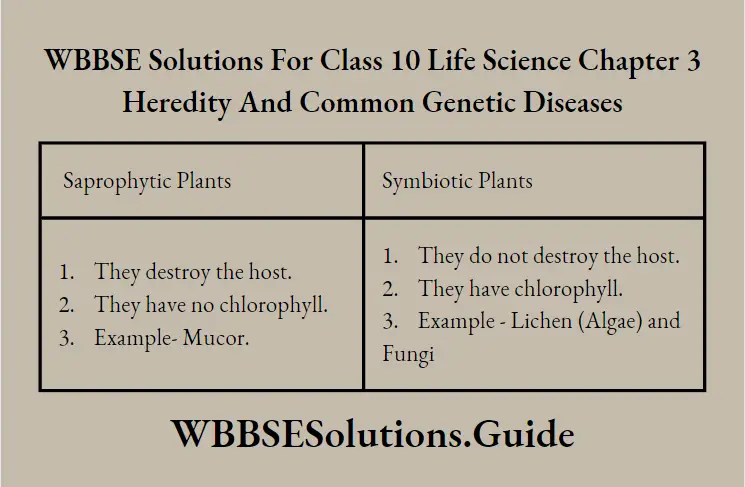
Question 73. Why does the doctor forbid spicy food for a hepatitis patient?
Answer: Hepatitis is a liver disease. A person suffering from this disease is unable to digest spicy food due to a lack of proper functioning of the liver.
Question 74. In which part of the alimentary canal, related to the digestion of food, no carbohydrate-splitting enzyme is secreted?
Answer: Stomach.
Question 75. What do you mean by the calorific value of food?
Answer: The energy obtained by the complete combustion of 1 gm of food is called its calorific value.
Question 76. What is an enzyme?
Answer: The nitrogenous organic compounds that are produced by living cells but without taking part in biochemical reactions, within or outside a cell, change the rate of chemical reaction, are called enzymes.
Question 77. Name the two substrates on which lipase and trypsin react respectively.
Answer:
(1) Lipase:- Fat.
(2) Trypsin:— Peptone.
Question 78. Name any two properties of the enzyme.
Answer:
(1) They do not take part in a biochemical reaction.
(2) They act only in a specific medium.
Question 79. Write two important characteristics of enzymes.
Answer:
(1) All enzymes are chemically protein in nature.
(2) Enzymes return to their original state after the completion of the reaction.
Question 80. From which part of the digestive system are protein-digesting enzymes
secreted?
Answer:
(1) Stomach
(2) Small intestine.
Question 81. Mention the names and functions of two enzymes.
Answer:
Question 82. Name the enzyme present in saliva. On what type of food does it act?
Answer:
(1) Ptyalin / salivary amylase
(2) Carbohydrate (Starch)
Question 83. Write the name of a proteolytic enzyme and mention its function.
Answer:
(1) Pepsin.
(2) Function:- It acts on protein and converts it into peptone.
Question 84. What is pepsin? State its source and function.
Answer:
(1) Pepsin:- It is an example of a proteolytic enzyme.
(2) Source:- Gastric Juice of the gastric gland.
(3) Function:- It acts on protein and changes it into peptone.
Question 85. The enzyme ptyalin helps to digest which type of food? From where is it secreted?
Answer:
(1) Enzyme ptyalin helps to digest carbohydrate type of food.
(2) Ptyalin is secreted by salivary gland.
Question 86. Name any two amylolytic enzymes.
Answer:
(1) Amylase
(2) Maltase.
Question 87. What do you understand by digestion?
Answer: The breaking of complex, insoluble, and non-absorbable forms of food into simple, soluble, and absorbable forms with the help of enzymes is called digestion.
Question 88. What are the end products of digestion of proteins, carbohydrates, and fats in the case of man?
Answer:
(1) Proteins:— Amino acid.
(2) Carbohydrates:— Glucose, Fructose and Galactose.
(3) Fats:— Fatty acid and glycerol.
Question 89. State the function of gastric HCI.
Answer:
(1) It changes the medium of food in the stomach.
(2) It kills harmful germs.
(3) It activates pepsinogen to convert into pepsin.
Question 90. What is a Lacteal?
Answer: The blood vessels which is present within the villus and help in the absorption of fatty acid are called lacteal.
Question 91. What is peristalsis?
Answer: The movement of involuntary muscles of the alimentary canal which helps in the transfer of food in the forward direction is called peristalsis.
Question 92. Name one digestive juice devoid of enzymes. Name the food on which it acts regarding digestion.
Answer:
(1) Name of juice:— Bile
(2) Name of food:— Fat
Question 93. Name the bile salts.
Answer:
(1) Sodium taurocholate
(2) Sodium glycolate.
Question 94. Name the salivary glands of humans.
Answer:
(1) Parotid (below ear)
(2) Sub Maxillary (under lower gland)
(3) Sublingual (below tongue).
Question 95. Define assimilation and egestion.
Answer:
(1) Assimilation:-
The process by which the absorbed food substances are converted into protoplasm is called assimilation.
(2) Egestion:-
The process by which the animal body gets rid of the unabsorbed residue of food materials from the rectum through the anus is called egestion.
Question 96. What will happen when salivary glands are removed from the human body?
Answer: In the absence of salivary. glands saliva will not be formed in the mouth cavity. Carbohydrate digestion will not take place in the absence of the enzyme ptyalin which is a constituent of saliva. Some bacteria will not be destroyed in the absence of lysozyme.
Question 97. What type of food can be digested in the buccal cavity? Name any one of the glands which help in its digestion.
Answer:
(1) Carbohydrates type of food can be digested in the buccal cavity.
(2) The name of one gland that helps in carbohydrate digestion is the salivary gland (Ea. parotid)
Question 98. State one structural and one functional difference between villi and alveoli.
Answer:
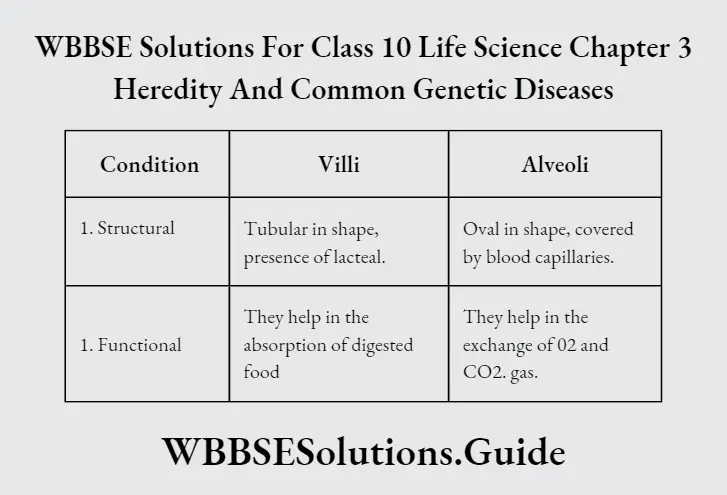
Question 99. Explain the role of the liver in Digestion.
Answer: The liver cells produce bile. This is stored in the gall bladder. Bile reaches the duodenum through the bile duct. Enzymes are absent in bile. Despite this fact, bile takes part in digestion. First of all, it changes the medium of chyme which comes from the stomach to the duodenum. The salts present in bile emulsify fats into microscopic fat droplets.
Question 100. What is a vitamin?
Answer: The organic compounds which are mainly produced by plant cells but a small quantity of these substances are essential for the proper regulation of our metabolic reactions, are called vitamins.
Question 101. Name four fat-soluble vitamins.
Answer:
(1) Vitamin A
(2) Vitamin D
(3) Vitamin E
(4) Vitamin K
Question 102. What type of vitamins are thiamine and phylloquinone?
Answer:
(1) Thiamine:— Water soluble.
(2) Phylloquinone :— Fat soluble.
Question 103. What is the source of vitamin A? What type of disease occurs in its absence?
Answer:
(1) Source:- Green Vegetables.
(2) Disease:- Night Blindness.
Question 104. Name the vitamins which you are acquainted with.
Answer:
(1) Vitamin A
(2) Vitamin B
(3) Vitamin C
(4) Vitamin D
(5) Vitamin E
(6) Vitamin K.
Question 105. Deficiency of which vitamin causes Ricket? What is the source of this vitamin?
Answer:
(1) Vitamin D.
(2) Source:- Cod liver oil.
Question 106. Which vitamins are water soluble and which are fat soluble?
Answer:
(1) Name of water-soluble vitamins:— Vitamin B, Vitamin C.
(2) Name of fat-soluble vitamins:— Vitamin A, Vitamin D, Vitamin E, Vitamin K.
Question 107. What is the necessity o of vitamins? Mention the importance of vitamins.
Answer:
(1) Need of vitamins:-
Vitamins are necessary for the proper growth of different organs of the human body.
(2) Importance of vitamins:-
They regulate the metabolic reactions. Doing so they save us from different types of diseases.
Question 108. What is the source of vitamin C ? What disease is caused due to its deficiency?
Answer:
(1) Source:— Lemon, orange, amla.
(2) Disease:— Scurvy.
Question 109. Thiamine and Calciferol — What kind of vitamins are they?
Answer:
(1) Thiamine — Water soluble
(2) Calciferol — Fat soluble.
Question 110. What is Calciferol?
Answer: It is the chemical name of vitamin D.
Question 111. What is the P-P factor?
Answer: The full name is Pellagrea Preventing Factor. It is a water-like vitamin whose chemical name is Nicotinic acid and its deficiency causes pellagra.
Question 112. Which vitamin and which macro element are required for blood coagulation?
Answer: Vitamin K and macro element calcium are required for blood coagulation.
Question 113. What is the childhood metabolic bone disease associated with vitamin D deficiency? What is its adult counterpart?
Answer:
(1) Ricket is a childhood metabolic bone disease associated with vitamin D deficiency.
(2) The name of the disease that occurs in adults due to deficiency of vitamin D is ‘osteomalacia’.
Question 114. Mention any two functions of vitamin A.
Answer:
(1) It keeps eye-sight healthy.
(2) It helps in proper growth.
Question 115. Mention any one deficiency symptom for each vitamin ‘C’ and vitamin ‘D’ in man.
Answer:
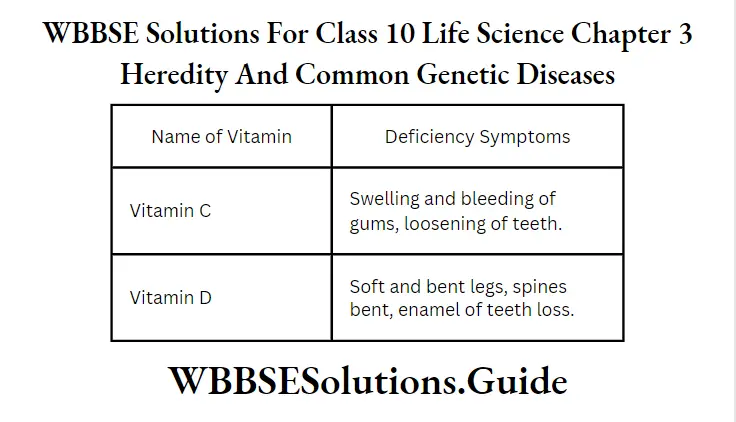
Question 116. Mention the deficiency symptoms of Vitamin ‘E’ and Vitamin ‘K’.
Answer:

Question 117. Give the chemical name and source of Vitamin C.
Answer:
The chemical name of Vitamin C is ascorbic acid. Source of vitamin C ——
(1) Animal —— Adrenal cortex, Cow’s Milk
(2) Plant —— lemon, tomato.
Question 118. Classify vitamin K and vitamin C according to their solubility and deficiency disease.
Answer:
Vitamin K is soluble in fat and Vitamin C is soluble in water.
Deficiency disease:—
(1) Vitamin K ——— Haemorrhage
(2) Vitamin C —— Scurvy
Question 119. Write down two effects of the deficiency of vitamin ‘C’.
Answer:
(1) Scurvy —— Spongy and bleeding gums.
(2) Anaemia —The number of RBC and Platelets is reduced.
Question 65. What do you understand by essential macro elements?
Answer: The elements of which large quantity is required by living organisms for performing their different types of functions in their body are called essential macro elements.
Example:- Carbon, Hydrogen, Oxygen, etc.
Question 119. Name two trace elements that are essential for plant nutrition.
Answer:
(1) Copper (Cu)
(2) Zinc (Zn).
Question 120. Name any two of the non-metallic essential elements and state their respective sources.
Answer:
(1) Carbon:— CO2
(2) Hydrogen:— H2O
Question 121. In phosphorus (P) deficiency, what symptom is exhibited by the plant?
Answer: In phosphorus (P) deficiency leaves turn dark blue.
Question 122. What symptom is found in a plant due to a deficiency of Iron?
Answer: Due to a deficiency of Iron the color of leaves becomes yellow.
Question 123. What is the nitrogen deficiency symptom in plants?
Answer: Stunted growth and the lower portion of leaves become yellow.
Question 124. What is the source of the element Fe (Iron) in the case of human beings?
Answer: Fish is the source of the element Fe (Iron) in the case of human beings.
Question 125. In the absence of potassium which symptom is expressed in the case of a plant?
Answer: Leaves streaked with yellowish mottling at margins and tips.
Question 126. What is meant by chlorosis?
Answer: A plant disease that occurs mainly in leaves due to the deficiency of Iron (Fe), is called chlorosis.
Question 127. Name one macro element which is a major constituent of bones and teeth in animals. Name a disease in children caused due to the deficiency of that element.
Answer:
(1) The name of the macroelement is calcium.
(2) The name of the disease is Ricket.
Question 128. Name one macro element which is a major constituent of hemoglobin. Which disease is caused due to the deficiency of that element?
Answer:
(1) Name of macro element — Iron (Fe)
(2) Name of disease — Anaemia.
Question 129. Write one macro element and microelement each essential for the normal nutrition of plants.
Answer:
(1) Macro element — Nitrogen
(2) Micro element — Copper.
Question 130. Mention the role of magnesium in plant nutrition.
Answer:
Role of magnesium in plants:-
It is a component of chlorophyll. Hence, it takes part in chlorophyll formation. It acts as a co-enzyme of many enzymes.
Question 131. What is Basal Metabolic Rate?
Answer: The amount of energy spent by a living body per square meter per hour of body surface area at the time of complete physical and mental rest is called basal metabolic rate.
Value of BMR:—
40 K.cal/m?/hour. (in male), 37 Kcal/m2/hour (in females).
Question 132. What is the daily total average calorie requirement for an adult human male?
Answer: The daily total average calorie requirement for an adult human male is 3000 — 3400 Calories.
Question 133. What is a balanced diet?
Answer:
Balanced diet:-
A diet in which all the nutrients (such as carbohydrates, proteins, fats, minerals, vitamins, and water) are present in proper proportions is called a balanced diet.
Question 134. What is Diet?
Answer: A prescribed course of nutrients, which provides all requirements for the normal functioning of our body is called a diet.
Question 135. Define metabolism.
Answer: All cellular biochemical reactions leading to the synthesis of complex substances in the body using simpler substances with the help of energy and the breakdown of
complex substances to simpler substances together with the liberation of energy are called metabolism.
Question 136. Name the types of metabolism.
Answer:
There are two types of metabolism :
(1) Anabolism
(2) Catabolism.
Question 137. What do you mean by anabolism?
Answer: Cellular biochemical processes involved in the synthesis of complex molecules by using simpler substances and energy are called anabolism.
Ex. Photosynthesis.
Question 138. What do you mean by catabolism?
Answer: Cellular biochemical processes that are involved in the breaking of complex molecules into simpler substances with the liberation of energy are called catabolism.
Example — Respiration.
Question 139. Nitrogen is a very essential element for the nutrition of living beings.
Answer: Nitrogen takes part in the formation of living material like protoplasm, protein, hormone,s and enzymes.
Question 140. Why does one suffer from goiter?
Answer: Due to a deficiency of the ‘Iodine’ element in their diet, the persons suffering from goiter.
Question 141. Write two reasons why enzymes are called organic Bio-catalysts.
Answer:
(1) Enzyme is protein by nature and produced within living cells.
(2) Enzyme never starts the reaction, only increases or decreases the rate of reaction.
Question 142. Why do we take food?
Answer: We take food to obtain energy which is used to perform various metabolic functions and body activities. We take food for the growth and development of our
body also.
Question 143. Why is calcium necessary for us?
Answer: Calcium takes part in the formation of bone. It is also essential for blood clotting and muscle contraction.
Question 144. Why is phosphorus necessary for us?
Answer: Phosphorus takes part in the formation of ATP, bones, and teeth.
Question 145. Why does the food undergo digestion before absorption in our alimentary canal?
Answer: The process of digestion changes the complex food into a simple soluble form. Only simple and soluble substances are absorbed.
Question 146. Why is milk not considered a balanced diet for adults?
Answer:
Milk is not considered a balanced diet for adults due to the following reasons:—
(1) Presence of water in excess quantity
(2) Lack of Iron
(3) Absence of roughage
(4) Presence of vitamins in less quantity.
Question 147. Why do we lose weight during starvation?
Answer: Nutrients are not available to the cell during this period from outside. Cells obtain nutrients from the reserve stock. Reserve stock of food is gradually used up. So we lose weight during starvation.
Question 148. ‘All foods are nutrients but all nutrients are not foods’ — Why?
Answer: The essential organic and inorganic substances collected from nature that perform the basic activities of living organisms are called nutrients.
The nutrients which are organic edible substances that produce energy and provide material for growth are called food.
Therefore, all foods are nutrients but all nutrients are not foods.
Question 149. Why is glucose called the starting point of respiration?
Answer: Glucose is called the starting point of respiration because it is the end product of carbohydrate digestion. Its oxidation takes place within a cell. It starts the process of
respiration within the cytoplasm of the cell.
Question 150. What is the relationship between nutrition and circulation?
Answer: Nutrition:-
The total of the processes like ingestion, digestion, absorption, assimilation, and egestion is called nutrition.
Circulation:-
The translocation of various substances like digested food, minerals, vitamins, gases, excretory substances hormones, etc. through a liquid medium is called circulation.
Relation:-
Glucose, amino acids, and fatty acids are produced by the process of digestion. They reach the bloodstream by the process of absorption. These substances are supplied to different cells by the process of circulation. Thus nutrition provides the raw materials for circulation and circulation helps in the distribution of nutrients which are essential for the completion of its stages like assimilation.
Question 151. Write one structural and one functional difference between red blood cells and white blood cells.
Answer:
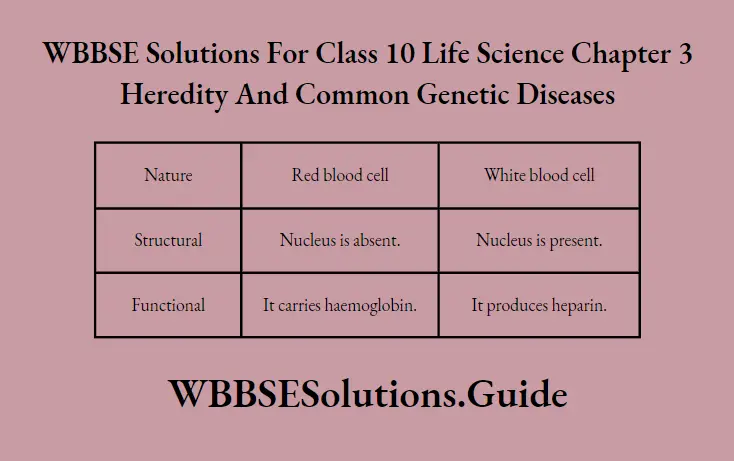
Question 152. Mention two functions of hemocyanin.
Answer:
(1) It carries oxygen gas from respiratory organs to tissue.
(2) It carries carbon dioxide gas from tissue to the respiratory organ.
Question 153. Mention the role of blood in protecting the human body from germs causing diseases.
Answer: The white blood corpuscles kill the germs by their phagocytic activity. Gamma globulin of plasma protein forms antibody which also protects the body.
Question 154. What is circulation?
Answer: The transportation of substances like digested food, gases, excretory products, mineral salts, and hormones through a liquid medium from one part of the body to other parts of the body, is known as circulation.
Question 155. What is the circulatory system?
Answer: A group of organs that are involved in completing the process of circulation is called the circulatory system.
Question 156. Name the different components (organs) of the blood circulatory system in the human body.
Answer:
(1) Heart
(2) Blood vessels (artery, vein, and capillary)
Question 157. What is blood?
Answer: Blood is a fluid connective tissue.
Question 158. What is pure blood?
Answer: The blood that contains sufficient oxygen is called pure blood.
Question 159. Name any one type of White Blood Corpuscles (W.B.C) and state its function.
Answer:
(1) Basophil.
(2) Function
It helps in the formation of ‘heparin’
Question 160. Name two components of mammalian blood besides plasma.
Answer:
(1) R.B.C.
(2) W.B.C.
Question 161. What is the function of hemocyanin?
Answer: It carries oxygen gas and carbon dioxide gas.
Question 162. What is the function of red blood corpuscles? Is there any nucleus present in human R.B.C.?
Answer:
1. Function:-
(1) It carries hemoglobin.
(2) It maintains the viscosity of blood.
2. No.
Question 163. What is the percentage of hemoglobin in human blood and name the disease that occurs if the percentage falls?
Answer:
(i) 95% — 115%.
(ii) Anaemia.
Question 164. What is a thrombocyte?
Answer: The non-nucleated blood cells that are produced by ‘mega karyocytes’ of the bone marrow are called thrombocytes.
Question 165. Name the respiratory pigment found in the blood of vertebrates. What is the function of that respiratory pigment?
Answer:
(1) Haemoglobin.
(2) It carries oxygen gas and carbon dioxide gas.
Question 167. Mention two functions of W.B.C.
Answer:
(1) To destroy harmful bacteria.
(2) To produce heparin’.
Question 168. Blood is red – Why?
Answer: Blood is red because it contains hemoglobin, an iron-containing pigment.
Question 169. What is the function of thrombocytes?
Answer: To produce an enzyme. (Ex. Thrombokinase), it helps in blood clotting.
Question 170. How many types of blood groups are found in man? What are those groups?
Answer:
(1) Types of blood groups – 4
(2) Name of blood groups – A, B, AB, O.
Question 171. How many chambers are there in the heart of a man?
Answer: 4 (Right auricle, Right ventricle, Left auricle, Left ventricle) chambers are present in the heart of a man.
Question 172. What is a tricuspid valve?
Answer: A set of three cusps valves located between the right auricle and right ventricle is called a tricuspid valve.
Question 173. What do you mean by blood groups?
Answer: The types of human blood, the classification of which is done based on ‘antigen’, are called blood groups.
Question 174. What is blood coagulation?
Answer: The bio-chemical process that occurs at the injured part of the body and due to which fluid blood is changed into solid and checks the oozing of blood is called blood
coagulation.
Question 175. What is meant by Immunity?
Answer: The ability of living organisms they protect themselves from the harmful effects of the chemicals or germs is known as ‘Immunity’.
Question 176. Mention two characteristics of blood as connective tissue.
Answer:
(1) A connective tissue has a matrix. In blood, the matrix is found. Hence blood is a connective tissue.
(2) A connective tissue connects the different parts of the body. Blood also connects the different parts of the body, so blood is a connective tissue.
Question 177. In which way CO2 CO2-rich blood transported to the lungs from the human heart?
Answer: Through the pulmonary artery from the right ventricle, CO2-rich blood is transported to the lungs from the human heart.
Question 178. What are the functions of the right auricle and left ventricle in the human heart?
Answer:
(1) Function of the right auricle:-
It receives deoxygenated blood from the vena cava and supplies it to the right ventricle.
(2) Function of the left ventricle:-
It receives oxygenated blood from the left auricle and supplies this blood to the aorta.
Question 179. What do you mean by open circulation? Give one example.
Answer: The type of circulation in which blood flows within the sinuses of the body so that the internal parts are in direct contact with blood, is called open circulation.
Ex. Cockroach.
Question 180. What do you mean by closed circulation? Give one example.
Answer: The type of circulation in which blood flows only within blood vessels is called closed circulation.
Ex. Man.
Question 181. Mention the mediums of transport in animal and plant bodies.
Answer:
(1) In Animal Bodies – Blood and Lymph.
(2) In Plant bodies – Water.
Question 182. What are the functions of the left auricle and right ventricle in the human heart?
Answer:
(1) Function of the left auricle:-
It receives oxygenated blood from the lungs through two pairs of pulmonary veins and sends it to the left ventricle.
(2) Function of the right ventricle:-
It receives Deoxygenated blood from the right auricle and sends it to the lungs through the pulmonary artery.
Question 184. What is Blood Pressure? Name an instrument used to measure this.
Answer:
(1) Blood Pressure:-
The pressure exerted on the walls of blood vessel (Artery)
by the blood during its flowing is called blood pressure.
(2) Name of instrument:-
Sphygmomanometer.
Question 185. What is Antigen and Antibody?
Answer:
Antigen:-
Any foreign material like germs, abnormal proteins, etc. which gets entry into the body is termed an: antigen.
Antibody:-
The organic substances that are chemically protein in nature and produced within the cytoplasm of the cell in response to antigens are called antibodies.
Question 186. What is the main function of the heart?
Answer: To collect deoxygenated blood from the superior and inferior vena cava and oxygenated blood from the lungs and distribute the oxygenated blood to different organs
of the body.
Question 187. What are Lymphocytes? Write their functions.
Answer: They are non-granular leucocytes. (W.B.C.).
Function:-
They produce antibodies.
Question 188. What do you mean by systole and diastole?
Answer:
Systole:-
The contraction of the heart is called Systole.
Diastole:-
The expansion (Relaxation) of the heart is called diastole.
Question 189. What is the normal amount of hemoglobin present in the blood of an adult man?
Answer: 14.5mg / 100 milliliter is the normal amount of hemoglobin present in the blood of an adult man.
Question 190. What is Capillaries?
Answer: The place of blood vessels from where the exchange of GIeF and the nature of substances takes place is called Capillaries.
Question 191. What do you mean by universal donor?
Answer: The group of blood that is transfused to all groups of blood safely is called a universal donor.
Ex. O blood group.
Question 192. What do you mean by universal recipient?
Answer: The group of blood that can receive all types of blood is called the universal recipient.
Ex. AB group blood.
Question 193. What is the function of the right auriculo—ventricular valve in man?
Answer: The right auriculoventricular valve allows blood to enter only into the right ventricle from the right auricle. It does not allow blood to return from the right ventricle to the right auricle.
Question 194. Which chambers of the human heart are known as the receiving part and which chambers are known as the forwarding part of blood circulation through the heart?
Answer: Receiving part — Right auricle and Left auricle.
and Forwarding part — Right ventricle and Left ventricle.
Question 195. State two different systemic veins and portal veins.
Answer:
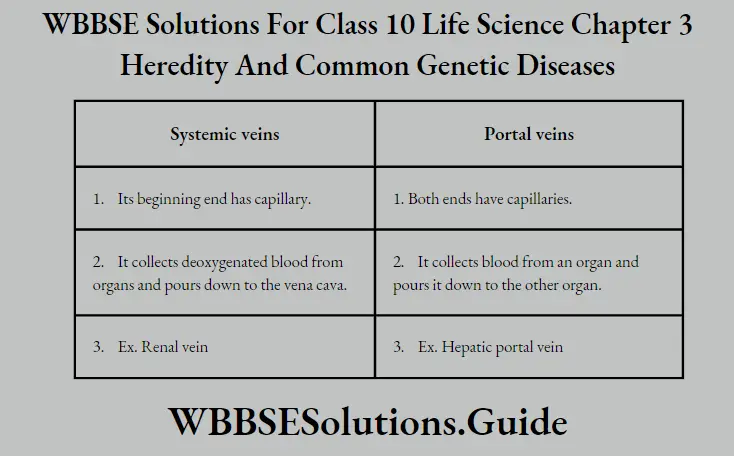
Question 195. What is double circulation?
Answer: The process of circulation which occurs in four chambers containing the heart is called double circulation.
Ex – man
Question 196. Write one structural and one functional difference between the bicuspid and the tricuspid valve.
Answer:
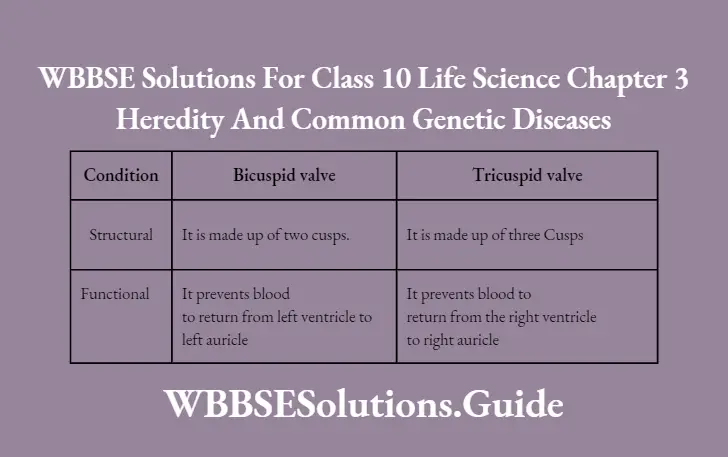
Question 197. Name the vein that carries oxygenated blood. From which part does it carry this blood and to where?
Answer:
(1) Plumonary Vein.
(2) From lungs to left auricle.
Question 198. Name the blood vessel entering the kidney and the type of blood that flows through it.
Answer:
(1). Renal artery.
(2) Urea containing blood.
Question 200. Define venous heart with an example.
Answer: One auricle and one ventricle containing a heart in which always deoxygenated blood is flowing, is called a venous heart.
Ex — Fish heart.
Question 201. Name two main respiratory pigments in animals.
Answer:
(1) Haemoglobin
(2) Haemocyanin.
Question 202. Write two reasons for the non-coagulation of blood within the blood vessels in normal conditions.
Answer:
Reasons:-
(1) Presence of heparin.
(2) Presence of intact thrombocytes
Question 203. When any part of our body is cut, why doesn’t the entire blood come out from it?
Answer: Because blood forms a clot at that place, which prevents the blood from coming out.
Question 204. Why is blood transfusion not always possible from one person to another?
Answer: Because the antigens of the donor blood do not match with the antibodies of the recipient blood. In this case, a clump is formed which blocks the blood vessels
of the recipient.
Question 205. Why does blood not clot while flowing through the vessels?
Answer:
(1) Due to the presence of an anticoagulant substance (e.g. Heparin) in the blood of blood vessels.
(2) Due to the smooth inner wall of blood vessels.
(3) Thromboplastin which is necessary for blood clotting is not produced by intact thrombocytes.
Question 206. Why is Land Steiner famous?
Answer: Land Steiner discovered the blood group.
Question 207. Why is it necessary to know an individual’s blood group?
Answer: For the safe transfusion of blood to the needy person in case of accident or other cases. It is also necessary for the selection of a proper matching pair to avoid fatal cases.
Question 208. Why is the heart of a fish called the venous heart?
Answer: A fish heart has one auricle and one ventricle. Deoxygenated blood flows within it. Hence its heart is called a venous heart.
Question 209. Why is the blood of a cockroach colorless?
Answer: The blood of the cockroach is colorless because respiratory pigments are absent in it.
Question 210. Why is the color of the plasma slightly yellow?
Answer: The color of plasma is slightly yellow due to the presence of some compounds. Such as bilirubin.
Question 211. Why do birds and mammals have separate oxygenated and deoxygenated blood?
Answer: The rate of anabolism is higher in birds and mammals they need more oxygenated blood to produce energy by the process of respiration. Their heart is made of four chambers. So, the oxygenated and deoxygenated blood do not mix. The structure of the heart helps supply oxygenated blood to the body.
Chapter 3 Heredity And Common Genetic Diseases Short Answer Questions
Question 1. Mention two criteria for classifying a mineral into macronutrients.
Answer:
(1) These elements are present in larger quantities (1-10 mg per gram dry weight of plants).
(2) They are mainly involved in the synthesis of structural components of the plants.
Question 2. Mention two criteria for classifying a mineral into a micronutrient.
Answer:
(1) These elements are present in minute quantities (0.1 mg or less per gram dry weight of plant) and are also known as trace elements.
(2) High concentrations of ‘micronutrients may prove to be toxic.
Question 3. How do minerals help in the formation of protoplast?
Answer: Formation of protoplast: Various mineral elements, such as C, H, O, S, Mg, P, N, and Fe, play a prominent role in the formation of chemical constituents of protoplasm.
Question 4. Which minerals help in the growth of plants?
Answer: Growth: Mineral elements, such as Zn, Mn, B, etc. maintain normal growth of stem and root.
Question 5. Mention two points of importance of phosphorus in plant nutrition.
Answer:
Phosphorus (P) :
(1) Plays an important role in protein synthesis.
(2) Acts as a component of ATP, NADP, and membrane of cells & other organelles.
Question 6. Mention two points of importance of iron in plant nutrition.
Answer:
Iron (Fe) :
(1) Helps in the formation of chlorophyll & chromatin reticulum.
(2) Acts as a structural element of electron carriers & helps in ion transport.
Question 7. What is transpiration?
Answer:
Transpiration
The elimination of non-utilized excess water in the form of vapor from the plant body, under the influence of sunlight, and controlled to some extent by protoplasmic called transpiration.
Question 8. Draw and label a structure of stomata.
Answer:
Question 9. What is evaporation?
Answer:
Evaporation
Evaporation is a physical process in which water changes from a liquid to a gaseous form, i.e., vapor, to the unsaturated atmosphere from the free exposed surfaces of the living and non-living bodies.
Question 10. State how light influences transpiration.
Answer: Light — Transpiration increases in the presence of light and decreases in the absence of light, as stomata open during the day and close during the night. Light influences transpiration by increasing the temperature of the leaf.
Question 11. What is cuticular transpiration?
Answer:
Cuticular transpiration — The water vapor which is lost through the pore of the cuticle of the leaves directly, is called cuticular transpiration. Some amount (10-20%) of water vapor is lost by direct evaporation from the epidermal cells through the cuticle of the leaves. Structure of cuticle.
Question 12. Draw and label a structure of lenticel.
Answer:
13. What is diffusion?
Answer:
Diffusion :
Diffusion is defined as a physical process where molecules or ions migrate from a region of higher concentration to a region of lower ‘concentration, through liquid or gaseous medium by. their random motion.
Question 14. What is root pressure?
Answer:
Root pressure
This active hydrostatic pressure created in the parenchymatous cortical cells of the roots is called the root pressure. val.
In the year 1956, Stocking defined root pressure “as a pressure developing in the tracheary elements of the xylem as a result of the metabolic activities of roots.”
Question 15. What is transpiration pull?
Answer:
Transpiration Pull :
During this a pull is created due to an increased concentration of cell sap, this pull over the water molecule forming pillar, due to transpiration is called transpiration pull.
Question 16. State the relation between absorption and ascent of sap.
Answer:
Relation between Absorption and Ascent of Sap: Unicellular root hairs absorb water and minerals (capillary water and minerals) from the soil. This water enters the cortical cells by cell-to-cell osmosis and diffusion. Hydrostatic pressure exerted by these turgid parenchymatous cortical cells helps the water to enter the xylem vessels. The transpiration pull from the leaves and the root pressure from below accounts for the ascent of sap through the xylem vessels. The continuity of the water column is maintained by the cohesion of water molecules with each other and the adhesion of water molecules with the xylem vessel wall.
Question 17. What do you mean by cohesion and adhesion?
Answer:
(1) Adhesion — Adhesion is the molecular attraction exerted between the surface of bodies in contact, i.e., the union between water molecules with the inner xylem vessel wall.
(2) Cohesion — Cohesion is the molecular attraction by which the particles of a body are united throughout the mass, i.e., the union between water molecules.
Question 18. What do you mean by permeable membrane?
Answer:
Permeable membrane — Such membrane allows all the molecules or ions of a solution (both solute and solvent molecules) to pass through it, e.g. filter paper, cell wall, etc.
Question 19. What do you mean by semipermeable membrane?
Answer:
Semipermeable membrane — Such membrane allows passage of water (solvent) molecules and positively charged hydrogen ions, but on the solute molecules nor the other positively charged and negatively charged particles, e.g. parchment
paper, air bladder of fish, egg’s membrane, etc. The semipermeable membrane can be better termed as differentially permeable, which allows the passage of some solutes but holds back others at different rates of diffusion.
Question 20. What do you mean by plant circulation?
Answer:
Plant circulation
The process by which movement of food, water, minerals, hormones, enzymes, and other substances takes place through the liquid medium of the living body by special conducting tissues xylem and phloem, is called plant circulation.
Question 21. What is osmosis?
Answer:
Osmosis :
Osmosis is defined as the physical process in which solvent molecules move from the region of higher concentration to the region of lower concentration through a semipermeable membrane, separating these two.
Question 22. Mention the role of water and sunlight in photosynthesis. Write the overall reaction of this process. Mention the role of photosynthesis in maintaining the balance of CO2 and O, in air.
Answer:
Role of water in the process of photosynthesis:—
Water is a raw material for photosynthesis. It is essential for this process. It supplies hydrogen for the reduction of CO2. Thus it takes part in glucose formation. The oxygen of water is changed into the free form of oxygen gas which comes out through the stomata.
Role of sunlight in photosynthesis :
The intensity, quality, and duration of Light influence the rate of photosynthesis. The light activates chlorophyll. Activated chlorophyll performs photolysis. Too much high-intensity light may even stop the process of photosynthesis. The inhibition of photosynthesis due to high-intensity light
which slows down its rate is called solarization. The rate of photosynthesis is directly related to the duration of light.
Equation :- 6CO2 + 12H2O→ C6H12O6 + 6H2O + 6O2
Role of photosynthesis in maintaining the balance of CO2 and 0, in the environment:—
The percentage of CO2 and O2 gas in (air and water) is maintained by photosynthesis. Autotrophs take in CO2 gas from their environment for the process of photosynthesis. They liberate O2 gas during this process. All living organisms take in O2 gas and release CO2 gas during respiration. Thus photosynthesis and respiration in a combined effect maintain the balance of CO2 and O2 in the environment.
Question 23. What is photosynthesis? Discuss the importance of the process of photosynthesis in the entrapping of solar energy in green plants and the maintenance of CO2 — O2 balance in the environment.
Answer:
Photosynthesis :
The anabolic reaction that occurs between carbon dioxide
gas and water in the presence of sunlight and chlorophyll to produce glucose is known as photosynthesis.
Equation :- 6CO2 + 12H2O→ C6H12O6 + 6H2O + 6O2
Importance of Photosynthesis:—
(1) In the entrapping of solar energy in green plants:—
The sun’s radiant energy is the only source of energy for all the living organisms of this biosphere. But this form of energy is directly utilized by green plants only. Chlorophyll which is a photosynthetic pigment only present in the grana region of the chloroplast of plant cells. Chlorophyll molecules absorb the radiant energy and change it into activated chlorophyll which splits water molecules into H+ ions and OH– ions and begins the process of photosynthesis. At the end of this process, the radiant energy is finally converted into chemical energy. This chemical energy is stored within glucose molecules. All other organisms obtain their energy from this glucose directly or indirectly. Thus by entrapping radiant energy during photosynthesis green plants supply chemical energy to the other forms of life.
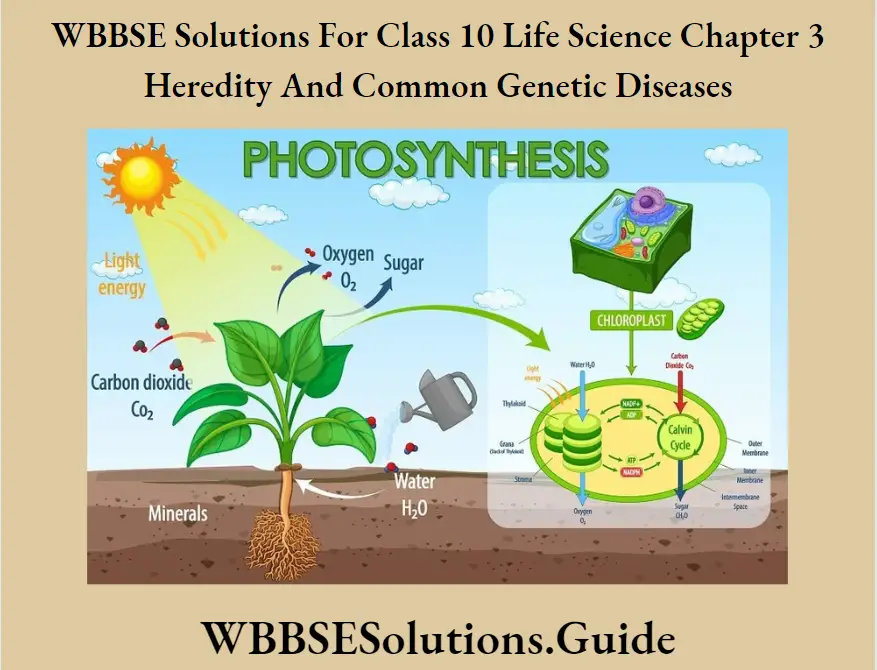
(2) Maintenace of CO2 and O, balance in the environment:—
The percentage of CO2 and O2 gas in (air and water) is maintained by photosynthesis. Autotrophs take in CO2 gas from their environment for the process of photosynthesis. They liberate O2 gas during this process. All living organisms take in O, gas and give out CO2 gas during respiration. Thus photosynthesis and respiration in a combined effect maintain the balance of CO2 and O2 in the environment.
Question 24. Explain the following reaction 6CO2 + 12H2O → C6H12O6 + 6H2O + 6O2 Where does the process related to the above reaction occur? Explain the significance of that process.
Answer:
1. Facts obtained by the reaction:-
(1) This reaction takes place in the presence of sunlight and chlorophyll.
(2) Carbon dioxide and water are reactants.
(3) Glucose, oxygen, and water are products.
(4) 6 molecules of carbon dioxide combine with 12 molecules of water to produce one molecule of glucose, 6 molecules of oxygen, and 6 molecules of water.
(5) Here water is oxidized to produce free oxygen and carbon dioxide is reduced to produce glucose.
2. This reaction occurs in the Grana and stroma region of the chloroplast of a plant cell.
3. Significance of photosynthesis:—
(1) Solar energy is entrapped and converted into chemical energy by this process. This chemical energy is stored within food (ex. glucose). This food is the source of energy for all living Autotrophs and Heterotrophs.
(2) CO, and O, balance is maintained by this process.
Question 25. Mention two differences between photosynthesis and respiration. Discuss the roles of sunlight and chlorophyll in the process of photosynthesis.
Answer:
(1) Two differences between photosynthesis and respiration:—
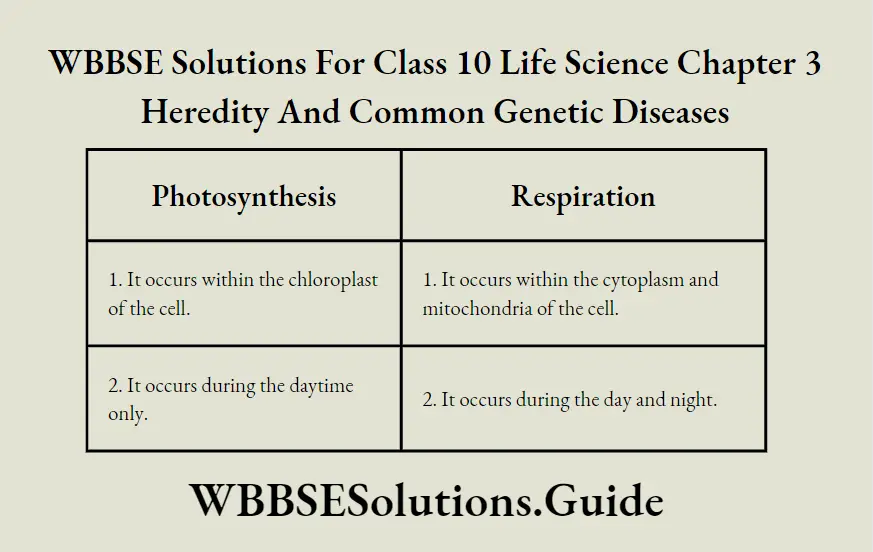
(2) Role of sunlight in photosynthesis:—
The intensity, quality, and duration of influences the rate of photosynthesis. Photolysis of water occurs in the presence of light. Too much high-intensity light may even stop the process of photosynthesis. The inhibition of photosynthesis due to high-intensity light which slows down its rate is called solarization. The rate of photosynthesis is directly related to the duration of light.
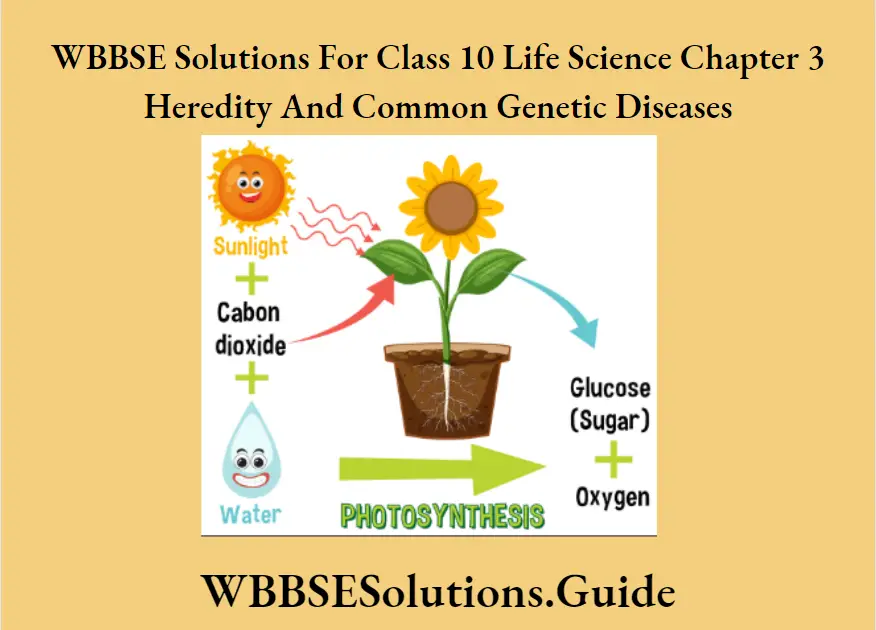
(3) Role of chlorophyll in photosynthesis:—
Chlorophyll is a magnesium-containing green pigment present in the chloroplast of green plants. The chlorophyll pigment first absorbs the incoming solar radiation. It results in the activation of the chlorophyll. Activated chlorophyll causes the dissociation of water. Hence chlorophyll helps in the photolysis of water.
Question 26. Describe briefly the process of photosynthesis.
Answer:
Process of Photosynthesis:—
The process of photosynthesis is completed in two main phases:—
Light Phase:—
This is the 1st phase of photosynthesis. It occurs in the grana
region of chloroplast. Light energy is necessary for the beginning of this phase.
This phase is divided into two parts:—
(1) Photolysis of water:—
When sunlight falls on the surface of the green leaves of plants, some part is absorbed by chlorophyll molecules, and the remaining part is reflected from the surface to the environment. The chlorophyll molecules are changed into activated chlorophyll after the absorption of light. Activated chlorophyll splits water molecules into H+ ions and OH ions. OH– ion loses one electron and is converted into OH radical. This OH radical is changed into water and oxygen gas. Water again takes part in metabolic reaction and oxygen comes out to the environment through stomata. H+ion gains one lost electron of OH– ion and is changed into a neutral hydrogen atom. It combines with NADP (Nicotinamide Adenine
Dinucleotide Phosphate) and reduces it into NADPH, At the end of this reaction, the activated chlorophyll molecule resumes its original state.
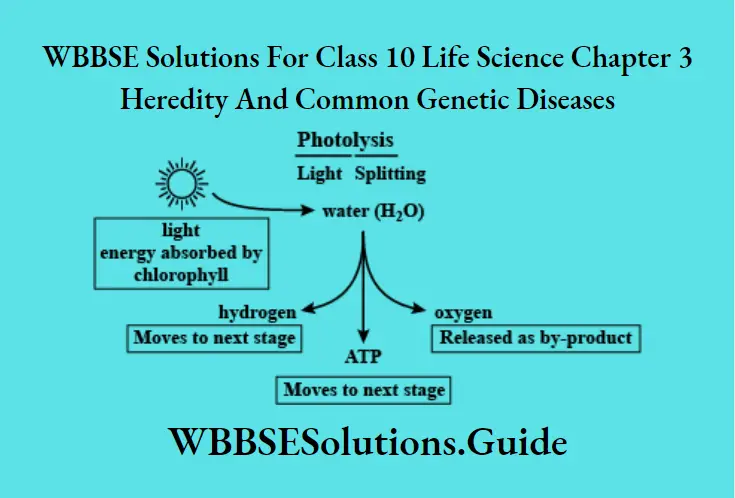
(2) Photophosphorylation:—
The tet formation of ATP in the presence of sunlight by Ree the combination of ADP and inorganic HeOGyatcy, Oe phosphorus is called photophosphorylation.
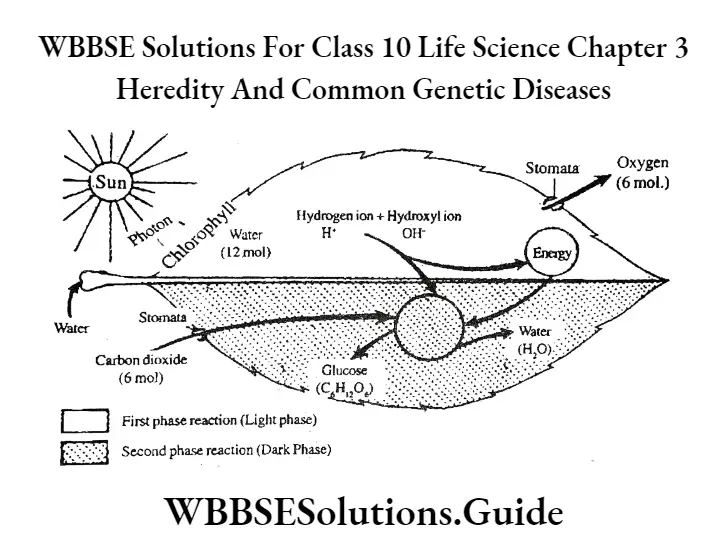
Dark reaction:-
This is the second and last phase of photosynthesis. It occurs in the stroma region of the chloroplast. It takes place after 1/1000th second of the end of the light phase. Light energy is not necessary for the beginning of this phase.
Ribulose Diphosphate (5-carbon organic compound) is already present in the stroma region. It combines with CO2 and forms a six-carbon unstable compound (C6H12O13P2,).
This unstable compound forms two molecules of the 3-carbon compound in a very short interval of time. The name of this 3-carbon compound is phosphoglyceric acid (PGA). It reacts with ATP and is converted into 1, 3 Diphosphoglyceric Acid (PGA).
DiPGA reacts with NADPH2 and forms 3, Phosphoglyceraldehyde (PGAID). Now the two molecules of phosphoglyceraldehyde react and form one molecule of Fructose Siphosphate.
Fructose Diphosphate forms one molecule of glucose phosphate and in the last one molecule of glucose is produced from one molecule of glucose phosphate.
Light Phase:
(1) Sunlight →Chlorophyll → Activated chlorophyll
Activated Chlorophyll → H2O →H+ + OH–
NADP + 2H = NADPH2, 4OH + 2H2O + O2
ADP + iP + energy = ATP
Dark Phase:
RuDP + CO2 = 6 carbon unstable compound
5C 1c
6 carbon unstable compound →2 molecules of PGA
(3C)
PGA + ATP > DiPGA (3C)
DiPGA + NADPH, → PG.Ald. (3C)
2DipGAld — Fructose Diphosphate
Fructose Diphosphate — Glucose phosphate
Glucose phosphate — Glucose.
Question 27. Write a short note on the role of photosynthetic pigments in the process of photosynthesis.
Answer:
Pigments — Chlorophyll and Carotenoids 3 The main photosynthetic pigment is chlorophyll.
Role — The photolysis of water during the light phase of photosynthesis is caused by excited chlorophyll molecules. The cause of their excitation is the absorption of highly energized invisible solar particle photons. H2O → H+ (Hydrogen ion) + OH– (Hydroxyion).
The entrapping of solar energy and its conversion to Genie energy in the form of ATP (Adenosine tri-phosphate) is carried out by activated chlorophyll molecules.
Plant pigments :
Plants may contain two types of piel seins green coloured ee chlorophyll and yellowish orange coloured carotenoid.
(1) Chlorophylls are of two types—Chlorophyll a(C55H72O5N4Mg) and Chlorophyll b(C55H70O6N4Mg), Chlorophyll c, d and e are also present. Chlorophyll atoms are arranged in a circle with the help of four pyrrole rings with the Mg atom at the center. Along with the pyrrole ring is attached phytol (a type of alcohol).
(2) Carotenoids are of two types—Carotene (C40H56)—the orange-colored can’t Xathophyll. (C40H56O2)—the yellow-colored pigments.
(3) Phycocyanin — the blue colored and Phycoerythrin — the lavender rec colored pigments.
II. Carotenoids :
Carotenoids are yellow, brown, orange, or yellow pigments found in close association with chlorophylls in all photosynthesizing cells. They occur in thylakoids and act as accessory pigments of photosynthesis. They are present in nearly all higher plants, algae, and some microorganisms. Goodwin (1960) suggested that the chlorophylls and carotenoids may be attached to the same protein, forming a complex known as phosynth.
Carotenoids are of two types:
(1) Carotenes — They are orange to yellow and are unsaturated hydrocarbons (C40H56). They are insoluble in water but readily soluble in chloroform ether and carbon disulfide. They absorb blue and green lights and transmit yellow and red lights. Four isometric forms of carotenes are now recognized. α, β, γ, and δ of which β-carotene is most common in all green plants.
(2) Xanthophylls or Carotenols — They are yellow with the empirical formula C40H56O2. In normal green leaves, proportionately there is more xanthophyll than carotene. The most common xanthophyll in green leaves is luteol or lutein.
Apart from their role in the absorption of light energy and its transfer to chlorophyll, the carotenoids play a very important role in protecting chlorophyll molecules from
photo-oxidation within the photosynthetic apparatus.
Question 28. Write a short note on the absorption and action spectra of photosynthesis.
Answer:
Absorption Spectrum :
All organic substances absorb light, but colored pigments absorb only visible light. The absorption spectrum is the pattern of absorption of light at the different wave, lengths by the object. Studying the absorption spectrum of chlorophyll a and b, it is revealed that these pigments absorb red and blue regions of spectra chiefly.
The plot of efficiency with which the different pigments like chlorophyll-a and chlorophyll-b absorb different wavelengths (or color) of light in the region of blue-violet, with peaks about 429 and 453 m µ respectively and the next maximum is in the red region of about 642 m µ and 660 m µ respectively, is called the absorption spectrum.
The carotenoid pigments play a role in photosynthesis by absorbing light and passing it to chlorophyll where it is used in the photosynthetic process.
Absorption spectra are one of the properties of chlorophyll, during which they can absorb certain wavelengths of light. When the chlorophyll solution is kept in between ordinary light and a spectrometer, then it is observed that certain wavelengths of light are absorbed more than others. Maximum absorption of chlorophyll-a and chlorophyll takes place in the blue-violet region and the next maximum in the red region.
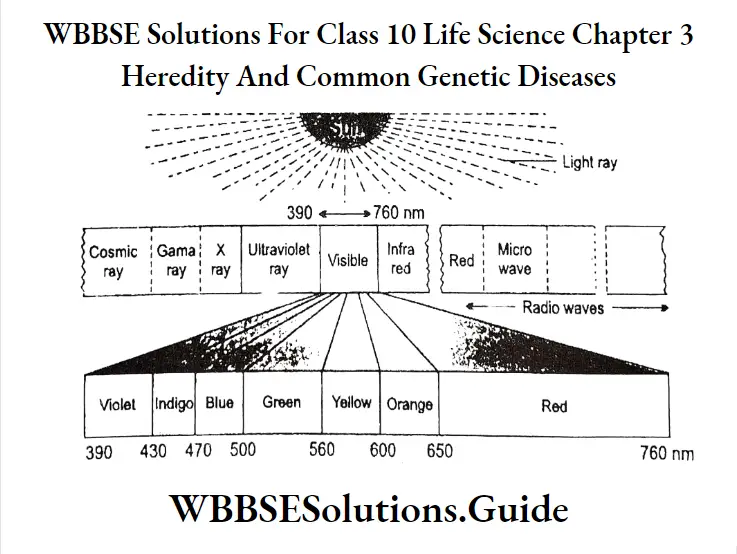
Action spectrum of photosynthesis :
When a beam of sunlight is passed through a glass prism the following colors are visible- violet, indigo, blue, green, yellow, orange, and red. The above component colors of light possess their range of wavelength. By utilizing the above component wavelengths of white light, it is possible to find out which wavelengths or colors of light help to run the process of photosynthesis most effectively and efficiently. A pattern can be drawn without any trouble by plotting the effectiveness of each wavelength of light that stimulates photosynthesis. Such a plot of the photochemical effect caused by equal energies of various wavelengths of light is called an action spectrum. This spectrum shows that blue and red light regions of the spectrum help to run the photosynthetic process more effectively.
Question 29. Write a short note on the site of photosynthesis.
Answer:
Site of photosynthesis :
The process of photosynthesis occurs within the chloroplastids of the mesophyll cells of green leaves. It also occurs in the chlorophyllous tissue of green-colored young stems, calyx of flowers, phylloclade of cacti fruit coat of young fruits, and aerial roots of orchids. It may also occur in lower plants like algae, bryophytes, and photosynthetic bacteria. It even occurs in the cells of certain protozoa, like Chrysamoeba and Euglena.
The leaves are the best site for photosynthesis. These are flattened structures having more surface area for trapping greater amounts of solar energy and absorbing CO2 from the air. Closely arranged cells of mesophyll tissue, which are the site of photosynthesis, are present in the leaves.
Question 30. Define nutrients. Differentiate between macro and micronutrients.
Answer: The organic and inorganic materials that provide energy to the body and keep the body in good and healthy condition are called Nutrients. All nutrients are food, but all foods are not nutrients.
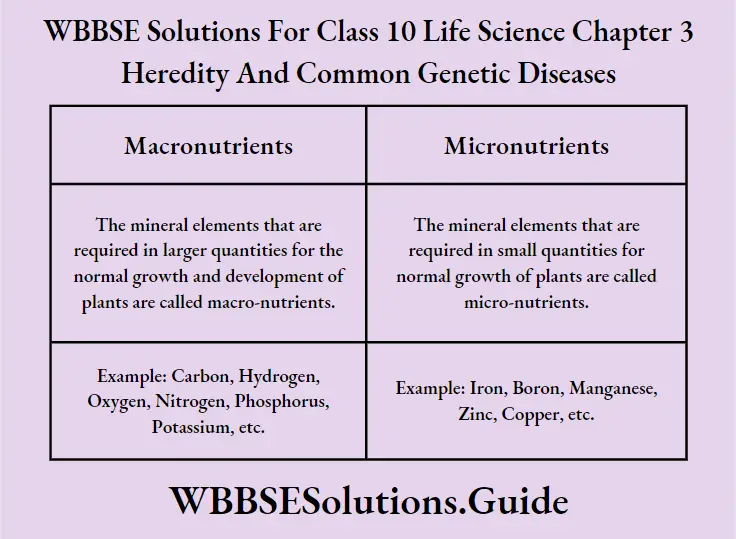
Question 31. What are the general functions of essential mineral elements?
Answer:
General functions of essential mineral elements
(1) Formation of protoplast — Certain elements play an important role in the formation of constituents of protoplasm like C, H, O, N, S, etc.
(2) Structure of enzymes — Elements like C, H, O, N, Mg, Fe, Zn, and Cu are involved in the formation of enzymatic components and their functions.
(3) Oxidation — Reduction reaction — elements like Iron and copper take part in electron transfer.
(4) Gsmotic balance — Inorganic salts in the cell sap like Cl–, K+, PO4-3, and SO4-2 are involved in maintaining the osmotic balance of the cell.
(5) Formation of chlorophyll — Magnesium is the chief component of chlorophyll.
(6) Buffer effect — Phosphate, bicarbonate, and carbonate act as buffers.
Question 32. Mention the functions of macro- and micro-elements in plants.
Answer:
(1) Potassium – Regulates intracellular fluid volume. Permeability of cell membrane Chlorophyll synthesis. Activator for many enzymes.
(2) Calcium – Constituent of middle lamellas up. An important role in ion transport. Act as an activator for enzymes.
(3) Carbon – Constituent of protoplasm, cell wall, and cell materials.
(4) Oxygen stra – Required for aerobic respiration
(5) Nitrogen – Constituent of protoplasm and almost all cellular materials, amino acid, protein, enzymes, nucleic acid, etc.
(6) Hydrogen – Constituent of protoplasm
(7) Sulphur – Constituent of protoplasm, some protein and vitamins.
(8) Phosphorus – Constituent of protoplasm, Nucleic acid, Nucleoprotein, Phospholipid, etc.
(9) Magnesium – Constituent of chlorophyll, an activator of many enzymes of photosynthesis, respiration, and nucleic acid synthesis.
(10) Manganese an important role in chlorophyll synthesis, and activates many respiratory enzymes.
(11) Boron – Help in translocation of sugar, active salt absorption, Murillo
(12) Copper – Constituent of oxidizing and reducing enzymes highly toxic in higher concentrations.
(13) Molybdenum – A component of enzyme, plays an important role in nitrogen metabolism.
(14) Zinc – Required for synthesis of auxin IAA.
Question 34. What is the significance of nutrition?
Answer:
Significance or Importance of Nutrition:
(1) promote growth, repair wear and tear of the damaged tissues, and gain energy to control the different metabolic processes are the main functions of nutrition.
(2) Through nutrition the potential energy stored within food is transformed into usable energy. The different physiological functions of the living body like movement, locomotion, excretion, reproduction, etc. are controlled by utilizing this energy.
(3), Through nutrition the disease-resistant power of the living body is developed.
(4) Through nutrition future food matters are stored within the living body. From those stored food (in the plant body mainly as starch and in animals as glycogen and fat) the future energy is produced during shortage of food.
(5) Nutrition plays a special role in the production of heat energy in the animal body to meet the caloric demands of an individual.
Question 35. Mention the general functions of essential mineral nutrients in plants.
Answer: The general functions of essential mineral nutrients are —
(1) Formation of protoplasm :
The formation of a major part of the protoplasm in a living cell needs mineral elements like carbon, hydrogen, and oxygen. Nitrogen, sulfur, and phosphorus also take part in the formation of protoplasm.
(2) Structure of enzyme :
Some mineral nutrients act in the formation of the structure of enzymes (act as catalysts) in many precursors. Some mineral elements like magnesium, ‘manganese, cobalt, etc. perform the functions of activators on inhibitors in the system of enzymes. Phosphorus helps in the formation of coenzymes like NAD, NADP, FAD, ATP, etc. Mg, S, and K, ct as an activator of enzymes.
Copper is a component of certain enzymes (i.e., phenolases, laccase, and ascorbic acid) oxidases sulfur contains coenzyme A. Calcium is an essential part of amylase, an enzyme that helps in starch digestion. Iron is noted in enzymes like peroxidases and catalases. Manganese helps in the formation of the enzymes decarboxylate and oxidase is citric acid.
(3) Oxidation-reduction reaction :
Oxidation is simply regarded as a chemical reaction with oxygen (loss of electrons). The reverse process of loss of oxygen is called reduction. Reaction with hydrogen is also regarded as reduction (gain of electrons).
(4) Osmotic balance :
Certain mineral nutrients counteract the poisonous effect of some other elements by maintaining the osmotic balance (an ionic balance). The behavior of one ion in reversing the normal effect of another ion is called antagonism. To this group of elements lies Ca, Mg, and K. They are termed balancing elements, whereby osmotic balance is maintained.
(5) Formation of Chlorophyll :
Magnesium and nitrogen play a great role in the formation of chlorophyll, the green pigments in plants. Iron takes part in chlorophyll synthesis.
(6) Buffer effect :
The effect produced when a solution resists change in pH when an acid or alkali is added or when the solution is diluted is called the buffer effect.
The mineral nutrients play a great role in the pH of all sap. Some of the vital buffer systems in an organism’s body are the carbonate-bicarbonate system and phosphate
buffer.
Question 36. What are the criteria for classifying mineral nutrients into macronutrients? and micronutrients?
Answer:
To categorize mineral nutrients as macronutrients or micronutrients, they should fulfill certain criteria. These criteria are discussed below.
Criteria for macronutrients :
(1) These elements are present in larger quantities (1-10 mg per gram dry weight of plants).
(2) They are mainly involved in the synthesis of structural components of the plants.
(3) They also participate in maintaining the osmotic potential of the plants.
Criteria for micronutrients :
(1) These elements are present in minute quantities (0.1 mg or less per gram dry weight of plant) and are also known as trace elements.
(2)High concentrations of micronutrients may prove to be toxic.
(3) They participate in the electron transport mechanism and act as cofactors for various enzymes.
Question 37. What are the different types of transpiration? Or, Classify transpiration based on its site of occurrence.
Answer: Based on the type of plant organs through which water is lost, there are three kinds of transpiration, viz. cuticular, lenticular, and stomatal.
I. Cuticular Transpiration
The physiological process of loss of water in the form of water vapor through the cuticle of the exposed surface of plant organs is known as cuticular transpiration.
The cuticle is a waxy layer on the leaf covering the epidermis and preventing transpiration. However, there are some scattered pores present in the cuticle which results in
the loss of water all through during the day and night.
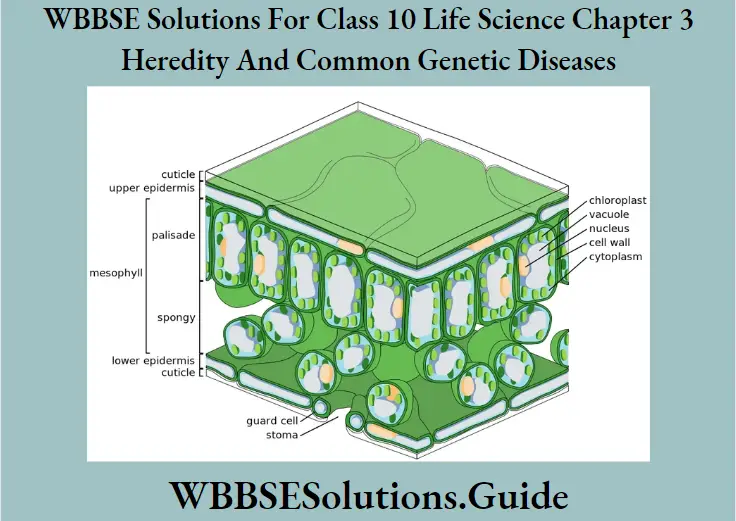
II. Lenticular Transpiration
The physiological process of water loss in the form of water vapor through the lenticels of woody stems and fruit walls is termed lenticular transpiration.
Structure of lenticel :
Lenticels are minute lens-shaped pores present in the secondary epidermis (periderm) of woody stem and fruit walls. They are constituted of a loose mass of complementary cells and intermediate air spaces. The minute opening of the lenticel always remains open because of the absence of guard cells.
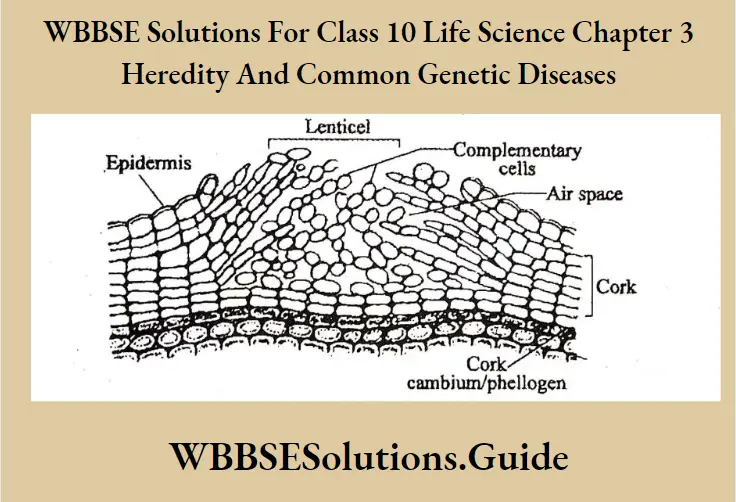
III. Stomatal Transpiration
The process of loss of water in the form of water vapor through the openings of stomata is termed stomatal transpiration. It accounts for 80-90% of transpiration in plants.
The stomata is a simple opening, guarded by guard cells, they have a sub-stomatal chamber surrounded by subsidiary cells.
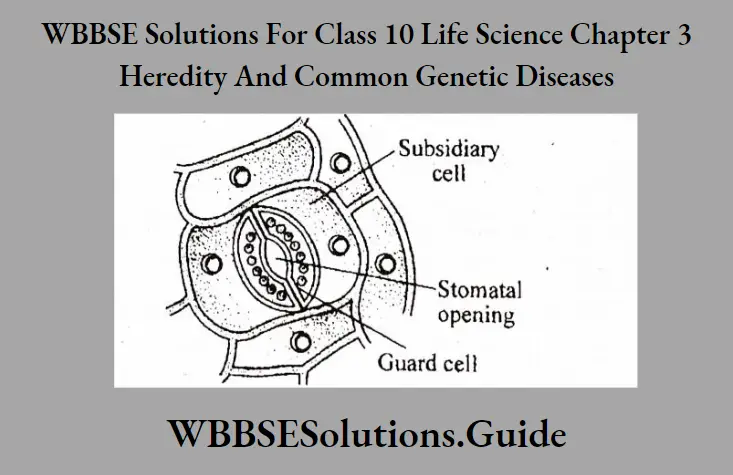
1. Distribution of stomata:
Stomata is present in the leaves, and also in the young stems, floral parts, and fruit walls of opening angiosperms except in submerged hydrophytes. It is also present in the leaves of pteridophytes and even in mosses.
Question 38. What are the beneficial and harmful effects of transpiration?
Answer:
Beneficial effects of transpiration :
[1] Ascent of sap :
By transpiration, water and minerals reach the top leaves of trees.
[2] Elimination of excess water :
By transpiration, excess water from the plant body is removed. It eases the physiological activities within the cells.
[3] Cooling plant body :
By this process, the latent heat of evaporation is lost from the plant body.
Harmful effects of transpiration :
[1] Drying of leaves and twigs :
Excess transpiration reduces water content in plant cells. As a result, leaves and softer parts of plants become dry.
[2] Wilting :
In case of excess transpiration, the cells lose turgidity and shrink. As a result, leaves and tender branches droop. This is called wilting. If the whole plant wilts and remains in that state for several hours, it may die.
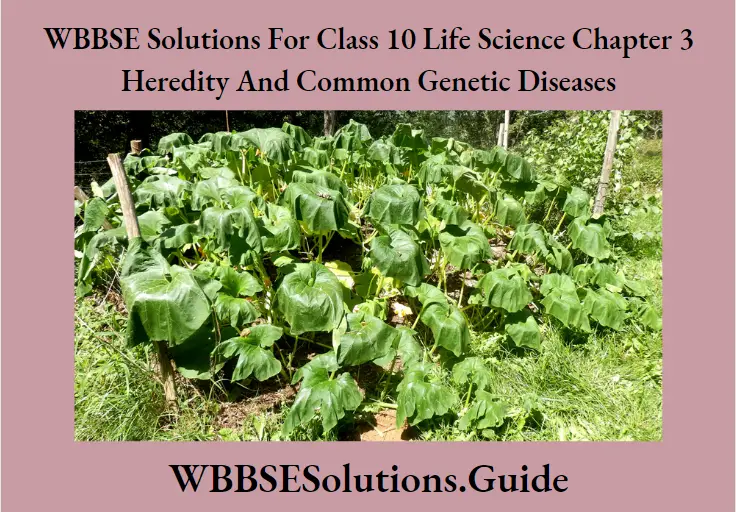
So, Curtis described the transpiration process as a “necessary evil” for the plants.
Question 39. Define plant circulation. Mention the medium of circulation.
Answer:
Plant Circulation :
The process by which the movement of food, water, and minerals takes place through the special conducting tissue like the xylem and phloem is called plant circulation.
The medium of circulation in plants is water.
Question 40. Differentiate between Diffusion and Osmosis.
Answer:
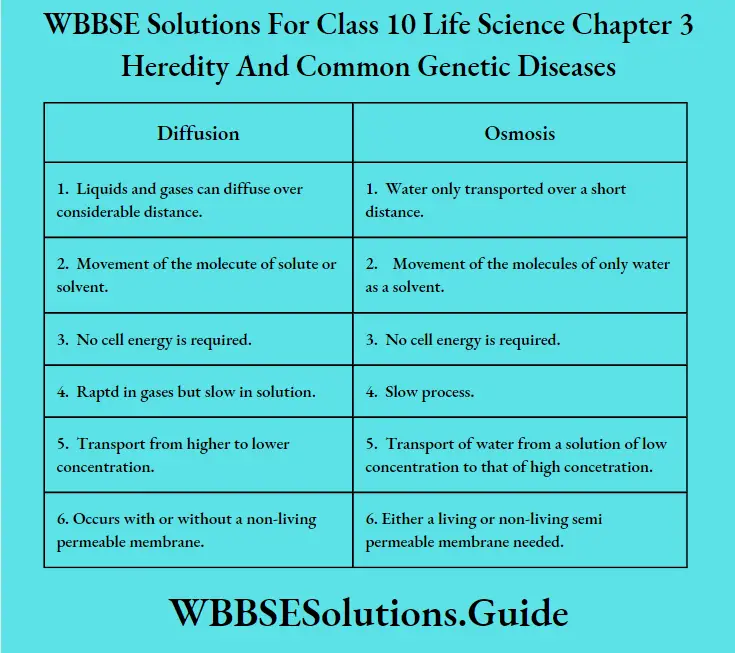
Question 41. Define active transport. Write the steps of active transport.
Answer:
Active Transport :
Active transport is the passage of a substance from its lower to higher concentration, using energy from the cell, through a living cell membrane. The transport of matter in the form of ions or molecules across the cell membrane utilizing metabolic energy is called active transport.
The process of active transport through carriers has the following steps —
It takes place against a concentration gradient, i.e., from lower to higher concentration. On the outer surface of the cell membrane substrate binds to the membrane protein carrier. The
carrier—substrate complex thus formed moves across the cell membrane. Reaching the inner surface of the cell membrane, the carrier substrate complex breaks. The molecules or ions are released and enter cells. The carrier returns to its original state and is free to accept other ions or molecules.
Question 42. Define the Ascent of Sap. Describe the factors affecting the ascent of sap.
Answer:
Ascent of Sap :
The transport of water and minerals from root to leaves through the xylem vessel, against the force of gravity is called the ascent of sap.
Factors:
(1) Root pressure :
The pressure develops in the roots due to the inflow of water, which helps in pushing the plant sap upward.
Root pressure is built up due to cell-to-cell osmosis in the root tissue. As one turgid cell presses the next cell, the force of the flow of water increases inward. When water
reaches the xylem vessels, it enters the pores of their thick walls with considerable force. Thus the root pressure is one of the forces to raise water through the stem into the leaves.
(2) Adhesion — Cohesion theory :
Water molecules remain attached by cohesive force and tend to adhere to the inner wall of the xylem vessel by adhesive force. The combined effect of these forces develops the continuation of water molecules in the xylem vessel, which extends from the roots to the stomata of leaves.
(3) Transpiration pull :
As the water is lost from the leaf surface by transpiration, more water molecules are pulled up due to the tendency of water molecules to remain joined and thus produce a continuous column of water through the stem.
Question 43. Write the concept of cell-to-cell transport.
Answer:
Concept of cell-to-cell transport
The process of transfer of water and other substances from one cell to another cell is called cell-to-cell transportation. It takes place by diffusion, osmosis, or active
transport methods.
Gases like O2 and CO2 move from one cell to another by diffusion process. Water passes by the osmosis process. Sugar is transported from the leaf to other parts by phloem tissue by
the active transport methods.
Question 44. Define translocation. Explain the mechanism of transportation of food in plants.
Answer:
Translocation :
The process of movement of water-soluble sugar from the leaves to other parts of the plant through phloem tissue is called translocation.
Mechanism :
Munch Mass Flow Hypothesis — According to Munch, leaves act as a source of food and have a higher concentration of food. From the leaves, it easily reaches the region of lower concentration with the help of diffusion pressure.
Various steps of translocation are —
(1) leaves as the supplying cells and the root as the receiving cells of any plant. The connecting link between leaves and roots can be represented by xylem and phloem tissue.
(2) Carbohydrates are continuously synthesized in mesophyll cells of leaves. The suction pressure of these cells increases, due to which water from adjoining cells is absorbed. This allows the movement of dissolved food into a sieve tube.
(3) Since the food is actively transported, it requires energy in the form of ATP. During active transport, a sieve tube of phloem tissue is located at the source (leaf) and unloaded at the sink (root) or consumption end.
Question 45. What are the types of Osmosis? What are the types of membranes?
Answer:
Types of Osmosis :
About any living cell, osmosis may be of two types—
(1) Endosmosis — The process by which the solvent molecules from outside enter into the cell, is known as endosmosis.
(2) Exosmosis — The reverse process of endosmosis which involves the exit of solvent molecules from the cell, is known as exosmosis.
Nature of membranes :
According to physical properties, the membranes are of three types.
(1) Permeable membrane—Such membrane allows all the molecules
or ions of a solution (both solute and solvent molecules) to pass through it, e.g., filter paper cell wall, etc.
(2) Semi-permeable membrane — Such membrane allows passage of water (solvent) molecules and positively charged hydrogen ions, but not the solute molecules nor the other positively charged and negatively charged particles, e.g., parchment
paper, air bladder of fish, egg’s membrane, etc. The semi-permeable membrane can be better termed as differentially permeable, which allows passage of some solutes, but holds back others at different rates of diffusion.
(3) Impermeable membrane — It does not allow either the solute or the solvent molecules to pass, e.g. rubber sheet, or plastic sheet.
A membrane that permits certain substances to pass through more easily than the other is said to be selectively permeable.
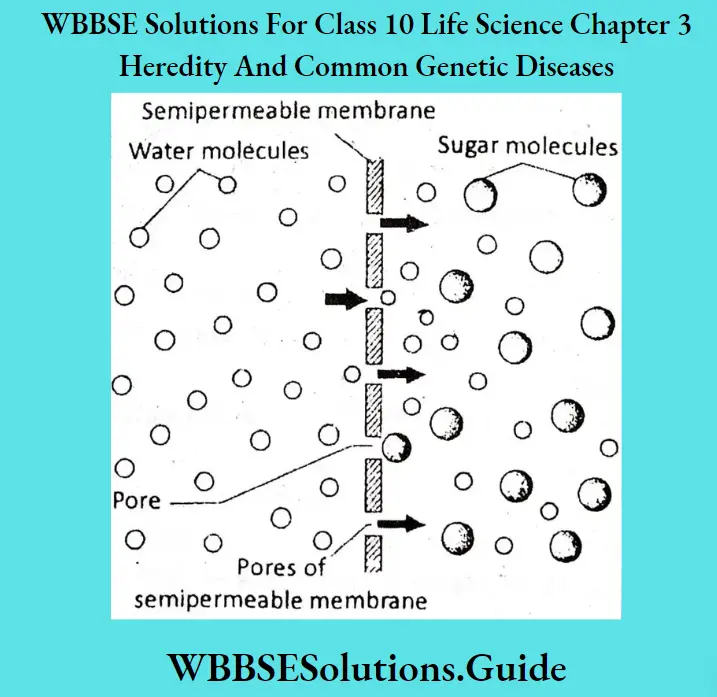
Question 46. Distinguish between upward circulation and downward circulation.
Answer:
Difference between Upward circulation and Downward circulation :
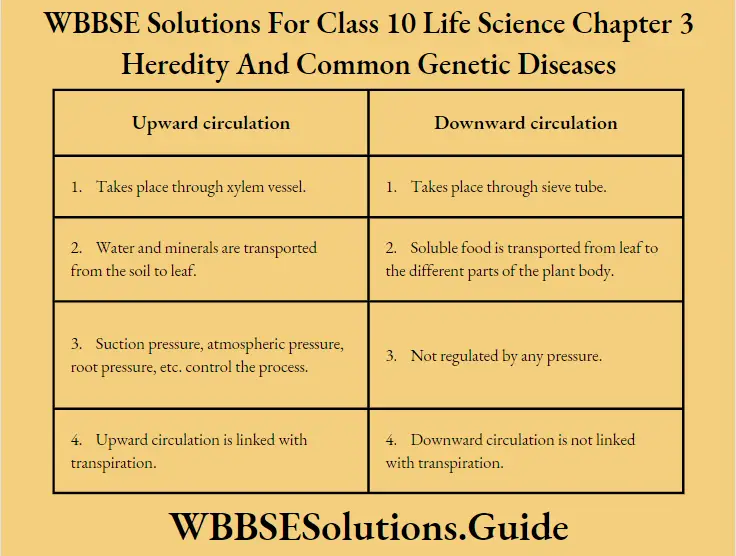
Question 47. Explain the movement of gases in plants.
Answer:
Movement of gases in plants
Photosynthesis in plants involves the intake of carbon dioxide and disposal of oxygen. During respiration plants use oxygen and give out carbon dioxide. In plants, there is no respiratorganizeriser: The elaborate liquid transport system cannot be used in the transport of gases. The leaves are well adapted to carry out gaseous exchange during photosynthesis. The rate of respiration in roots, stems, and leaves of plants is lower than that of animals. In the leaf and stem of plants the living cells are located close to the surface. The loosely arranged parenchyma cells with intercellular spaces in leaves, stems and roots provide an interconnecting system of air spaces. The diffusion of gases is faster through the air than through water. So diffusion of oxygen and carbon dioxide takes place rapidly through the interconnecting system of intercellular air spaces. These gases also pass through the cell wall and plasma membrane by a diffusion process. Aquaporin channels in the plasma membrane help in diffusion across the membrane.
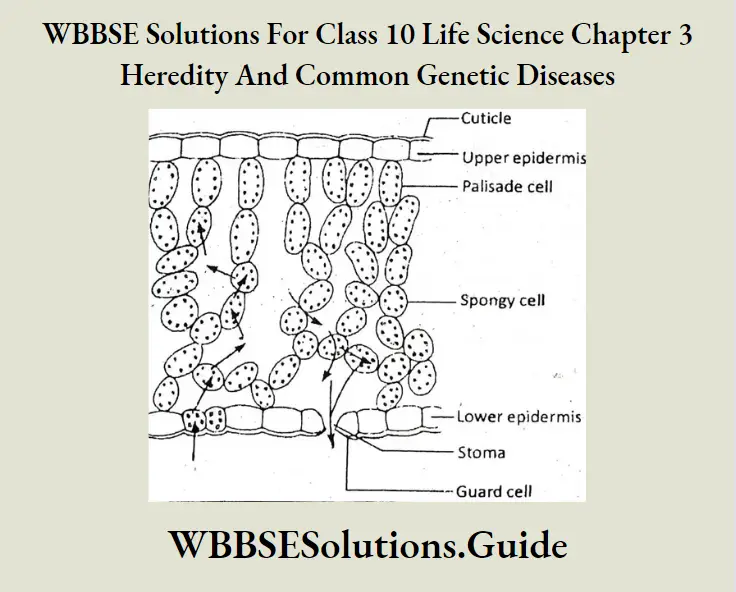
[1] Absorption of gases by leaves :
Gaseous exchange in leaves takes’ place through stomata when light falls on a leaf. These openings remain open in the morning and close during the night. This happens due to a change in the turgor of the guard cells. Guard cells possess a thick and elastic inner wall. When turgor develops the outer thin wall of the guard cell extends out forcing the inner walls into a crescent shape, resulting in the opening of the stomata.
Again, loss of turgor causes inner walls to regain their original shape resulting in the closing of stomata. During the day when osmotic pressure in the lower epidermal cells remains constant and the osmotic pressure of guard cells increases then the stomata open. In the evening stomata closes when the osmotic pressure of guard cells drops to nearly that of surrounding cells.
[2] Absorption of gases by Roots and Stems :
The dead cork cells present in mature roots and woody stems contain a waterproof substathathich makes the cork impervious to oxygen, carbon dioxide, and water.
Question 48. Explain the mechanism of cell-to-cell transport.
Answer:
Mechanism of cell-to-cell transport
The process of transfer of water & other substances from one cell to its neighboring cells, is known as cell-to-cell transport. This occurs either by diffusion or osmosis or by active transport.
[1] Diffusible materials like O2, CO2, etc. move from one cell to the next by diffusion.
[2] Water passes from one cell to another by cell-to-cell osmosis.
[3] Sugar is loaded into the phloem cells from the leaf cells by water-rich cells with means of active transport. Through this process, the food cell’s less water material is transported to all parts of the plant’s body.
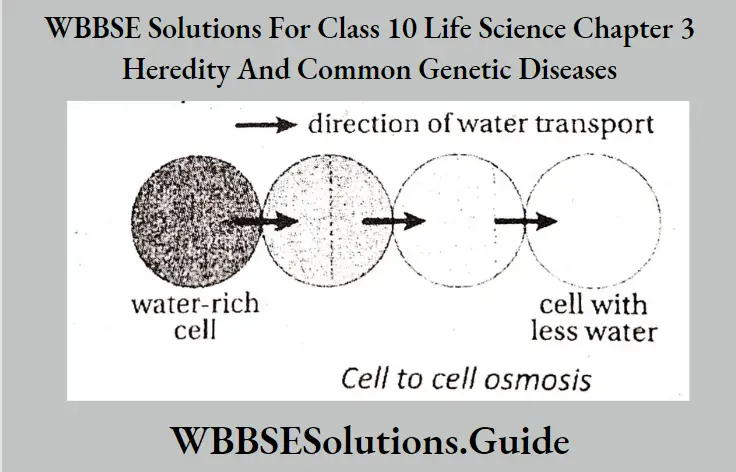
Question 49. What are the different steps in the ascent of sap?
Answer:
Steps in ascent of sap :
Transpiration is the process that acts as a driving force for the ascent of sap, from roots to the top of a tall tree via xylem elements. The sequence of events during the ascent of sap occurs in the following order.
[1] Evaporation of water through stomata, _”aspiration pull
[2] Lowering of turgor pressure of leaf cells.
[3] The cells uptake water from the xylem elements.
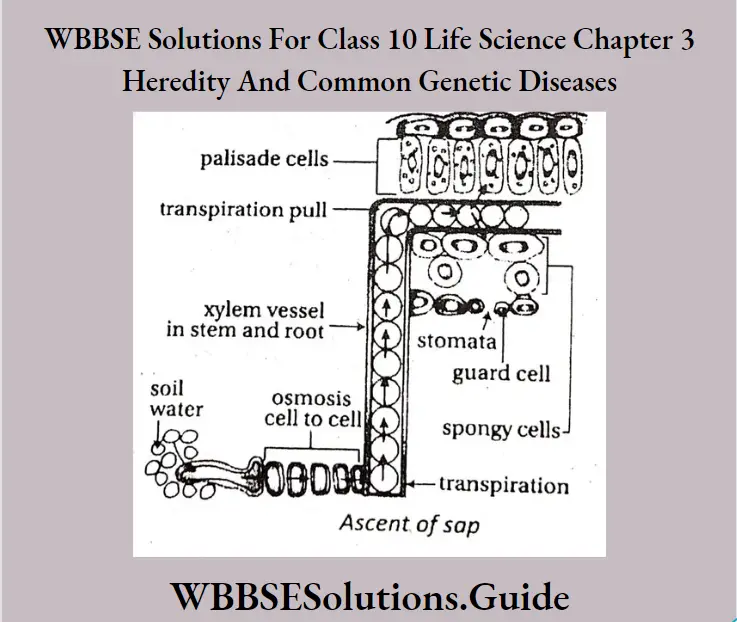
[4] The aylenivesel cohesive and adhesive forces of water molecules maintain the water column within the xylem vessels.
[5] Roots absorb water and minerals from the soil water cell to cell} spongy cells by transpiration imbibition and endosmosis, which Saran moves through the endodermis and reaches the xylem vessels. scent of sap
Question 49. Explain the process of transportation of food in plants.
Answer:
Transportation of food in plants :
Transportation of food in plants occurs through a sieve tube of phloem. Regarding the mechanism of this process, the pressure flow hypothesis by Ernst Munch is the most accepted one. According to this hypothesis, the following events occur during food transport in plants.
Transfer of food from mesophyll tissue to sieve tube :
In water and food mesophyll tissues, glucose produced by photosynthesis is soon converted into a larger sugar (sucrose). The sucrose solution is then transferred into the sieve tube via bundle sheath cells, phloem parenchyma, and companion cells by cell-to-cell transport.
Creation of pressure within the sieve tube :
With the entry of sucrose, the cytoplasm of the sieve tube becomes more dense. As a result, a concentration gradient develops between the sieve tube & neighboring xylem vessels. Due to this, water moves into the sieve tube from xylem vessels by osmosis, thereby, creating oc ’ additional pressure within the sieve tubes.
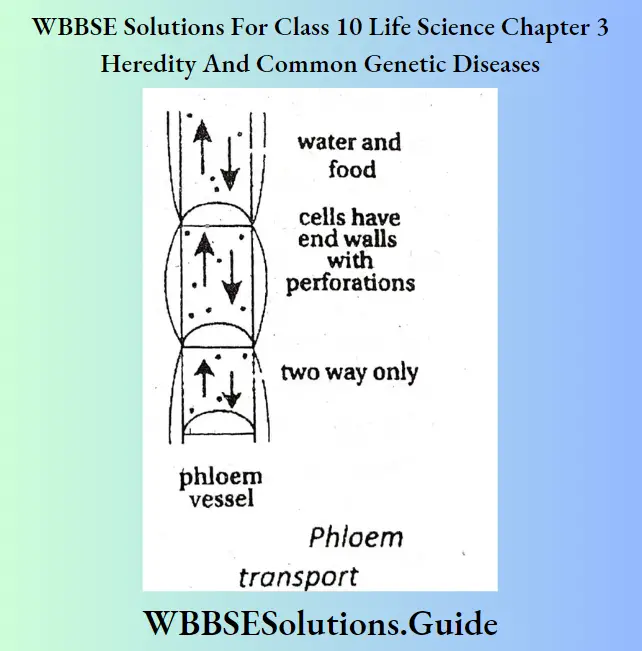
The flow of food :
This mounting pressure produced within the sieve tubes pushes the food solution down to different parts of the way only
the plant body. Finally, the sucrose solution enters into the tissue cells from the sieve tube. fiber According to another concept, some fin contractile protein fibril vessels
extend along the sieve tubes through the sieves. These fibrils contract and expand continuously to drive the food solution through a sieve tube.
Question 50. Mention the role of osmosis in plant circulation.
Answer:
Role of osmosis —
(1) Osmosis helps in the entry of water molecules from the soil into the root hair.
(2) The water molecules from the root hair cross the cortex of the root and come to the endodermis by the process called cell-to-cell osmosis.
(3) Osmosis is essential for making the cells turgid. Such turgidity is necessary for the enlargement of meristematic cells, growth of organ rigidity, and flaccidity of guard cells necessary for opening and closing of stomata.
(4) Osmosis in plants directly controls the dehiscence of other lobes, fruits, etc.
(5) Small weak herbs can stand erect due to an increase in turgidity of the cells in the stem by endosmosis.
(6) In unicellular organisms and simple multicellular ones, osmosis plays the most important role in the entry of water from the surroundings and the maintenance of water balance. (6) In higher animals, continuous exchange of water through osmosis takes place amongst blood, tissue fluid, tissue cells, and lymph in the capillary bed and this is very important in regulating the water balance in higher animals.
(7) Various plant movements are largely due to osmotic phenomena.
Question 51. Define transpiration. Mention the sites of transpiration.
Answer:
Transpiration :
The loss of water as water vapor from the aerial parts of the plant is called transpiration.
Transpiration is a very useful process for the plants for two reasons :
one, to get rid of the excess water absorbed, and two, for cooling the plant in hot weather.
Transpiration takes place in plants from three different regions :
(1) From the leaves through the stomata (Stomatal transpiration)
(2) Directly from the surface of the leaf and stem (Cuticular transpiration)
(3) From the lenticels which are the minute openings on the surface of the old stem (Lenticular transpiration).
Question 52. Name the factors controlling transpiration.
Answer:
(1) Temperature :
An increase in temperature allows more water to evaporate and a decrease in temperature reduces evaporation.
(2) Humidity :
Transpiration is reduced if the air outside is humid. High humidity in the air reduces the rate of outward diffusion of the internal water vapor across stomata, thereby reducing the rate of transpiration.
(3) Air movement (Velocity of wind) :
Transpiration increases with the velocity of the wind. If the wind blows faster, the water vapor released during transpiration is removed faster.
(4) Light :
During the day, the stomata are open to facilitate the. inward diffusion of CO, for photosynthesis. During the night they are closed. Therefore, more transpiration occurs during the day.
(5) Structure of leaf :
Narrow leaves, fewer stomata, rolled or folded leaves, and covering of leaves through the cuticle and sunken stomata reduce the loss of water in the transpiration process.
Question 53. Mention the significance of transpiration.
Answer:
(1) Elimination of excess water from the plant body.
(2) Evaporation reduces the temperature of the leaf surface and causes a cooling effect in hot summer days.
(3) Transpiration helps in the ascent of sap by producing a suction force acting from the top of a plant.
(4) It helps in the distribution of water and mineral salts throughout the plant body. The higher the rate of transpiration, the greater the rate of absorption of water and solute from the soil.
Question 54. Write three differences between Evaporation and Transpiration.
Answer:
Differences between Evaporation and Transpiration
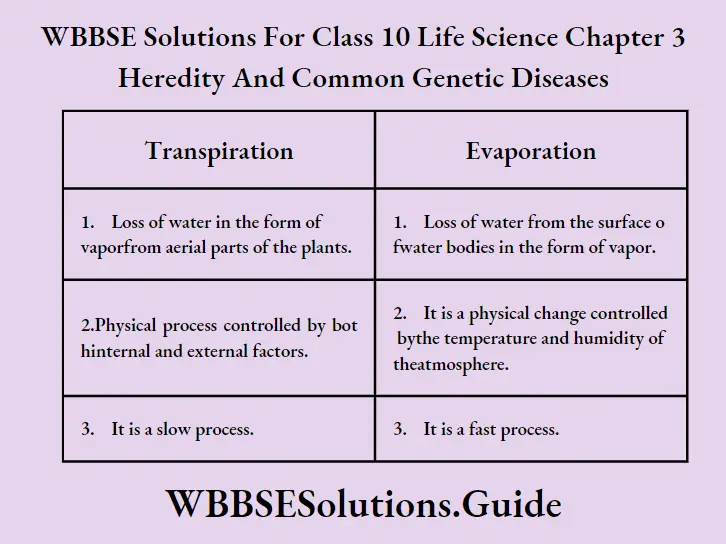
Question 55. Define antitranspirant, guttation, and bleeding.
Answer:
Antitranspirants
Antitranspirants are physical or chemical agents that help in reducing excessive loss of water by keeping stomatal pores closed, eg.-plastic film, wax emulsion, aspirin, and dimethyl silicon.
Guttation :
Loss of water in the form of water droplets along the margin of the leaf in the morning is called guttation. It takes place through the Aydathodes.
Bleeding :
The plant sap bleeds from the ruptured or cut surfaces of the plant. The root pressure generated by a plant assists in bleeding.
Question 56. What do you mean by “Ascent of sap”? What is the relation between transpiration and the ascent of sap?
Answer:
(i) Ascent of sap:—
The upward movement of water along with dissolved mineral
elements through the xylem vessels from root to leaf is known as the ‘Ascent of Sap’.
(ii) Relation between transpiration and ascent of sap:—
Transpiration:-
The loss of water in the form of water vapor from the aerial parts of the plant’s body is called transpiration.
Ascent of sap:-
The upward movement of sap from the root xylem to leaf mesophyll tissue through the stem xylem is called ascent of sap.
Relation:-
The ascent of sap supplies the raw material to the process of transpiration and transpiration provides a chance for the happening of ascent of sap. Thus both these processes are complementary to each other. The more the transpiration, the more absorption and ascent of sap.
Question 57. What is Circulation? Discuss how water reaches into the leaves from the roots in a plant body.
Answer:
(1) Circulation:—
The transfer of nutrients, gases, excretory products, hormones, etc. from one part of the living body to another part of the living body through a liquid medium is called circulation.
(2) Method of reaching water from root to leaves in a plant body:—
The process by which water moves upwards from root to leaf is called the ascent of sap.
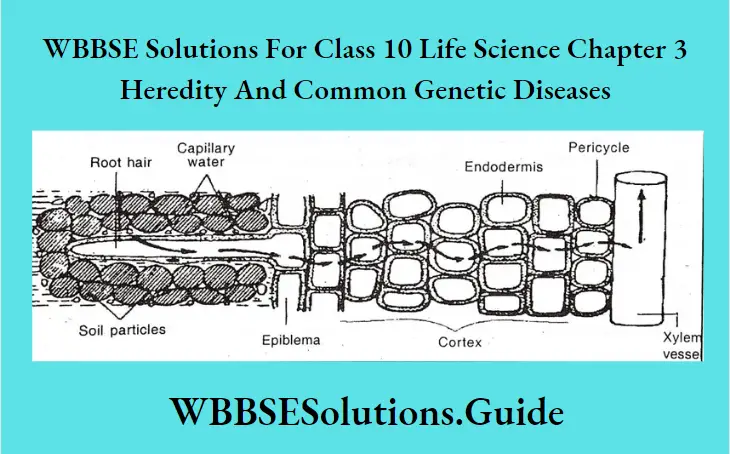
Many theories were put forward by various scientists from time to time but the “Cohesive adhesive force and transpiration pull theory” as proposed by Dixon and Jolly in 1894 is the most acceptable.
The cohesive force exists between two water molecules within xylem vessels. This force keeps the water column unbroken within xylem vessels.
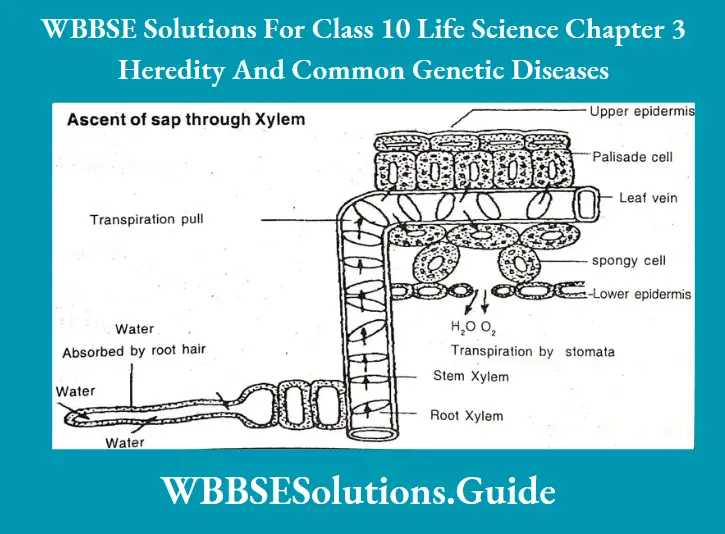
The adhesive force exists between the water column and the wall of the xylem vessel. The water present within intercellular spaces of mesophyll tissue is changed in the vapor by the process of transpiration. This phenomenon creates a pull in the water column of the xylem vessel. This pull acts from the upper part to the lower part of the column. So its effect is first realized by the water present in the leaf xylem then the stem and the last at the root xylem. Thus water uplifts and continues till the process of transpiration is in action.
Question 58. What is transpiration? What are the various factors which influence transpiration?
Answer:
Transpiration:—
The process of loss of water in the form of water vapor from the internal tissue of aerial parts of plants is known as transpiration.
Factors influencing transpiration:—
There are various factors which affect the rate of transpiration.
These factors are divided into two groups:—
1. External factors:—
(1) Light:—
Light is most important for the opening and closing of stomata. In the daytime, due to the presence of light, the stomata remain open and transpiration of water takes place normally. At night the stomata remain closed and consequently, the transpiration is checked. Thus the rate of transpiration increases in light and decreases in darkness. Light also affects transpiration by increasing the temperature of the leaf surface.
(2) Temperature:—
Temperature shows a direct effect on transpiration. Due to the rise of temperature, the relative humidity of the air decreases and then there will be an increase in the rate of transpiration. If temperature is low then there will be a decrease in the rate of transpiration.
(3) Humidity of air:—
There is an increase or decrease in the rate of transpiration according to whether the air is dry or moist. If the atmosphere is dry there will be more transpiration.
(4) Wind:—
During high velocity of wind, the transpiration becomes very active because the water vapors are instantly removed and the area around the transpiring surface is not allowed to become saturated. During a slow breeze, the water vapors are not so quickly removed, which reduces the rate of transpiration.
(5) Atmospheric pressure:—
The rate of transpiration increases due to a decrease in atmospheric pressure.
(6) Soil water:—
The rate of transpiration increases due to an increase in the quantity of capillary water in the soil.
2. Internal factors:—
(1) Presence of cuticles on the leaf surface:— The rate of transpiration decreases due to the presence of a cuticle layer on the surface of the leaf.
(2) Number of stomata:—
Several stomata directly affect the rate of transpiration. If the number of stomata is less, the rate of stomata will be low.
(3) Leaf area:—
There will be more water loss from a plant having a larger leaf area than a smaller area.
(4) Leaf structure:—
The structure of the leaf controls the rate of transpiration. In
xerophytes (ex. cactus) the rate of transpiration is low due to the modification of the leaf into the spine.
(5) Hormones:—
Cytokinin controls the opening and closing of stomata. This affects the rate of transpiration.
Question 59. Describe the experiment to measure the rate of transpiration by Ganong’s photometer.
Answer:
Ganong’s photometer:—
In this apparatus, there is a horizontal capillary tube which is graduated. One end of this tube is bent downward and at the lower end of this bent tube, there is a hole inside the wall, through which an air bubble can be introduced. The other end of the horizontal tube opens into another horizontal but wider tube that is bent upward to end in a smaller bell jar for holding the plant twig. The broader horizontal tube is also connected by a vertically raised water reservoir funnel which is provided with stop-cock in the connecting tube to control the water supply.
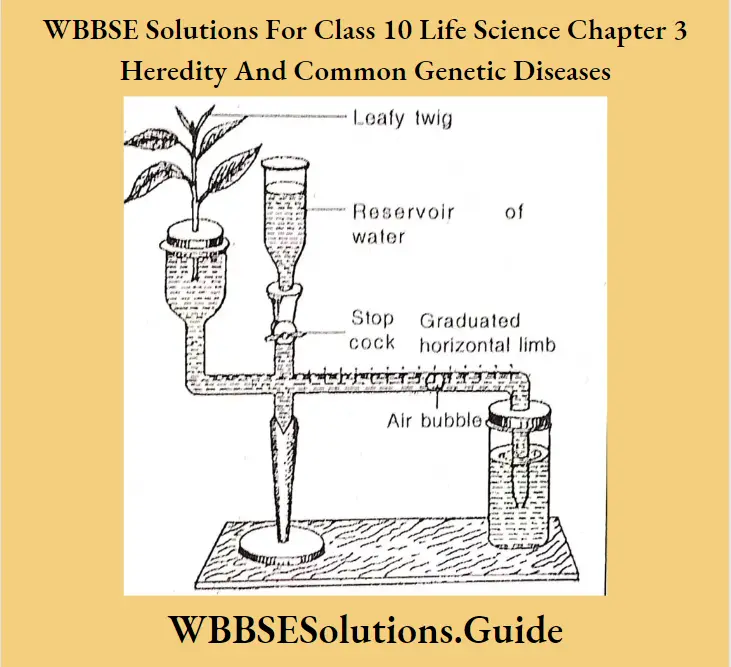
Method:—
In the beginning, water is a Demonstration of the rate of transpiration filled in all parts of the tubes by opening by Ganong photometer the stop-cock of the water reservoir. A plant twig is fixed in a one-holed rubber stopper, the latter being fixed to the end of the broad mouth in an air-tight manner. The lower bent end of the capillary. the tube is immersed in a beaker of water. At this point, water should fill all the horizontal tubes, the vertical cup tube containing twigs, and the capillary tube, and the stop-cock of the water reservoir is now closed. An air bubble is introduced through the hole of the downward-bent tube end. As the plant loses water by transpiration, it exerts a suction force, so the bubble moves forward. The number of divisions in which the air bubble travels in a limited time gives an idea of the rate of transpiration.
Chapter 3 Physiological Processes Of Life Respiration
Question 60. What is meant by the release of energy during respiration?
Answer:
Release of energy during respiration
The sun is the ultimate source of energy. Its solar energy is transformed into potential chemical energy by green plants during the process of photosynthesis. The potential chemical energy is stored within glucose which is a product of photosynthesis. We obtained energy from the food.
The simple forms of food like glucose, amino acids, fatty acids, etc. are oxidized within the cell. The potential chemical energy of food is transformed into kinetic energy by the process of respiration. Some part of this energy is stored within ATP molecules. Living organisms use the energy which is stored within ATP as per their requirement. Some part of chemical energy is also transformed into heat energy which is necessary for keeping our body temperature constant. A part of chemical energy is converted into light in some animals, like glow worms. In some animals, the chemical energy of food is converted into electricity.
Example — Electric ray fish.
Question 61. Glucose produced during the time in plants is stored in which form and where in the plant body? Why does that occur?
Answer:
(1) Glucose produced during the time in plants is stored in the form of assimilatory starch in leaves. During night the Glucose is stored in the form of permanent starch in the root cells.
(2) Reason:-
Glucose is produced by the process of photosynthesis during day time. It is soluble in water. Its high concentration reduces the rate of photosynthesis.
To avoid this condition, soluble glucose is converted into insoluble starch grains temporarily in mesophyll cells in the presence of the element potassium. This starch is called assimilatory starch. During the night, the assimilatory starch of mesophyll cells is converted into. soluble glucose and translocated to storage organs like root or stem through the sieve tube of phloem. Here soluble glucose is transformed into permanent insoluble starch with the help of amyloplast or leucoplast.
In many plants permanent starch is formed in storage tissue like the cortex or r pith or endodermis or in special organs like tubers and rhizomes.
Question 62. Discuss anaerobic respiration with an example.
Answer:
Anaerobic respiration
The process of respiration which occurs in the absence of free oxygen in the cytoplasm of a cell in the presence of enzymes comparatively less amount of energy is released, called anaerobic respiration.
Example — Tapeworm, Yeast.
Question 63. Write any three differences between photosynthesis and respiration.
Answer:
Differences between photosynthesis and respiration
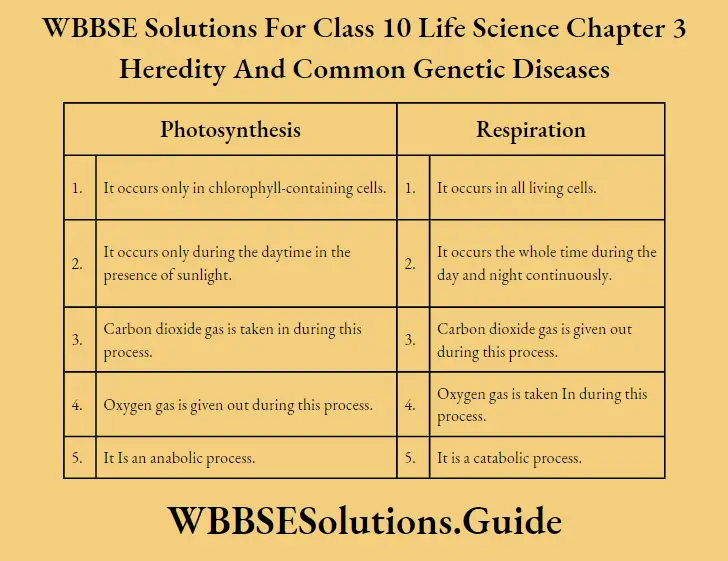
Question 64. Discuss the significance of Respiration.
Answer:
Significance of Respiration:-
(1) Release of energy:-
The potential chemical energy of food is transformed into kinetic energy by which different organs of the body work. Some quantity of this energy is stored in ATP and some quantity is used to keep body temperature normal.
(2) Maintain the balance of O, and CO2 in the environment:-
During respiration, living beings take O2 gas and give out CO2 gas, while during photosynthesis green plants take CO2 gas and give out oxygen gas. So, by the combined action of respiration and photosynthesis, the balance ofO2 and CO2 is maintained in the environment.
Question 65. What is respiration? Write two differences between aerobic and anaerobic respiration. What is meant by “release of energy takes place in respiration”?
Answer:
(1) Respiration:—
The catabolic reaction _ which occurs continuously within all living cells oxidizes food substances and changes the potential chemical energy of food into kinetic energy
is called respiration.
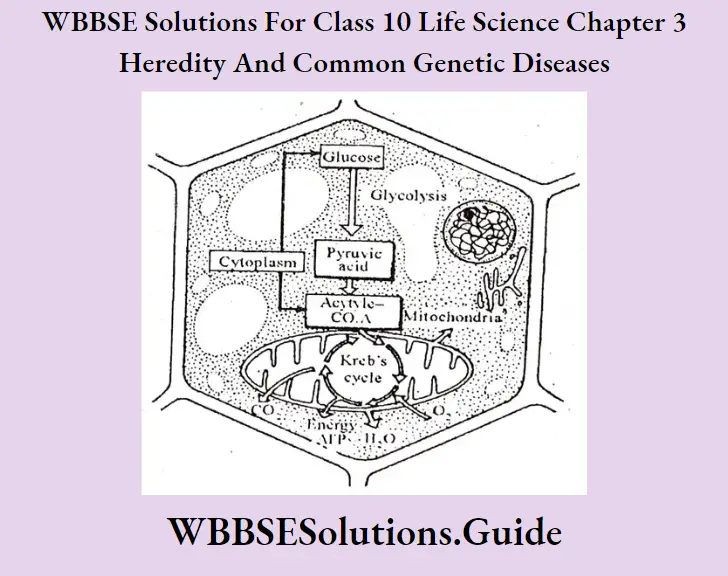
Equation:-
(2) Difference between aerobic and anaerobic respiration:—
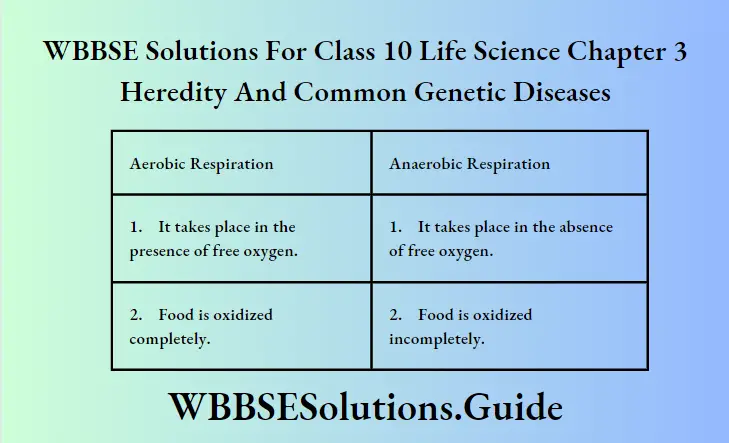
(3) “Release of energy takes place in respiration” —
Every living organism requires energy to perform various life– continuing activity. They obtain energy from the food. Food contains chemical energy which is the transformed form of radiant energy. Now the process of respiration changes this potential chemical energy into kinetic energy. in the form of ATP molecules. The conversion of potential chemical energy of
food into kinetic energy which is used by organs is the meaning of release of energy.
Question 66. Wherefrom do organisms get the oxygen necessary for their respiration? Discuss the importance of respiration in maintaining O2— CO2 balance in the atmosphere. Mentioning the environment of each write the names of the animals in which the gill and trachea act as respiratory organs
Answer:
(1) They get oxygen necessary for their respiration from their respective environment, i.e., aquatics from water and terrestrials from atmospheric air.
(2) Importance of respiration in maintaining O,- CO, balance in the atmosphere:-
The percentage of oxygen gas and carbon dioxide gas in the atmosphere is 20.60% and 0.03% respectively. The living organism takes in oxygen and gives out carbon dioxide during respiration, but green plant during day time takes in CO2 and give out O2 during photosynthesis. Thus we see that these two biological processes by their combined action maintain the balance of O2 and CO2 in the atmosphere.
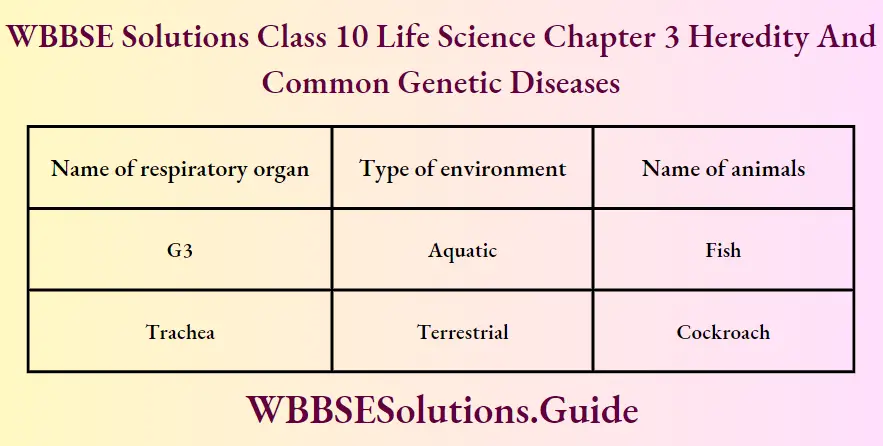
Question 67. Mention any two differences between photosynthesis and respiration. Explain the main two ways by which the living world benefits due to respiration. Wherefrom do fully submerged plants take oxygen for respiration?
Answer:
(1) Two differences between photosynthesis and respiration:
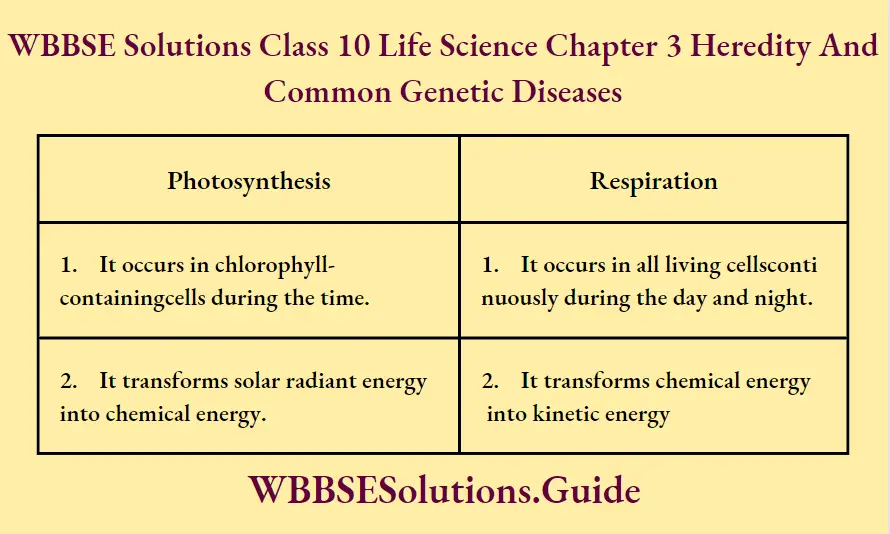
(2) Benefit obtained by respiration:—
(1) Release of energy:—
The chemical energy of the food is transformed into kinetic energy by the process of respiration. This kinetic energy is used by organs of the body to continue life.
The heat which is produced during this process is essential to keep our body temperature normal.
(2) Maintenance of O2—CO2 balance in the environment:— Oxygen gas is taken in and carbon dioxide gas is given out during respiration but during photosynthesis carbon dioxide gas is taken in and oxygen gas is given out. Thus the process of respiration takes part in the balance of O2-CO2 in the environment.
(3) From the water.
Question 68. How do photosynthesis and respiration take place simultaneously in green plants under the sunlight? Discuss the importance of respiration in maintaining O2
Answer:
(1) Way of occurrence of photosynthesis and respiration simultaneously in green plants under the sunlight:- Photosynthesis takes place within the chloroplast. Plants get CO2 from air and water from the soil. Glucose, water, and oxygen gas are produced as end products. Respiration takes place within the cytoplasm and mitochondria. Glucose and oxygen are its raw materials. Plants get these materials from the cell because they are produced during photosynthesis. CO2 and H2O are end products of respiration. These are utilized by plants for photosynthesis.
Thus we see that by supplying raw materials for each other, these processes occur smoothly in green plants under the sunlight.
(2) Importance of respiration in maintaining O2—-CO2 balance in the atmosphere :—
The percentage of oxygen gas and carbon dioxide gas in the atmosphere is 20.60% and 0.03%-—0.04% respectively. The living organism takes in oxygen and gives out carbon dioxide during respiration, but green plant during day time takes in CO2 and give out O2 during photosynthesis. Thus we see that these two biological processes by their combined action maintain the balance of O2 and CO2 in the atmosphere.
(3) Name of the respiratory organ in prawn – Gills.
Question 69. What is aerobic respiration? What is the difference between breathing and respiration?
Answer:
(1) Aerobic Respiration:-
The complete oxidation of food which occurs continuously within living cells, cytoplasm, and mitochondria in the presence of free oxygen to produce carbon dioxide, water, and 686 KCal energy is called aerobic respiration.
Equation:-
(2) Difference between breathing and respiration:-
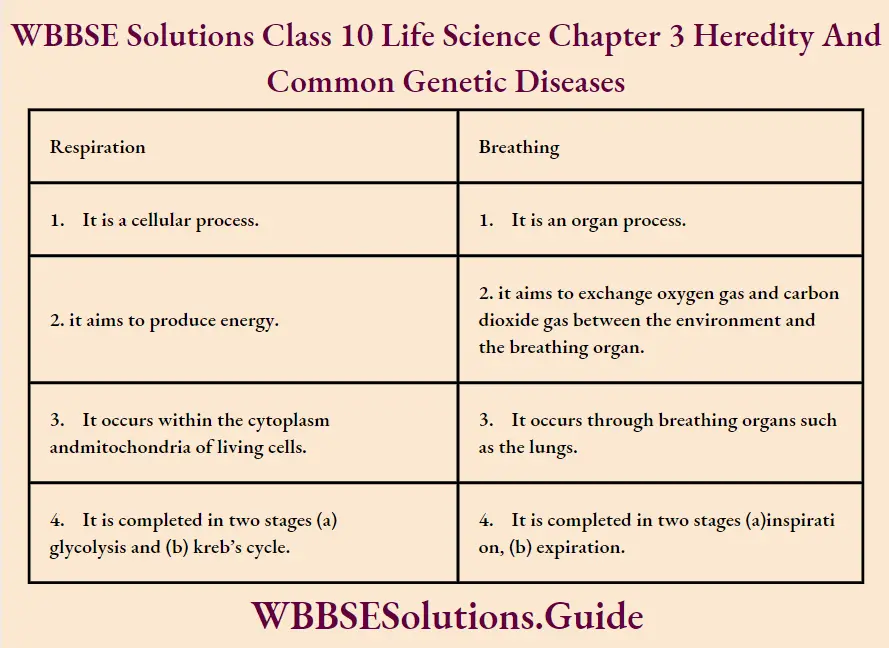
Question 70. Where does aerobic respiration take place in a cell? Name the chief respiratory organs of Amoeba, Cockroaches, Tadpole, and a bird. Through which part of plant body exchange of respiratory gases take place in case of fully merged aquatic ones?
Answer:
1. Place for aerobic respiration:—
(1) Cytoplasm,
(2) Mitochondria.
2. Name of respiratory organs:—
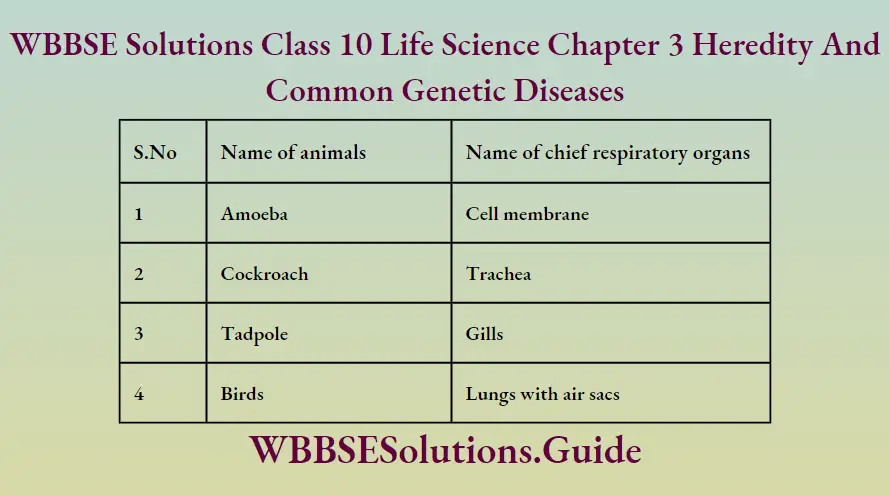
3. From all the parts of the plant body exchange of respiratory gases takes place in the case of fully merged aquatic ones.
Question 71. What is Respiration? How is it related to nutrition? Mention three main types of respiratory organs in animals.
Answer:
(1) Respiration:—
The catabolic reaction that occurs continuously within all
living cells to oxidize food substances and to change the potential chemical energy of food into kinetic energy is called respiration.
(ii) Relation between respiration and nutrition:—
Respiration :
The oxidative breakdown of substances in living cells to release energy is called respiration
Nutrition :
The total of processes like ingestion, digestion, absorption, assimilation, and egestion is called nutrition.
Relation:-
The process of nutrition supplies the raw materials such as glucose, amino acid and fatty acid for respiration and respiration liberates energy which is necessary for nutrition. Thus both these processes are complementary to each other.
(3) Name of three main types of respiratory organs:—
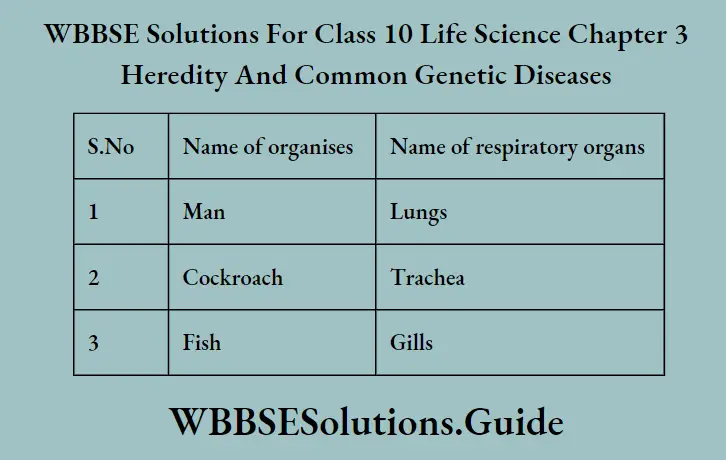
Question 72. Write three differences between anaerobic and aerobic respiration. Give two examples of fermentation.
Answer:
(1) Difference between anaerobic and aerobic respiration.
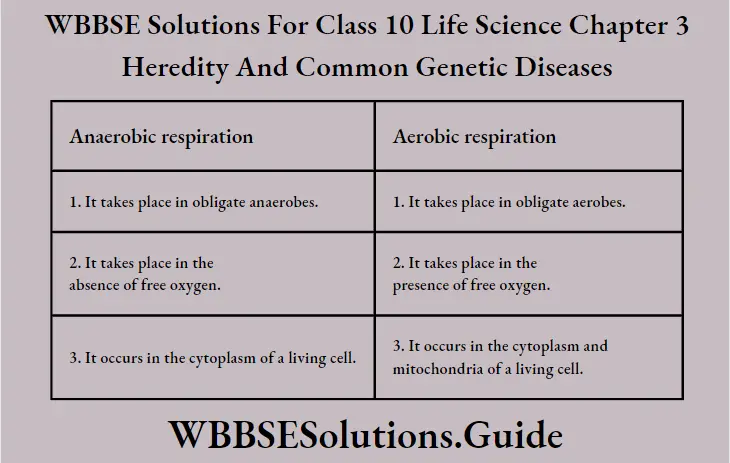
(2) Two examples of fermentation :
(1) Alcoholic fermentation.
(2) Lactic acid fermentation.
Question 73. Where and when does respiration take place in a cell of a living body? Define aerobic and anaerobic respiration.
Answer:
(1) Place – Respiration takes place within the cytoplasm and mitochondria of a living cell.
(2) Time – It takes place day and night continuously.
(3) Aerobic Respiration:—
The complete oxidation of food which occurs continuously within living cells, cytoplasm, and mitochondria in the presence of free oxygen to produce carbon dioxide, water, and 686 KCal energy is called aerobic respiration.
Equation –
(4) Anaerobic respiration:-
The incomplete oxidation of food which occurs continuously within living cells” cytoplasm in the absence of free oxygen to produce ethyl alcohol, CO2, and energy in plant cells but lactic acid and energy in animal cells is called anaerobic respiration.
Equation –
Question 74. How does aerobic respiration differ from anaerobic respiration? Mention two practical applications of alcoholic fermentation.
Answer:
(i) Difference between aerobic and anaerobic respiration:-
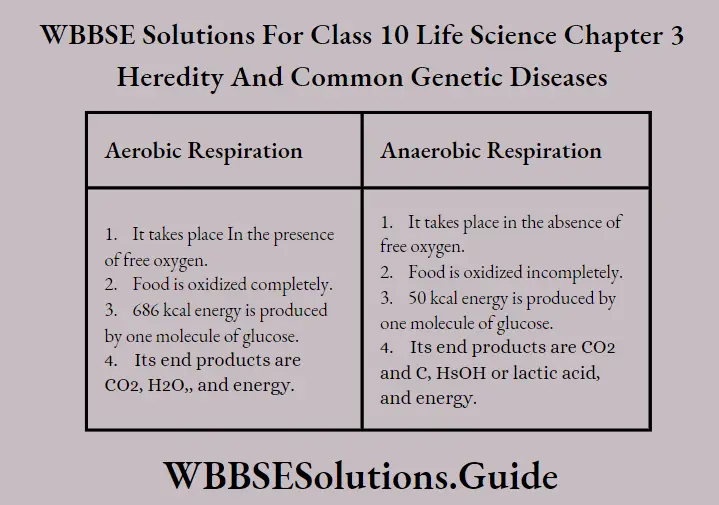
(ii) Practical application of alcoholic fermentation:-
(1) It helps in the production of ethyl alcohol. This alcohol is used in the production of medicine and alcoholic beverages.
(2) It also helps in the formation of double bread.
Question 75. What type of metabolic process is respiration? Why is it essential for living organisms? Write two practical importance of fermentation. What is the respiratory organ of grasshopper?
Answer:
(1) Respiration is a catabolic type of metabolic process.
(2) Respiration is essential for living organisms because it transforms the potential chemical energy of food into kinetic energy which is used by different organs and metabolic
reactions to continue the life of living organisms.
(3) Practical application of fermentation:-
(1) It is useful for the preparation of curd and vinegar.
(2) It is used in the preparation of biscuits and double bread.
(3) It is used in the preparation of ethyl alcohol.
(4) The trachea is the respiratory organ of grasshoppers.
Question 76. How are respiration and breathing interrelated?
Answer: Respiration is a cellular continuous process. Glucose, amino acids, fatty acids, and oxygen are its raw materials. They reach cells by the process of circulation.
The taking in of oxygen and giving out CO2 by them is breathing. This process occurs between the breathing organ and the environment of living. Oxygen gas reaches within the breathing organ through the process of breathing (Inspiration). This gas mixes with blood and reaches to cell by the process of circulation. Thus breathing supplies oxygen gas for the process of respiration. It also removes CO2 gas which is produced during the process of respiration.
Question 77. What are respiratory organs? Discuss their characteristics.
Answer:
Respiratory organs
Respiratory organs are the special type of organs that help in the process of exchange of gases, i.e., O2 and CO2 between the environment and the organism.
Characteristic features of respiratory organs:
(1) The respiratory membrane must be thin and permeable so that there is easy gaseous exchange.
(2) The respiratory surface must be extensive to provide a greater surface area for gaseous exchange.
(3) The respiratory organ must be always kept moist to facilitate the diffusion of gases.
(4) In higher animals, the respiratory organ is highly vascularised so that blood can transport respiratory gases—O2 from respiratory organs to different cells of the body
and vice versa for CO2.
Question 78. Explain the common respiratory sites in plants.
Answer:
Common respiratory sites in plants are as follows :
1. Stomata :
These are microscopic apertures in the leaf epidermis of plants, guarded by two guard cells. Stomata are generally present on the ventral surface in dicot plants and both on the dorsal and ventral surface in monocot plants. Through the opening of stomata gaseous exchange takes place.
2. Lenticels :
Lenticel is a porous tissue consisting of cells with large intercellular spaces, generally on the bark of woody stems of dicot plants. It functions as a pore that provides a pathway for the direct exchange of gases between the internal tissues and atmosphere through the bark. (Tough thick bark is otherwise impermeable to gases).
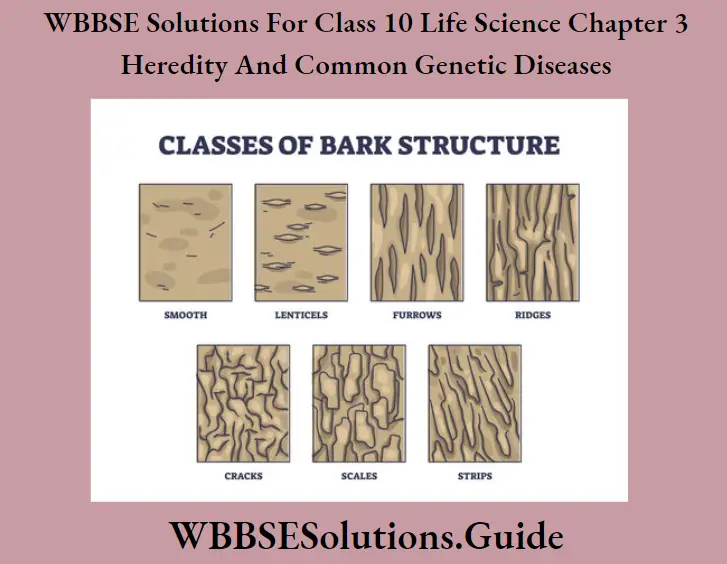
3. Pneumatophores :
These are breathing roots, found in mangrove trees and they are negatively geotropic adventitious branches of the root. In fact, in saline soil, the capillary space of the soil is almost blocked by a huge deposition of NaCl. So there is less capillary air, hence the root suffers from O, deficiency. So, some of the adventitious roots bend upward and come above the soil surface to absorb O2 directly from the air, e.g. pneumatophores in Sundri Plant.
Question 79. Discuss the various respiratory organs of animals.
Answer:
Various respiratory organs of animals
Introduction :
Usually, respiration in different animals is performed by the definite organs called respiratory organs In lower animals, the exchange of gases takes place through the body surface, whereas in higher animals, there are complex organs like trachea, lungs, etc. The following is a brief account of the different types of respiratory organs found in different animals.
1. Body surface :
In the case of aquatic animals like Amoeba, Sponges, Paramoecium, Hydra, etc. exchange of gases between cells and their environment takes place by simple diffusion through the cell membrane (body surface).
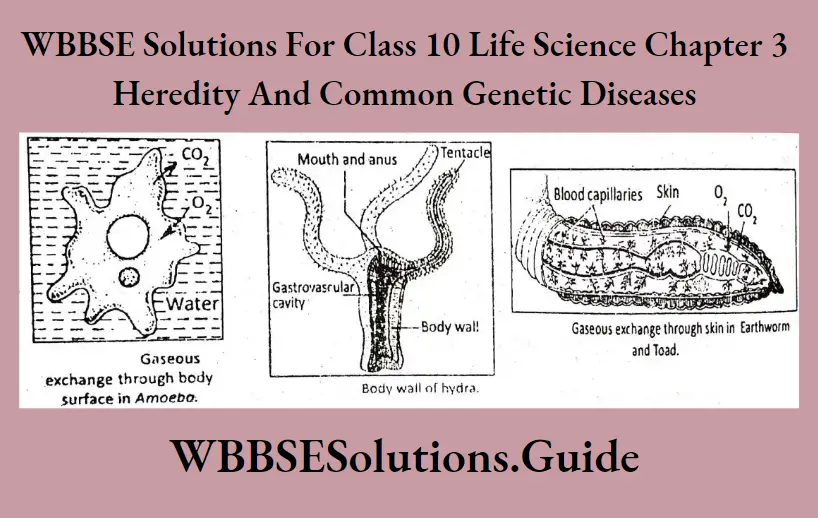
2. Skin :
Terrestrial animals like earthworms, leeches, etc. respire partly or wholly through thin and highly blood-supplied moist skin.
3. Trachea :
Insects and varieties of arthropods have elaborate networks of air-filled tubes called tracheae which open onto the body surface through the small pores called spiracles or stigmata. The trachea branches repeatedly into tubes called tracheoles through which gaseous exchange takes place.
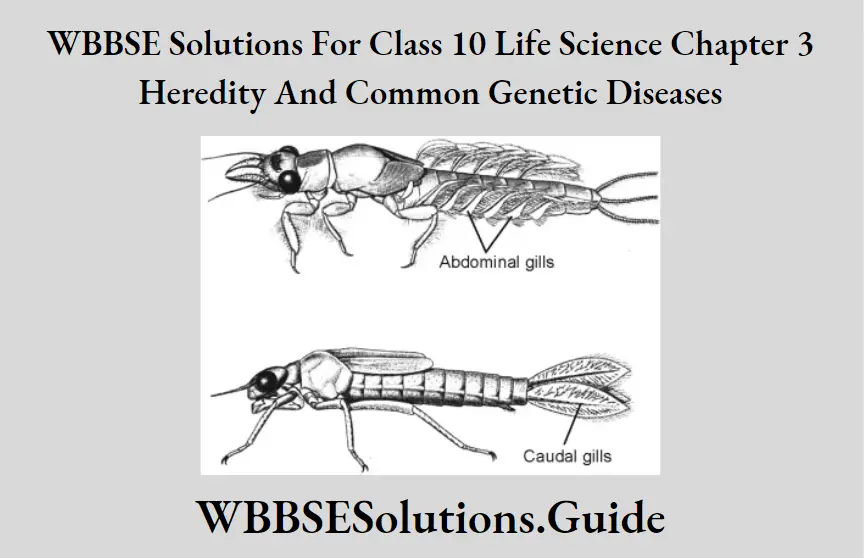
4. Gills :
In aquatic animals like fishes, the external respiration takes place through gills. These are specialized structures dark red, provided with thin walls and blood capillaries that favor easy diffusion of gases between dissolved O2 in water and the circulating blood passing through them. The actual site of gaseous exchange in fish is the gill lamella of the gill filament.
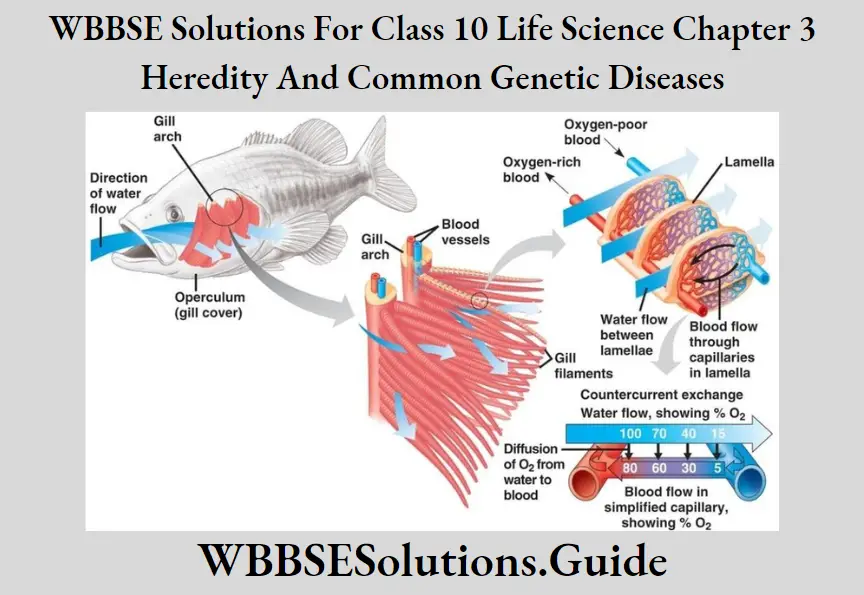
Accessory respiratory organs :
The organs that partly accomplish respiration and are additional complementary respiratory structures are called accessory respiratory organs (other than gills). Some jewel fishes like Koi, Magur, and Singhi are provided with these organs.
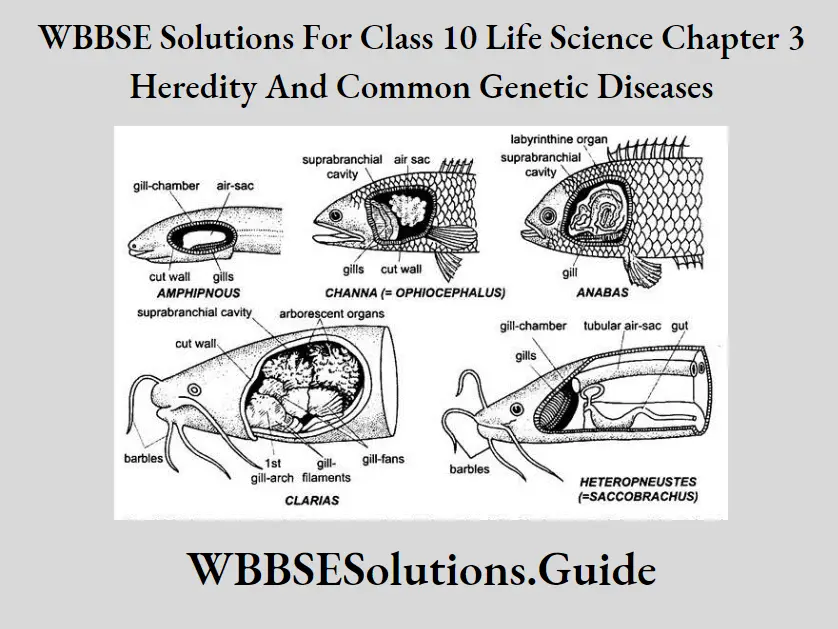
Accessory respiratory organs develop in addition to the normal pharyngeal gills, to help the fish live in aquatic environments with low oxygen concentration or to breathe
oxygen directly from the air, aestivate over prolonged droughts during summer, and meet extra demand for oxygen. However, accessory respiratory organs in fishes can perform gaseous exchange so long as they remain moist. Gills are incapable of utilizing oxygen in the air, so accessory respiratory organs are useful adaptive features of some fishes. Those that possess these adaptive features are called jellyfish.
6. Lungs :
Lungs are the specialized respiratory organs of all land vertebrates, e.g. birds (pigeons), reptiles (lizards, snakes), amphibians (frogs, toads), and mammals (rats, cows). [eects The aquatic mammals (e.g. whale, dolphin) are also provided with lungs. That is why | so” some animals (Whale, Dolphin, Crocodile) | senay— AS often come above the surface of the water for |°°” S\N aerial respiration.
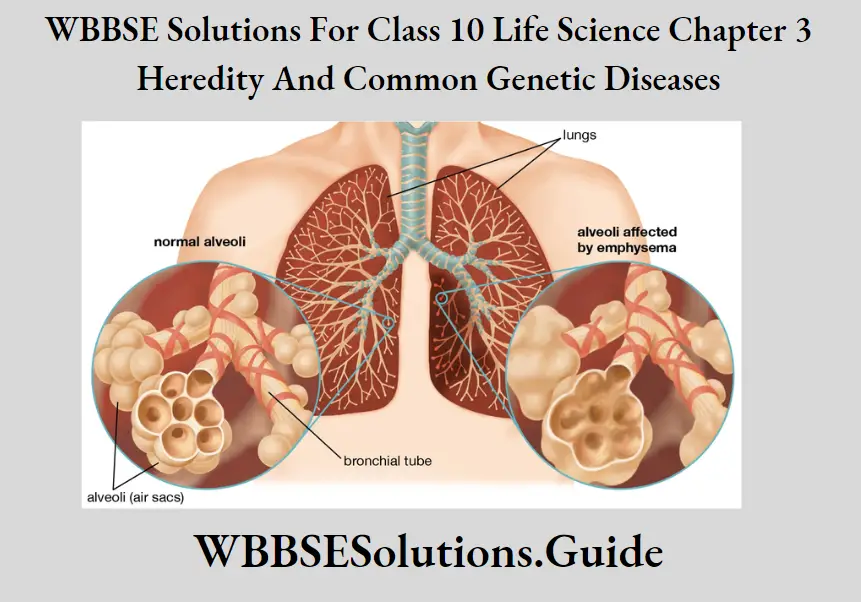
The lungs of amphibians reptiles and mammals are paired sac-like spongy foPe contact with other structures due to the presence of air-filled alveoli. Alveoli are provided with numerous blood vessels (capillaries) for gaseous exchange. The lungs of pigeons are more compact and are supplemented by. thin-walled 9 air sacs for storage.of air that also helps to increase buoyancy.
Question 80. Discuss the concept of cellular respiration.
Answer:
Concept of cellular respiration
What is Cellular Respiration? Cellular respiration is the oxidative, catabolic, enzymatic breakdown of organic substances when potential energy is released in the form of kinetic energy.
C6H12O6+6O2 __ Enzymes , 6CO2 + 6H2O + energy
All organisms require energy to maintain the vital function of the body. This energy is derived from the food they take. During photosynthesis, solar energy is fixed in food as potential chemical energy. This food is used as a cellular respiratory substrate which is oxidized to release energy. In the presence of O, (aerobic respiration), there is complete oxidation of food that results in a greater amount of energy release whereas, in the absence of O2(anaerobic respiration), there is incomplete oxidation of food that yields less energy. However, the energy released by cellular respiration is stored temporarily in ATP (Adenosine Triphosphate). This ATP (energy currency) is broken to release energy for various activities of the body.
Question 81. Explain the breathing mechanism in humans
Answer:
Breathing mechanism in humans:
The human respiratory organ is a pair of lungs, present in the chest cavity. Each lung remains covered with a double-layered membrane, called pleura. The space in between these two layers is called intrapleural space, which remains filled with pleural fluid.
The organ-level respiration or breathing in man involves two phases —
(1) Inspiration and
(2) Expiration. The mechanism of breathing is discussed below.
Inspiration :
Following events occur during inspiration.
(1) Diaphragm muscles contract and move down towards the abdominal cavity.
(2) Intercostal (in between ribs) muscles contract to pull the ribs upward to some extent.
(3) By these two actions, the space inside the ribcage increases. This reduces the pressure inside the chest cavity and in the pleural fluid.
(4) In this situation, thoracic pressure reaches below the atmospheric pressure. As a result, oxygen-rich air from the atmosphere rushes into the body through the nostrils, nasal passage, glottis, larynx, trachea, bronchus, and bronchioles to reach the alveoli.
Gaseous exchange occurs between alveolar air and capillary blood. After this exchange, the air inside the lungs becomes rich in carbon dioxide (CO2). Now the brain sends a signal for expiration and the events follow.
Expiration :
(1) The diaphragm expands and moves towards the chest cas
(2)Intercostal muscles relax and the ribs go downward to their normal position.
(3) Due to the above two actions the internal volume of the chest cavity is reduced. As a result, pressure increases in the pleural fluid & as well as in the lungs.
(4) The lungs contract and the air inside the lungs is pushed out along the reverse path.
Question 82. Write a short note on fermentation.
Answer:
Fermentation :
In this process, partial breakdown of respiratory substrates occurs in totally oxygen-free conditions.
Occurrence :
This is a special type of physiological process that occurs in different microorganisms. These include some bacteria (Lactococcus lactis, Acetobacter aceti, etc.) and fungi (yeast). In higher animals, this type, of respiration occurs in skeletal muscles. Among higher plants, this process mainly takes place in seeds, potato tubers, etc.
Process of oxidation :
Certain enzymes are secreted from some microorganisms, which help in this process. During fermentation, different organic substances such as ethanol, lactic acid, acetic acid, etc. are produced. The nature of these products upon the enzyme sécreted by the participating cell.
Fermentation occurs in skeletal muscles due to a short supply of oxygen during long and heavy exercise. In this case, lactic acid is produced as a by-product. This lactic acid, when deposited in muscles in larger quantities, causes pain and muscle cramps.
Production of energy :
In this process, only 2 molecules of ATP are produced from one molecule of glucose. The quantity of heat, generated by this respiration, varies in different types of fermentation reactions, which are as follows.
Overall equation :
Alcoholic fermentation by yeast : C6H12O6 —-> C2H5OH (Ethanol) —–> + 2CO2 + 50 kcal|mole.
Lactic acid fermentation by Lactobacillus: C6H12O6 —-> 2CH3CHOHCOOH (Lactic acid) + 116 kcal|mole.
Acetic acid fermentation by Acetobacter : C6H12O6 —-> C2H5OH (Ethanol) —–> + CH3COOH (Acetic acid) + H2O + 116 kcal|mole.
Question 83. Explain the significance of respiration.
Answer:
Significance of respiration :
(1) Release of energy :
Respiration is a physiological process in which energy is
liberated. During photosynthesis, a part of the solar energy that falls on the leaves of green plants is stored as potential energy in the synthesized food. During respiration,
this potential energy is transformed into kinetic Serge which performs the following functions —
(1) A part of the released energy is eee and stored as ATP (adenosine triphosphate, an energy-rich compound) for future uses. Energy in this form can only be used in performing various physiological functions.
(2) The remaining part of the released energy raises the body temperature and is partly released as heat.
(3) The energy for emitting light by glowworms and some sea animals is derived from released heat.
(4) The energy for generating electric current by electric ray, a type of fish, comes through respiration.
(5) The calorie needs of human subjects are fulfilled through the oxidation of food (that the subject consumes) during respiration.
(2) Maintenance of O2 — CO2 balance :
Respiration helps to maintain oxygen and carbon dioxide balance in the environment. During photosynthesis, green plants utilize CO2 and release O2 in the atmosphere. This may bring about a fall in CO2 content and an increase in O, content in the atmosphere. But it never happens because during respiration all living organisms (except anaerobes) take up O2 and release CO2, In this way, the process of respiration helps to maintain O2 – CO2 balance in the environment.
Question 84. Mention the economic importance of fermentation.
Answer:
Economic importance of fermentation :
(1) Alcohol is useful in the wine industry, preparation of different medicines, tonics, biochemical and medicinal research, biological experiments, cosmetics, etc.
(2) Vinegar contains acetic acid which is produced by acetic acid fermentation of Acetobacter.
(3) Curd contains lactic acid which is produced by lactic acid fermentation of lactobacillus.
(4) Lemon squash contains citric acid which is produced by the citric acid fermentation of Citrobacter.
Question 86. What is meant by assimilation? Mention the organs related to absorption and assimilation.
Answer:
(1) Assimilation :
The process of conversion of simple digested food within cells into complex organic substances like protoplasm is called assimilation.
In animals digested foods like glucose, amino acids, and fatty acids reach different cells from the small intestine through the process of blood circulation. Glucose is converted
into glycogen within liver cells. Excess fatty acids are deposited in various parts such as below the skin and around the liver etc.
Amino acids are converted into urea within liver cells by the ornithine cycle. Urea is excreted in the form of urine through the kidney.
(2) Organs related to absorption: villi of small intestine.
(3) Organs related to assimilation: cells of the body.
Question 87. What is the importance of the digestion of food? What type of digestion is found in man? Mention the roles of enzymes in the digestion of food.
Answer:
1. Importance of digestion of food :
(1) Digestion converts complex and insoluble food substances to simple soluble and absorbable food substances.
(2) Glucose, amino acids, and fatty acids which are the end products of digestion are absorbed through villi and mixed with blood.
(3) The digested food reaches cells by the process of circulation.
(4) These substances take part in the metabolic reactions of the cell.
Thus the process of digestion is essential for the continuation of life.
2. Holozoic type or extracellular digestion is found in man.
3. Roles of enzymes in the digestion of food substances:—
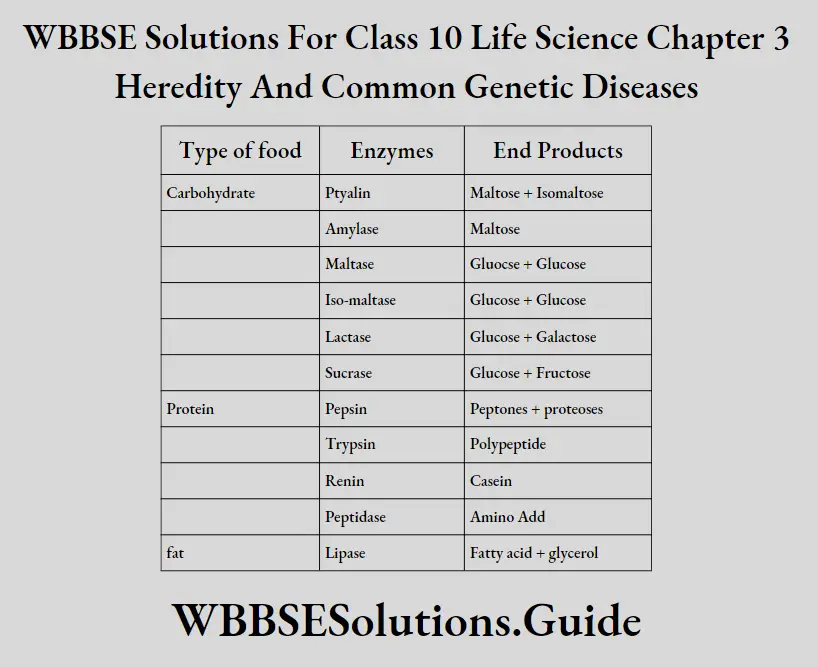
Question 88. Mention any two functions of Vitamin A’. Explain the importance of vitamins.
Answer:
Function of Vitamin A:-
(1) It keeps eye-sight healthy.
(2) It helps in proper growth.
Importance of vitamins in the human body:—
(1) Vitamins help in the regulation of metabolic reactions in the living body.
(2) Vitamin A is necessary for proper growth. It also helps in maintaining normal eye sight.
(3) Vitamin C keeps gums and teeth healthy.
(4) Vitamin D is necessary for the proper growth of bones.
(5) Vitamin E is necessary for the proper functioning of the reproductive system.”
(6). Vitamin K is necessary for the normal clotting of blood.
Question 89 Why are enzymes called biocatalysts? Sequentially mention the names, sites of secretion, substrate, and product of various enzymes that help in the digestion of starch in the human body.
Answer:
Enzymes are called biocatalysts because:-
(1) They are proteins by nature and are produced in living cells.
(2) They remain unchanged after the reaction is over.
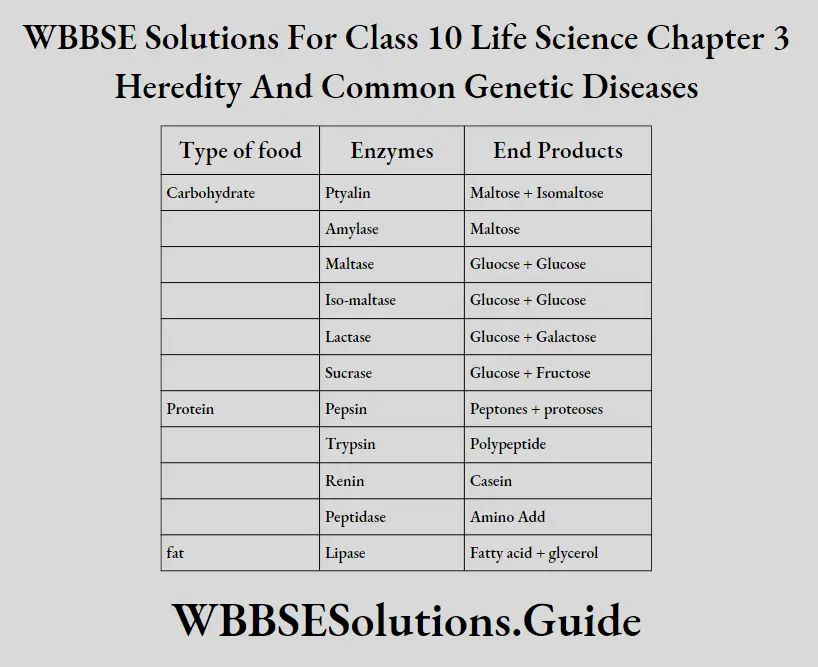
Question 90. Which type of food material fulfills the nitrogen demand of the animal body? What is the end product of the digestion of that food? Write the nutritional importance of carbohydrate type of food.
Answer:
(1) Protein type of food fulfills the nitrogen demand of the animal body.
(2) The end product of protein digestion is amino acid.
(3) Nutritional importance of Carbohydrate:-
(1) It is the main source of energy for our body.
(2) Its other forms like glycogen are stored in muscle cells and act as the source of energy in the future.
(3) It is required to prevent ketosis.
(4) It helps in the development of the brain indirectly by taking part in the formation of galactolipid which is essential for the development of the brain.
Question 91. What is chyme? Explain the action of pancreatic amylase and trypsin.
Answer:
(1) Chyme :
partially digested acidic food present in the stomach is called chyme.
(2) Action of pancreatic amylase:—
It acts in an alkaline medium on starch in Duodenum and converts it into maltose.
Starch + amylase = Maltose.
(3) Action of pancreatic trypsin:—
In Duodenum it acts upon peptone and converts it into peptides.
Question 92. Write about the chemical composition of proteins. Name any two proteolytic enzymes found in the alimentary system of man. What is roughage?
Answer:
(1) Chemical composition of protein:—
Protein molecules are large. They are formed from the combination of simple nitrogenous substances, and amino acids. Amino acids are made up of C, H, O, N, P, and S.
(2) Name of proteolytic enzyme:—
(1) Trypsin.
(2) Pepsin.
(3) Roughage:—
Non-digestible constituents of our diet which are used to prevent constipation, are called roughage.
Question 93. What is the importance of the digestion of food? What is an enzyme?
Answer:
1. Importance of digestion of food:—
(1) It converts complex and insoluble forms of food into simple, soluble, and absorbable forms of food.
(2) This process is indirectly necessary for absorption.
(3) This process prepares the raw materials for respiration.
(4) It is a basic process that helps the organism to survive.
(2) Enzyme:—
The organic compounds that are produced by living cells but without taking part in biochemical reactions within or outside a cell change the rate of chemical reaction, are called enzymes.
Question 94. Write any two general characteristics of enzymes. Mention the names of the main three types of enzymes and indicate their roles in the digestion of food substances.
Answer:
1. Two general characteristics of enzymes:-
(1) All enzymes are chemically protein in nature.
(2) Their action depends on the nature of the medium of food substances, i.e., acidic, basic, or neutral.
2. Name of main three types of enzymes –
(1) Amylolytic enzymes,
(2) proteolytic enzymes,
(3) lipolytic enzymes.
Question 95. Mention one source (from plants) for each type of food and discuss the importance of those three types of food in nutrition. Mention the importance of iodine in the food of man.
Answer:
(1) Name of three types of body-building food in man :
carbohydrate, protein, and fat.
(2) Importance of Iodine:—
It helps in the formation of ‘thyroxine’ hormone. This hormone controls different types of metabolic reactions.
Question 96. What is the importance of nutrition? Explain autotrophic and heterotrophic nutrition in plants with one example of each type.
Answer:
1. Importance of nutrition:—
(1) This process supplies nutrients to the cell. Nutrients are the raw materials for the formation of protoplasm.
(2) It helps to provide new materials to repairer replace the protoplasm in damaged tissue.
(3) It helps for protection against diseases through the assimilation of vitamins and minerals.
2. Autotrophic nutrition:—
The type of nutrition performed by the organism that prepares its food either by the process of photosynthesis or chemosynthesis is called autotrophic nutrition.
Ex – Green mango tree.
(3) Heterotrophic nutrition:—
The type of nutrition performed by all nongreen plants and all animals is called heterotrophic nutrition.
Ex – Mucor.
Question 97. Write with examples the definitions of Autotrophic and Heterotrophic nutrition in plants. Discuss briefly the first three phases of animal nutrition
mentioning the related organs.
Answer:
(1) Autotrophic nutrition:—
The type of nutrition performed by the organism that prepares its food either by the process of photosynthesis or chemosynthesis is called autotrophic nutrition.
Example of Autotrophic Nutrition:—
Nutrition in green neem plants, nutrition in sulfur bacteria.
(2) Heterotrophic nutrition:—
The type of nutrition performed by all non-green plants and all animals is called heterotrophic nutrition.
The organism in which such a type of nutrition is found is called a heterotroph. There are five types of heterotrophs:—
(1) parasite,
(2) saprophyte,
(3) insectivorous,
(4) symbiont and
(5) epiphyte.
Example of Heterotrophic Nutrition:—
Cuscuta, yeast, nepenthes, rhizobium, orchid.
(3) Name of first three phases of animal nutrition:—
(1) Ingestion,
(2) digestion,
(3) absorption.
(1) Ingestion:—
After the selection of food taking its proper quantity into the mouth cavity through the mouth is called ingestion.
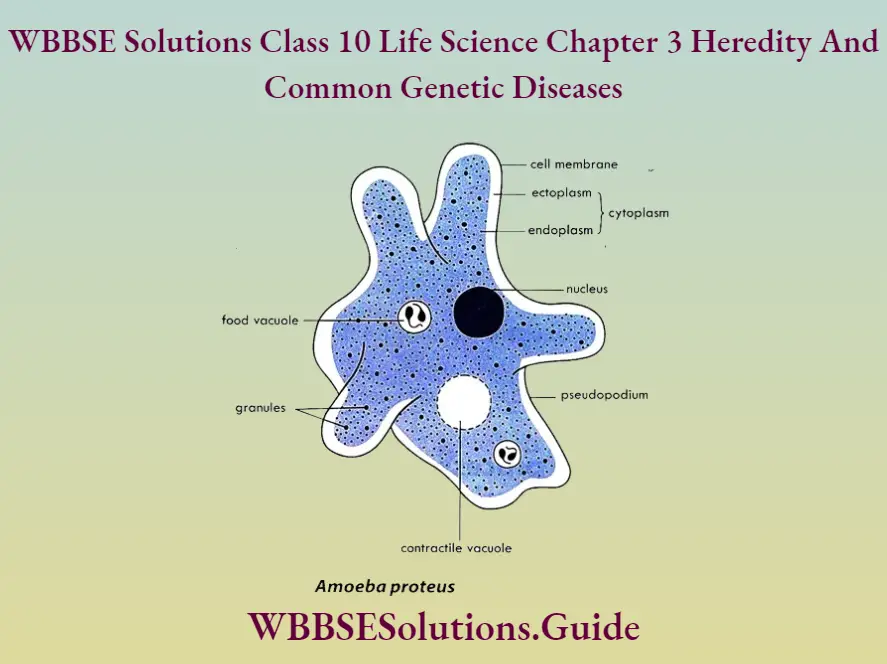
Organ related to this phase —
Hand in case of man.
(2) Digestion:—
The conversion of a complex and insoluble form of food with the help of digestive enzymes into a simple or soluble form of food is called digestion.
Organs related to this phase —
Different parts of the alimentary canal such as the mouth cavity, stomach, and small intestine.
(3) Absorption:—
The transfer of simple food substances such as glucose, amino acid, and fatty acid from the last part of the small intestine to the blood of veins through villi is called absorption.
Organ related to this phase —
Villi of the internal wall of the last part of the small intestine.
Question 98. What are the end products of digestion of carbohydrates, proteins, and fats in the case of man? Name the sources of each carbohydrate, protein, and fat considering one from plants and one from animals.
Answer:
(1) Sources:—
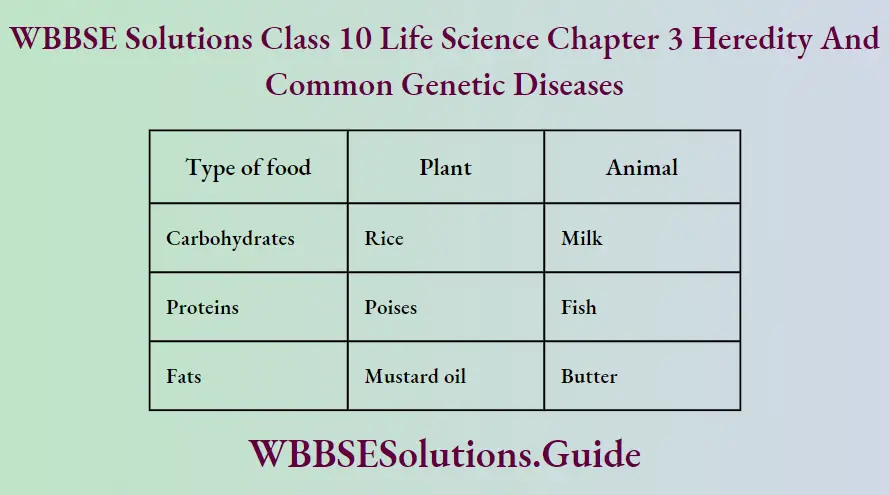
(2) End products of digestion:—
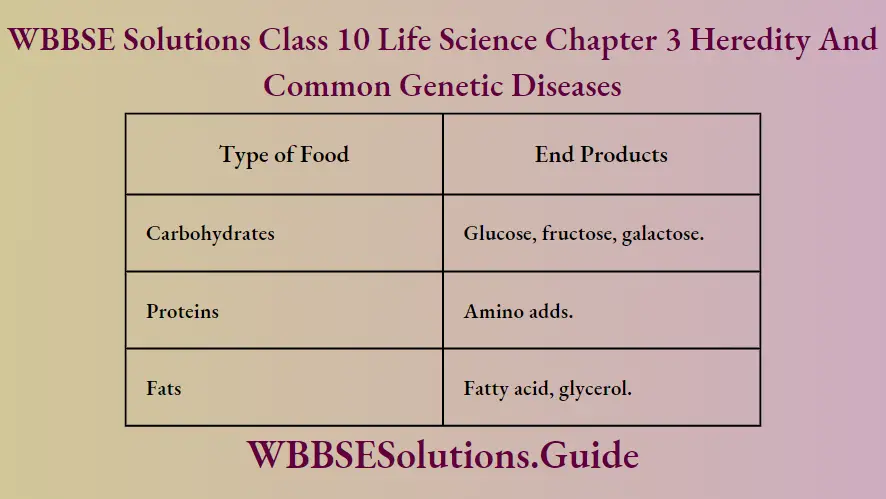
Question 99. What is Enzyme? Mention the names of three major types of food-digesting enzymes. From which parts of the digestive system protein protein-digesting enzymes are secreted?
Answer:
1. Enzyme —
The organic compounds are produced by living cells. but without taking part in bio-chemical reactions within or outside a cell change the rate of chemical reaction, are called enzymes.
2. Name of three major types of food-digesting enzymes —
(1) Amylolytic enzymes,
(2) proteolytic enzymes,
(3) lipolytic enzymes.
3. Name of parts of the digestive system:—
Stomach, Pancreas, and small intestine.
Question 100. What is meant by essential macro elements? Mention the sources of C, H,0, S, P, and K for plants.
Answer:
(1) Essential macro elements:—
The elements which in large quantities are required by living organisms for performing their different types of functions in their body are called essential macro elements. Example:- Carbon, Hydrogen, Oxygen, etc.
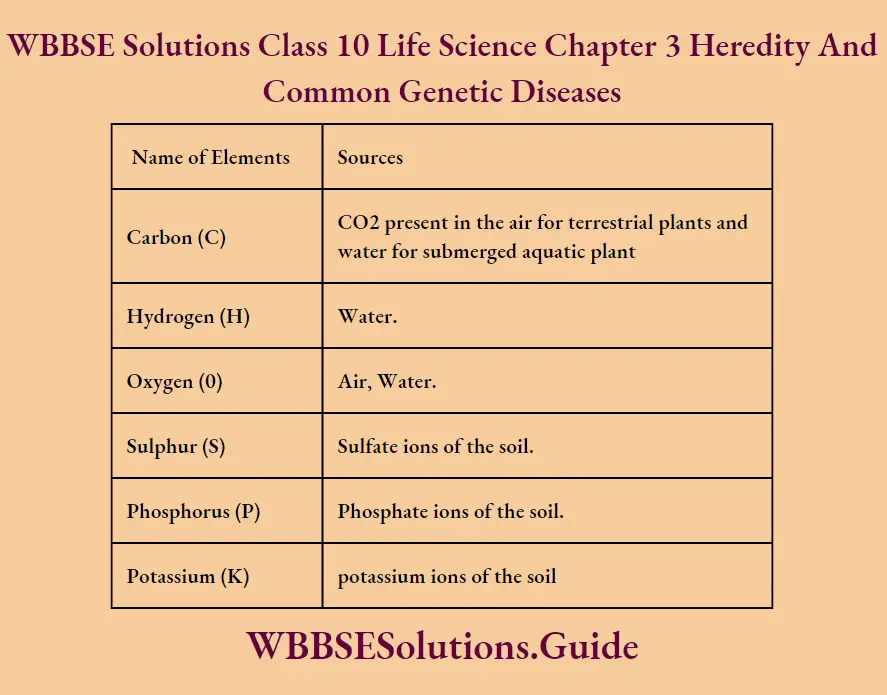
Question 101. What is food? What are the major types of food? What are these? What are their sources?
Answer:
(1) Food:—
The nutrients which supply energy and help in the formation of body substances are called food.
(2) Major types of food:—
The nutrients that supply energy and whose large quantities constitute our diet are called major types of food.
(3) Name of major types of food:—
Carbohydrate, protein, fat.
(4) Sources:
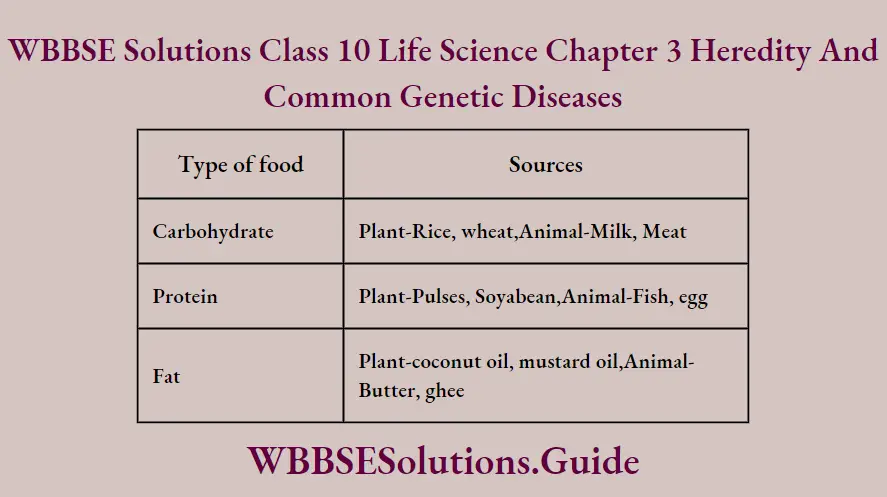
Question 102. Explain with the help of examples the differences between the process of nutrition in plants and animals. Mention the importance of the alimentary system in animals and indicate the place where fat is digested.
Answer:
(1) Difference between plant nutrition and animal nutrition:—
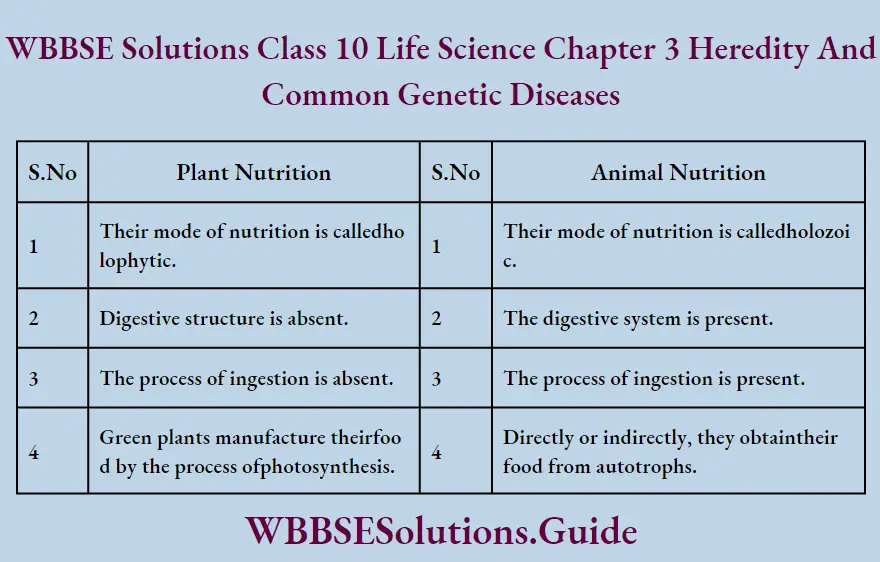
(2) Importance of the alimentary system in animals:—
(1) It helps to store food for a long time.
(2) It produces different types of enzymes from its different parts.
(3) It is the site for proper digestion.
(4) Its some part helps in the absorption of digested food.
(5) The remaining foods after absorption are stored in their last part from where it is ingested.
(3) Place of fat digestion:—
Fat is digested in the stomach and small intestine of the alimentary system.
Question 103. (1) What defects might an infant of 5-6 months develop if it fails to procure sufficient calcium from its mother’s milk to find supplementary food?
Answer:
1. The defects that develop in 5-6 month infants are as follows:-
(1) Retarted bone growth and reduced mineralization of teeth.
(2) Stunded growth will occur.
(3) He will be physically and mentally weak.
(4) He will suffer from Ricket disease.
2. Which types of food must be supplied to a normal healthy adult male in his daily diet, and each in what amount?
Answer:
Type of food Quantity of food
1. Carbohydrate 416 gm.
2. Protein 100 gm.
3. Lipid 100 gm.
3. Write a characteristic feature of each of anabolism and catabolism such that they may be termed processes of opposite nature.
Answer: In anabolism, energy is entrapped, while during respiration energy is released.
Question 104. Define five steps of animal nutrition and mention the organs involved in each step.
Answer:
Five steps of animal nutrition:-
(1) Ingestion:—
The method of capture and intake of food is called ingestion.
Related organ — Man hand.
(2) Digestion:—
The process using which complex food substances are broken down into simpler absorbable forms is called digestion.
Related organs — Mouth and mouth cavity, stomach, small intestine.
(3) Absorption:—
The process using which the digested simpler food materials enter into the cell or blood vessels or lymph from the intestine is called absorption.
Related organs — Villi of small intestine.
(4) Assimilation:—
The process by which the absorbed food substances enter into the Protoplasm and become part of the protoplasm of a cell is called assimilation.
Related Organs — Cells.
(5) Egestion:-
The process by which the undigested food substances are eliminated from the body is called egestion.
Related Organs — Anus.
Question 106. What is a nutrient What is the importance of nutrition?
Answer:
Nutrient :
The organic and inorganic materials that the living organism collects from nature to perform all the fundamental activities of the body are called nutrients,
e.g. Protein, fat, carbohydrates, vitamins, minerals, and water.
Significance / Importance of nutrition :
(1) Growth promotion, repairing wear and tear of the damaged tissues, and gaining energy to control the different metabolic processes are the main functions of nutrition.
(2) Through nutrition the potential energy stored within food is transformed into usable energy. The different physiological functions of the living body like movement, locomotion, excretion, reproduction, etc. are controlled by utilizing this energy.
(3) Nutrition helps to develop the disease-resistant power of the living body.
(4) Nutrition helps to store food in the body for future use. From that stored food (in the plant body mainly as starch and in animals as glycogen and fat) the future energy is produced during shortage of food.
(5) Nutrition plays a special role in the production of heat energy in the organisms to meet the caloric demand.
Question 107. What is Parasitic Nutrition? Classify it with examples.
Answer:
Parasitic Nutrition :
The process by which the plants obtain their necessary nutrition from any other living plants or animals of different species (host) is called parasitic nutrition. Plants drawing in nourishment are called parasites and from which nutrients are drawn in are called hosts. Parasites generally suck in the nutrients by the haustoria of their adventitious roots.
(1) Total Parasite or Holoparasite —
Plants that draw their total nourishment from their respective hosts.
Examples :
Total stem parasite — e.g. Cuscuta reflexa (dodder, swarnalata).
Total root parasite — e.g. Balanophora dioica, Rafflesia Arnoldi.
(2) Partial parasite or Semi-parasite —
Plants can prepare food as they contain chlorophyll but are dependent on the host plants for water and minerals.
Examples —
Partial stem parasite — e.g, Viscum album, Loranthus longiflorus.
Partial root parasite — e.g. Santalum album (B. Chandan).
Question 107. What is Saprophytic Nutrition? Classify it with examples.
Answer:
Saprophytic Nutrition — The nutrition of certain non-green plants that draw their nourishment from the dead and decomposed organic substances formed as a result of the decay of plants and animals is termed saprophytic nutrition.
(1) Total saprophytes— Saprophytes dependent fully on dead decaying organic substances for their nutrition are called total saprophytes.
Examples :
total saprophyte — Mucor, Penicillium, Agaricus, Monotropa uniflora (devoid of roots and chlorophylls).
(2) Partial saprophytes — Green plants that depend partially on dead decaying organic matter for nutrition are called partial saprophytes.
Examples :
Partial saprophyte — Pinus (they absorb organic substances with the help of certain fungus (mycorrhiza) growing on their roots).
Question 108. Discuss Symbiontic Nutrition in animals with examples.
Answer:
Symbiotic nutrition (Mutualism ) :
When two different species of organisms live together enjoying the mutual benefit of nutrition it is called symbiotic nutrition and each species is called a symbiont.
Examples:
The symbiosis between animal and Plant :
Green Hydra and Zoochlorella (algae) live together where green hydra provides protection and shelter to zooxchlorella. In turn, Zoochlorella performs photosynthesis and provides O, to Hydra.
The symbiosis between animals and protozoa :
Termites feed on wood but they do not contain cellulase enzyme. In the digestive system of termites, there are a large number of flagellate protozoa named Trichonympha that can produce the enzyme cellulase which helps in the digestion of cellulose. Thus termites provide shelter to protozoa and protozoa provide cellulose to termites— so both of them mutually benefit
The symbiosis between Ruminant mammals and bacteria :
Ruminant mammal also needs cellulase enzyme for the digestion of cellulose which is produced by symbiotic Rumenococcus bacteria and get food and shelter, in turn, from cattle.
Question 109. Write a short note on the glands of the digestive system.
Answer:
Certain glands such as salivary glands, liver, and pancreas form the accessory organizer:
1. Salivary glands — Three pairs of salivary glands are present in the mouth cavity.
(1) Parotid gland — It is located at the corner of the mandible and ear-lobe on each side of the face.
(2) Submaxillary or Submandibular gland — It is situated in front of the sternomastoid muscle on each side and is surrounded by. the mandible:
(3) Sublingual gland — It is situated beneath the mucous membrane of the floor of the mouth and below the tongue. Salivary ducts, carrying the saliva, open into the mouth near the ‘molar teeth and also on the floor of the mouth.
Function — Salivary glands secrete saliva.
2. Liver — The liver is the largest gland of the body. It is situated below the diaphragm and above and on the right side of the stomach. It is divided mainly into the right and
left lobes. The gall bladder is an elongated, pear-shaped, muscular elastic sac about 7-8 cm long, lying under the lower surface of the liver. Bile secreted by the liver comes
out. through the hepatic and cystic and remains stored in the gall bladder. From the gall bladder, bile passes through the common bile duct into the duodenum.
Functions —
(1) Liver secretes bile.
(2) It acts as an important metabolic as well as excretory organ of the body.
3. Pancreas — Pancreas is a mixed gland that is about 20 cm long and 4 cm broad situated beneath the stomach, within the ‘C’- shaped speed of duodenum.
Functions —
(1) It is composed of pancreatic alveoli which secrete pancreatic juice (digestive juice).
(2) The cells of @ and cells of islets of Langerhans tissue of the pancreas secrete two hormones in the blood, insulin and glucagon.
Question 110. What are the functions of the alimentary system
Answer:
Functions of the Alimentary System:
The main functions of the alimentary system are —
(1) Ingestion — Food is taken by the mouth cavity.
(2) Digestion — The complex food is converted to simple food by the process of digestion in the stomach and small intestine. Different digestive glands take part in this
process.
(3) Absorption — The digested simple food is absorbed by the villi of the small intestine of the alimentary canal.
(4) Egestion — Temporarily stored undigested food in the rectum is eliminated as stool.
Question 111. Discuss the process of digestion.
Answer:
1. Mechanical (Physical) events during digestion :
(1) Chewing (Mastication) :
It is the physical process by which solid food breaks into small fragments by teeth. These smaller fragments of food mixed with saliva form bolus that are easily swallowed. The total surface area of fragmented food particles is increased so that digestive enzymes can act better.
(2) Swallowing (Deglutition) :
The physical process (movement) by which food bolus passes from the mouth cavity into the stomach through the esophagus is called swallowing or deglutition. It is a complex inborn reflex process.
(3) Peristalsis :
It is the slow but lateral wavy movement of the alimentary canal consisting of waves of alternate contraction and relaxation by which food materials move downward in the alimentary canal. Peristalsis helps in digestion by proper mixing of food with digestive juice. It also helps in the absorption of digested food and the digestion of faces.
2. Biochemical (Enzymatic) events during digestion :
Protein, fat, carbohydrate and other macromolecules must be properly digested into soluble micromolecules so that they can be properly absorbed. During this digestion, there are profound chemical changes. Various digestive enzymes are responsible for biochemical reactions at different parts of the alimentary canal.
(1) Hydrolysis :
It means the breakdown of chemical bonds of macromolecules of food by the addition of water during enzymatic digestion.
Example : Sucrose + H2O __Sucrase _> glucose + fructose
(C12H22O11 (C6H12O6) (C6H12O6)
Question 112. Write a short note on digestive enzymes.
Answer:
Digestive Enzymes :
Enzymes take part in digestive enzymes. They are of three types —
(1) Proteolytic enzymes or Protein — hydrolyzing enzymes — These enzymes hydrolyze proteins into polypeptides and amino acids, e.g. — Pepsin, Trypsin, Chymotrypsin, Erepsin, Renin.
(2) Lipolytic enzymes or Lipid hydrolyzing enzymes — These enzymes hydrolyze lipids (fats) into fatty acid and glycerol, e.g. Lipase (Gastric Lipase, Pancreatic Lipase,
Intestinal lipase).
(3) Amylolytic enzymes or Carbohydrate hydrolyzing enzymes — These enzymes hydrolyze the carbohydrate into needed items (glucose), e.g. — Amylase, Sucrase, Lactase, Maltase, etc.
Question 113. Write a short note on metabolism.
Answer:
Metabolism:
Definition :
Metabolism is the total of biochemical reactions in the living cell of an organism, which involves the synthesis of complex substances from simple ones with the utilization of energy, and the breakdown of complex substances into simpler ones with the release of energy.
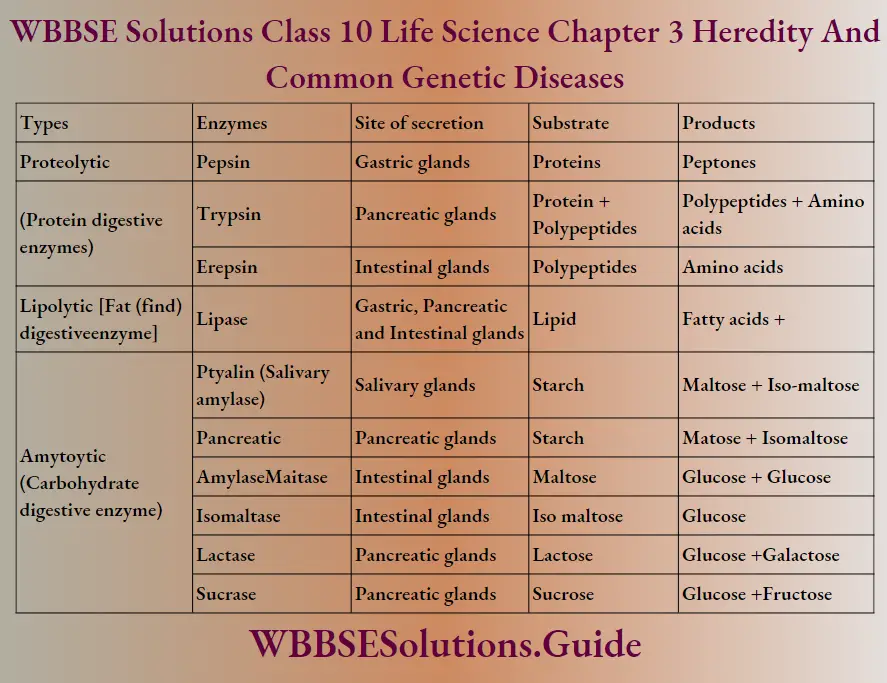
The process of metabolism is completed in two steps — anabolism and catabolism.
Anabolism :
It is the constructive process by which complex molecules are formed from simpler units with the help of energy increasing the dry weight of the organism.
Example: Formation of glycogen from glucose; formation of protein from amino acids, etc.
Catabolism :
It is the destructive process by which complex molecules are broken into simpler units with the liberation of energy resulting in a decrease in the dry weight of the organism.
Example: By respiration, glucose is broken into CO2 and H2O with the release of energy.
Anabolism and catabolism are opposite processes of reversible chemical reactions which may be represented as follows :
anabolism
Small molecules <——-> Large molecules
catabolism
Question 114. State the significance of metabolism. Define a balanced diet.
Answer:
Significance of metabolism:
1. The functional activities of the body depend on various metabolic reactions continuously taking place within the cells of an organism.
2. Various anabolic reactions result in the formation of macromolecules like fat, glycogen, etc. that are stored in respective organs, e.g. fat in adipose tissue, glycogen in liver and muscle, etc.
3. Many enzymes participate in all metabolic reactions resulting in intramolecular or intermolecular transformation.
Question 115. Calculate the daily energy requirement for an adult human.
Answer:
Calculation of energy required daily for an adult human :
Calorie (cal) is the unit of energy and is defined as the amount of heat energy which can raise kilocalorie (Kcal).
For daily calorie requirements of an adult healthy man, weighing about 60 — 70 kg and doing moderate work is about 2500 — 3000 Kcal. This amount of energy is derived from energy-yielding food like carbohydrates, proteins, and fats. On complete oxidation (combustion) these types of food yield the following amount of energy :
1 gram of carbohydrate ——>yields —4.0Kcal
1 gram of protein ——-> Yields — 4.1 Kcal
1 gram of fat ——-> Yields — 9.3 Kcal
Therefore, a man (60 — 70 kg body weight) doing moderate work requires about 3000 Calories. Thus to fulfill this calorie requirement he should consume the following amount of carbohydrates, proteins, and fats in the ratio of approximately 4: 1: 1, (Carbohydrate: Protein: Fat) along with vitamins, minerals, and water to satisfy his or her daily calorie (energy) requirements.
Carbohydrates 415 gram =415 x 4.0 = 1660 Kcal
Proteins 100 gram 100 gram =100×4.1 = 410 Kcal
Fats 100 gram 100 gram =100 x 9.3 = 930 Kcal
—————————————————-
Total energy yields = 3000 Kcal
Question 116. Describe the different types of plant nutrition.
Answer:
Nutrition in plants :
Plants and animals do not obtain food by the same processes. Plants and some bacteria have the green pigment chlorophyll to help synthesize food, while animals, fungi, and other bacteria depend on other organisms for food.
Based on this, there are two main modes of nutrition: autotrophic and heterotrophic.
1. Autotrophic nutrition :
The term ‘autotroph’ is derived from two Greek words autos (self) and trophe (nutrition). In autotrophic nutrition, an organism makes its food from simple raw materials.
2. Heterotrophic nutrition :
Unlike autotrophs, which manufacture their food, heterotrophic organisms obtain food from other organisms. All animals and non-green plants come under this category.
Depending upon the mode of living and the mode of intake of food, heterotrophs may be parasitic, saprophytic, symbiotic, and insectivorous.
(1) Parasitic :
Parasites, obtain their nutrition from hosts. These parasites maintain physical contact with the host plant through haustoria (parasitic roots). These haustoria penetrate host tissue make connections with the conducting elements of the host and draw nourishment.
Example :
Total stem parasites like Cuscuta and root parasites like Orobanche are never green and consequently, they have no power to prepare their food. They get all their food supply from the host plants.
(2) Saprophytic :
Saprophytes get their nutrition from dead and decaying organic matter.
Example :
Neottia (Bird’s nest plant) and Monotropa (Indian pipe) are flowering plants whose roots constitute a mycorrhizal association with fungal hyphae, which helps in absorption.
(3) Symbiotic :
Symbiosis is the habitual living together of organisms of different species. The term is usually restricted to a dependent relationship that is beneficial to both participants (also called mutualism). Symbiotic relationships in plants include the interdependence of the algae and the fungus that form a lichen and the relationship between leguminous plants and the nitrogen-fixing bacteria, which is important in agriculture (nitrogen cycle).
(4) Insectivorous :
They are said to be partly autotrophic and partly heterotrophic. These autotrophs supplement their nutritional requirements by trapping and digesting insects and other small animals. The trapped insects are killed and their proteins are digested by proteolytic enzymes secreted by the epidermis of the leaf.
Question 117. Describe the different types of animal nutrition.
Answer:
Nutrition in animals :
Animals are generally heterotrophic and perform holozoic nutrition. Holozoic nutrition involves the ingestion of complex organic substances. The food of most animals contains large organic substances. In this mode, small or large particles of food are consumed through an opening called mouth (ingestion). Then these are hydrolyzed into simpler and soluble forms (digestion). Simplified products are absorbed into the body and the undigested product is removed from the body and the undigested product is removed from the body (egestion).
Holozoic nutrition is broadly classified into the following categories —
1. Parasitic nutrition is a mode of heterotrophic nutrition where an organism (known as a parasite) lives on the body surface or inside the body of another type of organism (known as a host). The parasite obtains nutrition directly from the body of the host. Since these parasites derive their nourishment from their host, this interaction is often described as harmful to the host. A few examples of parasites are tapeworms, fleas, and barnacles.
2. Symbiotic nutrition :
Symbiotic nutrition is close and often long-term interaction between two or more different biological species. A symbiotic relationship is where two organisms depend on each other and are both benefited by their relationship.
Examples :
A certain kind of bacteria lives in the intestines of humans and many other animals. The human cannot digest all of the food that it eats. The bacteria eat the food that the human cannot digest and partially digest it, allowing the human to finish the job. The bacteria benefit by getting food and shelter, and the humans benefit by being able to digest the food they eat.
3. Saprozoic nutrition :
Nutrition of an animal by absorption of dissolved salts and simple organic nutrients from the surrounding medium; also refers to feeding on decaying organic matter. In this kind of nutrition, the process is started from half or fully broken down macro molecules and is a kind of extracellular digestion that is most often carried out through active transportation.
For example: spiders, house flies, etc.
4. Coprophagy :
Coprophagy is the consumption of feces. Coprophagy refers to any kind of feces eating including the eating of other species (heterospecifics), other individuals (allocoprophagy), or its own (autocoprophagy). These feces contain substantial amounts of semi-digested food.
The most notable feces-eating insect is the dung beetle and the most common is the fly. Pigs eat the feces of humans that leave a significant amount of semi-digested matter.
5. Sanguinivory :
Sanguinivory or hematophagy is the habit of certain animals feeding on blood. Sanguinivores feed on the blood of the vertebrates.
Examples :
Female mosquitoes, leeches, vampire bats, etc.
Question 118. Write a short note on human dietary needs.
Answer:
Human dietary needs :
The human diet must provide the following :
1. Calories — enough to meet our daily energy needs.
2. Amino acids — There are nine, or so, “essential” amino acids that we need for protein synthesis and that we cannot synthesize from other precursors.
3. Fatty acids — There are three “essential” fatty acids that we cannot synthesize from other precursors.
4. Minerals — Inorganic ions. We probably need 18 different ones: a few like calcium in relatively large amounts; most, like zinc, in “trace” amounts.
5. Vitamins — A dozen, or so, small organic molecules that we cannot synthesize from other precursors in our diet.
Question 119. What is the importance of a balanced diet?
Answer:
Importance of a balanced diet:
A balanced diet is important because your body’s organs and tissues need proper nutrition to work effectively. Without good nutrition, your body is more prone to disease, infection, fatigue, and poor performance. Children with a poor diet run the risk of growth and developmental problems. Bad eating habits can continue for the rest of their lives.
A balanced diet is nothing but eating the right amount of food every day. How much food you need every day depends greatly on the activities you do. Other factors like age and gender also affect the amount of energy needed by every person every day. A balanced. diet provides the body with all the necessary nutrients and vitamins, thereby improving the functioning of the immune system. This not only reduces the possibility of being infected by seasonal allergies but also prevents serious health risks, like cancer, diabetes, cardiovascular diseases, etc. Such a diet also keeps you mentally by keeping your mind more alert.
Let us get introduced to the Healthy Diet Pyramid or the Food Pyramid. The Food Pyramid is widely used as a guide to eating the right amount of food every day. In the food pyramid, we can find 4 main groups of foods. A pyramid shape is used because it fits very much to illustrate the amount of food we need every day. If you take a look at the pyramid, its base is winder and as it goes higher it becomes narrower until it reaches its tip. As we go higher to the top, we eat a lesser amount of each food and as go lower, we eat more.
Question 120. Describe the different metabolism-related problems.
Answer:
The different metabolism
An abnormal diet may lead to certain metabolism-related problems, in which a person suffers from different health hazards. A few of those are mentioned below.
1. Diabetes :
In this disease, the blood sugar level goes above normal [70 — 110 mg/ dl in fasting]. It may lead to dysfunction of the kidneys, eyes heart nerves, and other organs
2. Liver cirrhosis :
This is caused by the consumption of excessive alcohol and fatty food. In this disease, liver tissue is seriously damaged, which may transform into liver cancer if not treated early.
3. High blood pressure :
Systolic and Diastolic pressure above 140 and 90 mm Hg respectively is treated as high blood pressure. This disease increases the risk of cardiac and cerebral attack, kidney dysfunction, and many other health problems.
4. Obesity :
It is a metabolism-related problem that occurs due to excess intake of calories. This disease leads to elevated blood sugar, blood pressure, and cardiovascular diseases.
5. Atherosclerosis :
This is a cardiovascular disease in which the walls of arteries become rigid and the lumen reduces. It is caused by to deposition of fat derivatives and other materials in the walls of arteries.
6. Arthritis :
This is a painful inflammatory disease, caused by due deposition of some toxic metabolic wastes within bone joints.
7. Ketosis :
Prolonged fasting leads to excessive protein breakdown and discharge of ketone through urine.
8. Goitre :
A deficiency of iodine in food leads to this disease, where the function of the thyroid gland is affected.
Question 121. What are biomolecules? What is the average composition of plant and animal cells?
Answer:
Biomolecules:
Building block molecules are called biomolecules. They make up the body of organisms, cells, and cell organelles.
It is of two types —
(1) Macromolecules :
Small molecule size with low molecular weight.
eg. minerals, water, gases, carbohydrates, etc,
(2) Macromolecules :
Large molecule size with high molecular weight. It is formed by polymerization of many micromolecules of one type.
eg: Protein, Polysaccharides, Nucleic acid.
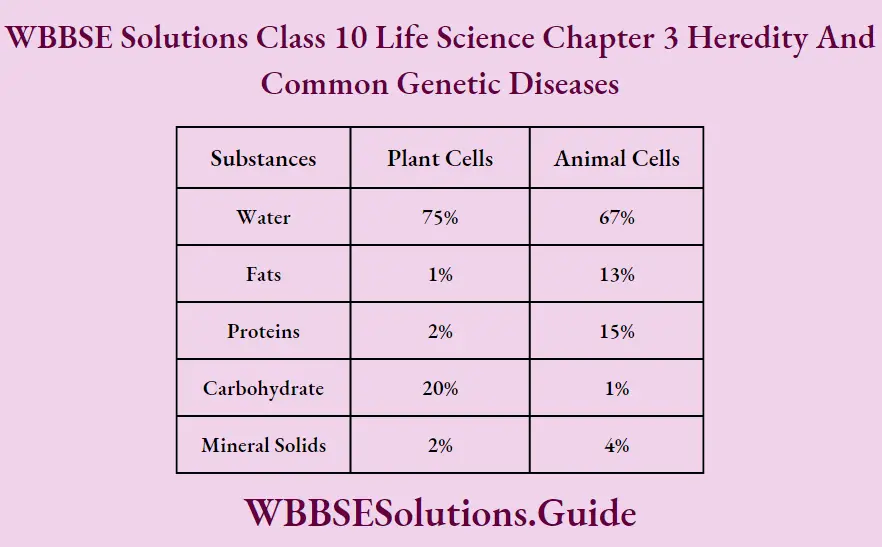
Question 122. Write the roles of inorganic compounds in the body of a living organism.
Answer:
Water :
It is the most abundant inorganic compound in living organisms. On average water forms 65-75% of protoplasm.
It acts as a solvent for all soluble substances in the cell. It provides an aqueous medium for various cellular reactions. It provides proper hydration to protoplasm. It provides turgidity to the cells in plants. Water maintains constant body temp. In plants and animals. Water acts as a source of hydrogen in photosynthesis.
Gases :
The main gases which play an important role in metabolism are O2 and CO2. Oxygen is needed for the aerobic breakdown of organic food and the release of energy for life. Carbon dioxide is used by photosynthetic autotrophs for the synthesis of carbohydrates.
Question 123. What are carbohydrates? Write its functions.
Answer:
Carbohydrates:
Organic compound containing carbon, hydrogen, and oxygen. Its general formula is Cn(H20)n. Based on the number of sugar units in the molecule, it is classified as –
(1) Monosaccharides :
Contain only one sugar unit known as glycoses or simple sugar. These are the reducing agents.
Eg. Glucose (C6H12O6)
(2) Oligosaccharides :
Carbohydrates with 2-9 monosaccharides joined together.
glucose + glucose -» Maltose
glucose + fructose -» Sucrose
glucose + galactose -» Lactose
(3) Polysaccharides :
Carbohydrates with 10 or more monosaccharide units. These are macromolecules.
Eg: Starch and cellulose.
Functions :
(1) These are structural components
(2) Play an important role in metabolic functions
(3) as a potential source of energy in cells.
Question 124. What are Amino Acids and proteins? Write their functions.
Answer:
Amino Acids and proteins
Amino acids are microbiomolecules with low molecular weight. It contains C, H, and N, S.
These are essential and non-essential amino acids.
Essential amino acids are 8 in number. These are not synthesized in animal cells and obtained through diety only. eg. Valine, Leucine, Methionine, Lysine, etc.
Non-essential amino acids are 10 in number and naturally synthesized in the body.
eg. Alanine, Arginine, Aspartic acid, Serine.
Semi-essential Amino Acid :
Only 2 in number can be synthesized in animal cells but not enough. Eg. Arginine and Histidine.
Amino Acids are used in Protein Synthesis, glucose, vitamins, and hormone synthesis.
Question 125. Write the structure and functions of the protein.
Answer:
These are long-chain polymers of amino acids with very high molecular weight. It contains C, H, O, N, S and P. The bond which joins two amino acid molecules is a peptide bond.
Types of protein :
(1) Simple protein :
made of only amino acids.
eg: albumin, histone.
(2) Conjugated protein :
made of amino acid + some non-protein group.
eg: Nucleoprotein, Glycoprotein.
(3) Derived protein :
These are intermediate degradation products of protein, obtained on hydrolysis of protein.
Functions of Protein:
(1) These are structural constituents of protoplasm, protoplasmic organelle, and cell membrane.
(2) Enzymes are proteins, essential for metabolism.
(3) Cytochrome pigment helps in photosynthesis and Respiration.
(4) Haemoglobin transports oxygen in the body.
(5) Actin and myosin help in muscle contraction.
(6) Fibrinogen and thrombin help in blood clotting.
Question 126. Write the structure and functions of lipids in the human body.
Answer:
Lipids are oily, greasy organic compounds, insoluble in water. Lipid molecule contains C, H, and O. They have less percentage of oxygen.
These are :
(1) Simple lipids :
are esters of fatty acids with alcohol.
(2) Compound lipids :
These are fatty acids + Alcohol + Some other group.
eg. Phospholipid, Glycolipid, Steroids Carotenoids.
Functions of lipids:
(1 Release more energy than carbohydrate
(2) Constituent of cell membrane
(3) Acts as a solvent for fat-soluble vitamins
(4) Acts as insulator.
Question 127. What are Nucleotides and Nucleic Acids?
Answer:
Nucleotides :
Nucleotides are the building block unit for Nucleic acid. These are macromolecules with low molecular weight.
Nucleotide = Pentose Sugar + Nitrogenous base + Phosphate group.
Nucleic Acid :
These are long-chain polynucleotide macromolecules. These are the most important biomolecules, and control most biological processes, including heredity.
There are two types of Nucleic acid – DNA and RNA.
DNA (Deoxyribose Nucleic Acid) :
double-stranded helical structure. Two strands are antiparallel and coiled around each other. Complementary base pairs are :
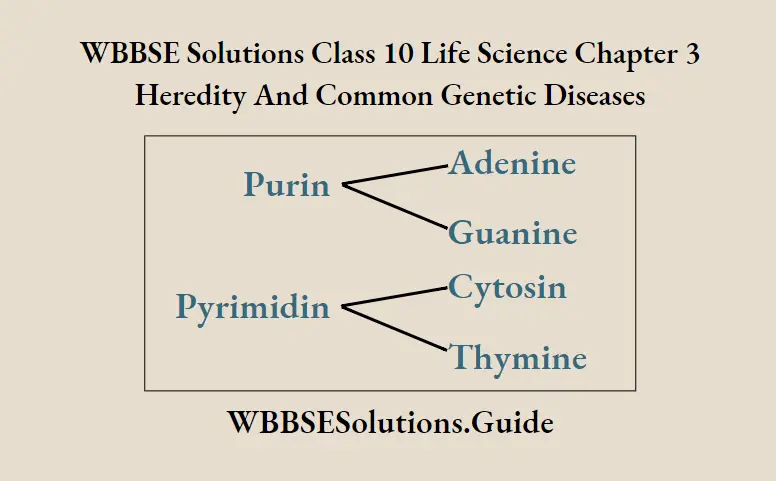
Adenine is attached to thymine with a double hydrogen bond. Guanine with cytosine with a triple hydrogen bond. DNA has the unique ability of self-replication.
Functions of DNA:
(1) It is the genetic material of all organisms (except some viruses)
(2) It takes part in genetic recombination.
(3) It can replicate itself.
RNA (Ribose Nucleic Acid): Single stranded, long chain polynucleotide. Complementary base pairs are — Adenine, Guanine, cytosine, and Uracil. These are mainly. present in cell cytoplasm.
Types:
Messenger RNA (mRNA)
Transfer RNA (tRNA)
Ribosomal RNA (rRNA)
Functions :
(1) Involved in protein synthesis
(2) In certain viruses acts as the genetic material.
Question 128. What are vitamins? Writes their roles in the human body.
Answer:
Vitamins :
Vitamins are complex organic chemicals that are present in our food in small quantities. Vitamins are essential for growth, good health, proper vision, normal digestion process, and coordinated activities of our body.
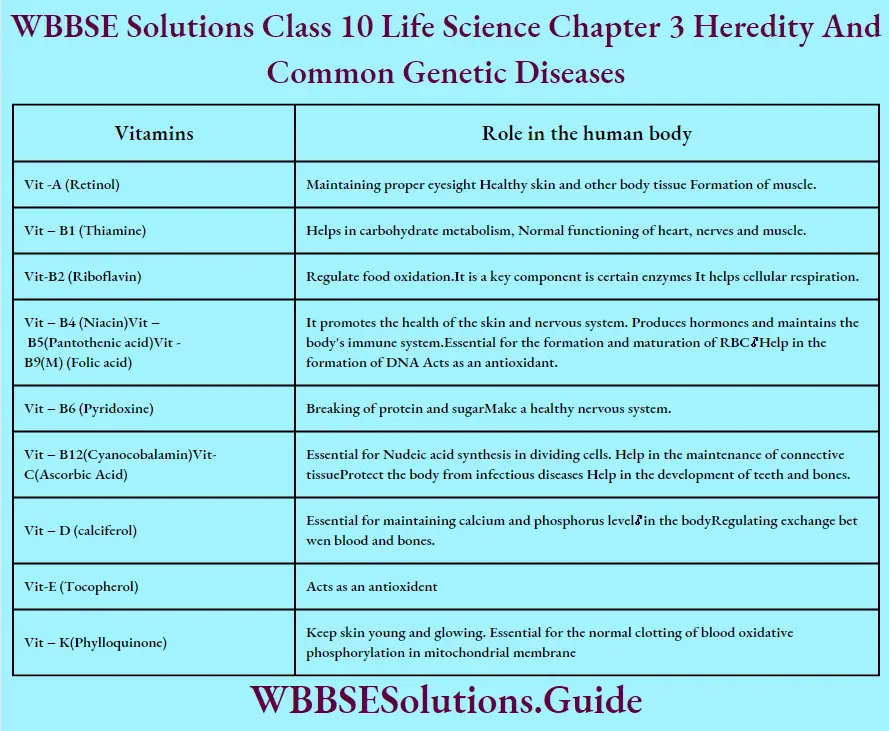
These are :
(1) Fat-soluble vitamins — A, D, E, K
(2) Water soluble vitamins — B complex and C
Question 129. What are minearls? Write the role of minerals in human body.
Answer:
Minerals :
These are an inorganic element, occurring in the form of their salts.
Elements that are required in larger amounts for normal nutrition are called macroelements. Eg, C, H, N, O, P, Ca.
Elements which are reuiqred in very small amount for normal nutrition are called microelement. Eg, Iron, Copper, Zinc, Iodine.
Question 130. (1) Define excretion. How does it differ from secretion ?
Answer:
Excretion
The process by which living organisms get rid of their metabolic wastes from the body, through the excretory organs is called excretion.
Secretion is the process of discharge of essential substances from the cell, through the cell membrance for special function within the body is called secretion. Eg. enzyme from exocrine gland and hormones from endocrine glands.
(2) Why is excretion necessary?
Answer:
(1) Excretory products are harmful to the body. So it is necessary to remove them.
(2) To maintain the contents of the protoplasm.
(3) Most of the plant excretory materials have great economic and medicinal importance. _
(4) To maintain water balance and osmotic equilibrium.
(3) Why is excretion a catabolic process ?
Answer:
(1) Formation of excretory products occurs by catabolic process (Break down).
(2) Elimination of metabolic waste products from the body takes place (wieght decreases).
(3) Result in decrease in dry weight of the organism.
Question 131. Name the excretory products in plants in tabular form with their uses.
Answer:
Non nitrogenous excretory products — Latex, Resin Tannin, gums, crystal, organic acids, essential oils.
Nitrogenous waste products — Alkaloids like Morphine, Quinine, Nicotine, Atropine, Reserpine, Caffeine, Thein etc. i
Non-nitrogenous waste products
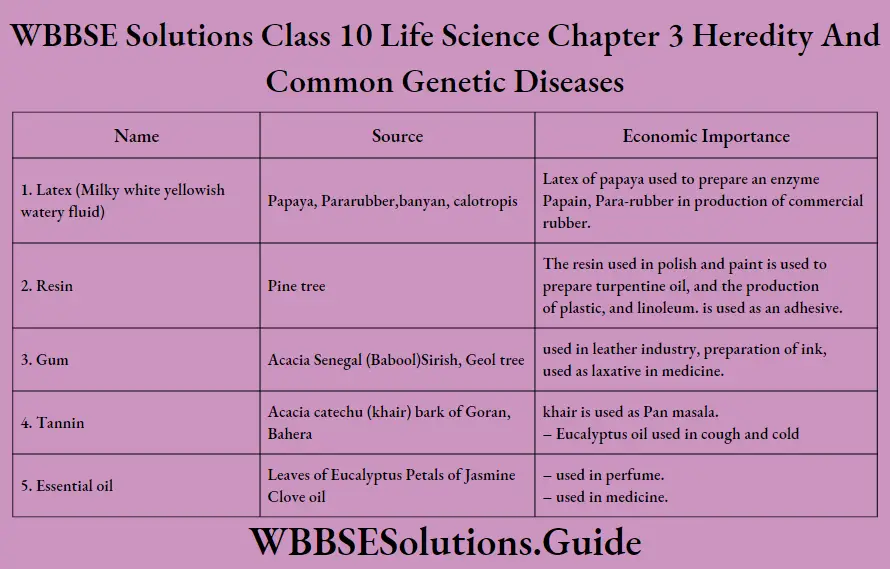
Non-nitrogenous waste products
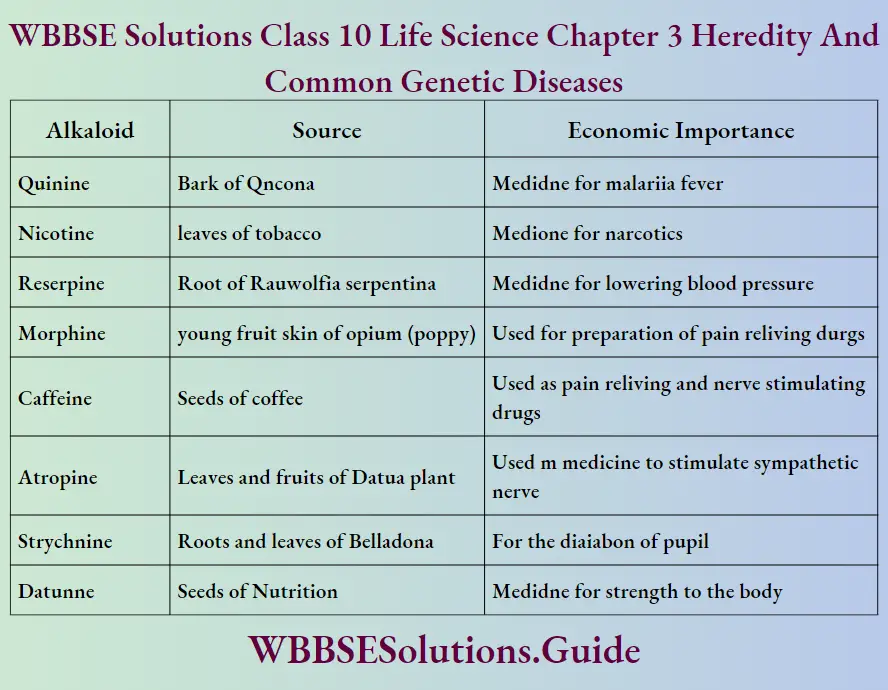
Question 132. What is the process of excretion in plants ?
Answer:
There are no speical excretory organs in plants. The metabolic waste products are stored in root, stem, leaves, flowers and fruits. There is less formation of excretory products in plants and have no harm if stored in their body.
The process of excretion in plants are —
(1) Shedding of bark :
Plants like Arjun, Guava store their excretory products in the bark, and is eliminated at regular interval through the removal of bark.
(2) Shedding of leaves :
In deciduous plants metabolic wastes are transported and stored in the cells of leaves, and these wastes are eleminated by following of leaves. eg. Silk cotton, Sirish, etc.
(3) Shedding of flowers :
Metabolic wastes stored within the flower petals and also in the bract, are removed along with shedding of these organs
(4) Shedding of fruits :
Fruits like apple (malic acid), tamarind (tartaric acid), lemon (citric acid), removed by falling of fruits.
Question 132. “All excretory products are waste products but all waste products are not excretory products” Comment.
Answer: All excretory products are waste products but all waste products are not excretory products because they are toxic to the body and causes harm, if they store for longer time. Stool is not produced out of metabolism, hence it is not counted as an excretory substance.
Question 133. Name the excretory organs in animals.
Answer: The organs which are related to the removal of excretory products are called excretory organs
Different animals have characteristics of excretory organs as :
1. Contractile vacuole -—Amoeba, Paramecium, chlamydomonas
2. Flame cells — Flatworm. A bunch of flame cells called protonephridia
3. Nephridia — Earthworm, Leach
4. Malpighian tubule — Cockroach
5. Green gland — Prawn
6. Kidney ___ Vertebrates (fish, amphibia, birds, reptiles, and mammals)
7. Scorpion — Coxal gland
8. Snail —- Nephridia
Question 134. Explain with diagram the excretory system of human.
Answer:
Excretory system of human
The excretory system of human comprises two kidneys, two ureters, one urinary bladder and one urethra. A sphincter muscle is present at the junciton of Urinary bladder and Urethra, by which we can evacuate urine as our desire.
Each kidney is bean shaped, dark reddish brown in colour situated on the posterior portion of abdominal cavity on either side of vertebral column. Right kidney is slighly smaller than the left and the left is situated slightly above the right one. In adults its weight is 125-170 grms. The lateral margin is convex, while the medium margin has a concavity in the middle called hilum.
Internally each kidney is distinguished in two zones — an outer dark red zone — cortex and inner zone — medulla. Ureter entering through the hilum expands forming wide a funnel shaped str. called Pelvis which has at its free end, a number of cup like cavities called colyces. The inner border of medullary region is extended into a series of 15-16 cone like projections called renal pyramids. Fach kidney contains about
one million of nephron.
Functions of kidney :
(1) It excretes nitrogeneous and sulphur containing waste products of protein metabolism.
(2) It helpes in the osmo-regulation of the body.
(3) It helps to keep acid-base balance.
(4) It eliminates drugs and various toxic substances from the body.
(5) It regulates blood pressure.
(6) It helps in maintaining the osmotic pressure in blood and tissue.
(7) It plays an important role in Vit D metabolism.
(8) It synthesizes ammonia, hippuric acid and other substances.
Ureter :
Ureter are two in number 35 cm long, slightly curved tube, emerging from the renal pelvis. It connects kidney to the urinay bladder.
Urinary bladder and Urethra :
Urinary bladder is a muscular sac located in abdominal cavity. Urethra is a muscular tube that arises from bladder. Urinary bladder retains urine for some time when the bladder is full, the muscles of bladder contracts and urine goes out.
Question 135. What are Nephrons ? Write the structure and functions of nephron.
Answer:
Nephrons :
Nephron is the structural and functional unit of kideny. Each kidney consists millions of nephron. Average length of each nephron is 5 cm.
There are two types of nephrons :
(1) Superficial nephrons :
Present in the outer 2/3 of the cortex. They are smaller in size and constitute 85% of the total nephron. They work in normal condition.
(2) Juxtamedullary nephrons :
Present in the inner 1/3 of the cortex. They are larger in size and constitute 15% of total nephron. They work under stress condition.
Histologically, a nephron is made up of 2 parts, viz. Malpighian corpuscle and Renal tubule.
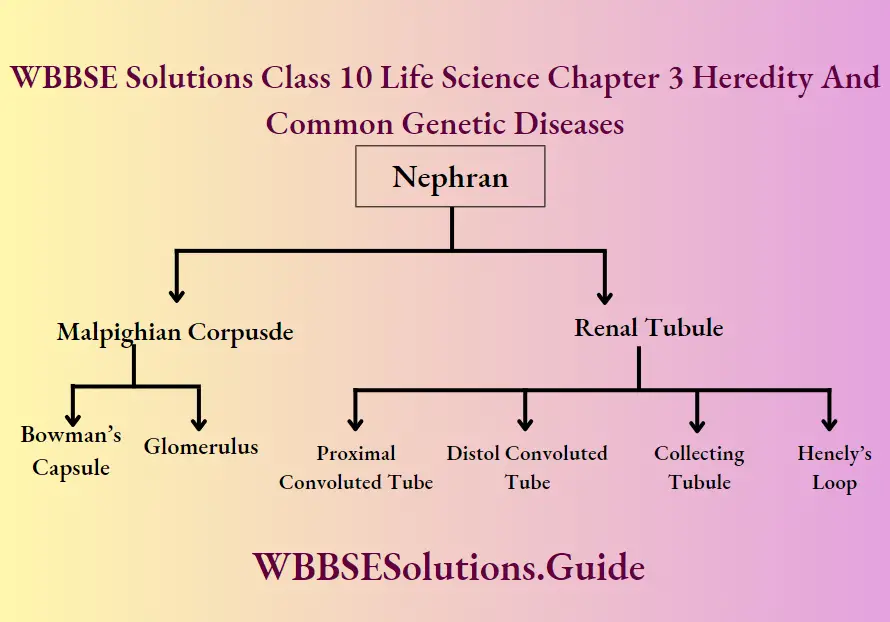
The free and blind end of nephron forms a cup shaped double walled structure called Bowman’s capsule. The outer layer of capsule is caled Parietal layer and the inner layer is called visceral layer.
Glomerulus :
It is a bunch of loop like capillaries ean eige within the Bowman’s capsule, formed by short and wide affarent arteriole (a branch of renal artery) and long and narrow efferent arteriole.
Malpighian corpusels forms the filtering bed and help in urine formation.
Renal Tubule is tubular portion of nephron.
(1) PCT :
descending tubule, highly coiled, situated in the cortical region of kidney. The inner wall is lined by cuboidal epithelium. It absorbs essential nutrients and huge amount of water.
(2) Henley’’s loop :
is U shaped middle portion, situated in the medullary region of the kidney. It absorbs water and electrolyte.
(3) DCT:
It is ascending tubule, situated in the cortical part of kidney: Inner wall is cuboidal epithelium. It reabsorbs sodium ion, water and bicarbonate.
Question 136. Write the steps of urine formation in human kidney.
Answer:
Urine formation involves three main steps :
Ultrafiltration, tubular reabsorption and tubular secretion.
(1) Ultra filtration (Glomerular ultrafiltration) :
The diameter of the afferent arteriole is double that of the efferent arteriole. Hence more blood comes in the glomerulus and less blood goes out of the glomerulus.
It creates a, pressure and causes filtration of various materials from blood. This process of filtration of blood is called ultrafiltration. The Glomerular Filtration Rate in normal healthy person is 125 ml/minute i.e 180 Ltr/day.
Tubular Reabsorption :
The glomerular filtrate contians many essential substances like phosphate, bicarbonate, chlorine ions, vit-C, amino acid, glucose, absorbed by the tublues. All these reabsorbed materials then return to blood. The process of tubular reabsorption is influened by hormone ADH and Aldosterone.
Tubular Secretion :
During urine formation, tubular cells secrete substances like H* K*and ammonia, creatinine, hippuric acid, penicillin, etc..These secretion, play an important in urine formation as it helps in the maintence of ionic and acid-base balance of body fluid.
Question 137. Write the role of Liver, Lungs and skin in the process of excretion.
Answer:
Liver, lungs and skin are accessory excretory organs in human.
Role of Liver :
Within liver, ammonia is converted into Urea in ornithine cycle. Liver also secretes bile which containes some excretory substances like cholesterol, drugs, steroids and bile pigment-bilirubin and biliverdin which is eliminated front the body in the form of facaes.
Role of Lungs :
CO2 which is produced by the catabolic process of glucose in the cells reacts with water to form carbonic acid (C6H12O6 ). This CO2 along with water vapour, alcohol, acetone, ammonia are excreted during expiration through the lungs.
Role of skin :
Normally skin is the protective layer of the body. It contains numerous sweat glands which secrete sweat. Sweat contains urea, lactic acid, creatinine, uric acid, salt, etc. These excretory products along with water are excreted. The sweat secretion also keep our body cool in summer.
Question 138. What is Urine? Write the composition of Urine.
Answer:
Urine:
Urine is clear, yellow coloured weakly acid, aromatic watery solution of different metabolic wastes formed in the nephron of kidney.
Normally urnie consists 94.96% water, 4-6% of solids, Inorganic substances like Na, Cl, KCI, PO4, SO4, Ca, and organic substance like urea, uric, acid, creatinine, ammonia, hippuric acid, urochrome, oxalic acid, latic acid, ketone bodies, etc. are present.
Among abnormal constituents of urine are glucose, bile pigment, blood and pus, protein and ketone bodies.
11. Give an account of different essential oils produced from plants and their economic importance.
Answer:
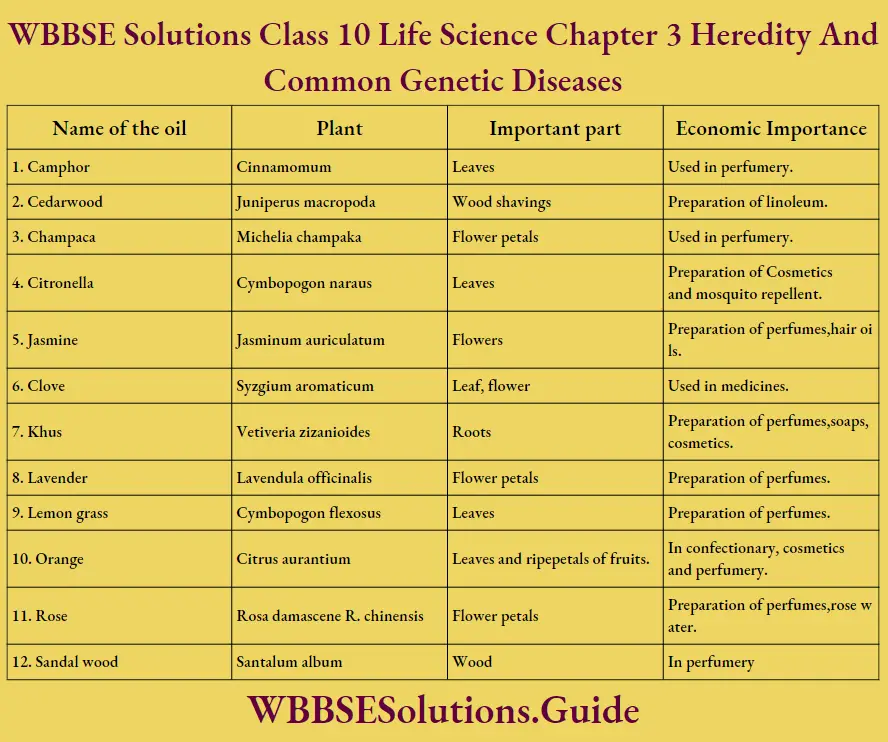
Question 139. State the importance of Excretion.
Answer:
Importance / Significance of Excretion :
1. Maintenance of normal health — The excretory products are harmuful to the body. Excess amount of excretory substances when accumulated in the body causes toxic effects or even may cause death to the organism. Thus regular excretion of these excretory products prevents from toxic effects and keeps body fit.
2. Maintenance of protoplasmic substances — Excretion has some role to maintain the balances of different protoplasmic substances in the cell, the protoplasm in turn helps to keep normal life processes of the organism.
3. Maintenance of osmosis — Excretion has some role on the regulation of osmosis.
4. Role in ecosystem — The excretory products are formed by the breakdown of nutrients.
5. Economic importances — The economic importances of excretory products of the plants are vast for human aswell as animal kingdom.
6. Maintenance of water balance — In various organisms mainly in animal and from human body excess amount of body water is excreted (eliminated) to maintain the water balance by this process.
Question 140. Why are lesser excretory materials formed in plant ?
Answer:
Reasons which cause lesser formation of excretory materials in plants:
1. Ammonia produced due to metabolism is utilized in the formation of various nitrogenous compounds by plants.
2. Carbon dioxide and water obtained due to respiration are used during photosynthesis. The oxygen obtained from photosynthesis is used in the respiration.
3. In plants the materials are formed.
4. In plant body the excretory materials which do not contain nitrogen are often stored within certain organs as they are not toxic.
5. In plant body the protein and nitrogenous compounds are broken down to ammonia which act as an useful substance.
From all these above reasons we can find that plant excretory products are less harmful than anumal excretory products.
Question 141. Write a note different excretory organs in animals with their functions.
Answer:
Different animals have characteristic excretory organ that has various shape, size and structure but perform same function of excretion as well as water balance of the body called osmoregulation some common examples of animal excretory organs are as follows :
(1) Contractile vacuole :
It is a subcellular membranous organelle, mainly found in protists (e.g. Amoeba, Paramoecium) and unicellular algae (e.g. Chlamydomonas), which primarily helps in osmoregulation.
Excess water is collected in the contractile vacuole and so the vacuole swells. Then the vacuole comes in contact with cell membrane, contracts and releases excess water out of the cell.
(2) Flame cell :
It is a specialized excretory cell found mainly in Platyhelminthes or flatworm (e.g. Taenia solium or Tape worm), that removes excretory product out of the body. Bunch of flame cells are together called as protonephridia.
Flame cell is a nucleated cup-shaped cell body with bunch of flagella inside that looks like flame of fire, Many flame cells are attached with common excretory canal. Collected excretory product from the cells is released in excretory canal and then goes outside.
(3) Nephridia :
This is the excretory as well as osmoregulatory organ found mainly in Annelida like earthworm, leech, etc. There are two basic types of nephridia — metanephridia (larger) and protonephridia (smaller). In earthworm, metanephridia is found.
In consists of ciliated funnel called nephrostome the collects excretory product from coelom. The product flows through nephridial tubule and finally goes out through nephridiopore. In the tubule, however, various necessary substances are reabsorbed,
(4) Malpighian tubule :
This is tubular excretory as well as osmoregulatory organ found in different Arthropoda (primarily in insects like cockroach and others).
These are bunch of slender tubules, located at the junction of midgut and hindgut. Most tubules are highly convoluted. The number tubules varies. These tubules collect excretory product from haemolymph and drain it into hindgut, from where the product moves through hindgut into rectum and finally goes out through anus.
(5) Kidney :
This is the most important excretory oragan in higher animals. All vertebrates have kindney. Like human kidney, they are made up of many nephrons (the structural and functional unit of kidney).
Kidney is mainly responsible for elimination of toxic metabolic waste product as well as osmoregulation, mineral balance and so on.
Question 142. What is blood ? What are the different components of blood?
Answer:
Blood :
Blood is a fluid connective tissue that circulate in the conducting vessels carrying nourishment and oxygen to all parts of the body and bringing metabolic wastes from them. It looks red due to the presence of an iron pigment namely haemoglobin.
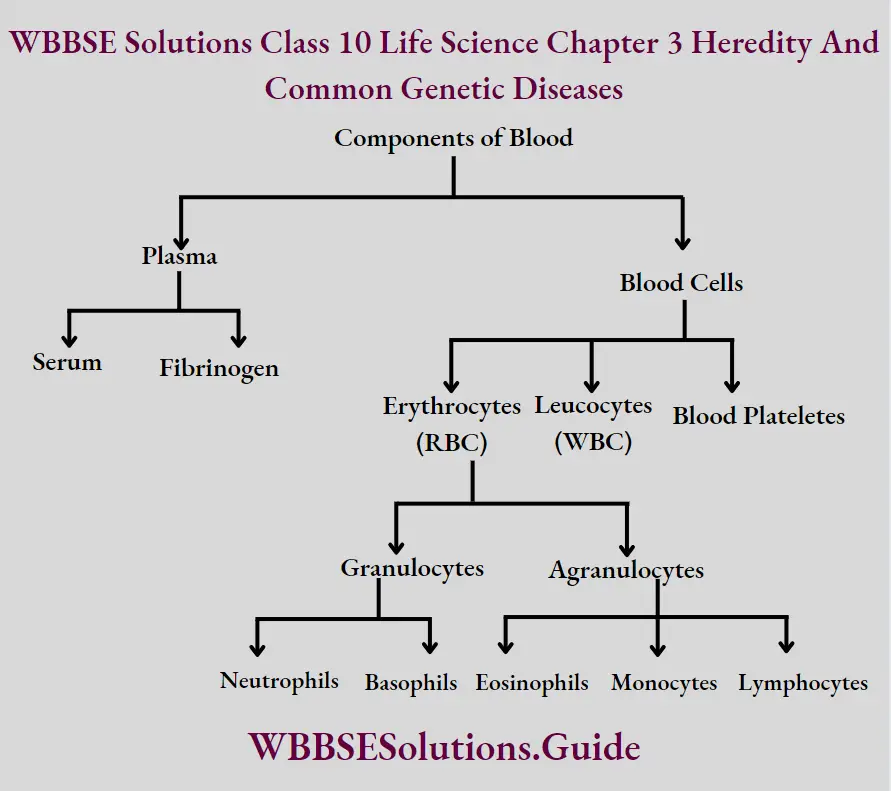
Question 143. Define and exemplify universal donor and universal recipient blood groups.
Answer:
The persons who can give blood to the persons having blood of any of the four blood groups is called universal donor. Example : ‘O’.
The person who can receive the blood from the persons having blood of any of the four blood groups is called universal recipient, e.g. the person having blood group ‘AB’
is called universal recipient.
Question 144. Why does the heart palpitate sometimes rapidly and sometimes very slowly ?
Answer:
The rate of heartbeat depends upon the following factors :
1. Quantity of blood,
2. Rate of respiration,
3. Emotional disturbance,
4. Systole and diastole of heart.
If the blood from left ventricle through the aorta abruptly increases or decreases, it will change the heart-beat accordingly.
The emotional disturbance and the release of hormones which in fluences the heart, obviously the heart-beat is altered. If the rate of respiration sharply increases, the
heart beat is effected, as 1 respiratory cycle under normal circumstances is equal to 4 cardiac cycles. We resipre 18 times per minute and the heart beats 72 times within the
same period.
Question 145. Why does the blood flow in the body of a vertebrate animal ?
Answer:
Blood flows in the body of a vertebrate animal due to the rhythmicity of the heart. This can be explained as follows :
Blood flows in the body of a vertebrate animal due to the pumping action of the heart which acts as a double force pump. When the blood enters the right auricle (artrium) through superior and inferior venacavae, and the left auricle (atrium) through pulmonary veins, the systole movement (contraction) occurs in the both auricles which is initiated by the sinoauricular node (SA NODE) or the Pace-maker. The pacemaker than imparts kinetic energy to the blood which flows further. The presence of valves at different places prevent the back flow of blood. The presence of valves at different places prevent back flow of blood. The valves and kinetic energy maintain the unidirectional flow of the blood. Due to the regular rhythmic relaxation and contraction of the heart:the blood never stops and continues to flow.
Question 146. State the importance of circulation.
Answer:
Importance (Functions) of Circulation :
Circulation of blood acts mainly as ta support medium and helps the living body to perform several important functions as stated below :
(1) Transportation of nutrients — The digested food substances are absorbed from the digestive canal and carried by blood or lymph to all living body cells to provide nutrition.
(2) Transportation of respiratory gases — The oxygen (O2 ) for respiration is carried from lungs to the tissue cells and carbon dixide (CO2 ) produced in the tissue cells are carried by blood to the respiratory organs from where it goes out.
(3) Transpotation of enzymes and hormones — The enzymes, hormones, etc. are essential for proper functioning of the living body. They are synthesized and liberated from several sources and are carried by blood to the respective sites of action.
(4) Transportation of waste products — Various toxic metabolic waste products formed as a result of cellular metabolism are liberated out from the body through circulation.
(5) Helps in storage — The essential substances or other organic matters formed in excess within the living body are carried by circulation to the storage organs for future use.
(6) Maintenance of blood pressure — Blood circulation maintains blood pressure and thus regulates exchange of fluids and ions between blood and tissues.
(7) Transportation of minerals — Various minerals are transported by circulation from one part of the body to other.
(8) Generation of heat — By circulation the cells receive food (respiratory substrate) and O2 and then the cells produce heat energy by respiration.
Question 147. What is coagulation of blood? What are the fectors involved in it ? Briefly describe the process of blood coagulation.
Answer:
Coagulation of blood:
1. The process by which blood oozing out from the ruptured blood vessels loses its fluidity in a few minutes and sets into a semi solid jelly-like mass, is called coagulation.
2. Factors involved in blood coagulation :
Blood coagulation is a complex process which requires about 13 factors. All these factors are present in plasms except factor Ill (thromboplatin). Except factor IV (calcium ion) all other factors are protein in nature. Some important factors are — Factor | (fibrinogen), Factor II (prothrombin), Factor Ill (thromboplastin), Factor IV (Ca++) and son on.
3. Process of blood coagulation :
It taken place in three steps —
(1) When blood comes out of an injured area, the platelets come in contact with ruptured blood vessels (rough surface). The platelets are broken in the presence of several clotting factors of blood and produce intrinsic thromboplastin.
Thromboplastin is also produced from the damaged tissue cells (extrinsic thromboplastin or tissue thromboplastin) in presence of Ca++ and other factors.
(2) Prothrombin of plasma is converted to thrombin in the presence of Ca ++ and thromboplastin.
(3) Thrombin reacts with soluble fibrinogen to convert it into insoluble fibrin. In the mesh work of fibrin fibres, the blood corpuscles are entangled forming a plug which is called clot.
Equations:
1. Normally in circulating blood :
Platelets + Prothrombin + Fibrinogen —> no clot
2. After shedding of blood :
Releasing
(1) Broken platelets or damaged tissues ——-> Thromboplastin.
Ca+
Thromboplastin
(2) Prothrombin ———–> Thrombin.
Thrombin
(3) Fibrinogen Fibrin (clot). ———-> Fibrin (clot).
Question 7. Classify body fluids on the basis of fluid compartments.
Answer:
Fluid Compartments :
Body fluids can be discussed in terms of their care
fluid compartment, a location that is largely separate from another compartment by some form of a physical barrier. The intracellular fluid (ICF) compartment is the system that includes all fluid enclosed in cells by their plasma membranes. Extracellular fluid (ECF) surrounds all cells in the body. Extracellular fluid has two primary constituents the fluid component of the blood (called plasma) and the interstitial fluid (IF) or tissue fluid that surrounds all cells not the blood.
Intracellular Fluid :
The ICE lies within cells and is the principal component of the cytosol/ cytoplasm. The ICF makes up about 60 per cent of the rotal water in the human body. This fluid volume tends to be very stable, because the amount of water in living cells is closely regulated.
Extracellular Fluid :
The ECF accounts for the other one-third of the body’s water content. Approximately 20 per cent of the ECF is found in blood plasma. Plasma travels through the body in blood vessels and transports a range of materials, including blood cells, proteins (including clotting factors and antibodies), electrolytes, nutrients, gases and wastes. Gases, nutrients and waste materials travel between capillaries and cells through the IF. Cells are separated from the IF by a selectively permeable cell membrane that helps regulate the passage of materials between the IF and the interior of the cell.
The body has other water-based ECF. These include the cerebrospinal fluid that bathes the brain and spinal cord, lymph that helps in transport and immunity, the synovial fluid in joints which helps in mobility, the pleural fluid in the pleural cavities, the pericardial fluid in the cardiac sac, the peritoneal fluid in the peritoneal cavity,
and the aqueous humor of the eye. Because these fluids are outside of cells, these fluids are also considered components of the ECF compartment. Fluid is lost from our body through urine, sweat, etc.
Chapter 3 Physiological Processes Of Life Difference Type Questions
1. Photosynthesis and Respiration:—
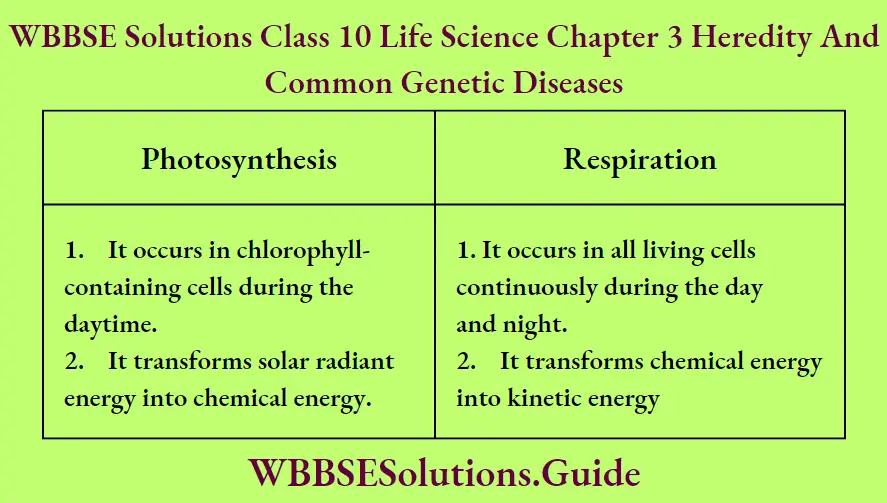
2. Respiration and Breathing:-
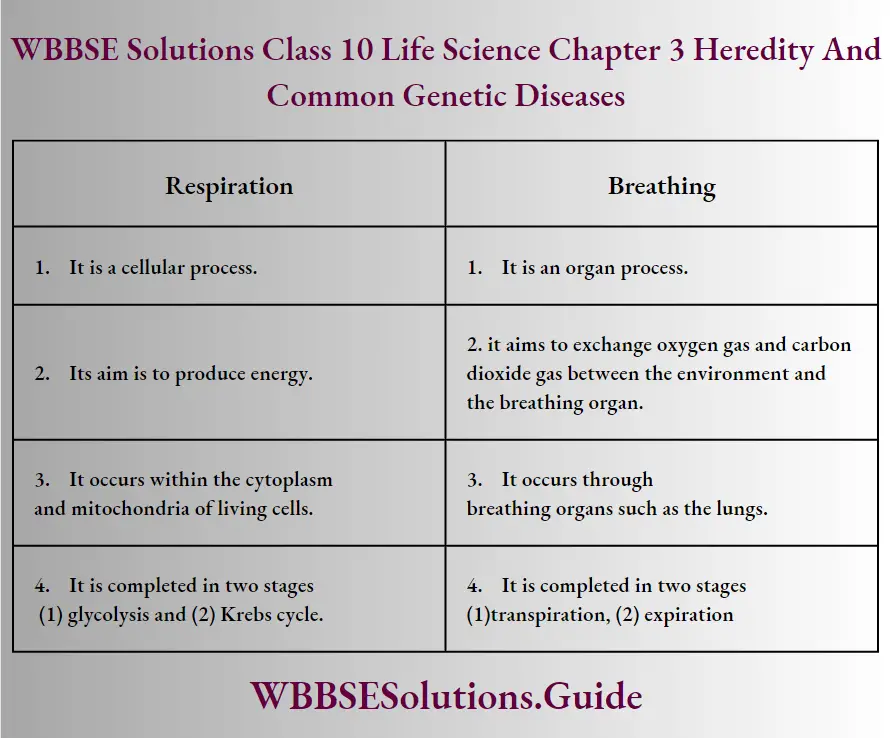
3. Aerobic Respiration and Anaerobic Respiration:-
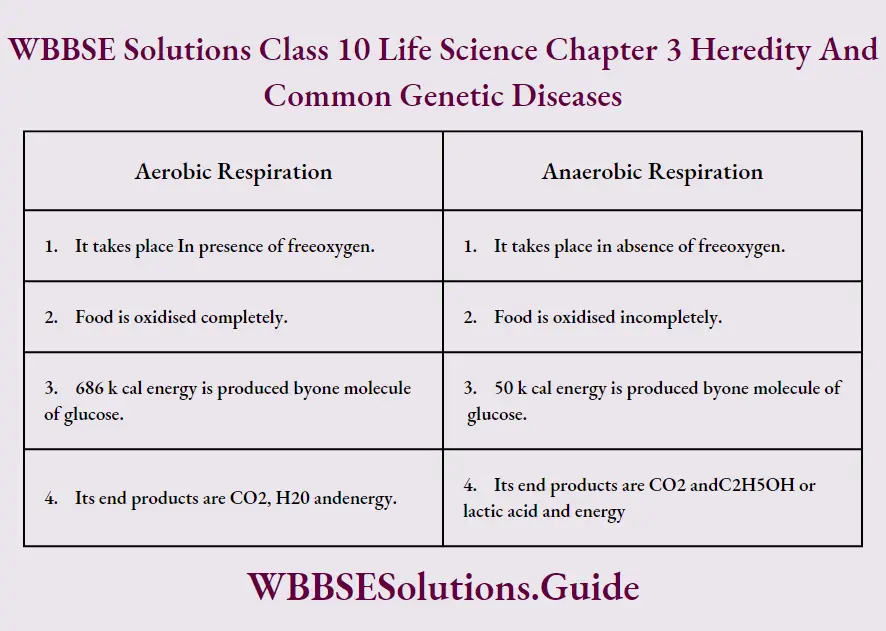
4. Respiration and Combustion:—
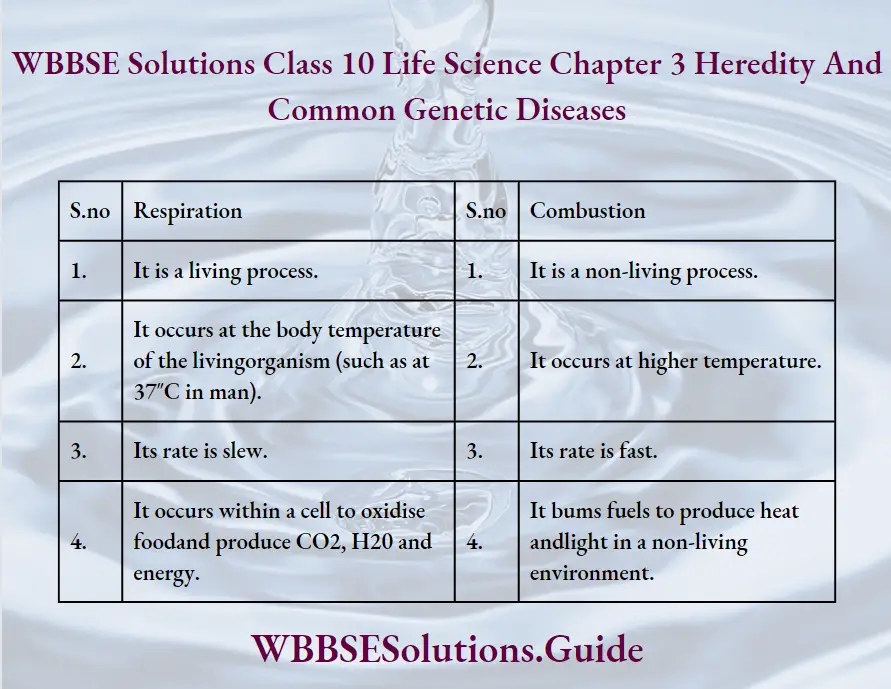
5. Anaerobic Respiration and Alcoholic Fermentation :—
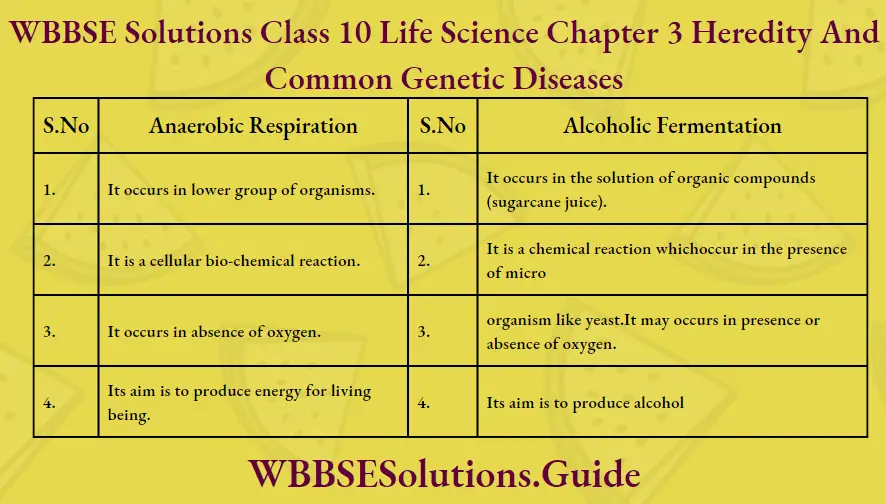
6. Aerobic Respiration and Combustion :-
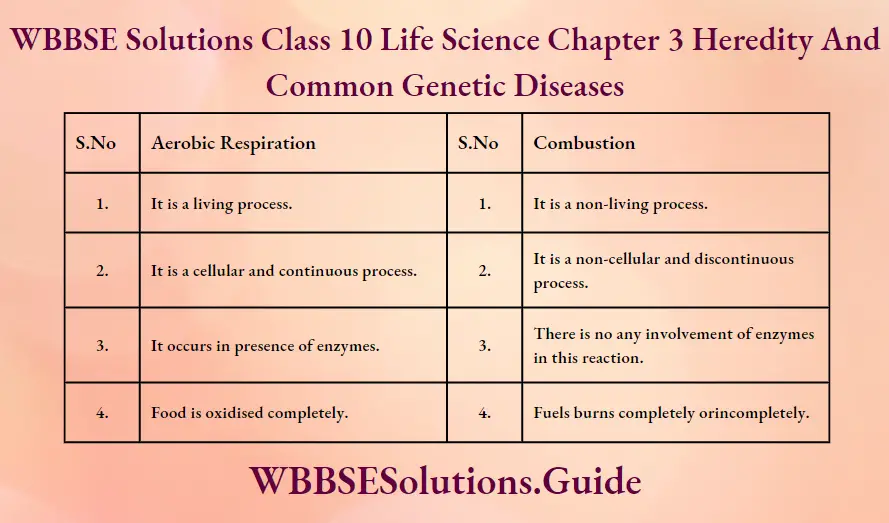
7. Anaerobic Respiration and Fermentation:-
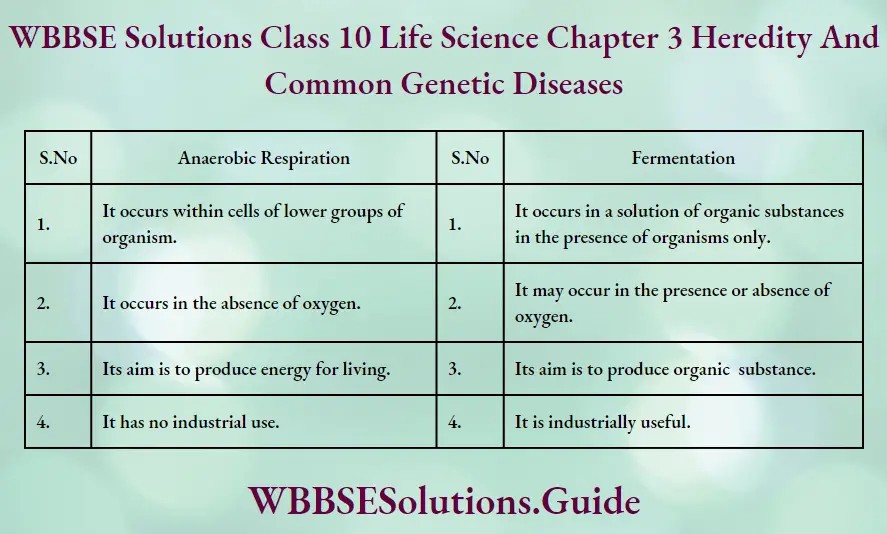
8. Aerobic Respiration and Fermentation :—
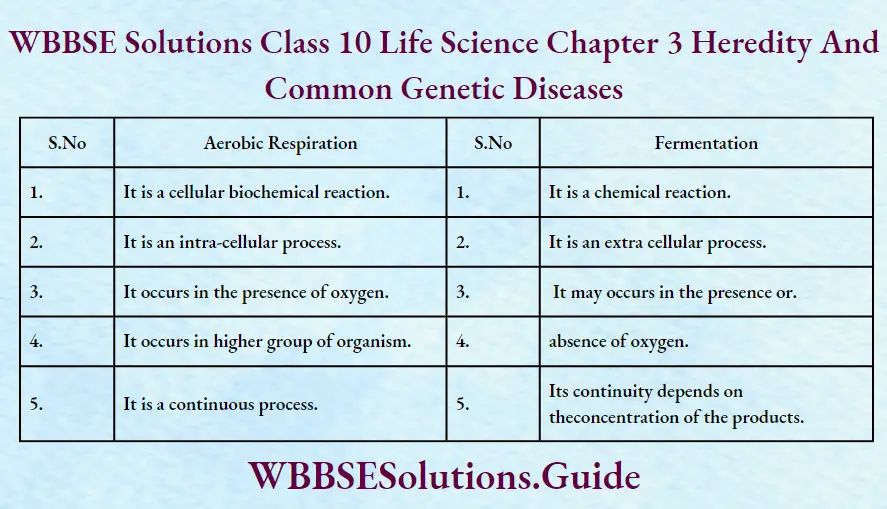
9. Plant Respiration and Animal Respiration :—
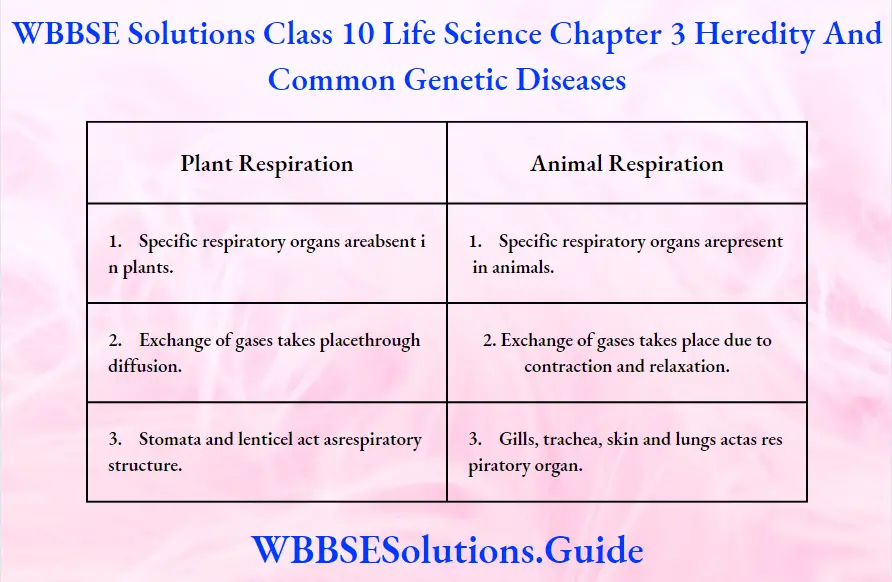
10. Plant Nutrition and Animal Nutrition :—
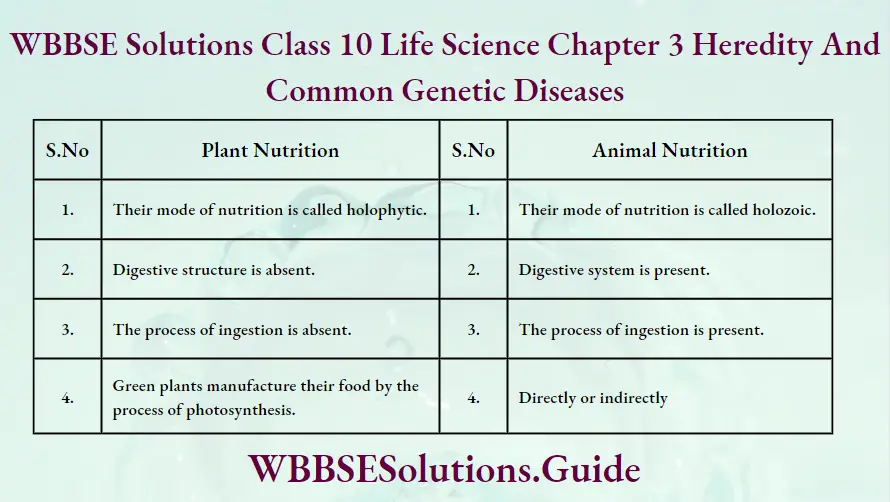
11. Fat and Protein :—
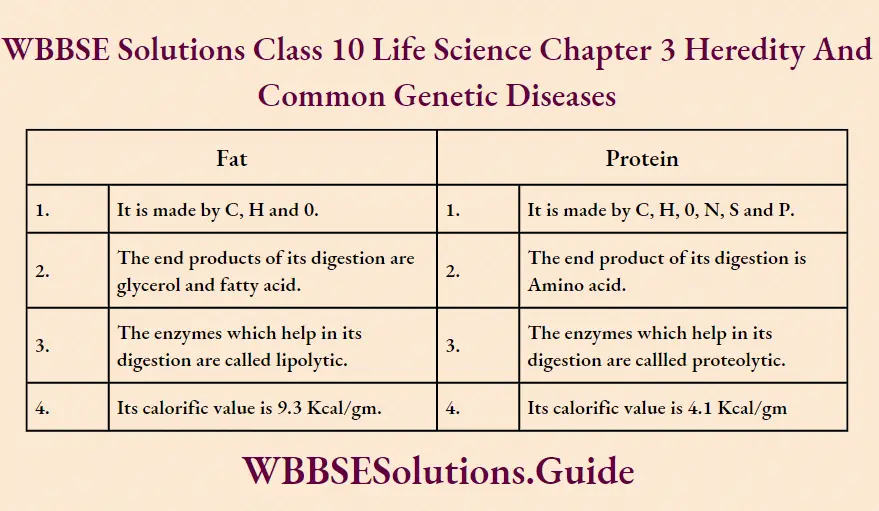
12. Autophytes and Heterophytes :—
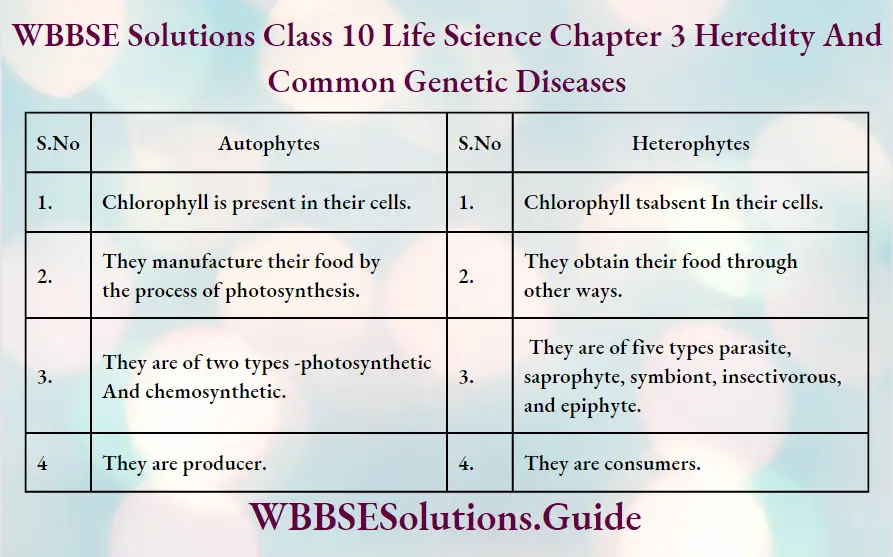
13. Parasite and Saprophyte :—
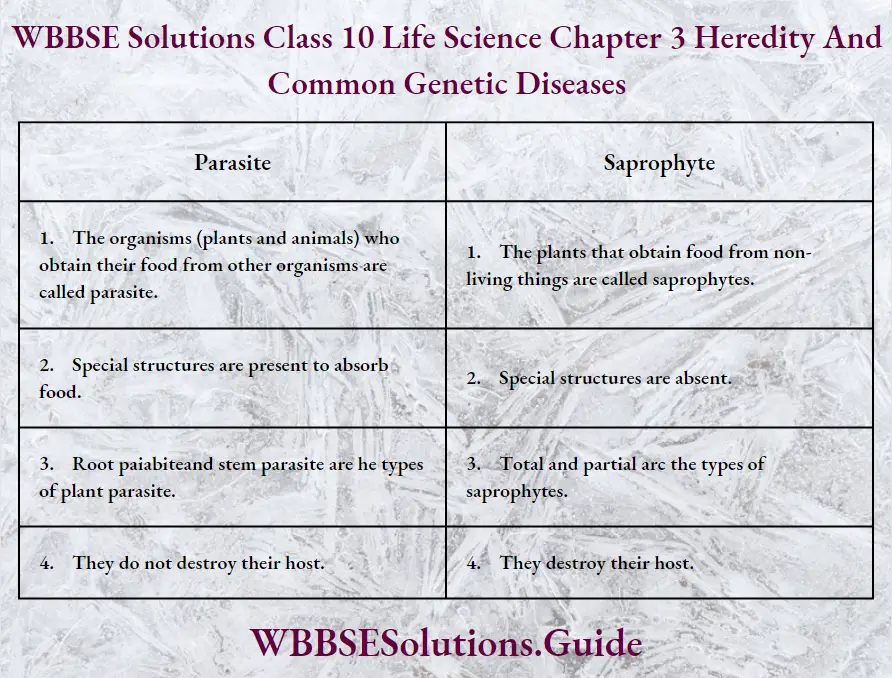
14. Parasite and Saprotroph :—
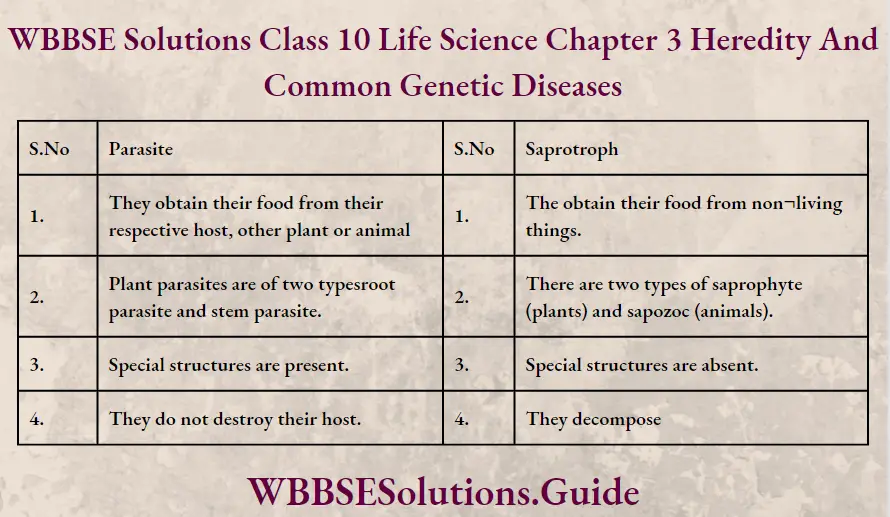
15. Parasite and Heterotroph :—
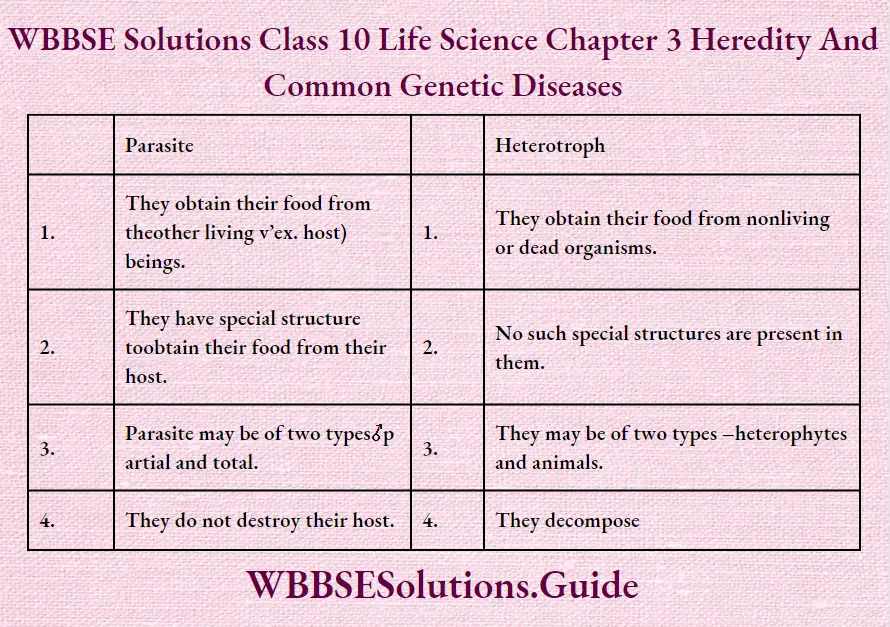
16. Anabolism and Catabolism :—
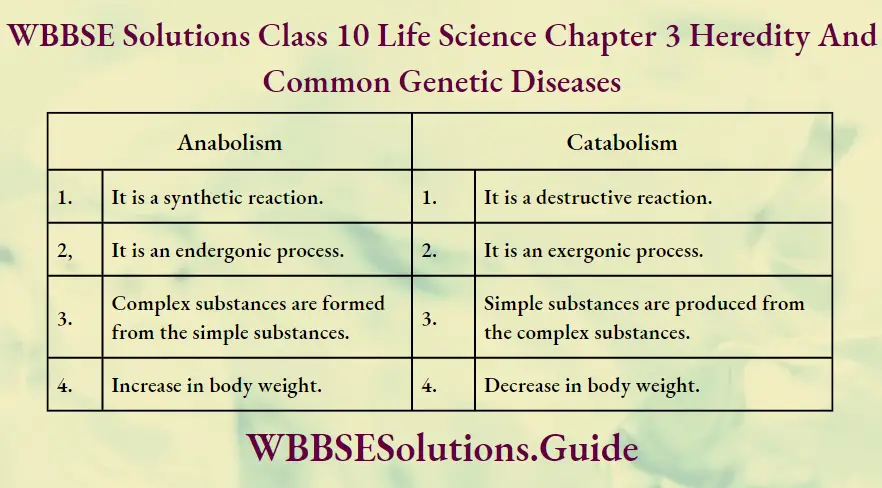
17. Digestion and Assimilation :—
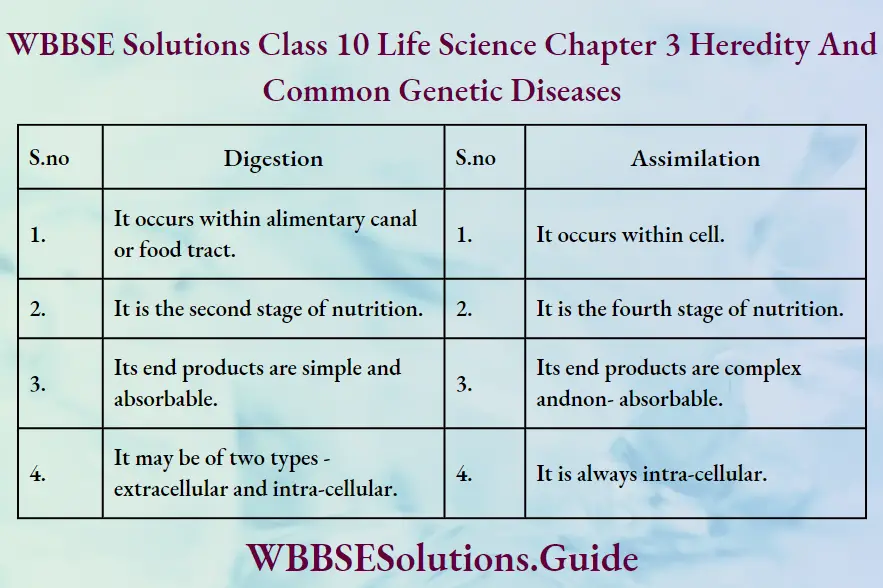
18. Autotrophic and Heterotrophic:-
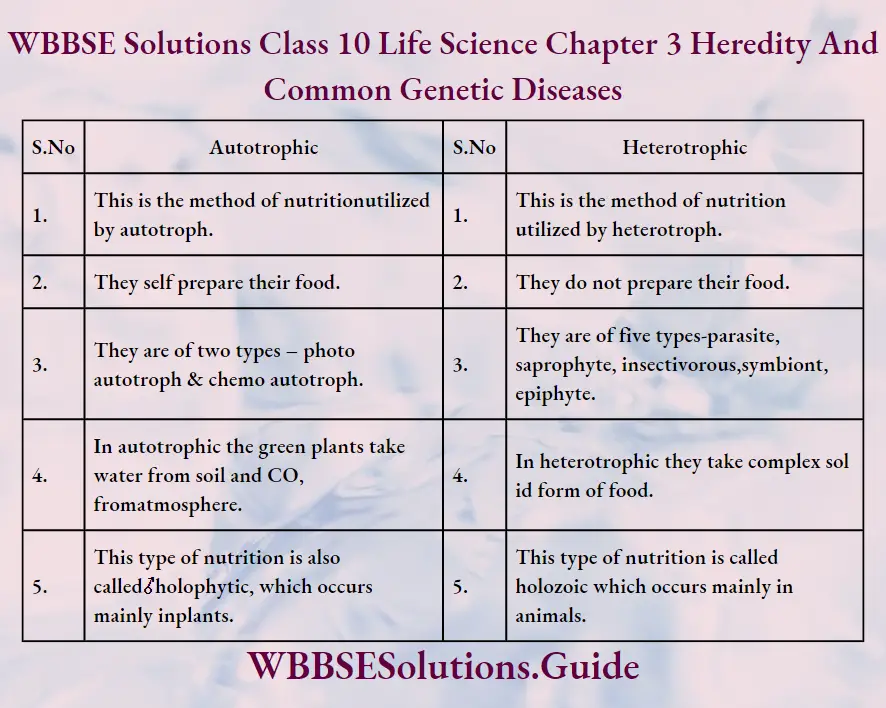
19. Autotroph and Heterotroph:—
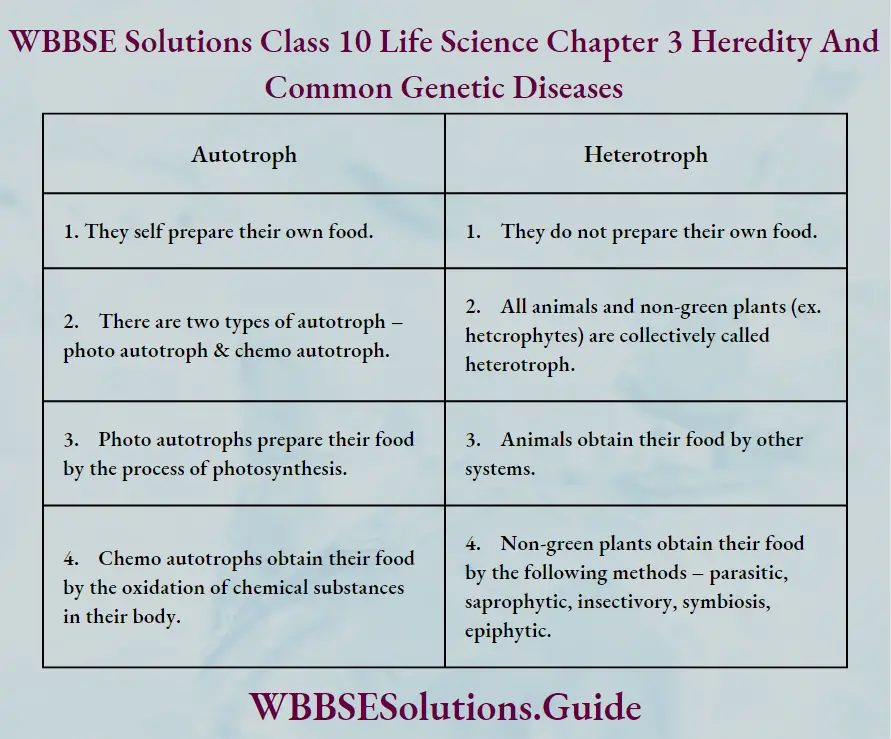
20. Vitamin and Enzymes:—
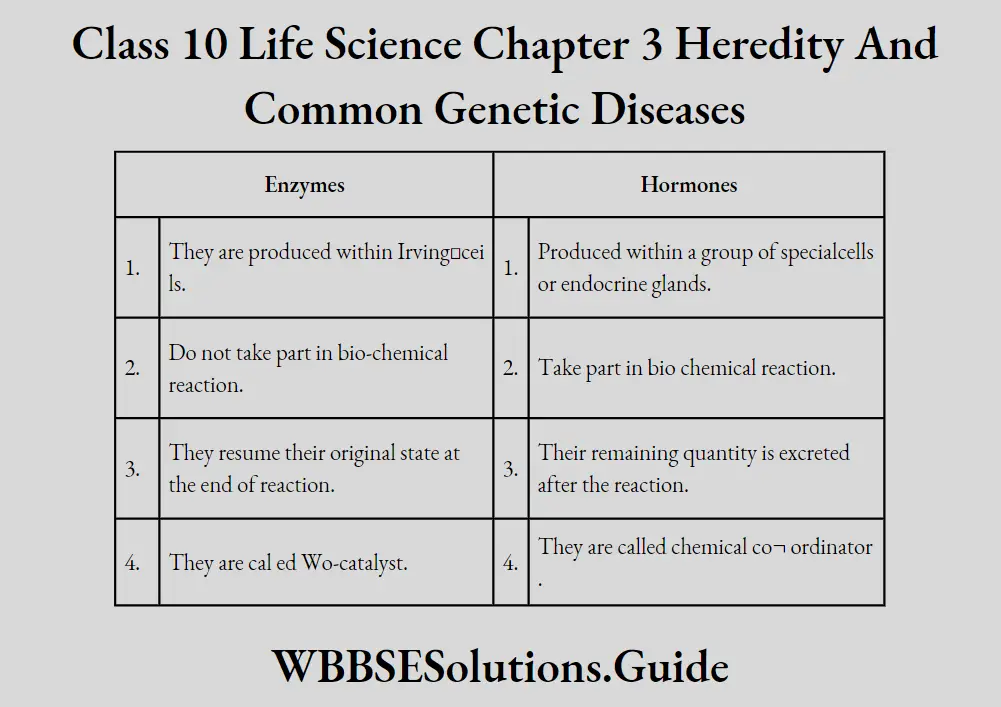
21. Enzymes and Hormones :—
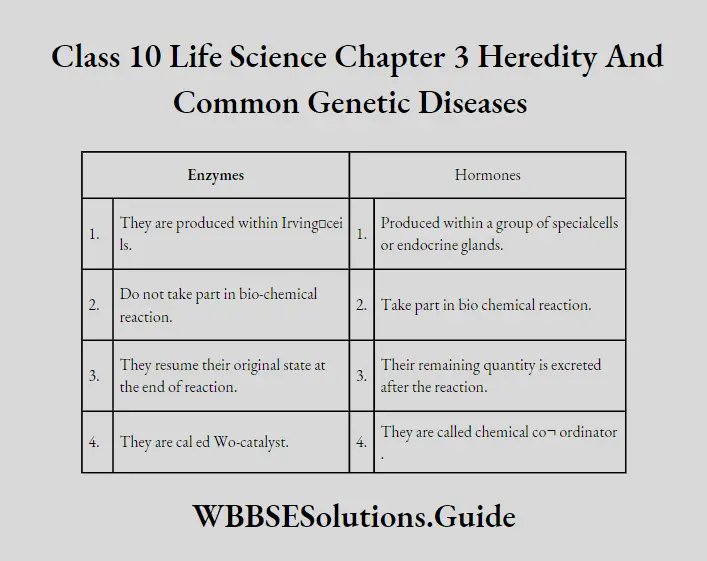
22. Essential element and Trace element :-
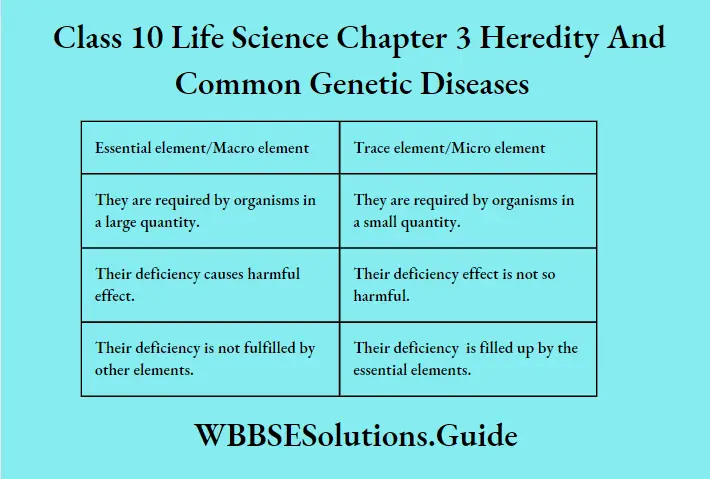
23. Vein and Artery :—
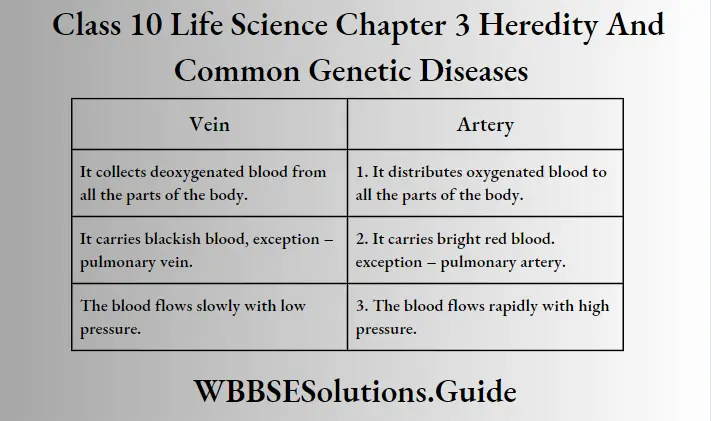
24. Haemoglobin and Haemocyanin :—
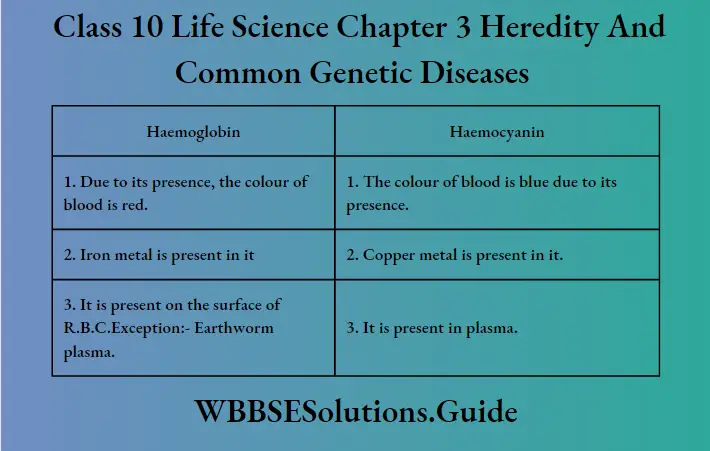
25. Structural Difference between Vein and Artery :-
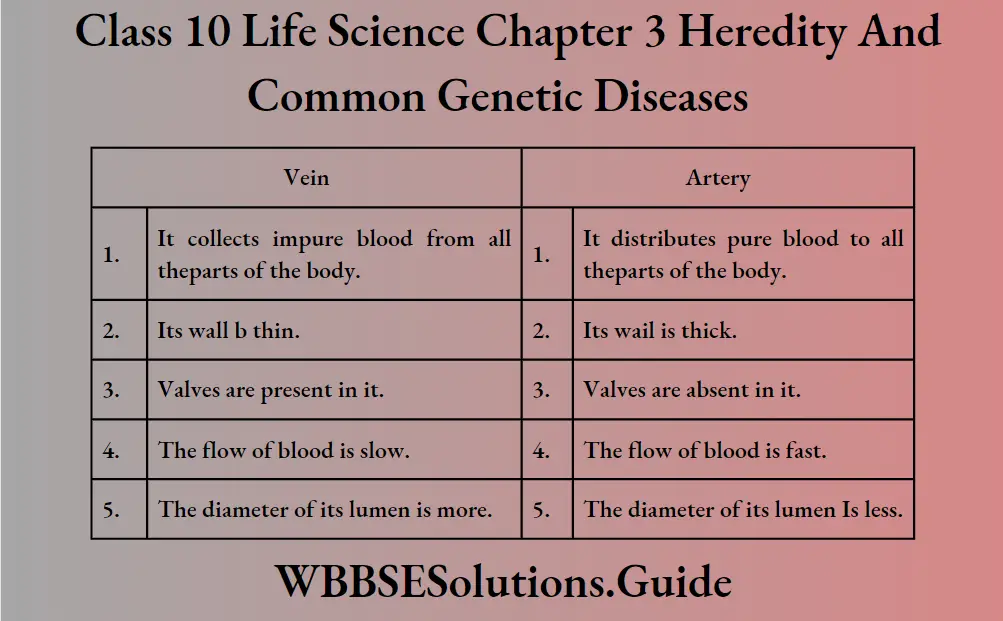
26. Functional difference between Vein and Artery :—
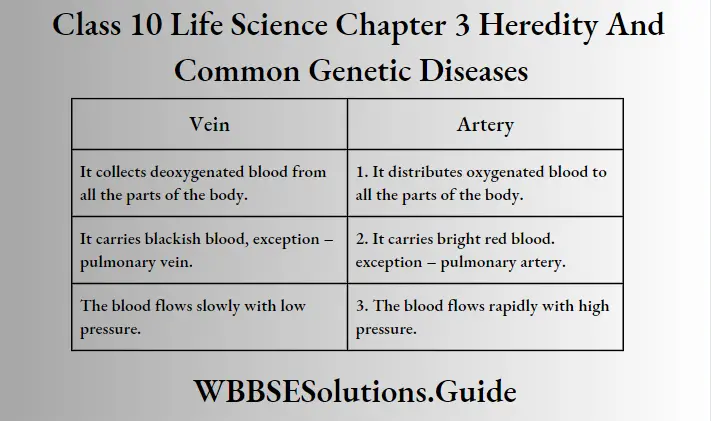
27.Lymphocyte and Thrombocyte :-
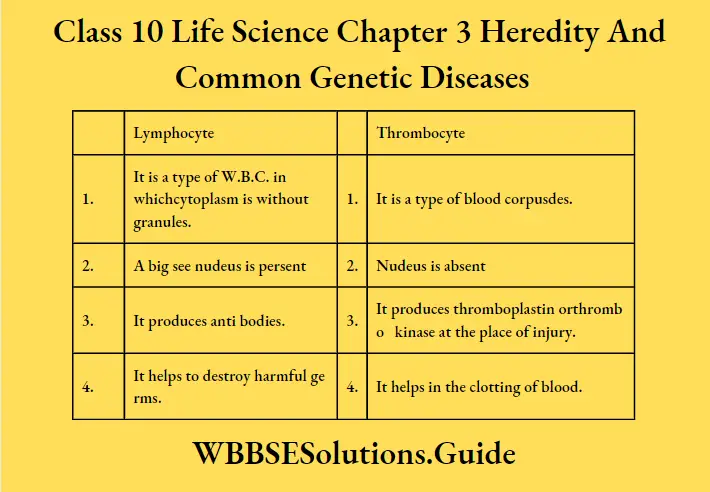
28. Open Circulation and Close Circulation:—
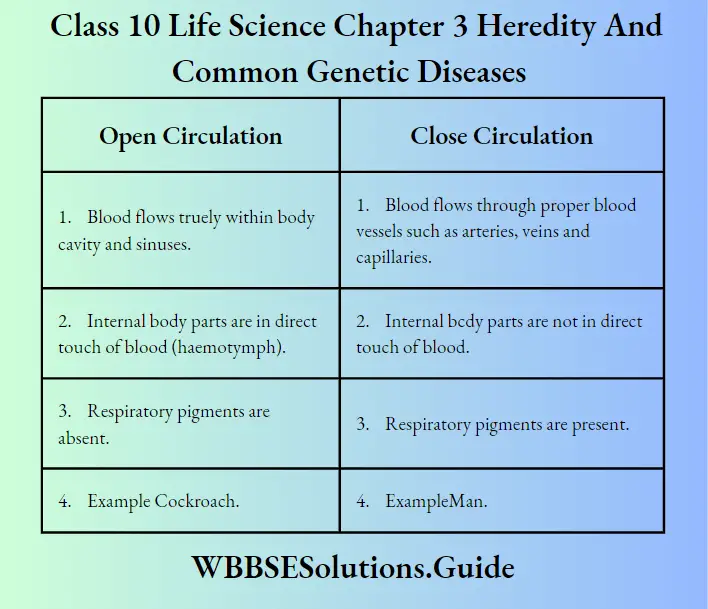
29. Erythrocyte and Leucocyte :—
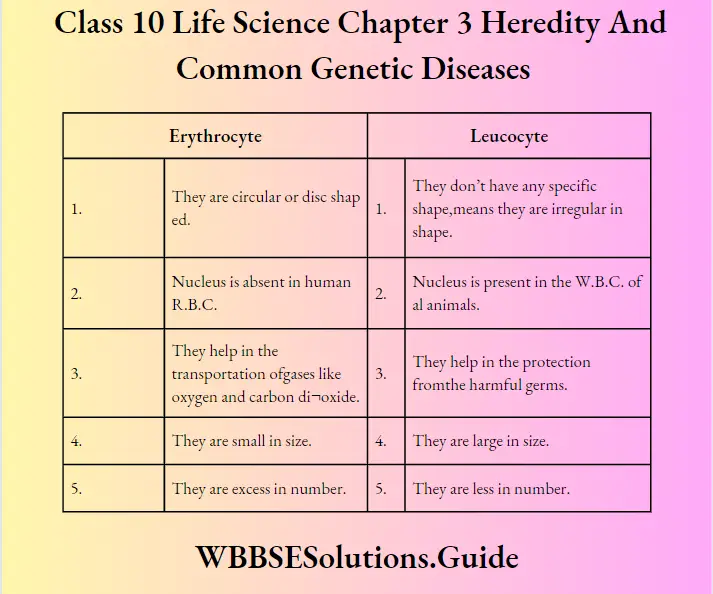
30. Erthryocyte in man and Leucocyte in man:-
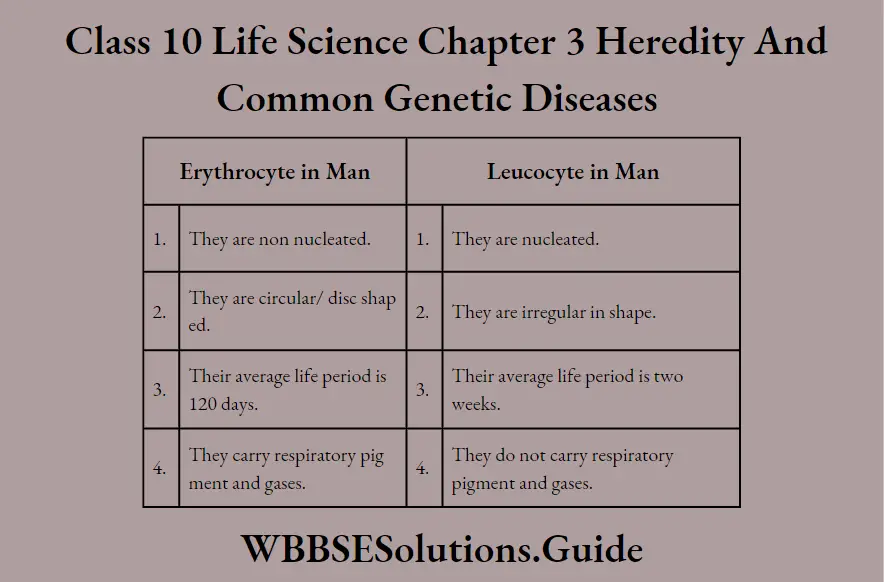
31. Blood and Lymph:—
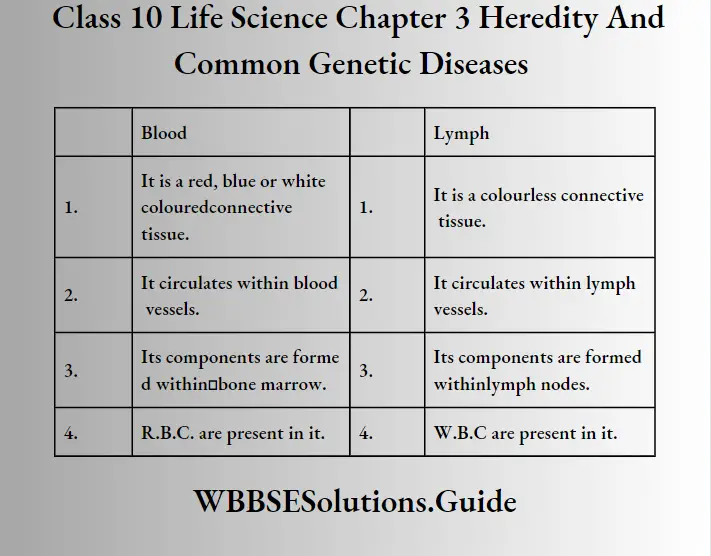
32. Mammalian R.B.C. and R.B.C of Other Vertebrates :-

WBBSE Class 10 Life Science Chapter 3 Heredity And Common Genetic Diseases Multiple Choice Questions
Chapter 3 Heredity And Common Genetic Diseases Multiple Choice Questions
Question 1. Following the monohybrid cross of Mendel if a hybrid tall (Tt) pea plant is crossed with a pure dwarf (tt) pea plant, what would be the percentage of hybrid tall pea plants in the first filial generation (F,)?
(1) 25 percent
(2) 50 percent
(3) 75 percent
(4) 100 percent.
Ans. The percentage of hybrid tall pea plants in the first filial generation (F,) will be 50 per cent.
Question 2. What will be the genotype ratio of a cross between hybrid tall pea plants (Tt) and dwarf pea plants (tt)?
(1) 1TT = 2Tt 1 tt
(2) 1Tt : 1tt
(3) 3Tt = Ite
(4) All Tt.
Answer: 1 Tt: 1 It will be the genotype ratio of a cross between hybrid tall pea
plants (Tt) and dwarf pea plants (tt).
Question 3. If a pure tall (TT) pea plant is crossed with a pure dwarf (tt) pea plant, what would be the percentage of hybrid tall pea plants in the first filial generation (F,) under the rule of mendels monohybrid cross?
(1) 15 percent
(2) 50 percent
(3) 75 percent
(4) 100 percent. :
Answer. The percentage of hybrid tall pea plants in the first filial generation (F,) by the rule of Mendel痴 monohybrid cross is 100 per cent.
Read and Learn More Class 10 Life Science MCQs
Question 4. The percentage of hybrid tall plants in F, generation produced from crossing two hybrid tall parental stocks is 4
(1) 25%
(2) 50%
(3) 75%
(4) 100%.
Answer. The percentage of hybrid tall plants in F, generation produced from crossing two hybrid tall parental stocks is 50%.
Question 5. The father of Genetics is
(1) Darwin
(2) Bateson
(3) Benda
(4) Mendel.
Answer. The father of Genetics is Mendel.
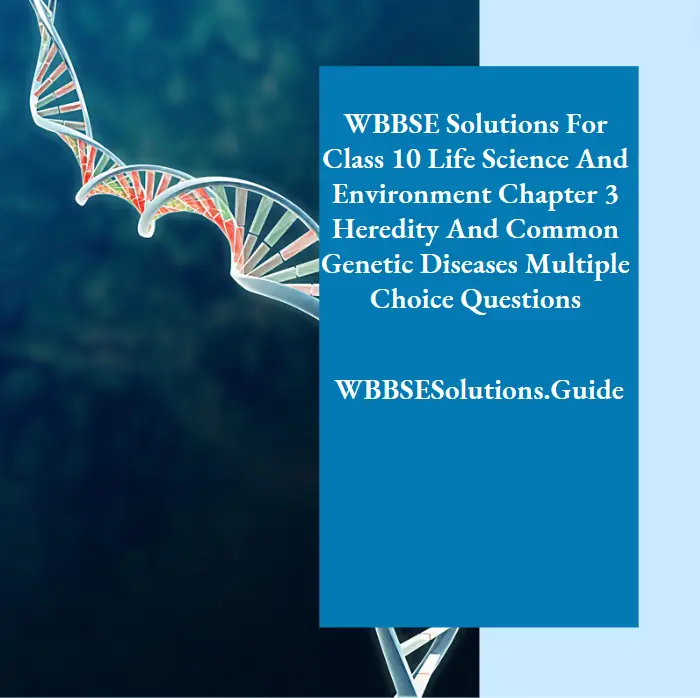
Question 6. A pair of contrasting characters is called
(1) Phenotype
(2) Genotype
(3) Gene
(4) Allele.
Answer. A pair of contrasting characters is called Allele.
Question 7. The character which predominates and is seen in F, generation is said to be ・
(1) Dominant
(2) Recessive
(3) Particular
(4) Special.
Answer. The character which predominates and is seen in the F, generation is said to be Dominant.
Question 8. The term gene was coined by p
(1) Morgan
(2) Weismann
(3) Lamarck
(4) Johannsen.
Answer. The term gene was coined by Johannsen.
Question 9. When two individuals are similar in external BRESAUSASE but different in their genetic make-up, they are called as
(1) Allele
(2) Pure
(3) Homozygous
(4) Heterozygous.
Answer. When two individuals are similar in external appearance but different in their genetic makeup, they are called Heterozygous.
Question 10. What would be the probable genotype of pure dwarf pea plant a
(1) Tt
(2) tt,
(3) TT,
(4) None of the above
Answer. The probable genotype of pure dwarf pea plant will be tt
Question 11. Mendel’s choice of contrasting characters from pea plants are
(1) 8 pairs
(2) 7 pairs
(3) 6 pairs
(4) 5 pairs
Answer. Mendel choice of contrasting characters from pea plants is 7 pairs.
Question 12. One pure red eyes Drosophila when crossed with pure white eyes Drosophila the offspring in F, generation will be found (when red is dominant over white)
(1) both red and white eyes,
(2) only red eyes,
(3) only white eyes.
(4) intermediate type of eyes.
Answer. One pure red eyes Drosophila when crossed with pure white eyes Drosophila the offspring in F, generation will found (when red is dominant over white) Only red eyes.
Question 13. When a hybrid black guinea pig is crossed with a pure white Guineapig the offspring of F, will be –
(1) 3:1
(2)1:2:1
(3)1:1
(4) None of them.
Answer. When a hybrid black guinea pig is crossed with a pure white Guinea pig the offspring of F, will be 1: 1.
Question 14. The phenotype result of Mendel’s dihybrid cross will be
(1)1:1:1:1
(2)9:3:3:1
(3)2:3:3:4:5
(4)1:2:3:4
Answer. The phenotype result of Mendel’s dihybrid cross will be 9: 3:3:1
Question 15. In dihybrid cross types of phenotypic offspring are produced in F, generation ・
(1) 2
(2) 5
(3) 6
(4) 4
Answer. In dihybrid cross types of phenotypic offspring are produced in F, generation 4.
Question 16. Hereditary component is
(1) Nucleus
(2) Chromosome
(3) DNA
(4) Protein
Answer. The hereditary component is DNA.
Question 17. Mendel’s experimental results were published in the year
(1) 1900
(2) 1866
(3) 1865
(4) 1864
Answer. Mendel’s experimental results were published in the year 1866.
Question 18. Like begets like is an important and universal phenomenon of life is due
(1) Genetics
(2) Eugenesis
(3) Morphology
(4) Embryology
Answer. Like begets like is an important and universal phenomenon of life due to
Genetics.
Question 19. Which one is a hereditary disease?
(1) Cataract
(2) Leprosy
(3) Blindness
(4) Phenylketonuria
Answer. Phenyl ketonuria is a hereditary disease.
Question 20. How many types of genotypes will be obtained in plants of the F, generation when two hybrid tall plants (Tt) are crossed?
(1) one type
(2) two types
(3) three types
(4) four types
Answer. Three types of genotypes will be obtained in plants of the F, generation when two hybrid tall plants (Tt) are crossed.
Question 21. The pea plants produced from the seeds obtained from a cross between hybrid tall (Tt) and pure dwarf (tt) pea plants will be
(1) All tall
(2) All dwarf
(3) 50% tall, 50% dwarf
(4) 75% tall, 25% dwarf.
Answer. The pea plants produced from the seeds obtained from a cross between hybrid tall (Tt) and pure dwarf (tt) pea plants will be 50% tall, and 50% dwarf.
Question 22. Following the monohybrid cross of Mendel if a hybrid tall (Tt) Pea plant is crossed with a pure dwarf (tt) pea plant, what would be the percentage of
hybrid tall pea plant in the first filial (F,) generation?
(1) 25%
(2) 50%
(3) 75%
(4) 100%
Answer. The percentage of hybrid tall pea plants in the first filial (F,) generation will be 50%
Question 23. Who is known as the father of Genetics・?
(1) Lamarck
(2) Darwin
(3) Hugo De vries
(4) Mendel.
Answer. Mendel is known as the father of Genetics・
Question 24. The genotypes of F, plants obtained by crossing two hybrids (Aa) plants will be
(1) One
(2) Two
(3) Three
(4) four.
Answer. The genotypes of F, plants obtained by crossing two hybrids (Aa) plants will be Three types.
Question 25. If hybridization is made between two aye tall pea plants; the hybrid tall pea plants in F, generation will be
(1) 25%
(2) 50%
(3) 75%
(4) 100%
Answer. If hybridization is made between two hybrid tall pea plants, the hybrid pea plants in F, generation will be 50%. ゥ
Question 26. The genetic constitution of an organism is
(1) Phenotype
(2) Genotype
(3) Genotype and Phenotype
(4) none of them.
Answer. The genetic constitution of an organism is genotype.
Question 27. The phenotypic ratio deduced from the Mendel dihybrid cross is
(1)3:1
(2)1:2:1
(3)9: 3:3: 1
(4)9:9:1
Answer. The phenotypic ratio deduced from the Mendel dihybrid cross is 9: 3:3: 1
Question 28. Inheritance of characters is discussed in a branch of science known as
(1) Cytology
(2) Genetics
(3) Evolution
(4) Adaptation
Answer. (2) Genetics
Question 29. The term Genetics・has been coined by
(1) Mendel
(2) Bateson
(3) Morgan
(4) Johansen
Answer. (2) Bateson
Question 30. Mendel did his experiment on a plant known as
(1) Bean Plant
(2) Wheat plant
(3) Paddy plant
(4) Pea plant
Answer. (4) Pea plant
Question 31. How many laws of inheritance were proposed by Mendel?
(1) One
(2) Two
(3) Three
(4) Four
Answer. (2) Two
Question 32. The F, phenotypic ratio of Mendel’s monohybrid cross is
(1)2:1
(2)3:1
(c)1:2:1
(4)9:4:3
Answer. (2) 3: 1
Question 33. In the dihybrid cross of Mendel the F, ratio obtained is
(1)9:3:3:1
(2) 9:7
(3)1:1:1
(4)9:4:3
Answer.(1)9:3:3:1
Question 34. What is the genotypic ratio of F, generation in Mendel’s monohybrid experiment?
(1)1:1
(2)2:1
(3)3:1
(4)1:2:1
Answer. (2) 2:1
Question 35. Who proposed the law of independent assortment?
(1) Darwin
(2) De Vries
(3) Mendel
(4) Lamarck
Answer. (3) Mendel
Question 36. The “tall” trait of the pea plant is
(1) Dominant
(2) Semidominant
(3) Recessive
(4) Codominant
Answer. (1) Dominant
Question 37. The cross between F, offspring and father or mother is known as
(1) Test cross
(2) Reciprocal cross
(3) Back cross
(4) None of the above
Answer. (3) Back cross
Question 38. What is meant by the 1: 1 ratio in the monohybrid cross?
(1) F, organism is homozygote
(2) F, organism is heterozygote
(3) F, organism is pure
(4) The ratio is produced due to back cross
Answer. (2) F, organism is heterozygote
Question 39. Which of the following is a test cross?
(1) Tt x tt
(2) tt x tt
(3) Tt Tt
(4) TT x TT
Answer. (1) Tt x tt
Question 40. Which of the following is a back cross?
(1) FX,
(2) F, x recessive
(3) FE, xP
(4) F, x any parent
Answer. (4) F, x any parent
Question 41. Which one of the following is the result of a monohybrid cross?
(1)1:1:1:1
(2) 9:3:3:1
(3) 3:1
(4)9:7
Answer: (3)3.: 1
Question 42. What is known as the unit of heredity?
(1) Genotype
(2) Phenotype
(3) Gene
(4) Protein
Answer. (3) Gene
Question 43. When two different alleles of a gene are present the organism is known as ・
(1) Heterozygote
(2) Homologous
(3) Homozygote
(4) Hemizygote
Answer. (1) Heterozgote
Question 44. When the pure yellow, round pea plant is crossed with a green wrinkled pea plant, the F, pea plant will be
(1) All yellow wrinkled
(2) 50% yellow round, 50% green wrinkled
(3) All yellow round
(4) 50% yellow wrinkled, 50% green round
Answer. (3) All yellow round
Question 45. When will all children of a couple be found colourblind?
(1) If the mother is normal and the father is normal
(2) If the mother is normal and the father is colourblind
(3) If the mother is homozygous colourblind and the father is normal
(4) If the mother is homozygous colourblind and the father is colourblind.
Answer. (4) If the mother is homozygous colourblind and the father is colourblind.
Question 46. The separation of linked genes occurs through
(1) Crossing over
(2) Segregation
(3) Mutation
(4) Linkage
Answer. (1) Crossing over
Question 47. Colourblind is a sex-linked recessive trait. If a mother is colourblind sons will be
(1) All colourblind
“(2) All normal vision
(3) 50% colourblind, 50% normal
(4) None of the above
Answer. (1) All colourblind
Question 48. Which of the following conditions is related to haemophilia?
(1) A responsible recessive gene present in the X chromosome
(2) A responsible dominant gene present in the X chromosome
(3) A responsible dominant gene present in the Y chromosome
(4) A responsible dominant gene present in the autosomal chromosome
Answer. (1) A responsible recessive gene present in the X chromosome
Question 49. In seven pairs of contrasting characters in the pea plant studied by Mendel, the number of flower-based characters was
(1) 1
(2) 2
(3) 3
(4) 4
Answer. (2) 2 :
Question 50. In Mendel’s experiment, how many different kinds of seeds are produced from a short plant with wrinkled seeds (ttrr)?
(1) 9
(2) 4
(3) 2
(4) 1
Answer.(4) 1
Question 51. A cross between a dominant phenotype with the recessive parent to check its genotype is called
(1) Test cross
(2) Back cross
(3) Monohybrid cross
(4) Dihybrid cross
Answer. (1) Test cross
Question 52. Some of the dominant traits studied by Mendel were
(1) round seed shape, constricted pod shape and axial flower position
(2) green pod colour, inflated pod shape and axial flower position
(3) yellow seed colour, violet flower colour and yellow pod colour
(4) axial flower position, green pod colour and green seed colour
Answer. (2) green pod colour, inflated pod shape and axial flower position
Question 53. The colour-based contrasting traits in several contrasting pairs studied by Mendel in pea plants were
(1) 1
(2) 2
(3) 3
(4) 4
Answer. (3) 3
Question 54. The mechanism of transmission of characters, resemblances as well as difference, from the parental generation to the offspring is called
(1) Astrology
(2) Heredity
(3) Coincidence
(4) Nurture
Answer. (2) Heredity
Question 55. One of the scientists who rediscovered Mendelism was
(1) Bateson
(2) Darwin
(3) Tschermak
(4) Lamarck
Answer. (3) Tschermak
Question 56. is a change in a gene or chromosome.
(1) Evolution
(2) Variation
(3) Heredity
(4) Mutation
Answer. (4) Mutation
Question 57. The ability of tongue rolling is controlled by–
(1) Practice
(2) Gene
(3) Environment
(4) Temperature
Answer. (2) Gene
Question 58. An is an alternative form of gene.
(1) Allele
(2) Locus
(3) Genotype
(4) Phenotype
Answer. (1) Allele
Question 59. The place of location of a gene is called
(1) House
(2) Niche
(3) Locus
(4) Chromosome
Answer. (3) Locus
Question 60. means that the organism has two copies of the same allele for a gene.
(1) Hetergogygous
(2) Hemizygous
(3) Homozygous
(4) Hybrid
Answer. (3) Homozygous
Question 61. Genes are present in a sequence on the chromosomes
(1) Serial
(2) Linear
(3) Circular
(4) Haphazard
Answer. (2) Linear
Question 62. means that an organism has two different alleles of a gene.
(1) Hemizygous
(2) Heterozygous
(3) Homozygous
(4) Allozygous
Answer. (2) Heterozygous
Question 63. A genetic hybrid would carry two different of the same gene.
(1) Cocus
(2) Numbas
(3) Types
(4) Allejes
Answer. (4) Alleles
Question 64. The generation is the first set of parents crossed.
(1) Parental
(2) Filial
(3) Hybrid
(4) Mother
Answer. (1) Parental
Question 65. The Scientific name of the four o’clock plant is mirabilis
(1) Indicus
(2) Jalapa
(3) Domestica
(4) Bengalensis
Answer, (2) Jalapa
Question 66. The sex chromosomes of human males are
(1) XX
(2) AA
(3) XY
(4) PQ
Answer. (3) XY
Question 67. Thalassemia is an autosomal trait.
(1) Dominant
(2) Recessive
(3) Sexlinked
(4) Poisonous
Answer. (2) Recessive
Question 68. Haemophilic persons have problems with blood
(1) Pigmentation
(2) Clotting
(3) Colour
(4). Temperature
Answer. (2) Clotting
Question 69. Red colour blindness is the most common.
(1) Green
2) Blue
(3) Black
(4) Yellow
Answer. (1) Green
Question 70. Genes do not occur in pairs in
(1) Endosperm
(2) Zygote
(3) Gametes
(4) Somatic cells
Answer. (3) Gametes
Question 71. The phenomenon which defines the independent assortment is
(1) Segregation
(2) Dominance
(3) Crossing over
(4) Linkage
Answer. (1) Segregation
Question 72. A haploid set of all the genes present in a gametes is called
(1) Genome
(2) Linkage group
(3) Phenotype
(4) Genotype
Answer. (1) Genome
Question 73. Who first used the termene?
(1) Mendel
(2). Johannsen
(3) Bateson
(4) Morgan
Answer. (2) Johannsen
Question 74. Incomplete dominance is observed in
(1) Hibiscus
(2) Mirabilis
(3) Sunflower
(4) Roulfia
Answer. (2) Mirabilis Jalpa (4 0・clock plant)
Question 75. What will be the percentage of hybrid tall plants produced in F, generation due to hybridisation between two hybrid tall pea plants?
(1) 100%
2) 75%
(3) 50%
(4) 25%
Answer. (3) 50%
Question 76. The phenotypic ratio of F, generation in Mendel’s dihybrid cross is-
(1)1:2:1
(2) 9:3:3:1
(3)1:3
(4)1:1
Answer. (6) 9:23:31
Question 77. All the genes present in interbreeding populations are together known as
(1) Genone
(2) Gene pool
(3) Chromosome
(4) None
Answer. (2) Gene pool
Question 78. The law derived from the dihybrid cross is
(1) Law of dominance
(2) Law of segregation
(3) Law of independent assortment
(4) All of these
Answer. (3) Law of independent assortment
Question 79. An alternative form of gene is-
(1) Chromosome
(2) Allele
(3) Character
(4) None
Answer. (2) Allele
Question 80. The combination of genes in an organism is-
(1) Phenotype
(2) Genotype
(3) Variation
(4) All
Answer. (2) Genotype
Question 81. The total loss of skin pigment in a body is called
(1) Leukemia
(2) Colour blindness
(3) Albinism
(4) Haemophilia
Answer. (3) Albinism
Question 82. A blood disease caused by gene mutation is-
(1) Anaemia
(2) Sickle cell anaemia
(3) Albinism
(4) Malaria
Answer. (2) Sickle cell anaemia
Question 83. An X-linked disease is
(1) Anaemia
(2) Haemophilia
(3) Malaria
(4) All of the above
Answer. (2) Haemophilia
Question 84. Small differences among individuals are called
(1) Variation
(2) Mutation
(3) Evolution
(4) All of these
Answer. (1) Variation
Question 85. The technique in which the genetic constitution of an organism is altered by introducing a new gene is-
(1) Genetic counselling
(2) Genetic engineering
(3) Heredity
(4) None of these
Answer. (2) Genetic engineering
Question 86. A genetic disease is
(1) Haemophilia
(2) Thalassemia
(3) Colourblindness
(4) All of the above
Answer. (4) All of the above
Question 87. The operation of removal of anthers is known as
(1) Pollination
(2) Fertilization
(3) Emasculation
(4) Selection
Answer. (3) Emasculation
Question 88. The cross between F, hybrid and recessive homozygous parent is called
(1) Back cross :
(2) Test cross
(3) Self cross
(4) Monohybrid cross
Answer. (2) Test cross
Question 89. Sex-linked inheritance was first discovered by
(1) Mendel
(2) Punnet
(3) Johansen
(4) T.H. Morgan
Answer. (4) T.H. Morgan
Question 90. The functional unit of DNA molecule is called
(1) Recon
(2) Cistron
(3) Muton
(4) All of these
Answer. (2) Cistron
Question 91. A common hereditary disorder which is carried on by autosomes is-
(1) Jurner’s syndrome
(2) Klinefelter’s syndrome
(3) Down syndrome
(4) a and b
Answer. (3) Down syndrome
Question 92. The genotypic ratio of the monohybrid cross is
(1)3:1
(2)1:2:1
(3)2:2
(4) 1:3
Answer. (2)1:2:1
Question 93. A ‘Y-chromosome-linked character in males is
(1) Hypertrichosis of ears
(2) Pattern baldness
(3) Both (1) and (2)
(4) None of these
Answer. (3) Both (1) and (2)
Chapter 3 Heredity And Common Genetic Diseases Fill In The Blanks
Question 1. is one of the discoverers of Mendelism.
Answer. Hugo De vries.
Question 2. The study of heredity is called
Answer. genetics.
Question 3. The pair of contrasting characters are called
Answer. Alleles.
Question 4. is the father of heredity.
Answer. G J. Mendel.
Question 5. The unit of heredity is
Answer. gene.
Question 6. The phenotypic ratio of the monohybrid cross is
Answer. 3:1.
Question 7. The genotypic ratio of the monohybrid cross is
Answer. 1:2:1.
Question 8. The genetic constitution of an individual is called
Answer. genotype.
Question 9. If the pure tall and the pure dwarf plants are crossed, all the plants produced in F, generation would be
Answer. hybrid.
Question 10. The plant on which the monohybrid experiment was conducted by Mendel is:
Answer. Sweet pea.
Question 11. Among the pairs of contrasting characters, Mendel noted smooth seed as against seed.
Answer. rough.
Question 12. The law of segregation is otherwise known as the law of
Answer. purity of gametes.
Question 13. is regarded as the father of genetics
Answer. Mendel.
Question 14. The phenotype that expresses itself in the F, generation is known as
Answer. dominant.
Question 15. The law of independent assortment was the outcome of Mendel’s cross-experiment.
Answer. Dihybrid.
Question 16. In human beings, chromosomes are responsible for maleness.
Answer. Y.
Question 17.9:3:3:1F, the ratio is the outcome of Mendel’s cross.
Answer. dihybrid.
Question 18. In dihybrid F, plants produce types of gametes.
Answer. 4.
Question 19. Genes in a chromosome are arranged in an order.
Answer. linear.
Question 20. Gene is composed of nucleic acid.
Answer. DNA.
Question 21. Scientists first described linkage in Drosophila.
Answer. Morgan
Question 22. The law of Mendel obtained from the monohybrid cross is known as the law of are.
Answer. Segregation
Question 23. From the dihybrid cross, Mendel derived the law of
Answer. Independent Assortment
Question 24. Mendel worked on pairs of contrasting characters.
Answer. 7
Question 25. The dwarf character of the pea plant is a character.
Answer. Recessive
Question 26. is the phenotypic F, ratio obtained from monohybrid cross.
Answer. 3: 1
Question 27. The colourblind gene is located on the chromosome.
Answer. X
Question 28. If the ratio of test cross result is 1: 1, the parental genotype will be 2nA,
Ans. Heterozygous
Question 29. The same genotypic and phenotypic F, ratio is found in the case of gene.
Answer. Semidominant
Question 30. If the mother is colourblind the phenotype of the sons will be
Answer. All colourblind
Question 31. If the mother is a carrier of haemophilia, the sons will be
Answer. 50% normal, 50% haemophilic
Chapter 3 Heredity And Common Genetic Diseases True Or False
Question 1. Mendel worked on principles of classification.
Answer. false
Question 2. Mendel derived his second law as the law of segregation.
Answer. false
Question 3. From the dihybrid cross, Mendel derived his law of independent assortment
Answer. True
Question 4. Colour blindness is an autosomal recessive trait.
Answer. false
Question 5. Thalassemia is an autosomal trait.
Answer. True
Question 6. There is a skip of generations in the case of dominant pedigree.
Answer. false

